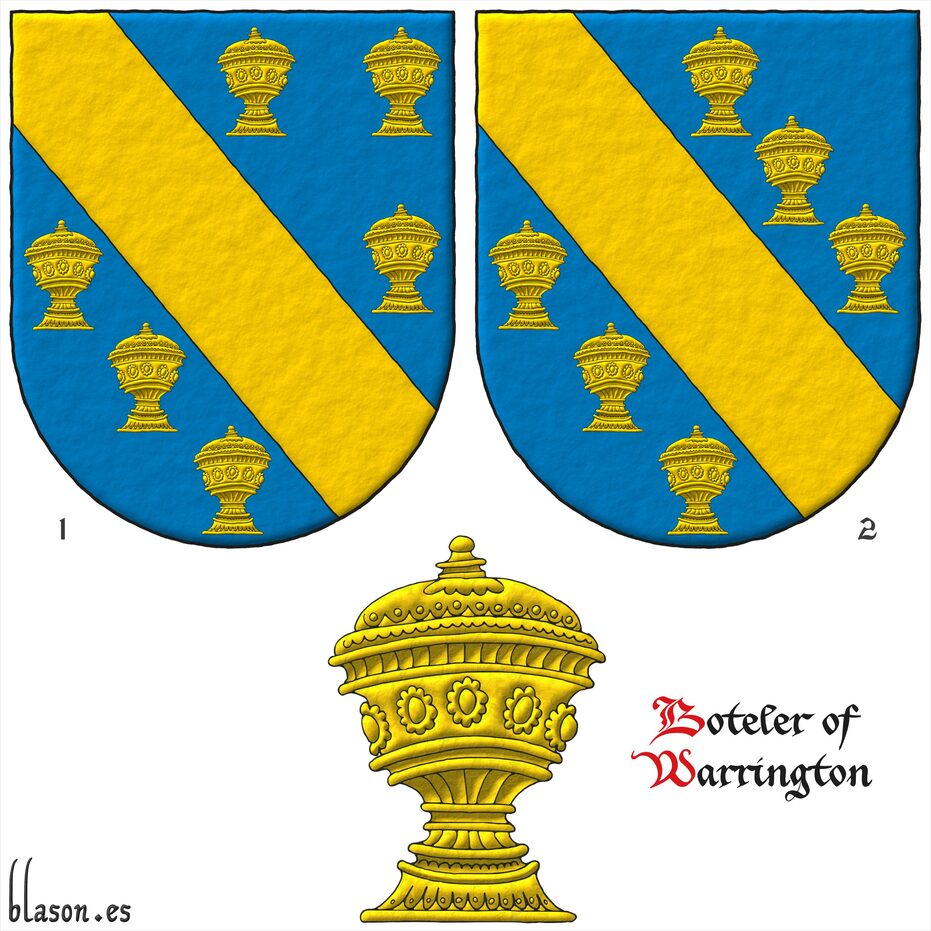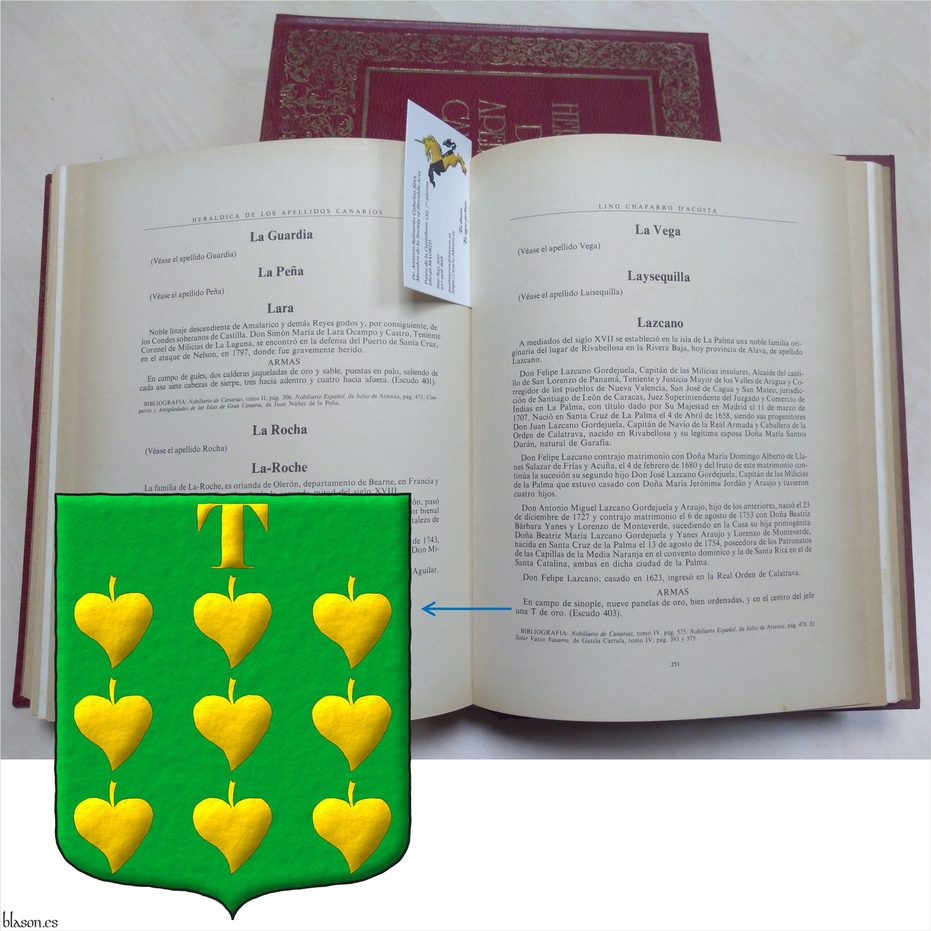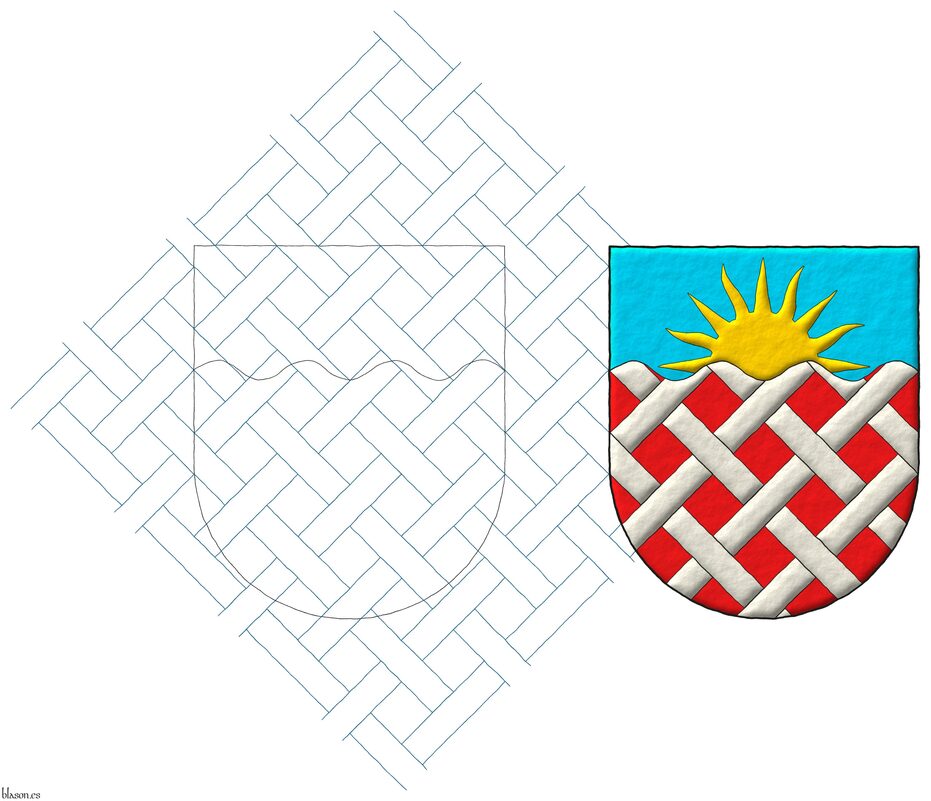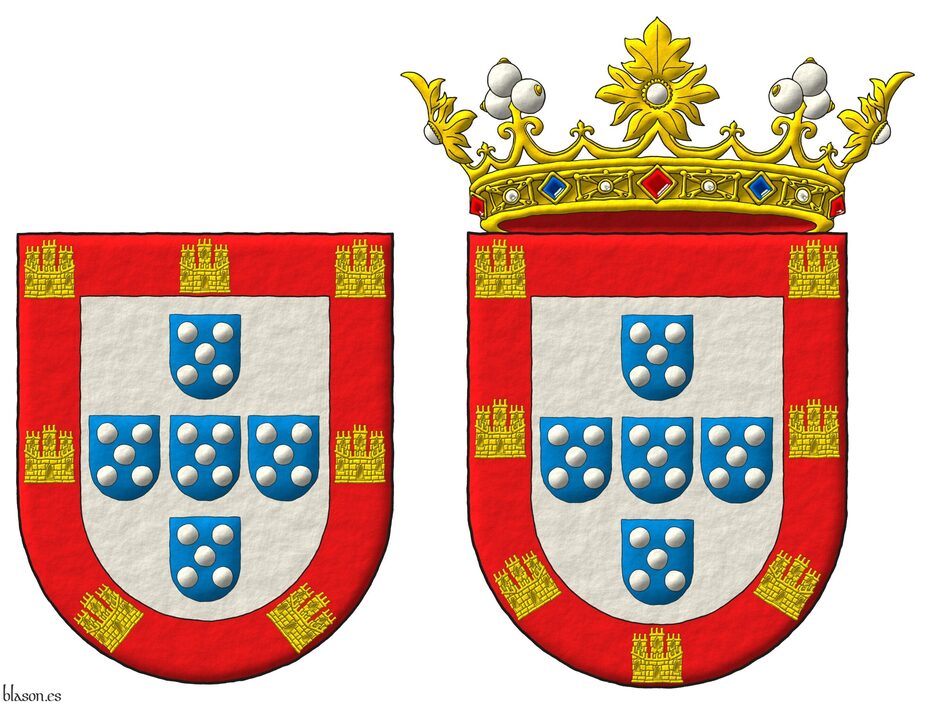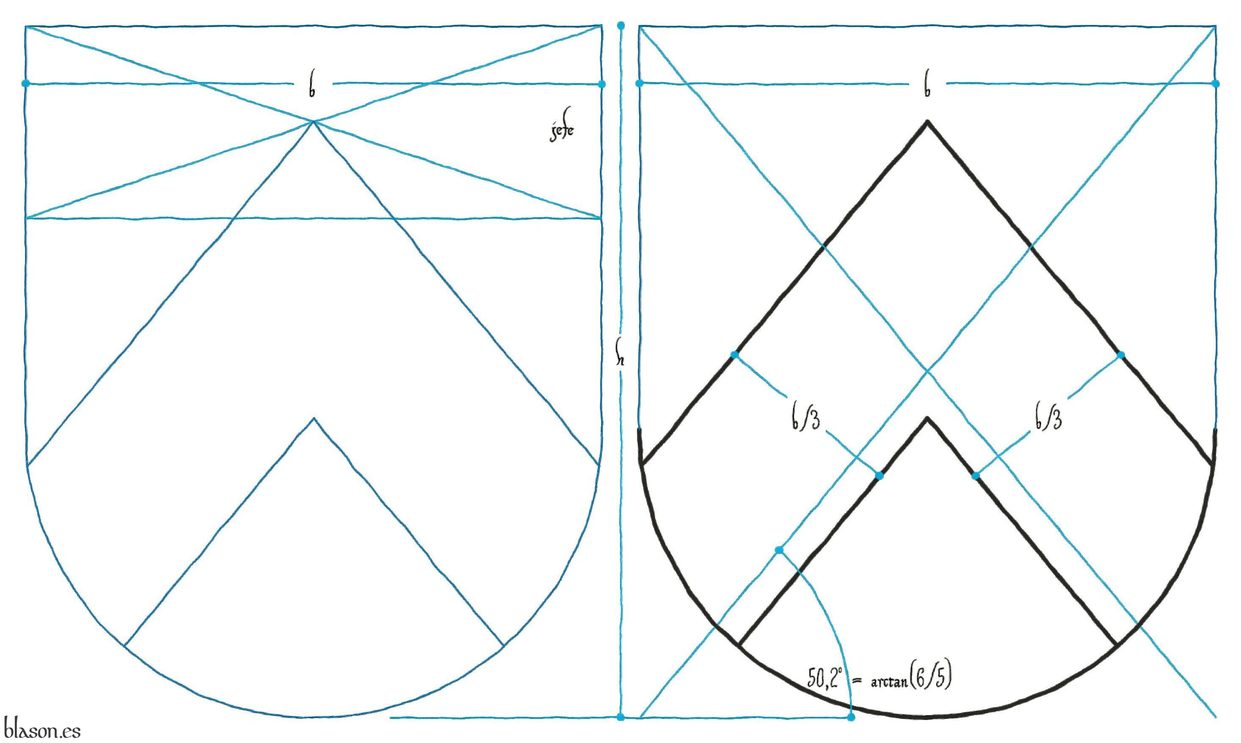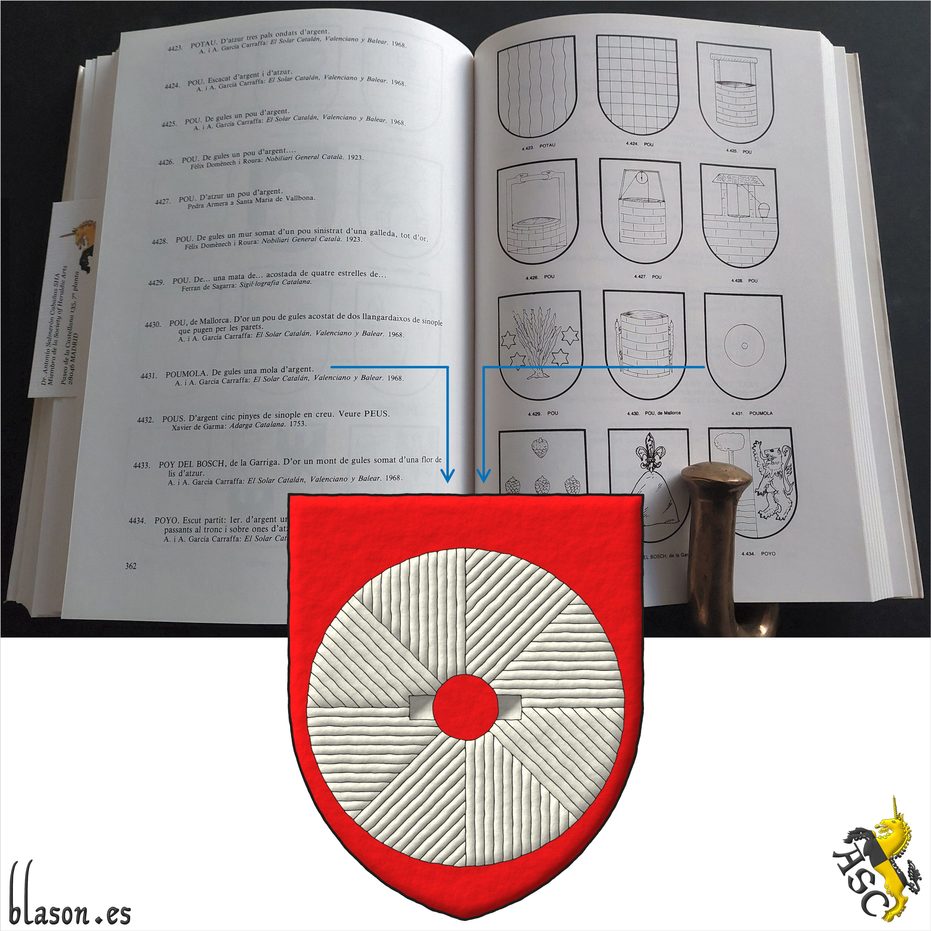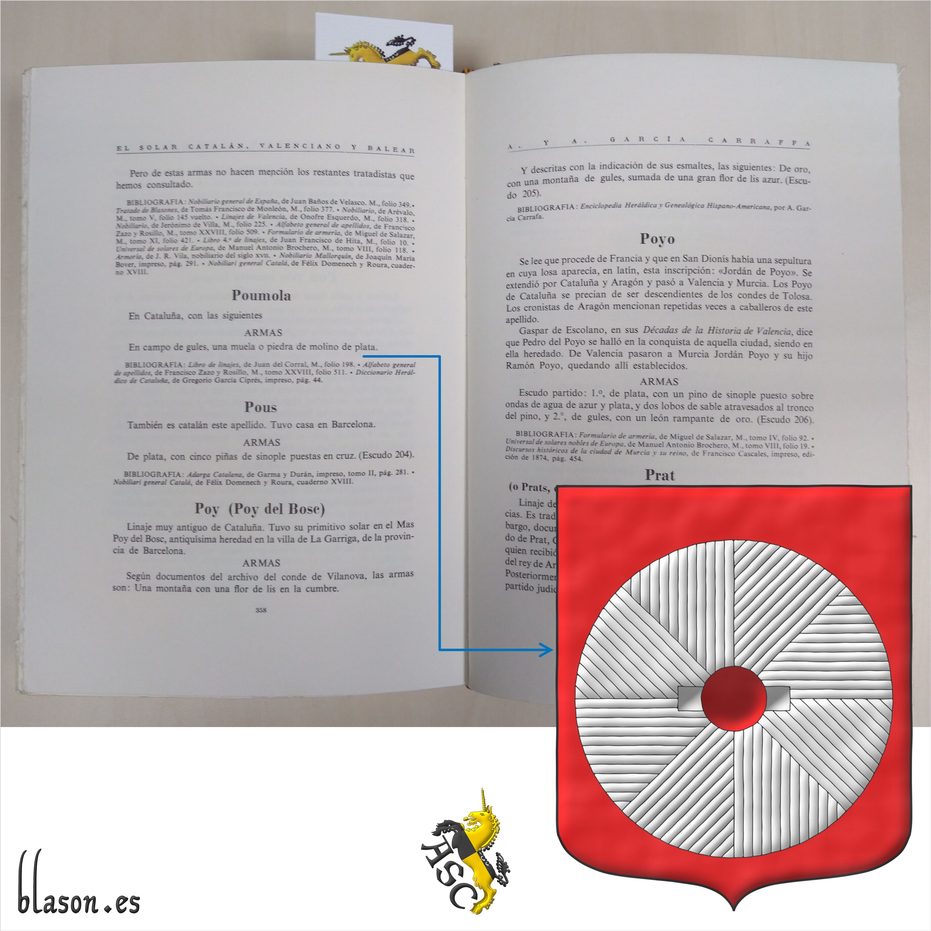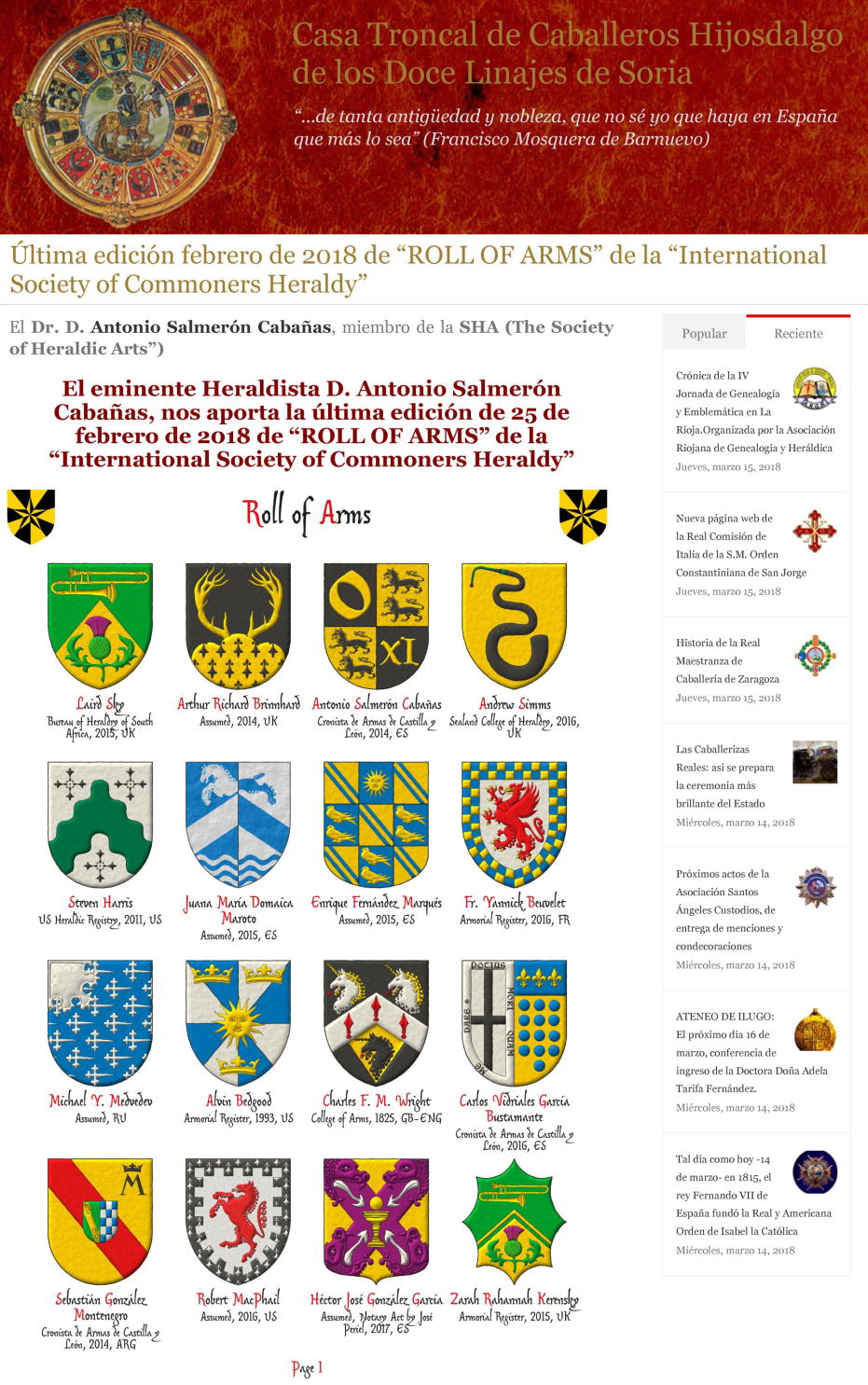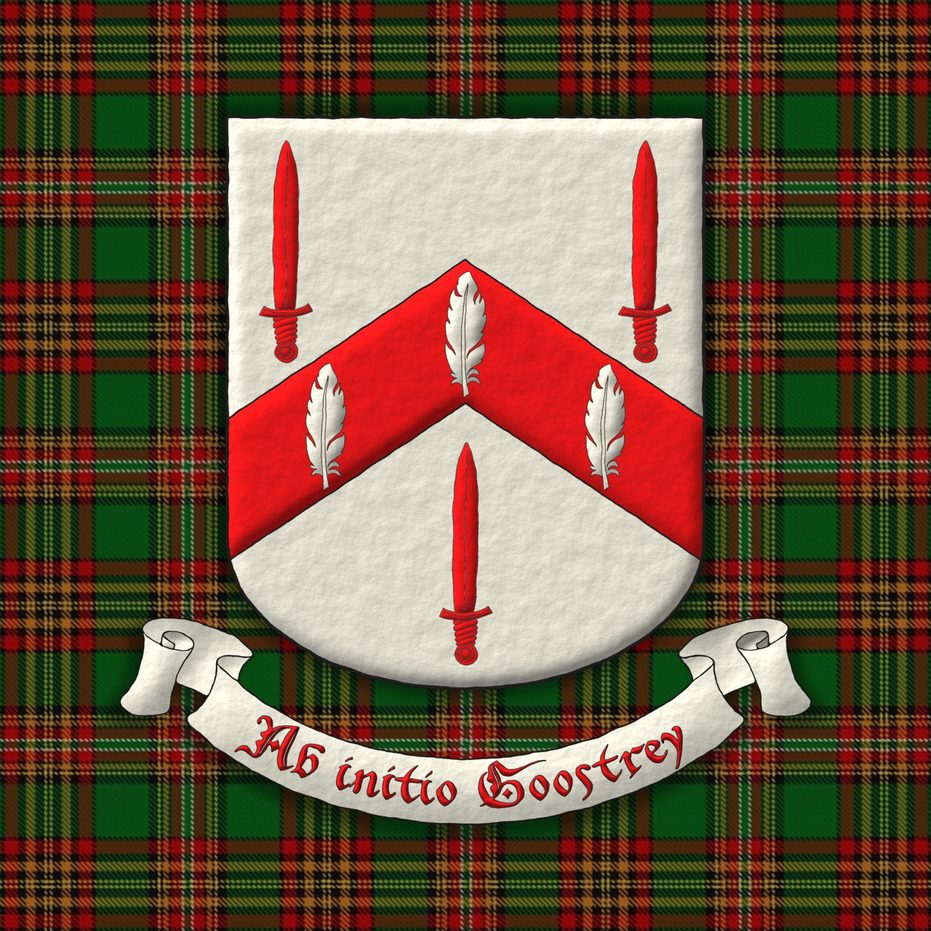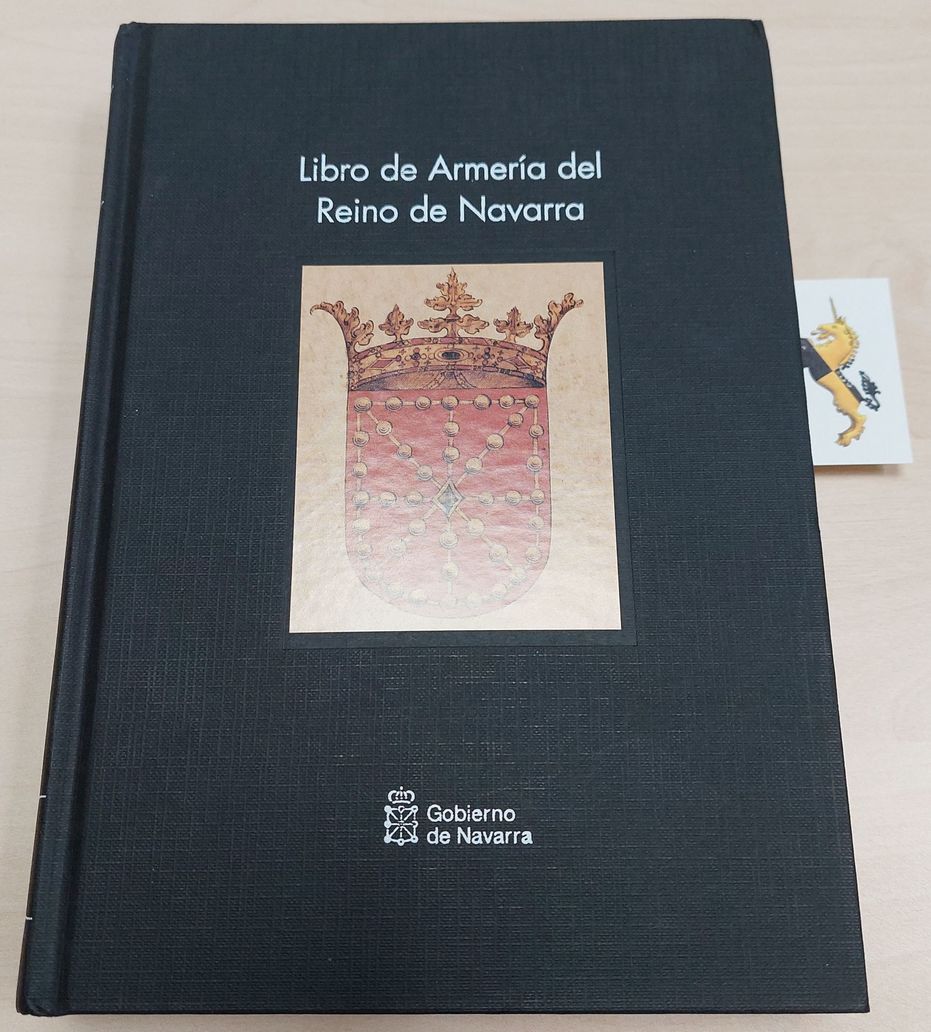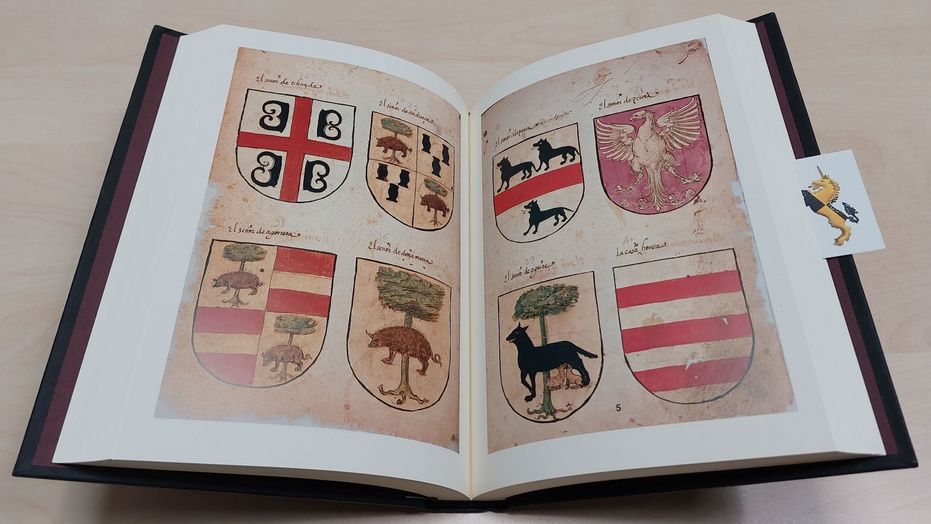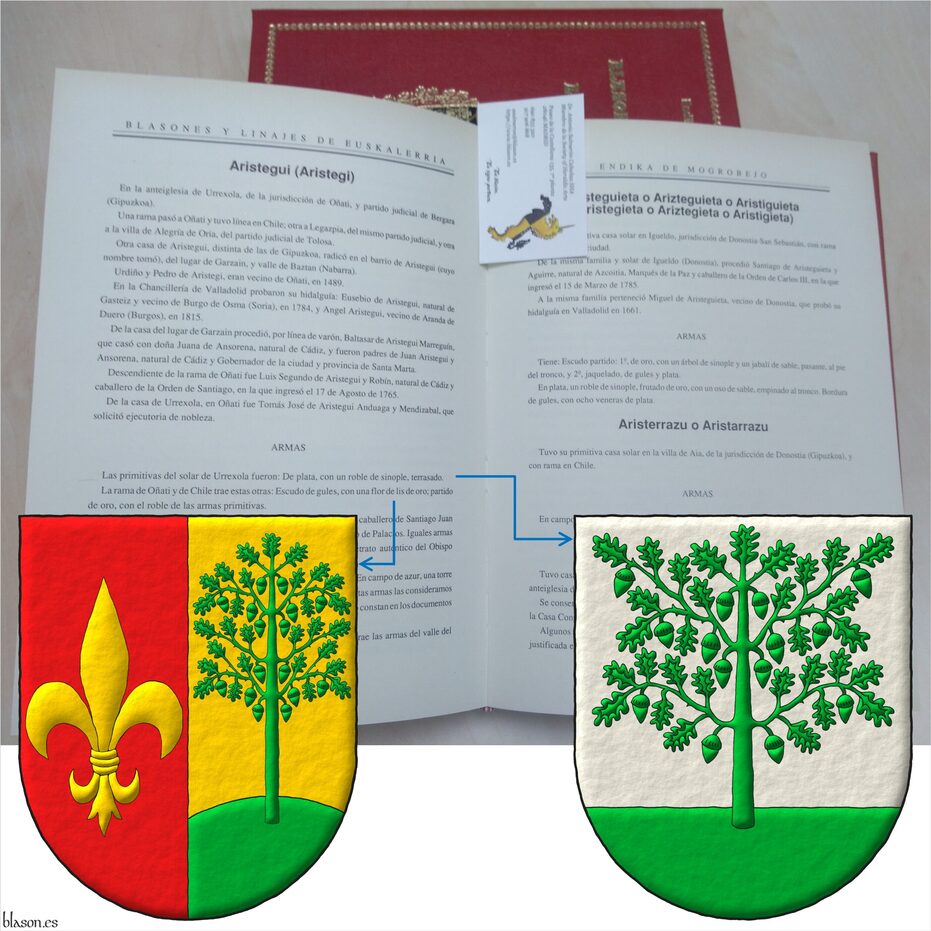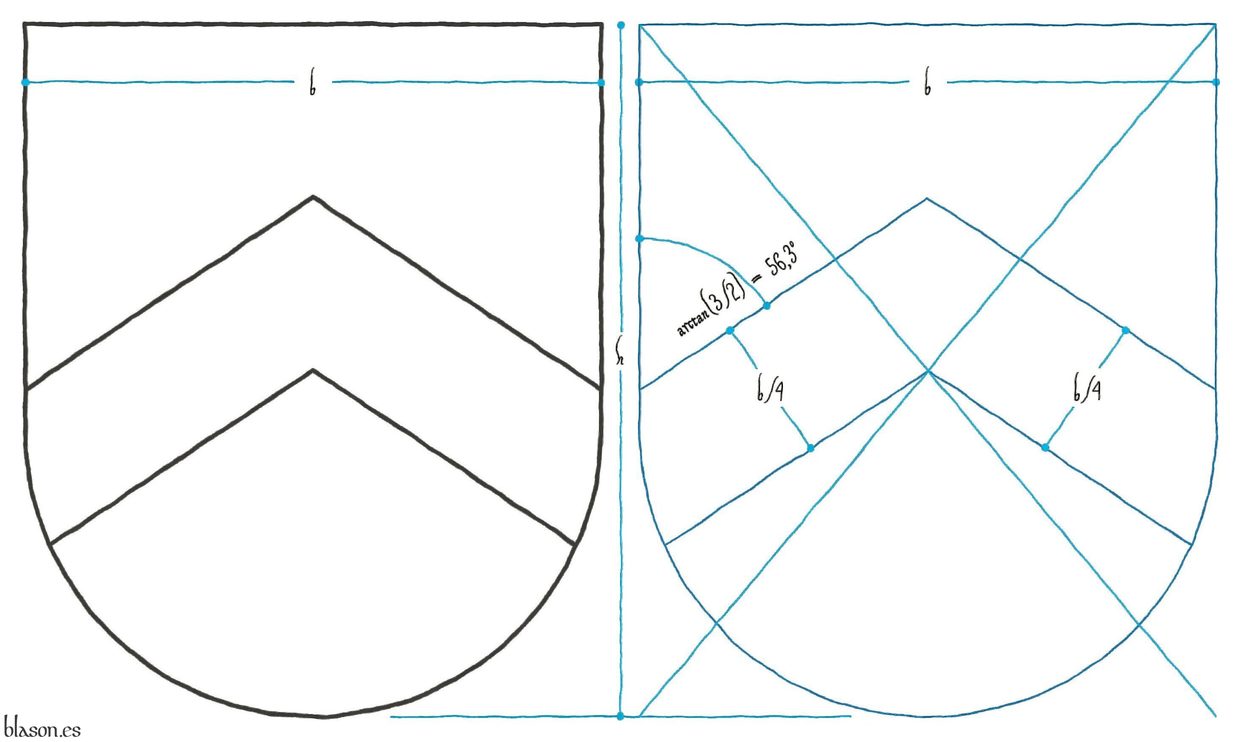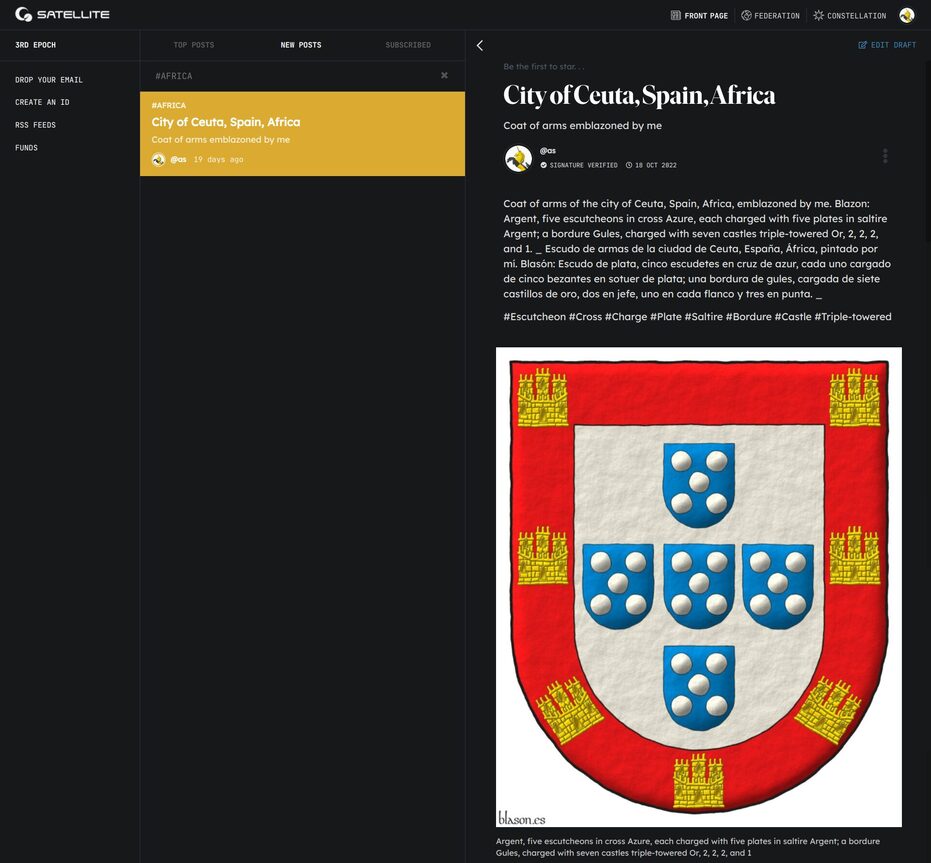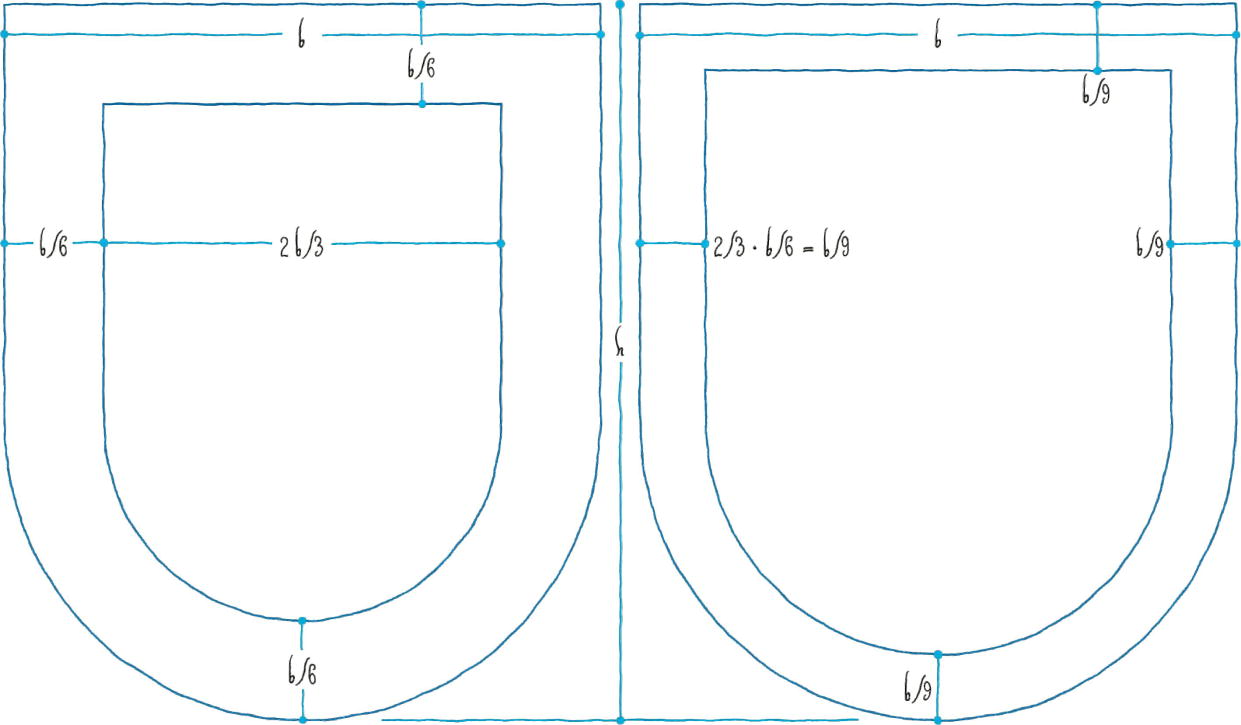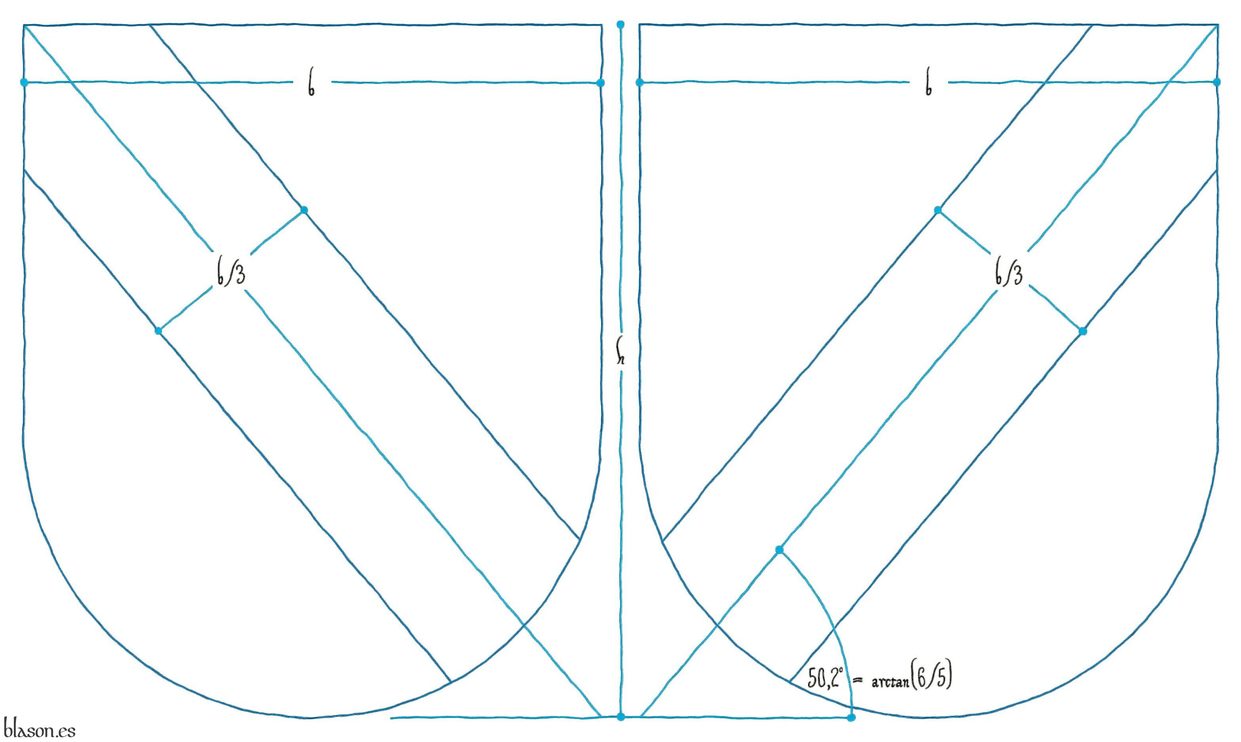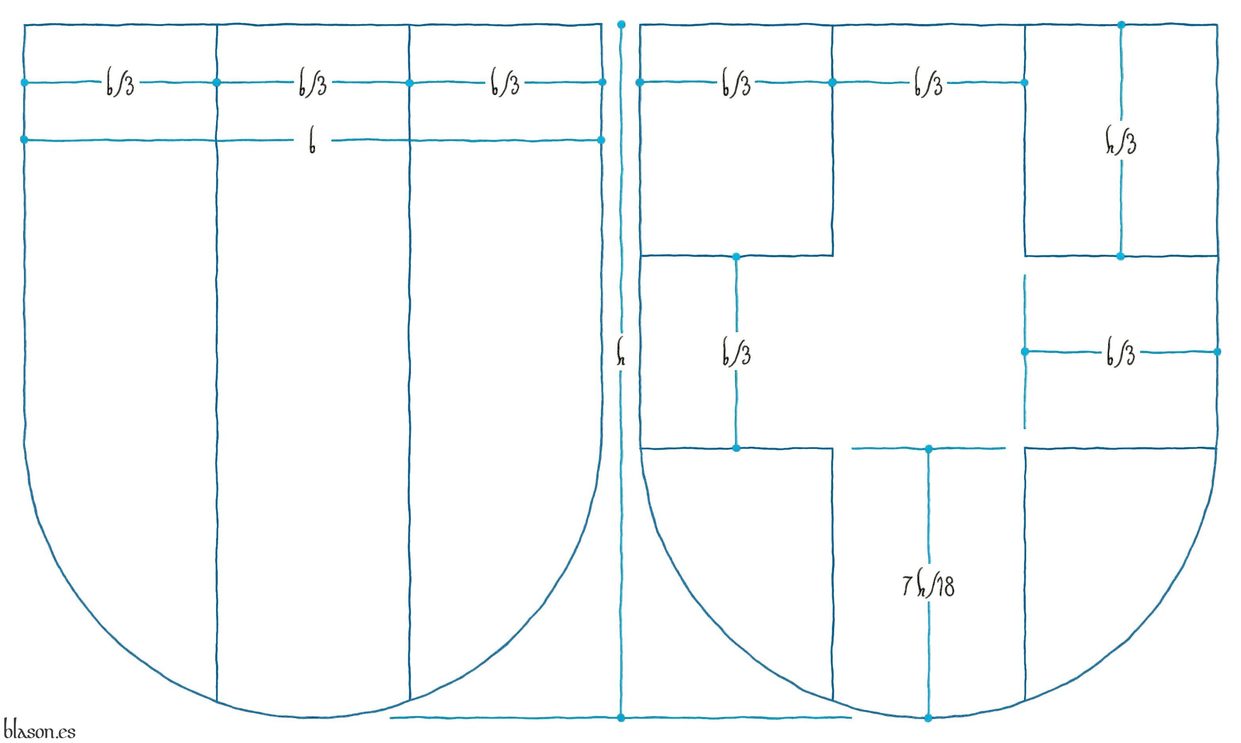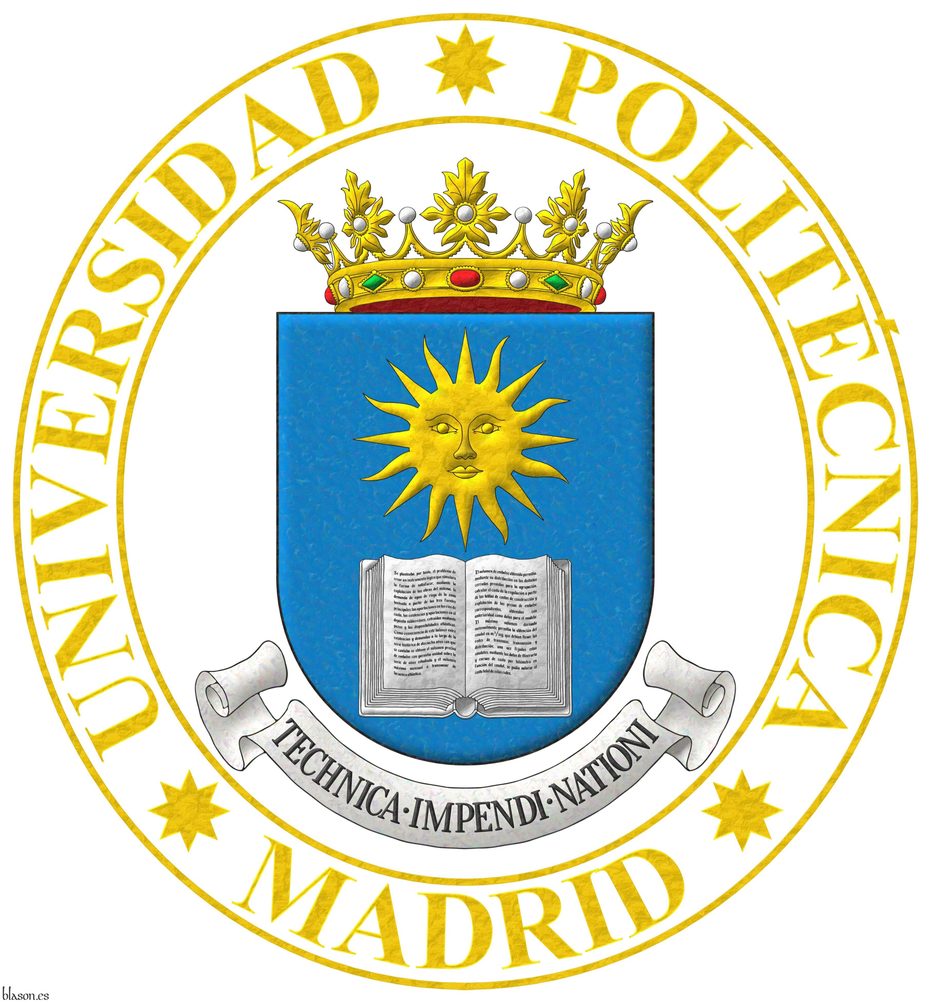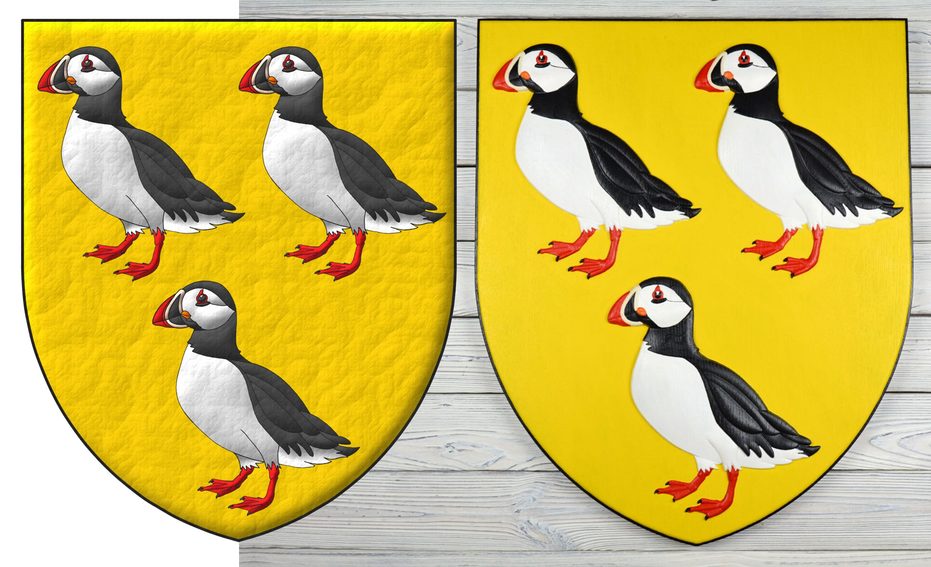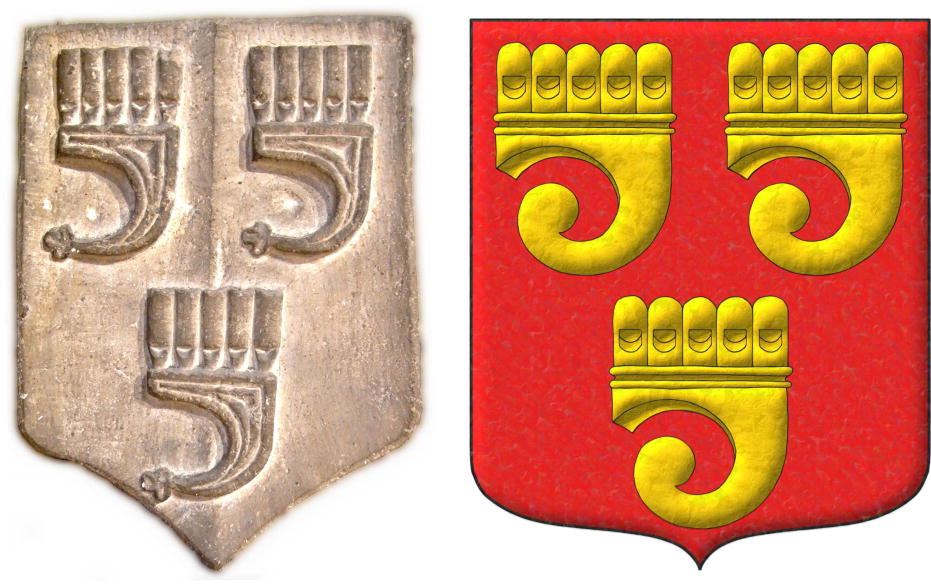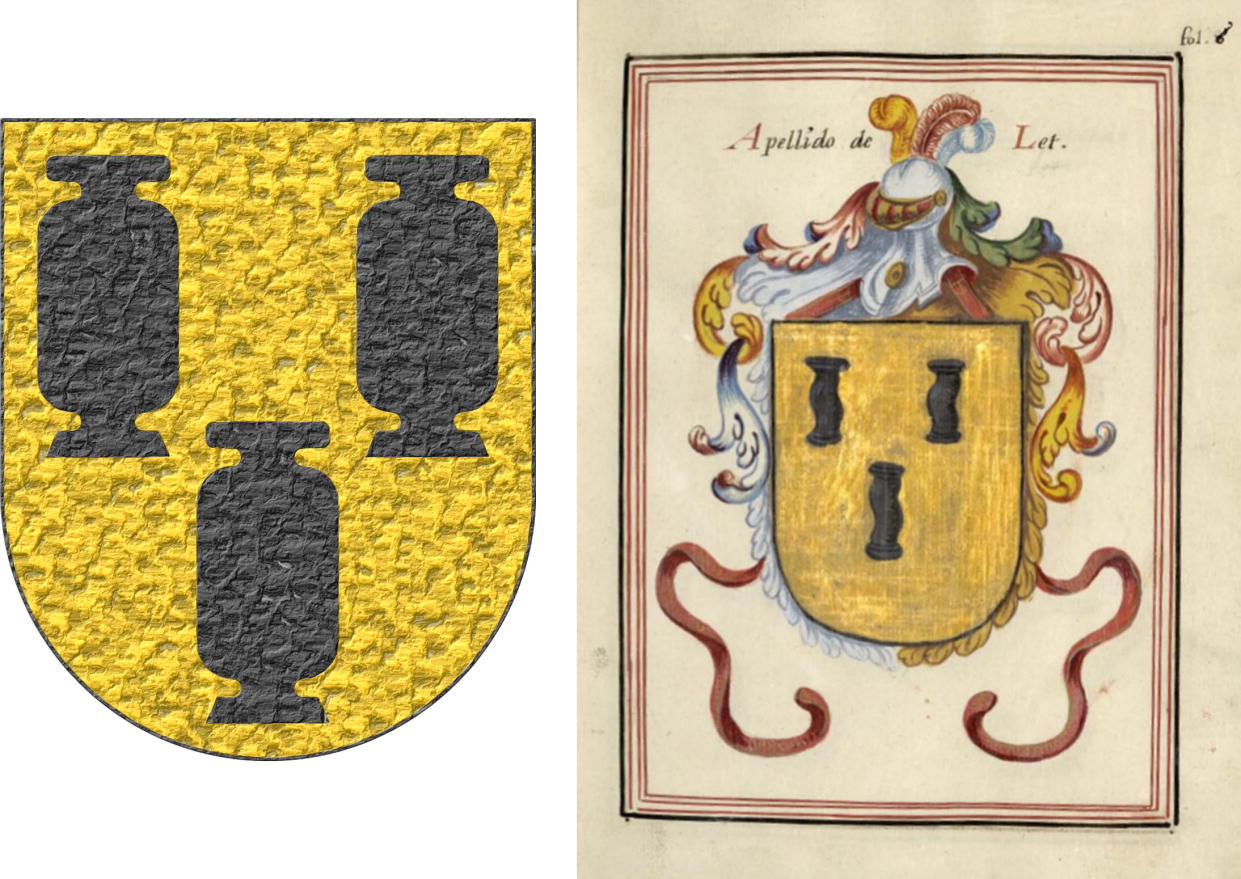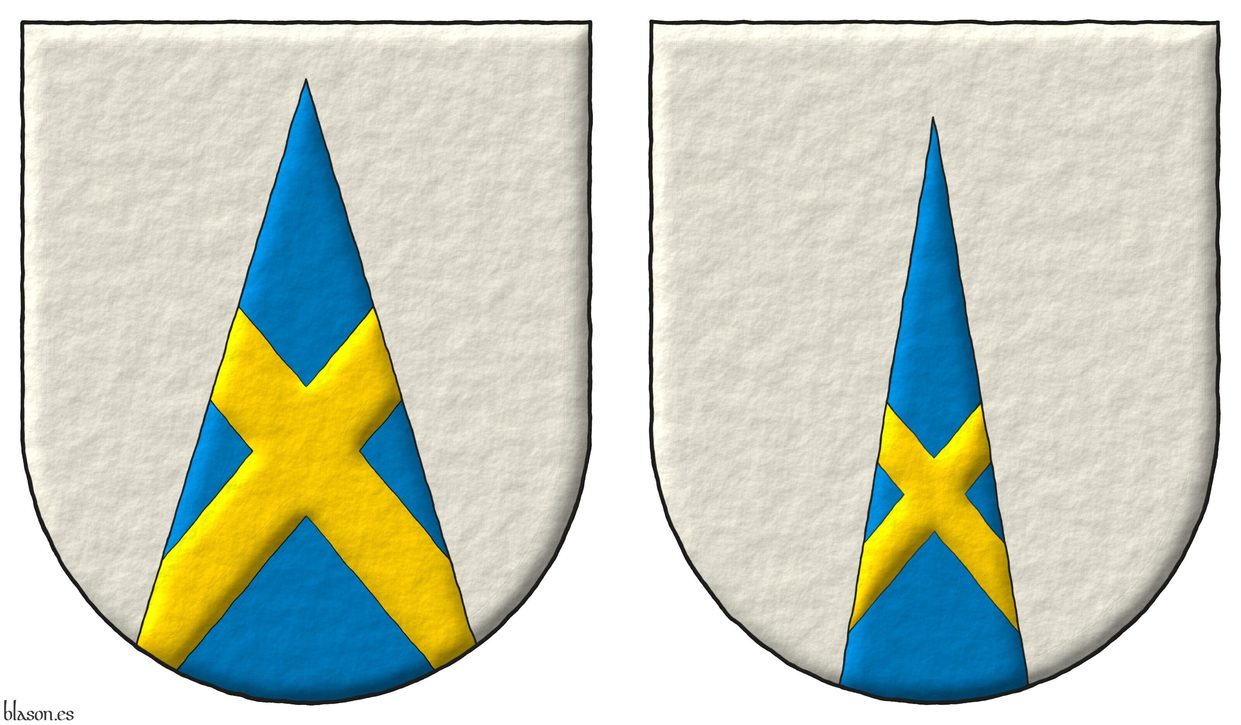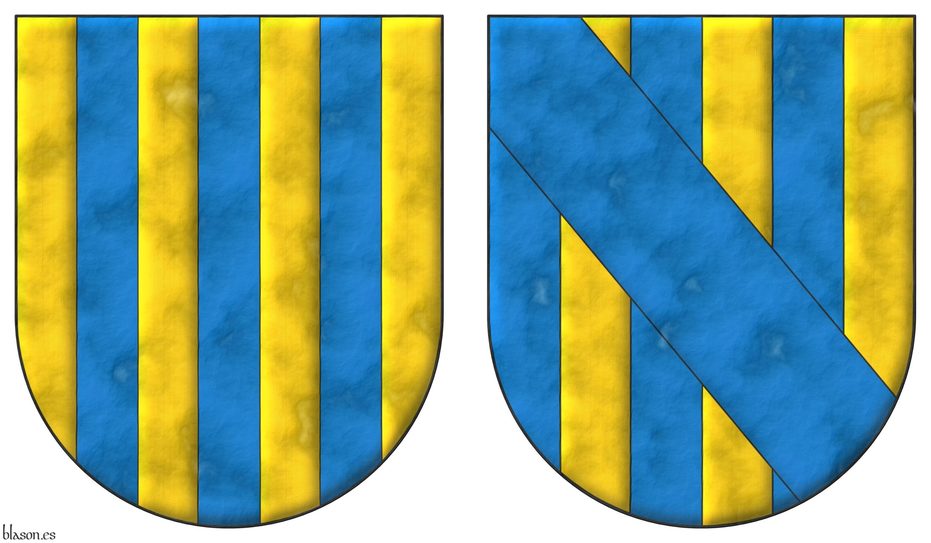Without divisions


Adrian V
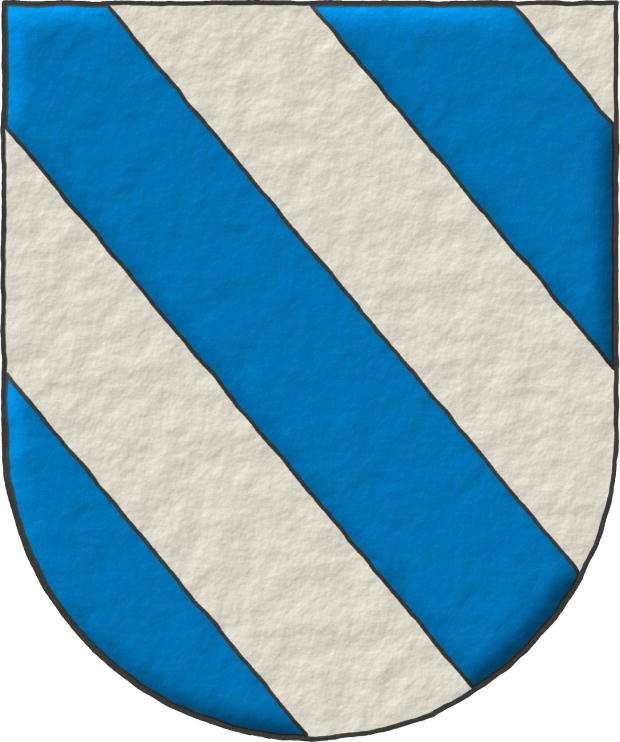
186th Pope of the Church, only 40 days in 1276. «Hadrianus V», born Ottobuono de Fieschi, was born in Genoa.
Bendy of six Azure and Argent.
Escudo bandado de seis piezas de azur y plata.
Papal coat of arms interpreted by me with: a shield with a rounded arch top; the field in plain tincture of Argent; the bands illuminated in Azure and outlined in Sable; and the whole in an elevated line style.
The blazon in French is «Bandé d'azur et d'argent de six pièces».
The banding is defined in [Avilés, J.; 1725a; page 40] and [Avilés, J.; 1780a; page 45] as the shields and also, the chiefs, fesses, pales, and figures, such as animals, etc., that are «covered and filled with bands in equal number, with as many of metal as of color».
Blazon keywords: Without divisions, Bendy, Six, Azure and Argent.
Style keywords: Semi-circular, Illuminated, Outlined in sable and Freehand.
Classification: Interpreted, Religious and Papal States.
Bearer: Adrian V.


![Ver [Ailes, A.; 1982] en referencias bibliográficas. Libro abierto, hojas de plata, filo de oro, guardas de gules, tapas de sable.](../css/Libro.Bibliografia.png)
Ailes, A.; 1982
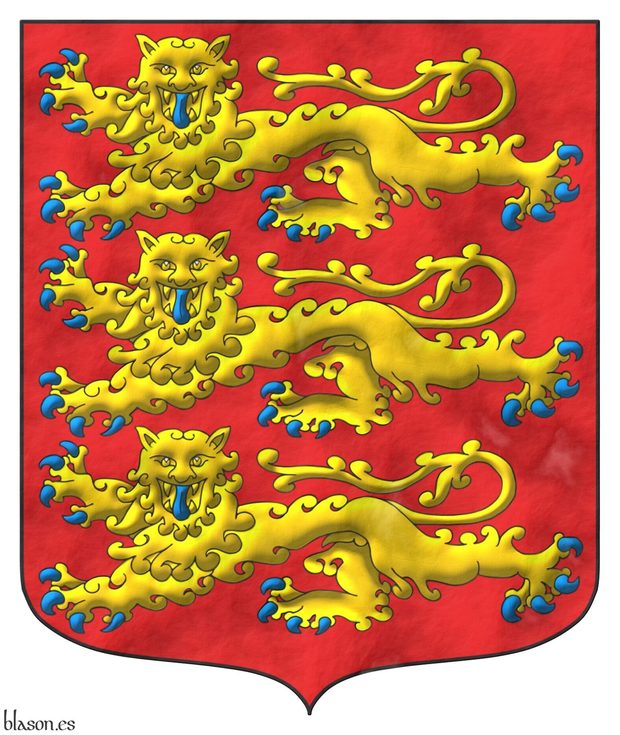
Adrian Ailes, «The Origins of the Royal Arms of England: Their Development to 1199», foreword by Rodney Dennys, includes 27 black and white illustrations, Graduate Centre for Medieval Studies, Reading University, 126 pages, ISBN 07-049077-6-3, Reading, Berkshire, 1982.
An article reviewing this book is: Brigitte Bedos Rezak, Archives nationales de Paris and Metropolitan Museum of Art, «The Origins of the Royal Arms of England, their Development to 1199 by Adrian Ailes», Speculum, volume 60, number 2, pages 373-376, Medieval Academy of America, Cambridge, Massachusetts, April of 1985.
Bibliographical reference of century XX.
Author: Ailes, Adrian.
Bibliographical reference mentioned in the following article:
External link:


Alcantara, Cavalry Regiment
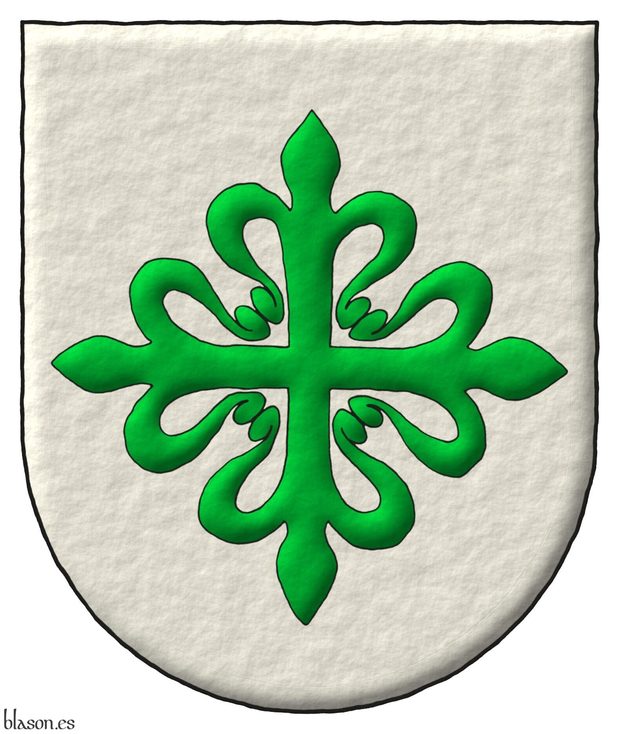
Coat of arms of the Armored Cavalry Regiment Alcantara No. 10, RCAC-10, in 2016.
Argent, a cross of Alcantara.
Escudo de plata, una cruz de Alcántara.
Coat of arms interpreted in the following manner: the shape of the shield is of a semicircular arch; the field is illuminated in the metal Argent; the cross of Alcantara is outlined in Sable and illuminated in Vert; and the whole has a raised stroke finish.
Blazon keywords: Without divisions, Argent, Cross of Alcantara, Cross couped and Cross.
Style keywords: Semi-circular, Illuminated, Outlined in sable and Freehand.
Classification: Interpreted, Military, Army and Navy and Coat of arms.
Bearer: Alcantara, Cavalry Regiment.


Aldam, lineage of England
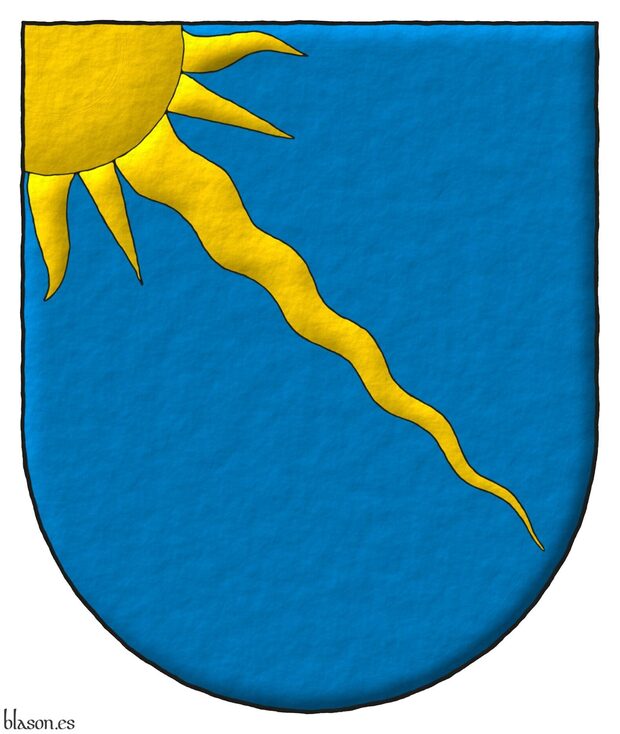
Blazon of the Aldam lineage of England.
Azure, a ray of the sun bendwise, issuant from the dexter chief Or.
Escudo de azur, un rayo de sol puesto en banda, naciente de la diestra del jefe de oro.
Illuminated with lights and shadows and with a freehand finish.
Described in [Burke, B.; 1989; page 9, column 1, entry 11].
Blazon keywords: Without divisions, Azure, One, Ray of the sun, Bendwise, Nascent, Dexter, Chief and Or.
Style keywords: Freehand, Outlined in sable, Illuminated and Semi-circular.
Classification: Interpreted, Lineage and Kingdom of England.


Alfonso IX of Leon, open royal crown
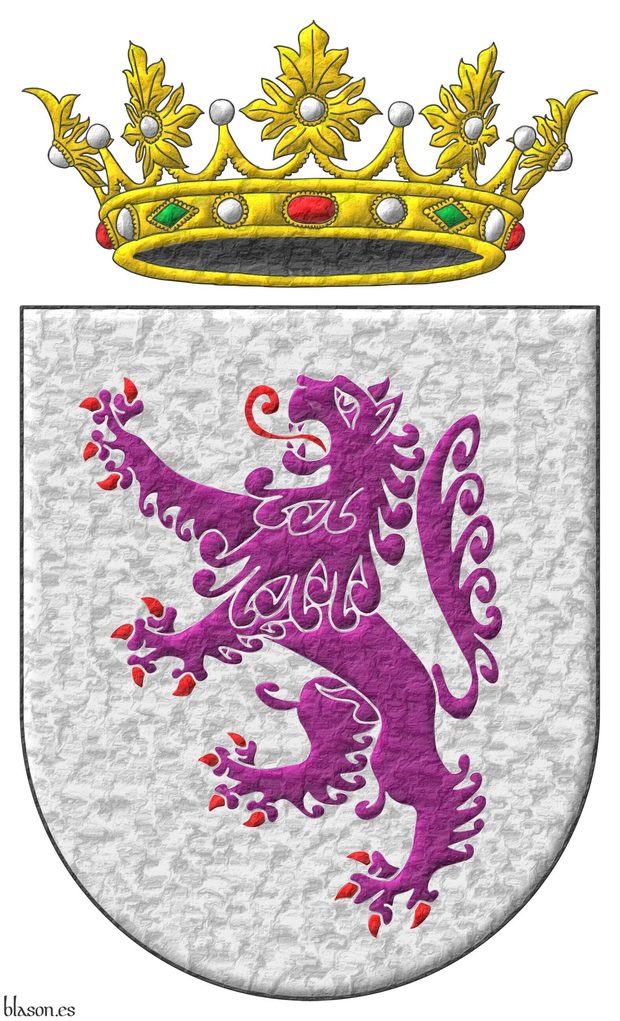
King of León from January 21, 1188, until his death on September 24, 1230.
Argent, a lion rampant Purpure, armed and langued Gules. Crest: An open royal crown Or.
Escudo de plata, un león rampante de púrpura, armado y lampasado de gules. Timbrado de una corona real abierta.
Arms of the King interpreted as follows: the escutcheon is finished in a semi-circular arch; both the field, the lion, and the crown of the crest have been illuminated; and the ensemble has a hammered metal finish.
Purple lion of the Kingdom of León
In the following image, I show a miniature from the Tumbo A of the Cathedral of Santiago de Compostela, from the 13th century, with the heading reading «Inclitus:Adeffonsus:Rex:Legionensium:et Gallecie:», combined with my interpretation of his coat of arms. The lion of the Kingdom of León can be found depicted in both purple and gules, but images like this confirm that it is purple, and I particularly favor the purple, as it makes it historically unique.
Blazon keywords: Without divisions, Argent, Purpure, Gules, One, Lion, Rampant, Armed, Langued, Crest, Open royal crown and Crown.
Style keywords: Semi-circular, Illuminated and Metal beaten.
Classification: Interpreted, Personal, Coat of arms and Kingdom of León.
Bearer: Alfonso IX of Leon.


Alfonso VIII of Castile
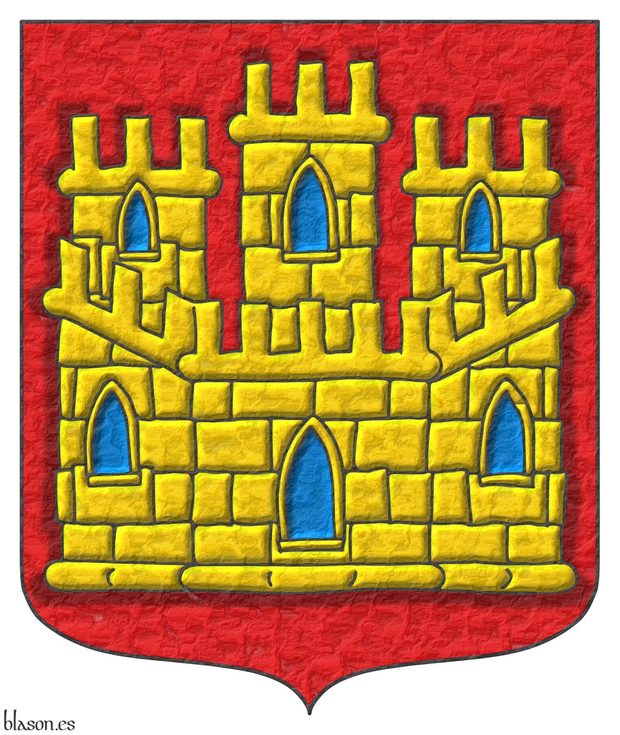
Born on November 11, 1155, in Soria and died on October 6, 1214, in Gutierre-Muñoz, Avila.
Gules, a castle triple towered Or, port and windows Azure, masoned Sable.
Escudo de gules, un castillo de oro, aclarado de azur, mazonado de sable.
Existing arms interpreted by me as follows: the shield’s shape is pointed and rounded; the field has been enameled Gules; the castle is outlined, illuminated, and shaded; the whole composition features a heavily hammered metal finish.
This ancient coat of arms of Castile can be consulted, among other sources, in [Argote de Molina, G.; 1588; chapter XLII].
Blazon keywords: Without divisions, Gules, Or, Azure, Sable, One, Castle, Port and windows and Masoned.
Style keywords: Ogee, Illuminated, Shaded, Outlined in sable and Hard metal.
Classification: Interpreted, Personal, Coat of arms and Kingdom of Castile.
Bearer: Alfonso VIII of Castile.


![Ver [Alfonso X of Castile; 1265] en referencias bibliográficas. Libro abierto, hojas de plata, filo de oro, guardas de gules, tapas de sable.](../css/Libro.Bibliografia.png)
Alfonso X of Castile; 1265
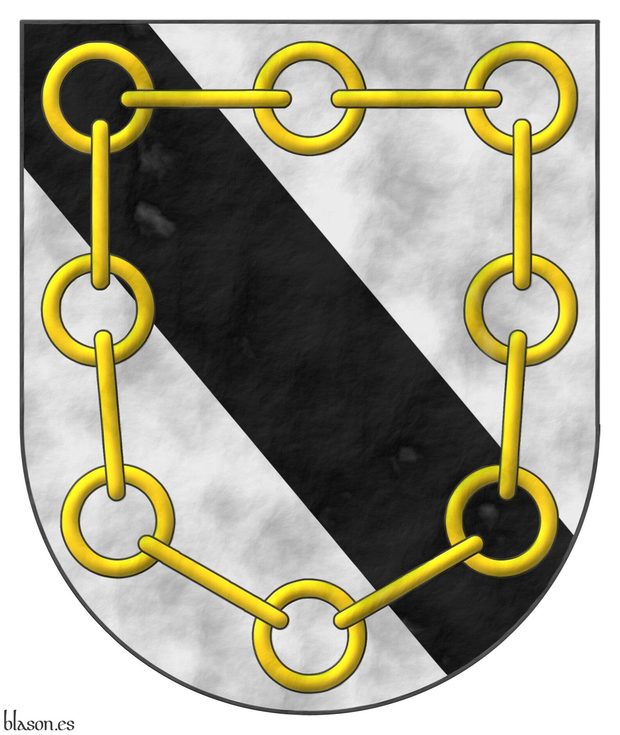
Alfonso X of Castile, The Wise, «The Seven-Part Code», its estimated completion year is 1265.
This is the copy I can consult, as it is available in the Hispanic Digital Library, it is a manuscript measuring 42 by 30 centimeters that once belonged to Álvaro de Zúñiga y Guzmán, first Duke of Arévalo, which later came into the possession of the Catholic Monarchs, initially Queen Isabella I of Castile, and after her death, King Ferdinand reclaimed it for the price of 5,251 maravedis. The original is housed in the National Library, in display case 4/6.
This copy, in addition to its numerous capital letters, has 8 illustrated pages, which according to its subsequent hand-numbering in pencil are:
- Page 6, among its illustrations can be seen 2 coats of arms of the Zúñiga family «Argent, a bend Sable, over all, a chain in orle Or», in this case formed by 16 links, 8 round and 8 more elongated placed in profile.
- Pages 106 and 191, on the latter can be seen a curious bishop-lizard climbing.
- Pages 294 and 331, on the 2nd at the bottom, a maiden is seen walking a monkey to relieve itself and to her right a fight of men with beast bodies.
- Page 379 and on its previous unnumbered page, and finally, on page 415 which begins with a tournament where the 2nd knight bears the ancient arms of France «Azure, semy of fleurs de lis Or».
The coat of arms that illustrates this bibliographic reference is that of Álvaro de Zúñiga y Guzmán. For the creation of his chain, I followed the illustration of his 2 coats of arms on the already mentioned page 6 of this manuscript.
It is one of my favorite manuscripts and, perhaps, the one with which I have created the most things.
Bibliographical reference of century XIII.
Classification: Castilian language, Manuscript and In color.
The author is Alfonso X of Castile.
Bibliographical reference mentioned in the following article:
External resources:
- National Library of Spain.
- Indirect access to the Library of Congress of the United States of America.
- Direct access to the Library of Congress of the United States of America.
Internal resources: AlfonsoXDeCastilla1265.7Partidas.10642.pdf.


Almorrabides of Navarre
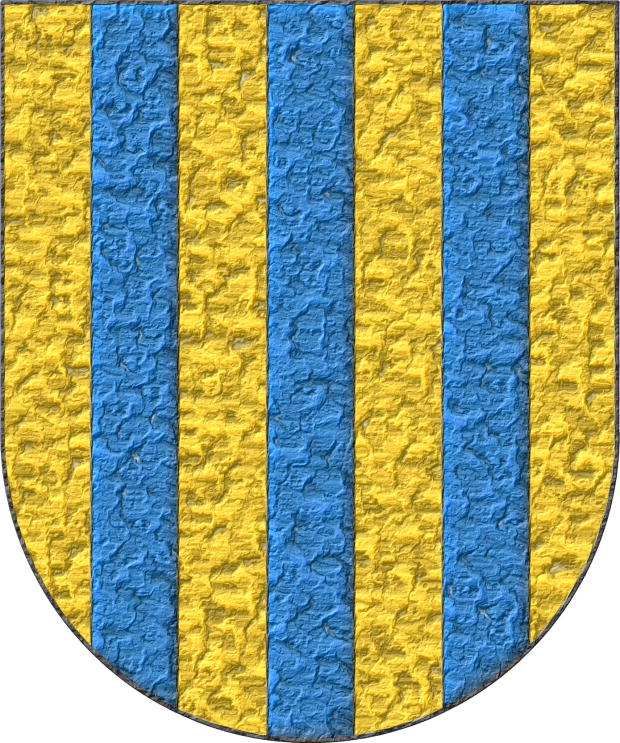
Of the twelve lineages of Noblemen, it is the first, and they bear as arms, on a golden field, three pales Azure.
Or, three Pallets Azure.
Escudo de oro, tres palos de azur.
Coat of arms interpreted with: a semicircular (round) base; the field in flat Or; the pales outlined in Sable and illuminated in Azure enamel; and finished in highly-hammered metal.
Based on the first coat of arms of the «ricoshombres» of Navarre in [Bosque, J. del; 1540; folio 1 of the numbering of 1613] and the text is from the transcription made in [Martinena Ruiz, J. J.; 1982; pages 122 and 123].
Under the title «Los Almorauides» it can also be consulted in [Vega, P. J. de; 1702; folio 1 of the manuscript].
Blazon keywords: Without divisions, Or, Three, Pale and Azure.
Style keywords: Semi-circular, Illuminated, Outlined in sable and Hard metal.
Classification: Interpreted, Personal and Kingdom of Navarre.
Bearer: Almorrabides of Navarre.


Amancier, lineage of Genevois
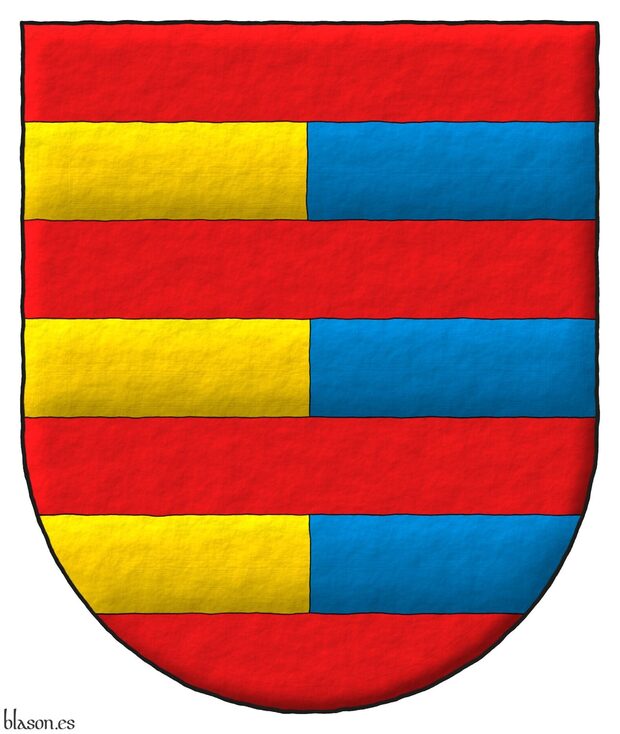
Blazon of the Amancier lineage of Genevois, Haute-Savoie, France.
Gules, three bars per pale Or and Azure.
Illuminated and a freehand finishing.
Its French blazon «de gueules, à trois fasces parties d'or et d'azur» can be found at [Rietstap, J. B.; 1861; page 40].
Any fess party per pale of metal and color or color and metal will always have a metal on metal or color on color conflict whether the field of the coat of arms is color or metal. There isn't conflict if the field of the coat of arms is also party per pale with metal under the color of the fess and with color under the metal of the fess or if the field is fur.
Blazon keywords: Without divisions, Gules, Three, Fess, Party per pale, Or and Azure.
Style keywords: Freehand, Outlined in sable, Illuminated and Semi-circular.
Classification: Interpreted, Lineage and Kingdom of France.


Anderson of Erbury
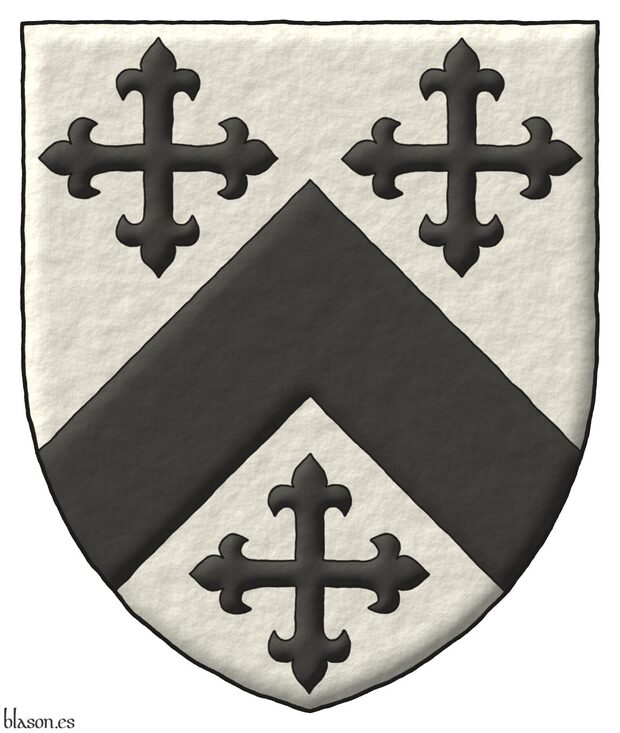
Argent, a chevron between three crosses flory Sable.
Escudo de plata, un cabrio acompañado de tres cruces flordelisadas todo de sable.
Illuminated with lights and shadows and with a freehand finish.
The coat of arms of Anderson of Erbury emblazoned by me in 4 ways: 1) tricking using abbreviations, 2) hatching using lines, 3) plain tinctures, and 4) lights and shados. It is a preliminary artwork for the arms of Nick Allen Rica II.
Blazon keywords: Without divisions, Argent, One, Chevron, Between, Three, Cross flory, Cross couped and Sable.
Style keywords: Freehand, Outlined in sable, Illuminated, Pointed, Tricking, Hatching and Plain tincture.
Classification: Interpreted, Kingdom of Scotland and Schema.
Bearer: Anderson of Erbury.


André, lineage of France
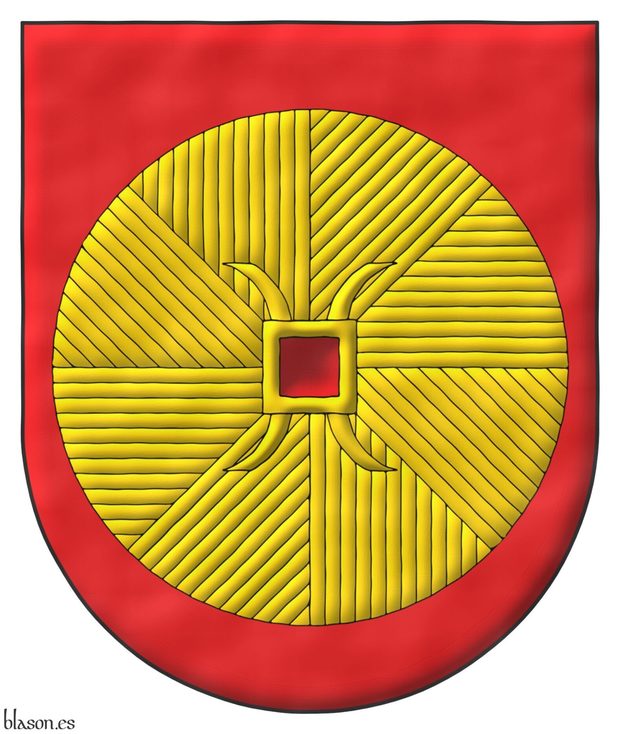
Blazon of the André lineage of France.
Gules, a millstone Or.
Escudo de gules, una piedra de molino de oro.
Illuminated and a watercolor finishing with shadow in the hole.
For its better identification, I have painted the millstone with the ring that fixes it to its axis. This ring is called a millrind, it is made of iron, and usually has 4 arms to better fix the millstone. Millrinds may appear on coats of arms independently of millstones. Another heraldic element related to the previous ones is the millwheel, which is a toothed gear that is part of the mill mechanism but should not be confused with the millstone that grinds the grain.
Blazon keywords: Without divisions, Gules, One, Millstone and Or.
Style keywords: Watercolor, Outlined in sable, Illuminated and Semi-circular.
Classification: Interpreted, Lineage and Kingdom of France.


ANPC, shield with crest and motto
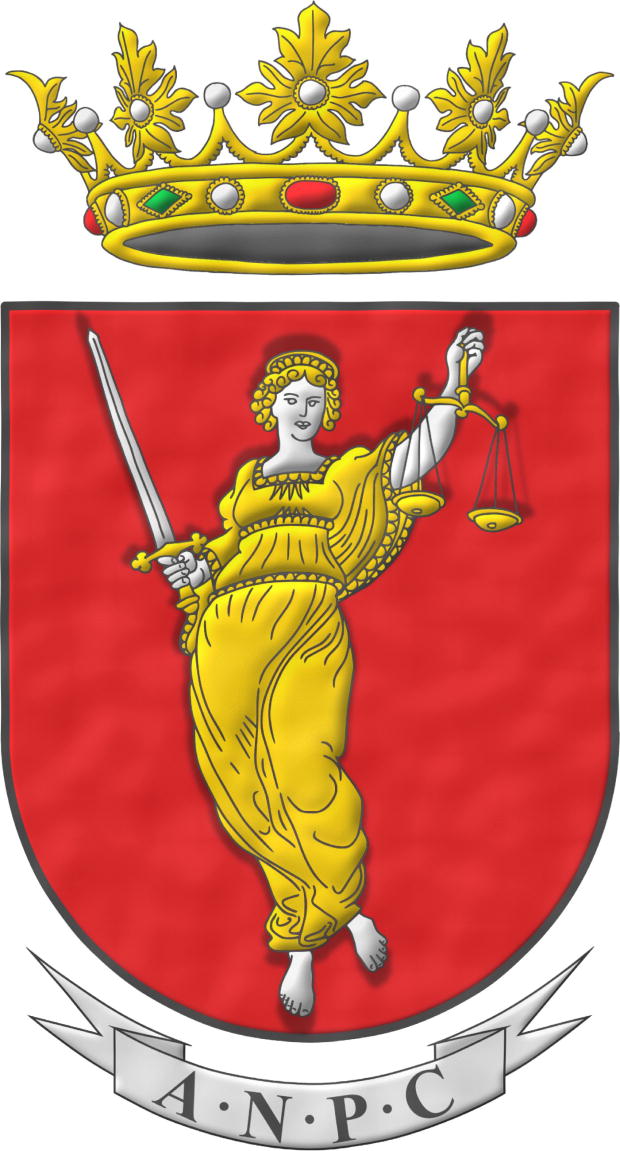
National Association of Criminology Experts and Experts in Forensic Sciences for the Courts of Justice.
Azure, a Female representing Justice Argent, clothed Or, holding in the dexter hand a Sword Argent, garnished Or, and in the sinister hand Pair of Scales Or. Crest: An open royal crown Or. Motto: «ANPC».
Escudo de gules, una Justicia de plata, vestida de oro, en su diestra una espada de plata, alzada, guarnecida de oro y en su siniestra una balanza de oro. Timbrado de una corona real abierta. Divisa: «ANPC».
Coat of arms that I have organized based on a previous idea from the ANPC, in the following way: the mouth of the shield is rounded and is outlined at double my usual thickness; the whole is enamelled in gules, argent and or, illuminated, outlined in sable and with a watercolor finish; and to separate the letters of the motto a dot «·» is used at mid-height.
[Cadenas y Vicent, V. de; 1975; page 119 and following] dedicates its chapter 7 to «representative heraldry» and, within it, its first section to «professional heraldry», to which this coat of arms belongs according to his classification, and defines it as that which «corresponds to and reflects... all the emblems of the different professions, professional associations, societies where people with the same hobbies or pastimes are grouped». The other 3 categories that, together with «professional heraldry», make up «representative heraldry» are «industrial», «sport» and «tourism».
Personally, I follow my own heraldic classification, which follows to some extent [Cadenas y Vicent, V. de; 1975], in which the coats of arms of associations like the ANPC are classified within what I call socioeconomic heraldry.
Blazon keywords: Without divisions, Gules, Argent, Or, Female figure, One, Justice, Vested, Dexter, Sword, Point upwards, Hilted, Sinister, Pair of scales, Crest, Open royal crown, Crown and Motto (identification).
Style keywords: Watercolor, Illuminated, Shaded, Semi-circular and Outlined in the field tincture.
Classification: Coat of arms, Created and Socioeconomic.
Bearer: ANPC.


Aragon
Or, four pallets Gules.
Escudo de oro, cuatro palos de gules.
Recreated coat of arms of Aragón in the following manner: the escutcheon shape is pointed and rounded; the field is rendered in flat Or; the pallets are illuminated; and the whole has a parchment-like finish.
This rendition of the coat of arms is based on [Portolés, J.; Molino, M. del; 1590].
Blazon keywords: Without divisions, Or, Four, Pale and Gules.
Style keywords: Ogee, Illuminated and Parchment.
Classification: Interpreted, Civic, Coat of arms and Kingdom of Aragon.
Bearer: Aragon.


Arjona Berrocal, Rubén
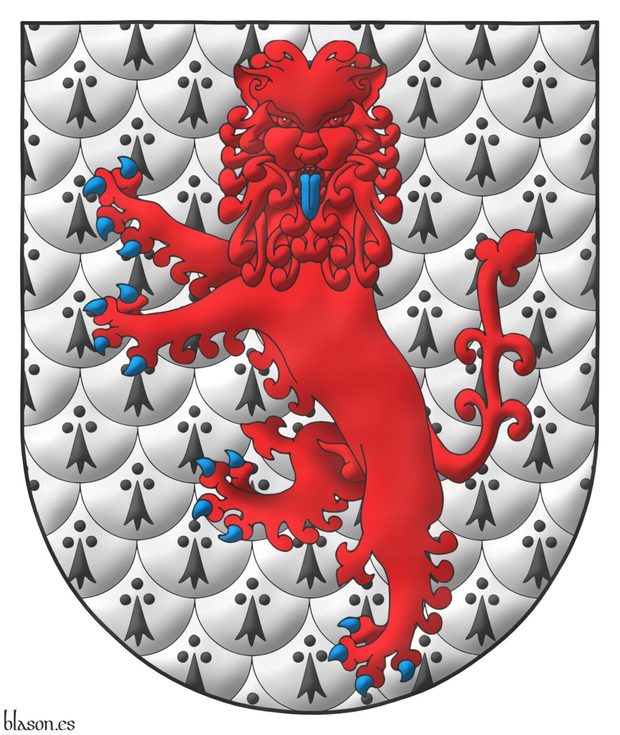
Ermine papelonny, a lion rampant guardant Gules, armed and langued Azure.
Escudo de armiños papelonado, un leopardo leonado de gules, armado y lampasado de azur.
Coat of arms emblazoned by me with a semi-circular ended shape, illuminated, and its finishing is that seems watercolor.
Credits:
- Felipe Trujillo Jiménez is the designer of the coat of arms.
- Antonio Salmerón y Cabañas is the author of the heraldic art.
Blazon keywords: Without divisions, Ermine, Papelonny, One, Lion rampant guardant, Gules, Armed, Langued and Azure.
Style keywords: Semi-circular, Outlined in sable, Illuminated and Watercolor.
Classification: Personal, Interpreted and Coat of arms.
Bearer: Arjona Berrocal, Rubén.


Artillery Combat School of the Swedish Army
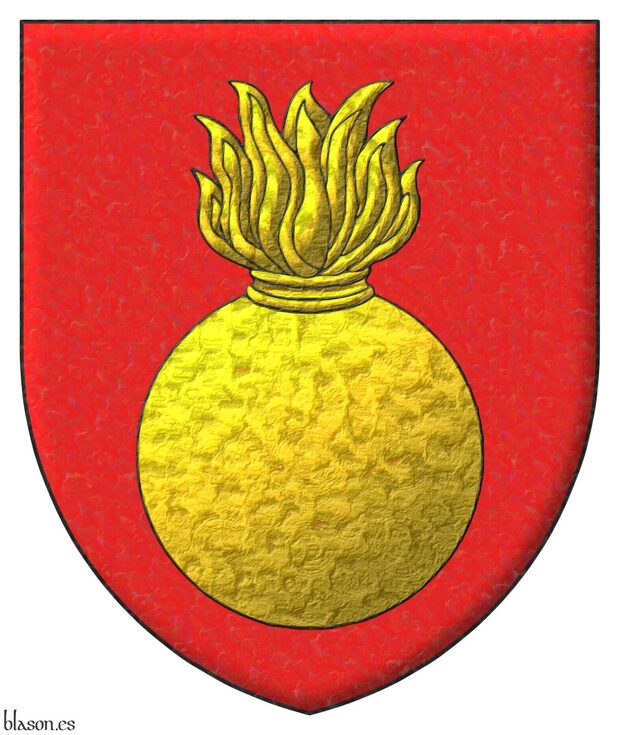
Kingdom of Sweden.
Gules, a grenade Or.
Escudo de gules, una bomba de oro.
Illuminated with lights and shadows and with a iridescent and metallic finish.
Blazon keywords: Without divisions, Gules, One, Grenade and Or.
Style keywords: Metal beaten, Iridescent (nacar), Outlined in sable, Illuminated and Pointed.
Classification: Interpreted, Military and Kingdom of Sweden.
Bearer: Artillery Combat School of the Swedish Army.


Avelar, lineage of Portugal
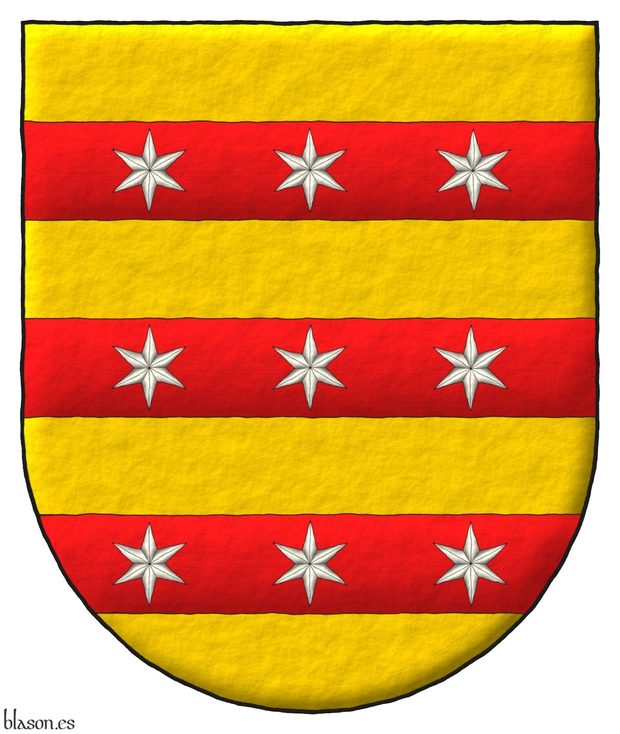
Blazon of the Avelar lineage of Portugal.
Or, three bars Gules charged each one with three mullets of six points Argent.
Illuminated and a freehand finishing.
It can be found at [Cró, J. do; 1509; page 127].
Blazon keywords: Without divisions, Or, Three, Fess, Gules, Charged, Mullet and Argent.
Style keywords: Freehand, Outlined in sable, Illuminated and Semi-circular.
Classification: Interpreted, Lineage and Kingdom of Portugal.


![Ver [Avilés, J.; 1725a] en referencias bibliográficas. Libro abierto, hojas de plata, filo de oro, guardas de gules, tapas de sable.](../css/Libro.Bibliografia.png)
Avilés, J.; 1725a
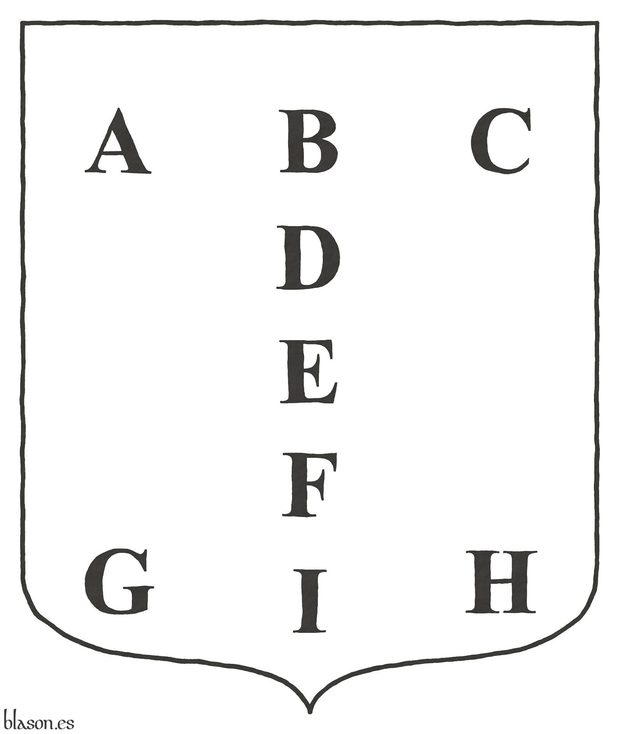
José de Avilés e Iturbide, Marquis of Aviles, member of the Supreme Council of War, «Ciencia heroyca, reducida a las leyes heráldicas del blasón: Ilustrada con exemplares de todas las piezas, figuras y ornamentos de que puede componerse un escudo de armas interior y exteriormente, Volume I», dedicated to Juan Bautista de Orendyn of His Majesty's Council, printed by Juan Piferrer of the Ángel's Square, 530 pages, Barcelona, 1725.
I also usually consult Volume I of the edition [Avilés, J.; 1780a].
Contents of Volume One
- Cover page.
- Dedication.
- Censor's review from 1724.
- Approval.
- To the reader.
- Epigram.
- Summary of privileges.
- Summary of the price.
- Plate index.
- Warnings.
- Errata sheet for each of the treatises.
- Additions.
- Table of the treatises.
- 378 pages for its 4 treatises: Treatise I with 3 chapters and a dictionary, Treatise II with 3 chapters, Treatise III with 3 chapters, and Treatise IV with 4 chapters.
- 34 plates with more than 650 coats of arms arranged at the end of each treatise, as follows: Plates 1 to 16 at the end of Treatise I, Plates 17 to 19 at the end of Treatise II, Plate 20 at the end of Treatise III, and Plates 21 to 34 at the end of Treatise IV.
- Index of terms, words, and figures specific to blazonry.
- Index of cities, titles, and families with coats of arms blazoned in this second volume.
Bordure compony
Bibliographical reference of century XVIII.
Classification: De bibliotheca, In black and white and Castilian language.
Author: Avilés e Iturbide, José.
The following articles cite this bibliographic reference:
- Adrian V
- Baudry in France
- Bourgeois, lineage of Burgundy
- Criteria used by its title
- Dancetty, ratio, points and blazon
- Edmund Plantagenet
- Enrique Fernández Marqués, two supporters
- Ferdinand II of Leon
- Flanched, schemaat one-fifth
- Hector of Troy
- Hector of Troy, Sable
- Hufflepuff House with 2 badgers
- Innocent IV
- Leonor de Aquitania
- Navarre
- Nhf, Norsk Heraldisk Forening
- Oschoven of the Rhin
- Pile issuant from the base in the Dictionary of the Spanish Language
- Richard I of England
- The Heraldry Society of Scotland
- Triangulation 1, contre-embrassés, chapé, embrassé, and chaussé
- Triangulation 2, chaussé, contre-embrassé, embrassé, and chapé
- Triangulation 6, embrassé, chaussé, chapé, and contre-embrassé
- Triangulation 7, chaussé, contre-embrassé, embrassé, and chapé
External resources:
- Valencian Digital Library, records for the Volumes I and II.
- Valencian Digital Library, content of Volume I.
Internal resources: AvilesJ1725.Tomo.I.pdf.


![Ver [Avilés, J.; 1780a] en referencias bibliográficas. Libro abierto, hojas de plata, filo de oro, guardas de gules, tapas de sable.](../css/Libro.Bibliografia.png)
Avilés, J.; 1780a
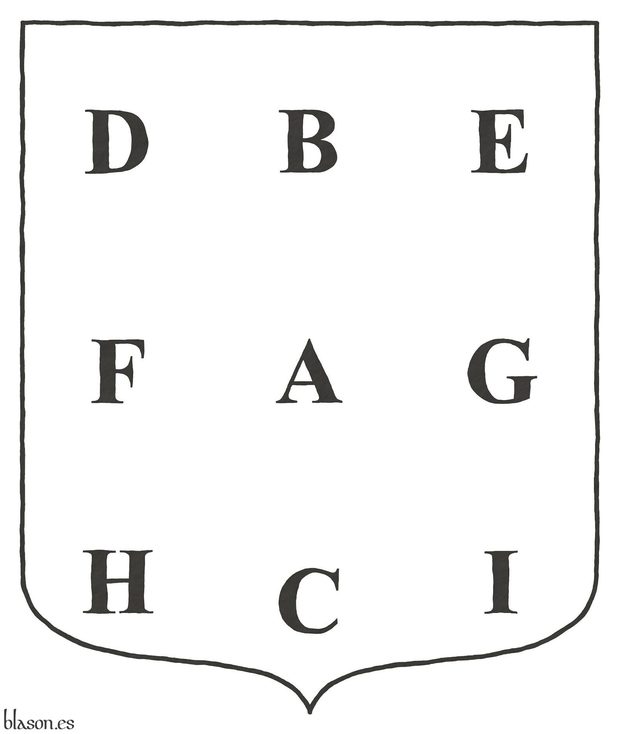
José de Avilés e Iturbide, Marquis of Aviles, member of the Supreme Council of War, «Ciencia heroyca, reducida a las leyes heráldicas del blasón: Ilustrada con exemplares de todas las piezas, figuras y ornamentos de que puede componerse un escudo de armas interior y exteriormente, Volume I», edition of Joaquín Ibarra, printer of his Majesty's Chamber, at the expense of the Company of Printers and Booksellers of the Kingdom, 526 pages, Madrid, 1780.
The first edition is [Avilés, J.; 1725a] and this edition is 14 years after the death of José de Avilés, that happened in 1766.
Page Examples
Bibliographical reference of century XVIII.
Classification: In black and white and Castilian language.
Author: Avilés e Iturbide, José.
The following articles cite this bibliographic reference:
- Adrian V
- Avilés, J.; 1725a
- Bourgeois, lineage of Burgundy
- Dancetty, ratio, points and blazon
- David B. Appleton, slipped and leaved
- Enrique Fernández Marqués, two supporters
- Ferdinand II of Leon
- Holy Trinity
- Hufflepuff House with 2 badgers
- Innocent IV
- Jesus Christ, preparation schema
- Jesus Christ, with bezants Or
- Kimon Andreou, contourné
- Kimon Andreou, eradicated
- Latidos Podencos, Azure and Argent version
- Latidos Podencos, Azure and Argent version with motto
- Latidos Podencos, seal of the animal protection organization
- Leonor de Aquitania
- Leonor de Aquitania y Enrique de Inglaterra
- Lozengy 5x6 and 6x7
- Navarra, chains Or
- Nhf, Norsk Heraldisk Forening
- Norsk Heraldisk Forening, coat of arms
- Pile issuant from the base in the Dictionary of the Spanish Language
- Ponce I of Urgell
- Royal Spanish Academy, coat of arms
- Sebastián González Montenegro en Doce Linajes
- Thomas de Warbleton
- Urgell, County of
External link:


Aybar of Navarre
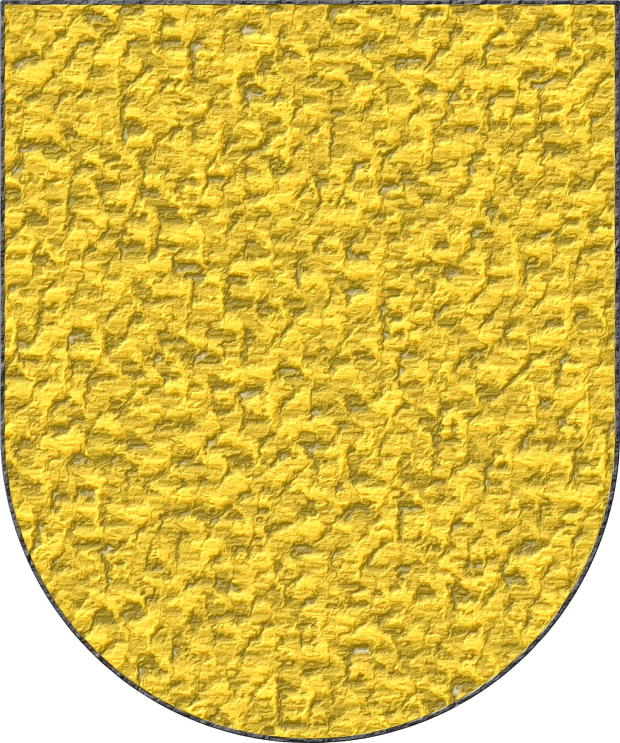
Of the twelve lineages of Noblemen, they are the third great and ancient barony, where the first King of Aragon had his mother; they make a shield of Or without any mixture of colour or device, but a field of gold as painted in this shield.
Or.
Escudo de oro.
A coat of arms that leaves little room for interpretation, which I have recreated with: a semicircular (round) base; the field in flat Or; and finished in highly-hammered metal.
Based on the third coat of arms of the «ricoshombres» of Navarre from [Bosque, J. del; 1540; folio 1 of the numbering of 1613] and the text is from the transcription made in [Martinena Ruiz, J. J.; 1982; pages 122 and 123].
Under the title «Surname of Aybar» it can also be consulted in [Vega, P. J. de; 1702; folio 3 of the manuscript].
Blazon keywords: Without divisions and Or.
Style keywords: Semi-circular, Illuminated, Outlined in sable and Hard metal.
Classification: Interpreted, Personal and Kingdom of Navarre.
Bearer: Aybar of Navarre.


B. Quesada, coat of arms with motto and support
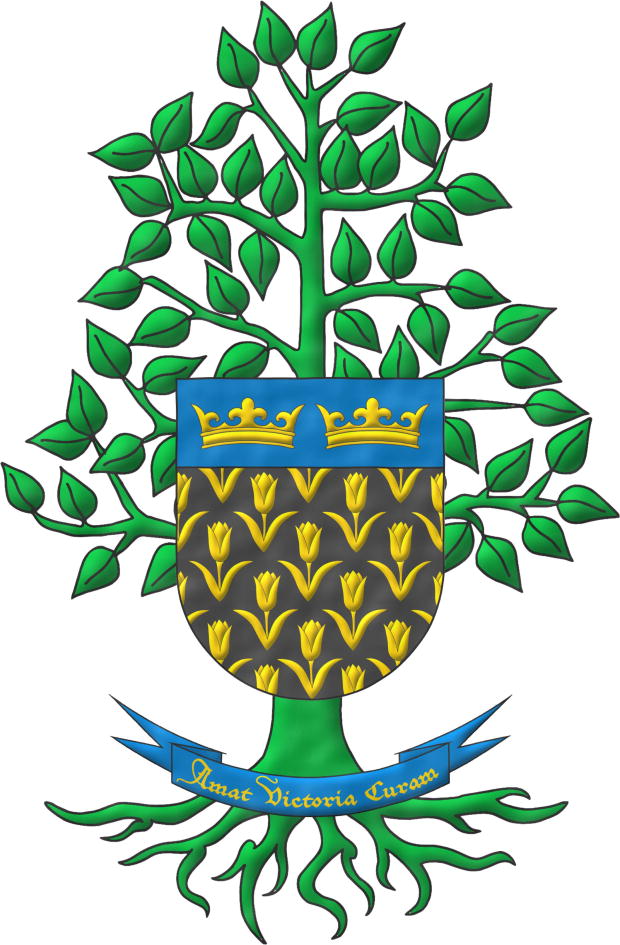
Sable, semé of Tulips Or; on a chief cousu Azure, two Crowns Or, in fess. Supporter A Tree Vert, eradicated. Motto «Amat victoria curam».
Escudo de sable, sembrado de tulipanes de oro; el jefe cosido de azur, dos coronas de oro, en faja. Por sostén un árbol de sinople, arrancado. Lema «Amat victoria curam» de oro, sobre una filacteria de azur.
The original design of this coat of arms, along with many others heraldic devices, is registered in [Salmerón Cabañas, A.; 2015a; page 11].
Blazon keywords: Without divisions, Sable, Or, Azure, Chief, Two, Crown, In fess, Semé, Tulip, Crest and mantling, Vert, Tree, Erased, Supporter (thing), Supporter, Motto and Scroll.
Style keywords: Watercolor, Semi-circular, Illuminated, Outlined in the field tincture, Outlined in sable and Cousu.
Classification: Coat of arms, Created and Personal.
Bearer: Quesada Valles, Bartolomé.


Bailleul, commune of
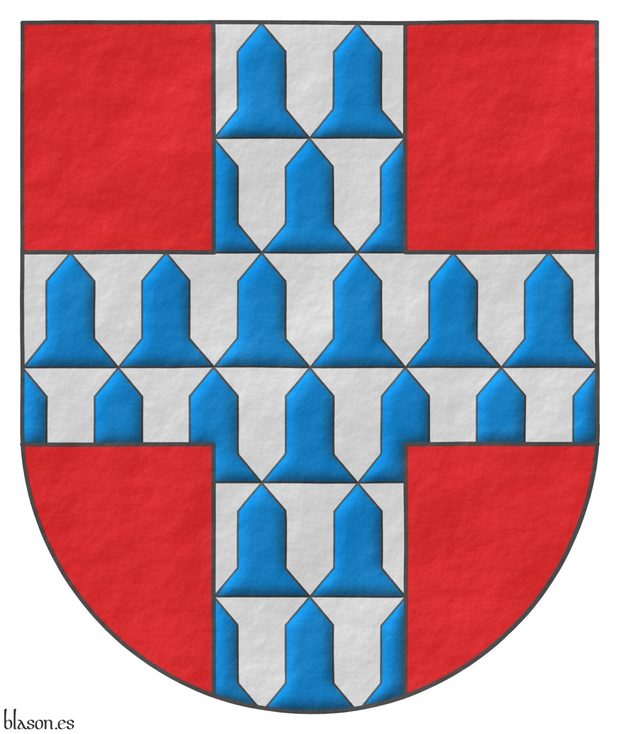
Gules, a cross vair.
Escudo de gules, una cruz de veros.
Coat of arms interpreted with: a semicircular (round) base; the field in flat tincture of Gules; the vair illuminated and outlined in Sable; and the whole with a roughened finish.
The commune of Bailleul is located in the district of Dunkirk, in the Nord department, in the Nord–Pas-de-Calais region of France.
The coat of arms of Bailleul, called «Belle» in Flemish, is similar to that of the heraldist Gonzalo Argote de Molina, differing in that the commune’s arms bear vair, while the heraldist’s arms bear rounded vair in the ancient style.
Blazon keywords: Without divisions, Gules, Argent, Azure, Cross and Vair.
Style keywords: Semi-circular, Illuminated, Outlined in sable and Rough.
Classification: Interpreted, Civic, Coat of arms and Kingdom of France.
Bearer: Bailleul, commune of.


Barras y división de la diagonal
Bendy sinister of seven.
Escudo, tres barras.
Blazon keywords: Without divisions and Bend sinister.
Style keywords: Ogee and Freehand.
Classification: Schema.


Basic chevron
Delineation, ratios and angles of a basic chevron.
Frente a los que denomino cabrio clásico y cabrio abierto, este se traza por el simple cruce de una banda y una barra.
Produce un desigual reparto de los espacios vacíos del campo, amplio por encima, escaso por debajo. Dependiendo del diseño que se haya que realizar, esto puede ser una ventaja o un inconveniente.
Por ejemplo, en este caso del escudo de Juan de Ladbrooke, no hay cargas ni figuras para las que habilitar espacio, sólo es un cabrio de armiños, por lo que esta forma de diseño puede ser adecuada y, más aún, si se desea un clara y patente representación del azur.
Sobre cómo se calculan los 50,2o del ángulo de este cabrio, empleando el arcotangente de 6/5, puede consultarse el artículo que lleva por título esquema de una banda y una barra.
Blazon keywords: Without divisions, Chevron and Ermine.
Style keywords: Semi-circular.
Classification: Schema.
Bearer: Juan de Ladbrooke.


Baudry in France
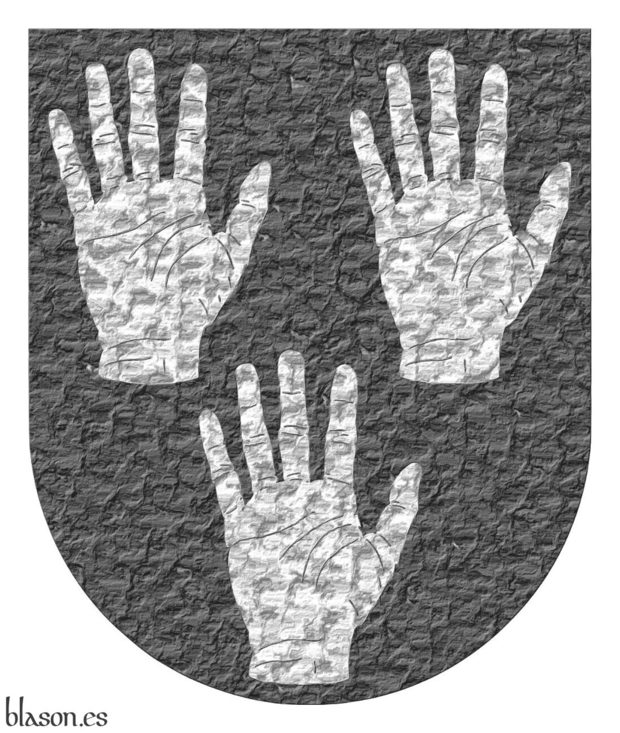
Sable, three dexter hands turned up, and appaumée Argent.
Escudo de sable, tres manos diestras levantadas y apalpadas de plata.
Coat of arms interpreted based on blazon and explanations of [Avilés, J.; 1725a; pages 34 y 35 y sheet 2 figure 38].
Blazon keywords: Without divisions, Sable, Three, Hand, Dexter, Argent, Turned up, Appaumée and Ordered.
Style keywords: Semi-circular, Plain tincture, Outlined in the field tincture and Soft metal.
Classification: Interpreted, Personal and Kingdom of France.
Bearer: Baudry en Francia.


Baztanes of Navarre
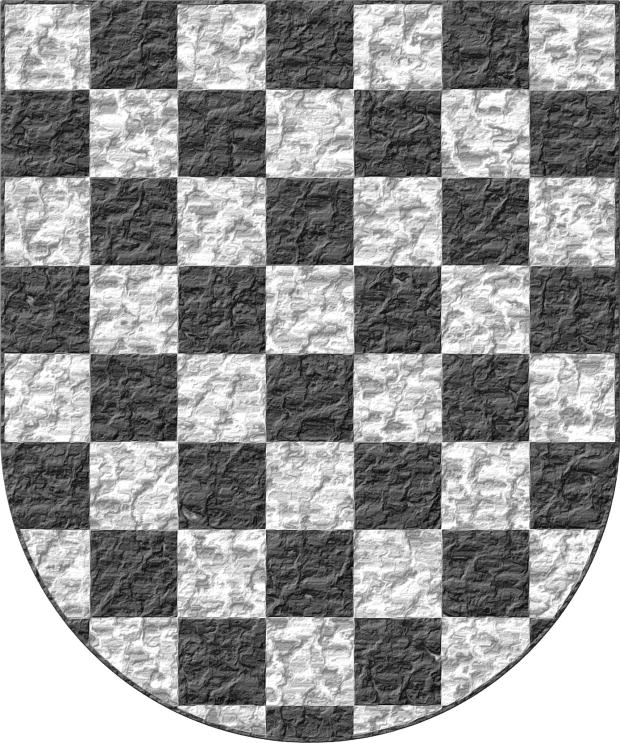
Of the twelve lineages of Noblemen, it is the fourth, and they bear as arms a chessboard, that is, a field chequy Argent and Sable, which is black, in the same form and design as this shield is now painted.
Chequey Argent and Sable.
Escudo ajedrezado de plata y sable.
Coat of arms recreated with: a semicircular (round) base; the field in flat Argent; the chequy or checky pattern illuminated in Sable; and finished in highly-hammered metal.
Coat of arms based on the fourth of the Navarrese «ricoshombres» from [Bosque, J. del; 1540; folio 1 of the numbering of 1613], but, unlike the original, adjusting the height of each square to its width so that they are perfect squares, since in Juan del Bosque’s version—actually in its copy, because the original was stolen—they appear somewhat narrow and elongated. The text heading this article is taken from the transcription made by [Martinena Ruiz, J. J.; 1982; pages 122 and 123].
Under the title «Surname of Baztan» it can also be consulted in [Vega, P. J. de; 1702; folio 4 of the manuscript], although in this case the numbering is not clearly legible; it is the folio following 3, preceding the one also numbered 4 but marked with a letter B, which in turn is followed by folio 6, the number 5 being missing — though not folio 5, which would be 4B.
Baztanes and the Valley of Baztan are mentioned in [Garaycoa Raffo, L.; 2011; pages 8, 29, 30, 33, 37, and 38].
The geometric construction of this coat of arms can be found in [Messía de la Cerda y Pita, L.; 1990; page 108].
Blazon keywords: Without divisions, Or, Chequey and Sable.
Style keywords: Semi-circular, Illuminated and Hard metal.
Classification: Interpreted, Personal and Kingdom of Navarre.
Bearer: Baztanes of Navarre.


Benedict XII
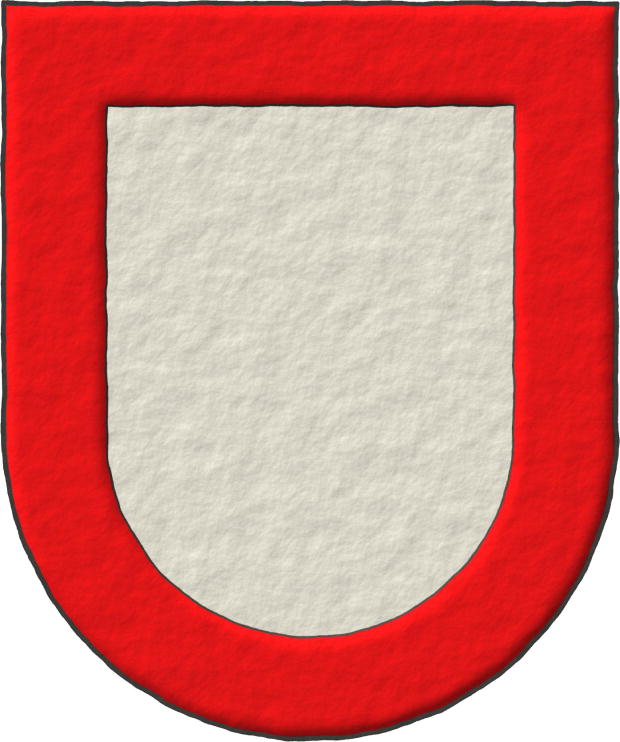
197th Pope of the Church, from 1334 to 1342. «Benedictus XII», born Jacques Fournier, was born in Saverdun, in the south of Occitania.
Argent, a bordure Gules.
Escudo de plata, una bordura de gules.
Papal coat of arms interpreted with: a round-topped shield; the field in plain Argent; the bordure outlined in Sable and illuminated in Gules; and the whole design in raised outline.
Blazon keywords: Without divisions, Argent, One, Bordure and Gules.
Style keywords: Semi-circular, Illuminated, Outlined in sable and Freehand.
Classification: Interpreted, Religious and Papal States.
Bearer: Benedict XII.


Benedict XIV
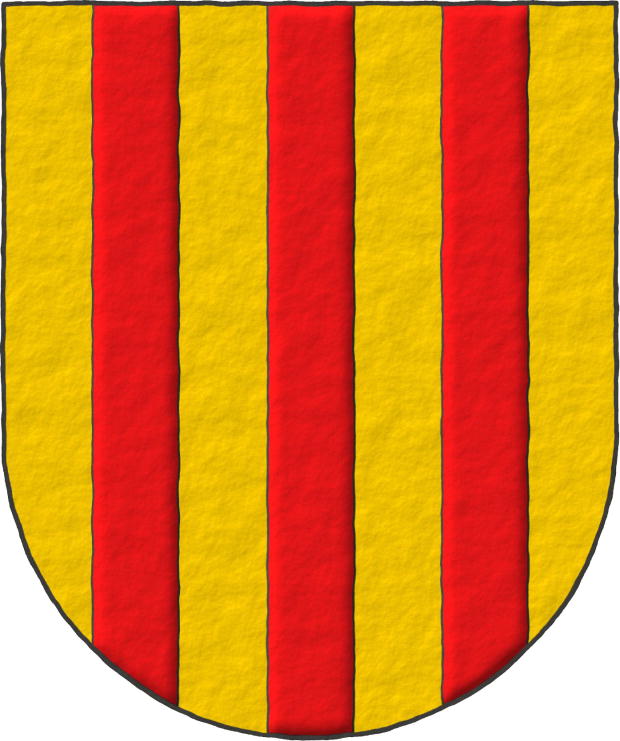
247th Pope of the Church, from 1740 to 1758. «Benedictus XIV», named Prospero Lorenzo Lambertini, born in Bologna.
Or, three pallets Gules.
Escudo de oro, tres palos de gules.
Papal coat of arms interpreted with: a rounded mouth; the field in flat tincture of Or; the pales outlined in Sable and illuminated in Gules enamel; and the whole with a raised stroke finish.
Blazon keywords: Without divisions, Or, Three, Pale and Gules.
Style keywords: Semi-circular, Illuminated, Outlined in sable and Freehand.
Classification: Interpreted, Religious and Papal States.
Bearer: Benedict XIV.


Berenguela of Castile and Alfonso IX
[ Argent, a lion rampant Purpure, armed and langued Gules ] accolé with [ Gules, a castle triple towered Or, port and windows Azure, masoned Sable ].
[ Escudo de plata, un león rampante de púrpura, armado y lampasado de gules ] acolado de un [ escudo de gules, un castillo de oro, aclarado de azur, mazonado de sable ].
Arms of the King of Leon and Queen of Castile, as interpreted by me with: the two shields shaped with rounded arches; the fields of both coat of arms, the lion, and the castle illuminated; and the whole composition featuring a watercolor finish.
Representation of the coats of arms of Alfonso IX of León and Berenguela of Castile as accolé arms ~ «escudos acolados». King Ferdinand III created his coat of arms, based on the coats of arms of his parents, through the marshalling of their arms ~ «composición de sus armas». For this purpose, the saintly king invented a type of composition, which later became widely used, known as quarterly ~ «cuartelado». Other ways to combine the coats of arms of two spouses are:
- Creating a new dimidiated shield ~ «dimidiado».
- Creating a new impaled shield ~ «partido».
- Adding one coat of arms to another as an escutcheon of pretence ~ «escusón de pretensión», in this case, rather than a claim, there was full ownership.
Blazon keywords: Without divisions, Argent, Purpure, Gules, One, Lion, Rampant, Armed, Langued, Or, Azure, Sable, Castle, Port and windows and Masoned.
Style keywords: Semi-circular, Outlined in sable, Tilted shield and Watercolor.
Classification: Interpreted, Personal, Accolé arms, Kingdom of Castile and Kingdom of León.
Bearer: Berenguela of Castile.


Berry of Molland
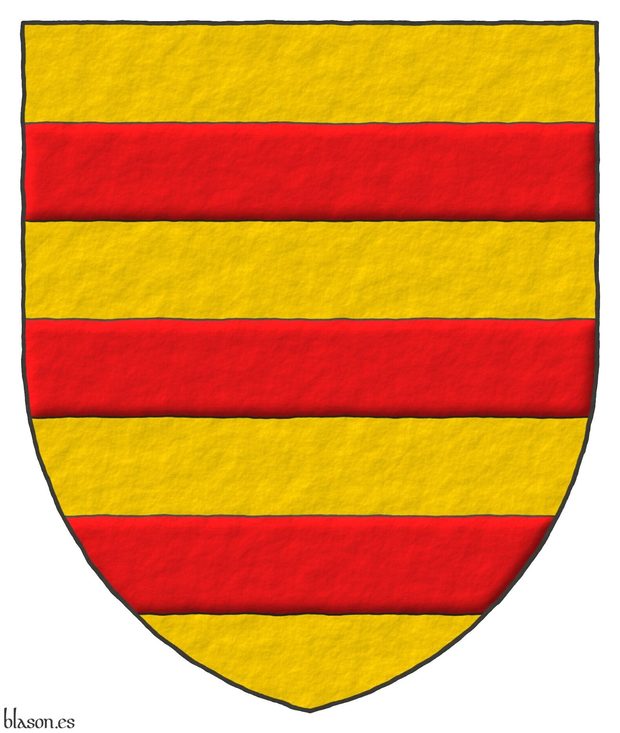
Berry of Molland, Devonshire.
Or, three fesses Gules.
Escudo de oro, tres fajas de gules.
It is possible that an English-speaking herald would have blazoned it as «Or, three bars Gules.» using the term «bars» instead of «fesses», just as in Castilian one sometimes uses the term «barras» instead of «palos», perhaps because these terms were not completely settled from the outset.
Blazon keywords: Without divisions, Or, Fess and Gules.
Style keywords: Pointed, Illuminated, Outlined in sable and Freehand.
Classification: Interpreted and Personal.
Bearer: Berry of Molland.
Blazon equivalent to: Clement V.


![Ver [Bosque, J. del; 1540] en referencias bibliográficas. Libro abierto, hojas de plata, filo de oro, guardas de gules, tapas de sable.](../css/Libro.Bibliografia.png)
Bosque, J. del; 1540
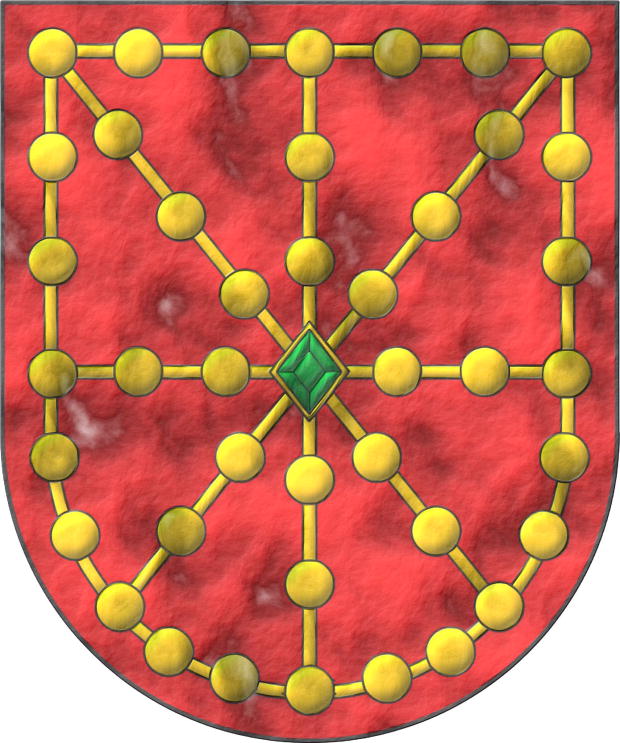
Juan del Bosque, «Libro de Armería del Reino de Navarra», which is currently missing and whose subsequent copy, commissioned in 1572, is kept in the Royal and General Archive of Navarre, estimated year of creation 1540.
The origin of this armorial dates back to 1527, when the Navarrese Courts requested that the Royal Council and the Chamber of Comptos ~ Chamber of Accounts and Fiscal Control, record in a book the coats of arms of the kingdom of Navarre starting with that of the king of Navarre and the houses and lineages of the so-called «ricoshombres», Almorrabides, Guebara, Aybar, Baztanes, Urroz, Lete, Subiça, Rada, Vidaurre, Qasqante, Monteagudo, and Mauleón, also including the coats of arms of other manors, houses, valleys, towns, and nobles [Valverde Ogallar, P. B.; 2001; page 326].
According to [Martinena Ruiz, J. J.; 1982; page 35] the book was compiled around the year 1540, and this is the date I use for referencing this armorial.
This first manuscript created by Juan del Bosque was taken by the royal visitor Hernán Suárez de Toledo, under the pretext of taking it to Emperor Charles V, despite being requested back by the Navarrese Courts, it was never returned and was definitively lost. The armorial that has come down to us is a recreation commissioned in 1572 [Valverde Ogallar, P. B.; 2001; page 327].
According to [Menéndez Pidal de Navascués, F.; 1974; page 19] the recreation of this armorial was carried out based on certifications, such as those from the herald Azcárraga, and notes and partial copies of the stolen book, like the copy kept in the monastery of Leyre.
Another noteworthy bibliographic reference about this armorial, in addition to those previously mentioned, is [Martinena Ruiz, J. J.; Menéndez Pidal de Navascués, F.; 2001].
The image illustrating this bibliographic reference is the coat of arms of the king of Navarre, which I recreated based on the illustration in this armorial, on its first folio according to the numbering given to it in 1613.
Bibliographical reference of century XVI.
The author is Bosque, Juan del.
Here are the articles quoting this reference:
- Almorrabides of Navarre
- Aybar of Navarre
- Baztanes of Navarre
- Guebara of Navarre
- Lete of Navarre
- Martinena Ruiz, J. J.; 1982
- Martinena Ruiz, J. J.; Menéndez Pidal de Navascués, F.; 2001
- Mauleón of Navarre
- Menéndez Pidal de Navascués, F.; 1974
- Menéndez Pidal de Navascués, F.; 1985
- Menéndez Pidal de Navascués, F.; Martínez de Aguirre, J.; 2000
- Monteagudo of Navarra
- Navarra, closed carbuncle
- Navarre
- Noblemen of Navarre
- Qasqante of Navarre
- Rada of Navarre
- Subiça of Navarre
- Urroz of Navarre
- Vidaurre of Navarre


Boteler of Warrington
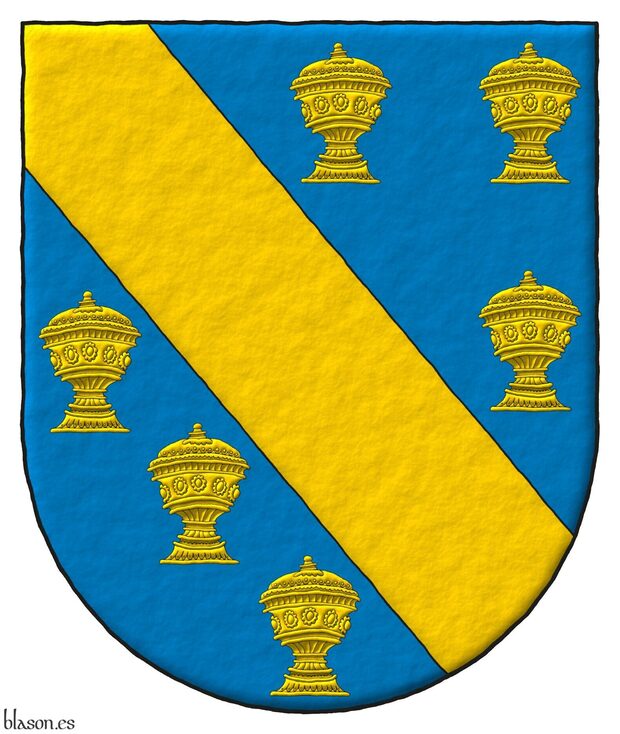
Azure, a bend between six covered cups Or.
Escudo de azur, una banda acompañada de seis copas todo de oro.
Illuminated with lights and shadows and with a freehand finish.
Around 1155, Beatrix de Villers married Richard le Boteler Pincerna, who became the 4th Baron of Warrington. The heir of Beatrix and Richard took the surname «le Boteler» and ruled the Warrington region, bearing arms Azure, a bend between six covered cups Or.
In Castilian, a «copa» has a lid and is referred to as a «covered cup» in English. When it doesn't have a lid, it's called a «cup» in English and a «cáliz» or «copón» in Castilian, the latter being a less preferred term for me. In English, the term «chalice» is also used, especially if it's adorned with gemstones, although that's more of an artistic license.
Naipes Heraclio Fournier is a renowned Spanish playing card manufacturer based in Villareal de Álava. The countless hours I have spent holding its cards in my hands are incalculable, whether playing with friends, opponents, or performing magic tricks. Its influence on my heraldic artwork is significant. For instance, in this covered cup.
The following image shows my covered cup and my two interpretations of his arms: 1) the most commonly viewed, and 2) my alternative layout.
Blazon keywords: Without divisions, Azure, One, Bend, Between, Six, Covered cup and Or.
Style keywords: Freehand, Outlined in sable, Illuminated and Semi-circular.
Classification: Interpreted and Kingdom of England.
Bearer: Boteler of Warrington.


Bourgeois, lineage of Burgundy
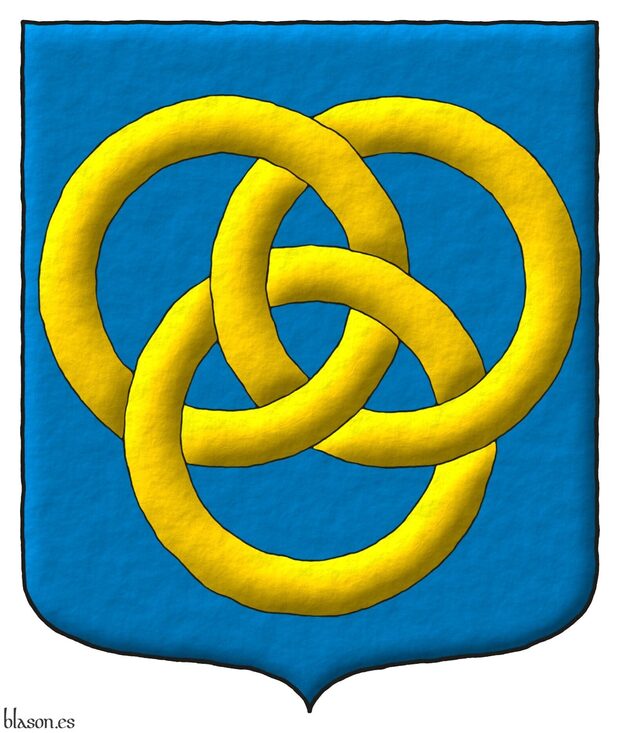
Azure, three annulets interlaced Or.
Illuminated, with a watercolor finishing and with a pointed shape.
You can found it at [Avilés, J.; 1725a; page 76 and illustration 177]], and at [Avilés, J.; 1780a; page 85 and illustration 177]].
Blazon keywords: Without divisions, Azure, Three, Annulet, Interlaced and Or.
Style keywords: Watercolor, Outlined in sable, Illuminated and Pointed.
Classification: Interpreted, Lineage, Kingdom of France and Coat of arms.


Bourgeois, lineage of Burgundy, France

Azure, three annulets interlaced Or.
Escudo de azur, tres anilletes entrelazados de oro.
Coat of arms emblazoned by me with plain color Azure and metal Or and with a shape ended with an ogee arch.
Blazon keywords: Without divisions, Azure, Three, Annulet, Interlaced and Or.
Style keywords: Watercolor, Outlined in sable, Illuminated and Ogee.
Classification: Interpreted, Lineage, Kingdom of France and Coat of arms.


BPAC, Roger de Flor II
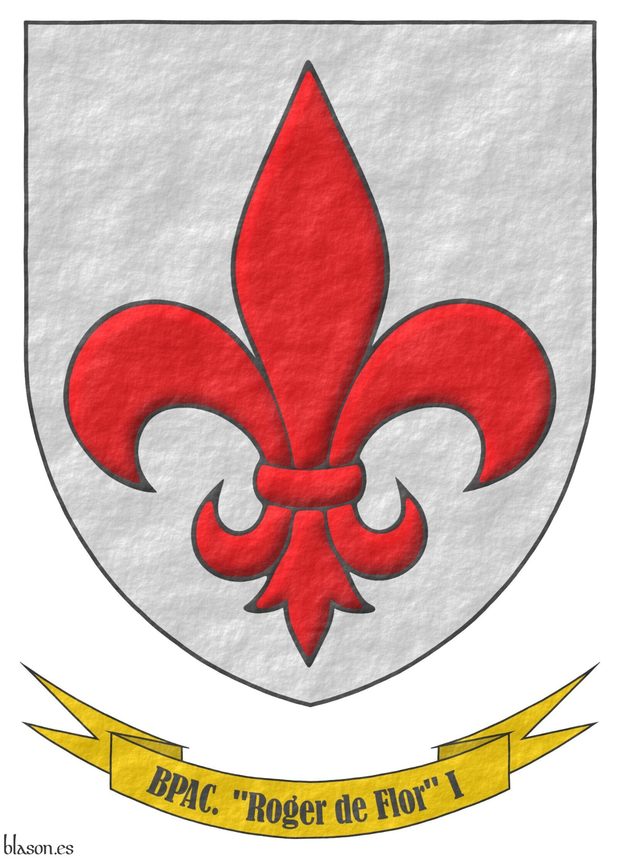
Light Parachute Infantry Unit.
Argent, a Fleur de lis Gules. Motto: «BPAC. Roger de Flor II».
Escudo de plata, una flor de lis de gules. Divisa: «BPAC. Roger de Flor II».
Coat of arms interpreted with: a shield with a pointed (ogival) base; a fleur de lis outlined in Sable and illuminated in Gules; and an overall rough finish.
Blazon keywords: Without divisions, Argent, Gules, Fleur de lis and Motto (identification).
Style keywords: Semi-circular, Illuminated, Outlined in sable and Rough.
Classification: Interpreted, Military, Army and Navy and Coat of arms.
Bearer: BPAC I.


BPAC, Roger de Lauria II
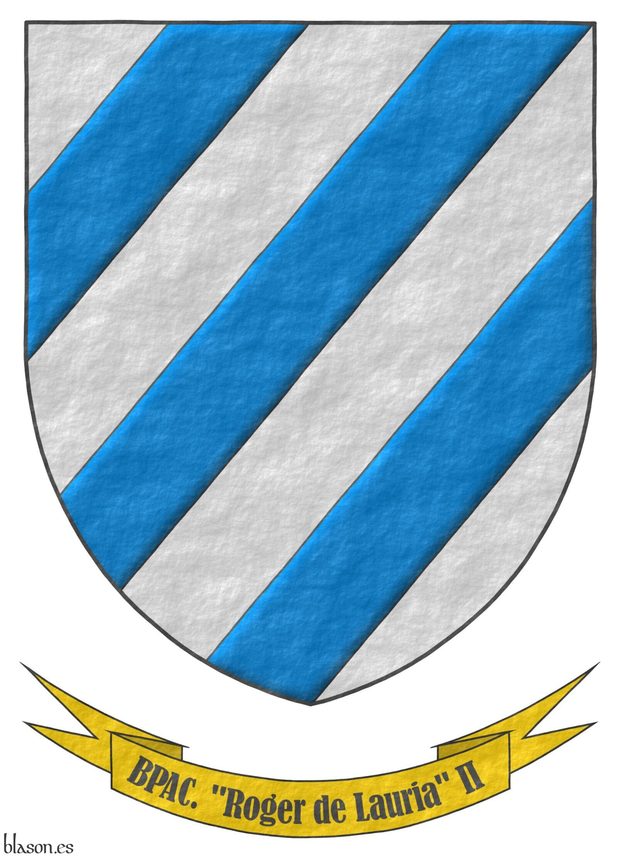
Parachute Light Infantry Unit.
Argent, three bendlets sinister Azure. Motto: «BPAC. Roger de Lauria II».
Escudo de plata, tres barras de azur. Divisa: «BPAC. Roger de Lauria II».
For this interpretation, I have used: a shield with a pointed shape; the angle of the main diagonal of a rectangle with a 5x6 proportion, which is 50.2o; a recreation of the division that I deduce seems to be used by the Spanish Army for this coat of arms; and for the whole, a rough finish.
Blazon keywords: Without divisions, Argent, Azure, Bend sinister and Motto (identification).
Style keywords: Semi-circular, Illuminated, Outlined in sable and Rough.
Classification: Interpreted, Military and Army and Navy.
Bearer: BPAC II.


![Ver [Brault, G. J.; 1997] en referencias bibliográficas. Libro abierto, hojas de plata, filo de oro, guardas de gules, tapas de sable.](../css/Libro.Bibliografia.png)
Brault, G. J.; 1997
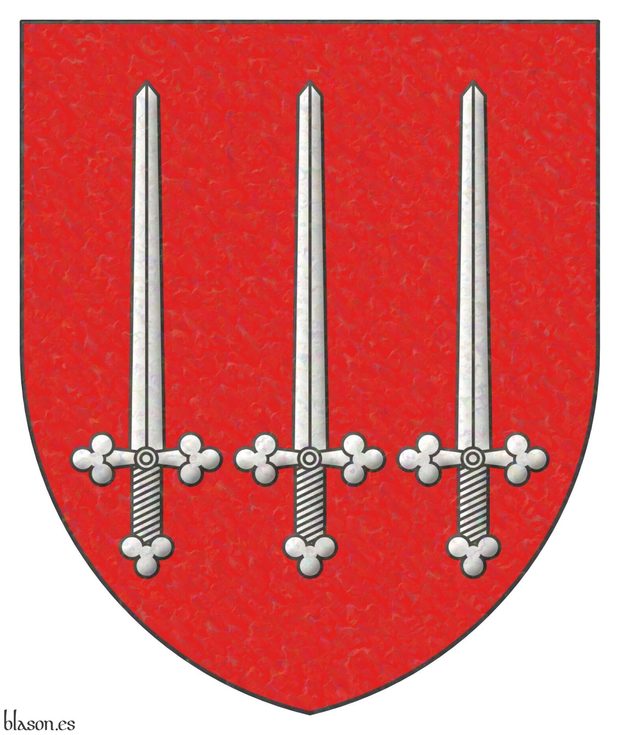
Gerard J. Brault, professor of French and Medieval Studies at Pennsylvania State University, «Rolls of Arms of Edward I, 1272-1307, Volume I and Volume II», is a set of 2 volumes, 1,104 pages, size 24.4 x 17.2 cm, with 3 color illustrations and 8 black and white illustrations, published by Boydell Press, Aspilogia series, ISBN 9780851156699, Suffolk, United Kingdom, May 1, 1997.
Another annotated edition exists from February 21, 2008, also published by Boydell Press.
The starting hypothesis of this book is that at the beginning of the second half of the 13th century, the use of coats of arms increased, this increase led to the appearance of the first armorials in which the names of their holders were recorded along with the descriptive blazon of their armory, and painted shields could be included.
From the Middle Ages, about 350 armorials have survived, of which 130 come from England, and they are a unique source for identifying many medieval figures, their titles, and their possessions. This book analyzes 17 of these armorials, such as the so-called [Marshal, L.; 1295; The Lord Marshal's Roll], which includes the coat of arms of William de Colebrand that illustrates this bibliographic reference.
Bibliographical reference of century XX.
The author is Brault, Gerard J..
Bibliographic reference mentioned in the following articles:
External resource:


![Ver [Brutus of Britain, banner] en criterios utilizados. Unicornio saltante sobre la divisa, criterio.](../css/Unicornio.Criterio.png)
Brutus of Britain, banner
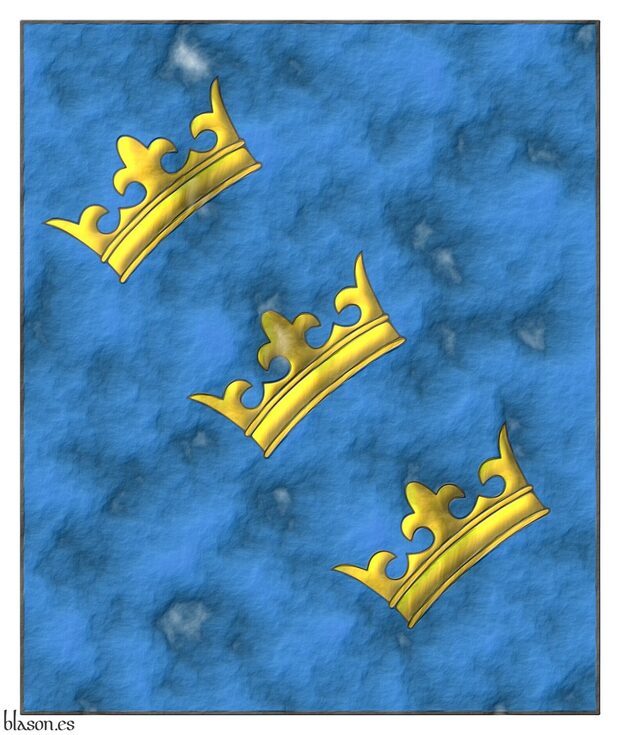
Banner Azure, three crowns in bend, bendwise Or.
Pendón de azur, tres coronas en banda, puestas en banda de oro.
Banner interpreted by me as follows: the field is enameled in plain Azure ink; the three crowns are outlined in Sable and illuminated in Or; and on old parchment.
Banner recreated from [Edward IV of England; 1461; row 13, 1st column].
Blazon keywords: Without divisions.
Style keywords: Rectangular, Illuminated, Outlined in sable and Crystalline.
Classification: Interpreted, Imaginary, Flag, Banner of arms, Kingdom of England and Criterion.
Imaginary bearer: Brutus of Britain.


Bunyoro-Kitara
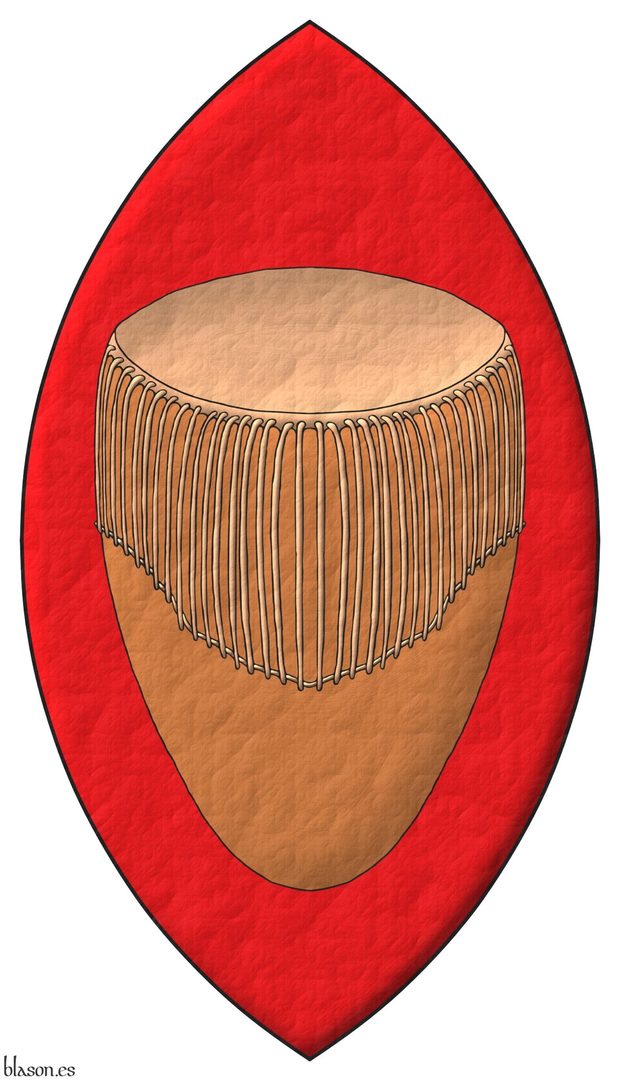
Gules, a Royal drum of Bunyoro-Kitara proper.
Escudo de gules, un tambor real de Bunyoro-Kitara al natural.
Coat of arms emblazoned by me with a visica piscis shape, illuminated, and with a leather finishing.
Bunyoro Kitara is a Bantu kingdom located in Western Uganda. Its history begun in the 13th century. This kindowm is ruled by the King called Omukama of Bunyoro-Kitara. Now it is a subnational monarchy.
Blazon keywords: Without divisions, Gules, One, Drum, Royal and Proper.
Style keywords: Vesica piscis, Outlined in sable, Illuminated and Leather.
Classification: Civic, Interpreted and Coat of arms.
Bearer: Bunyoro-Kitara.


Cavalry Regiment Montesa, royal crown
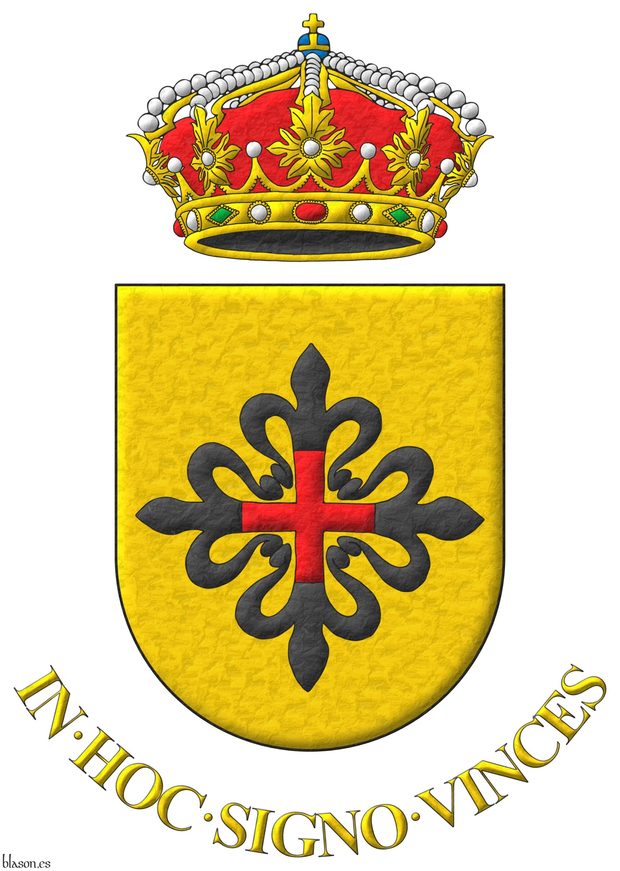
In this sign, you shall conquer.
Argent, a cross of Montesa. Crest: A closed royal crown Or, with eight arches, visible five. Motto: «In hoc signo vinces».
Escudo de oro, una cruz de Montesa. Timbrado de una corona real cerrada. Lema: «In hoc signo vinces».
Coat of arms interpreted as follows: the shape of the shield is a semi-circular arch; the field has been illuminated in metal Or; the cross of Montesa is outlined in Sable and illuminated in Sable and Gules; the royal crown is closed, outlined in Sable and illuminated the metal in Or, the pearls in Argent, the orb in Azure and Or, the gemstones in Gules and Vert, the inner cloth in Gules, and the visible hollow at its base in Sable; and the whole has a slightly beaten metal finish.
Regimental Motto
The Latin motto «In hoc signo vinces» is translated as «In this sign, you shall conquer».
Globus cruciger ~ Orb
It is called orb ~ «globus cruciger», the first in Spanish and the second in Latin, referring to the part of the royal crown, a jewel, or a jewel itself that recreates the shape of the globe topped with a cross.
Blazon keywords: Without divisions, Or, Cross of Montesa, Cross couped, Cross, Crest, Closed royal crown, Crown and Motto.
Style keywords: Semi-circular, Illuminated, Outlined in sable and Soft metal.
Classification: Interpreted, Military, Army and Navy and Coat of arms.
Bearer: Montesa, Cavalry Regiment.


![Ver [Chaparro D'Acosta L.; 1979] en referencias bibliográficas. Libro abierto, hojas de plata, filo de oro, guardas de gules, tapas de sable.](../css/Libro.Bibliografia.png)
Chaparro D'Acosta L.; 1979
Lino Chaparro D'Acosta, «Heráldica de los Apellidos Canarios», foreword by Vicente de Cadenas y Vicent, 2 volumes, Volume I from A to L, 285 surnames, 293 pages, Volume II from M to Z and a heraldic dictionary, 387 surnames, 439 pages, edited by Estudios Tecnicos del Blason, ISBN of the complete work 84-300-2000-4, ISBN of Volume I 84-300-1989-8, ISBN of Volume I II 84-300-418010-8, Las Palmas de Gran Canaria, 1979.
Bibliographical reference of century XX.
Classification: Black and white with color plates and Castilian language.
The author is Chaparro D'Acosta, Lino.
The following article cites this bibliographic reference:


Charles Dunne, Chas
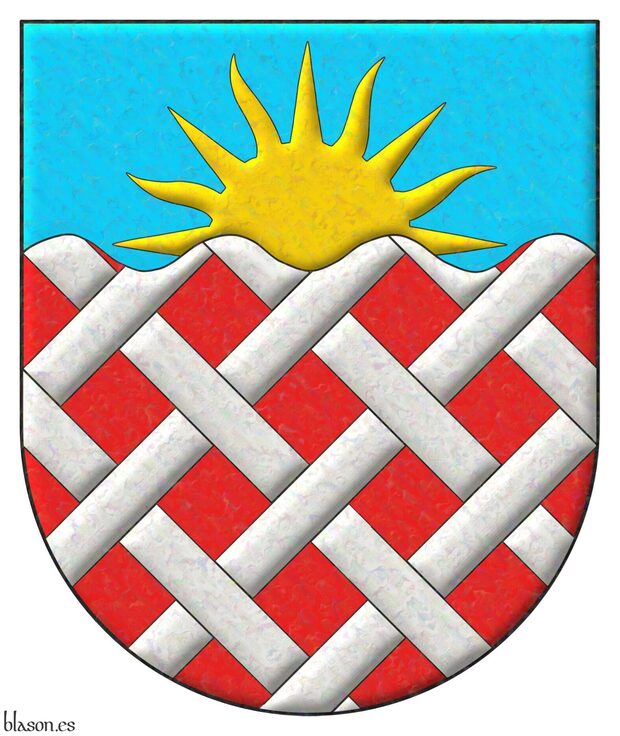
Motto: Stand and Be Counted
Gules fretty Argent; on a chief wavy Bleu celeste, a rising sun Or.
Escudo de gules fretado de plata; en un jefe ondado de celeste, un sol saliente de oro.
Coat of arms interpreted and emblazoned by me with with a semi-circular ended shape, illuminated, and with a iridescent finishing.
The sun used to be emblazoned with a human face, with its eyes, mouth, and nose, but in all the interpretations that I know of this blazon, the sun appears without a human face.
Schema for the fretty
Blazon keywords: Without divisions, Gules, Fretty, Argent, One, Chief, Wavy, Bleu celeste, Sun, Issuant and Or.
Style keywords: Iridescent, Outlined in sable, Illuminated and Semi-circular.
Classification: Interpreted.
Bearer: Charles Dunne, Chas.


Charles V of France
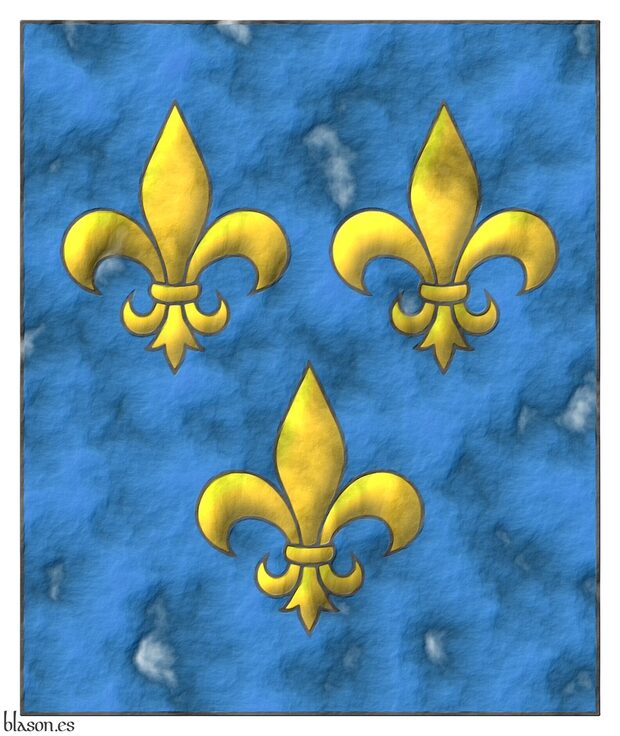
Banner Azure, three fleurs de lis Or.
Pendón de azur, tres flores de lis de oro.
Banner interpreted as follows: rectangular in shape with a 5x6 proportion; the field enamelled in flat Azure; the three fleurs-de-lis illuminated in Or and outlined in Sable; and the whole piece finished with an aged parchment effect.
Starting in 1376, the field sown with fleurs-de-lis was replaced by only three fleurs-de-lis. This change took place during the reign of Charles V of France (1338–1380, King of France from 1364 to 1380).
Edward III Plantagenet (1312–1377, King of England from 1327 to 1377) had incorporated the semé of fleurs-de-lis into his arms as a sign of his claim to the French throne, and Henry IV of England (1367–1413, King of England from 1399 to 1413) again changed the semé into three fleurs-de-lis in his own arms.
These three fleurs-de-lis remained in the royal arms of England until George II (1683–1760, King from 1727 to 1760).
They remained in the royal arms of the French kings until their prohibition during the so-called «Hundred Days», that is, from March 20, 1815, the date of Napoleon’s return to Paris from his exile in Elba, until June 28, 1815, the date of the Second Restoration of Louis XVIII as King of France, when they were reinstated. Finally, after the Revolution of 1830, Louis Philippe I of Orléans decreed their abolition by Order of February 10, 1831.
This banner is a recreation of the one appearing in the armorial [Edward IV of England; 1461; row 23, column 2], although in that armorial the banner seems to be associated with Louis IX of France, perhaps because of the prestige of the saintly King of France, whose arms bore a semé of fleurs-de-lis rather than three.
Blazon keywords: Without divisions, Azure, Or, Three, Fleur de lis and Ordered.
Style keywords: Rectangular, Illuminated, Outlined in sable and Old parchment.
Classification: Interpreted, Personal, Flag, Banner of arms, Kingdom of France and House of Valois.
Bearer: Charles V of France.


Charles VII of France
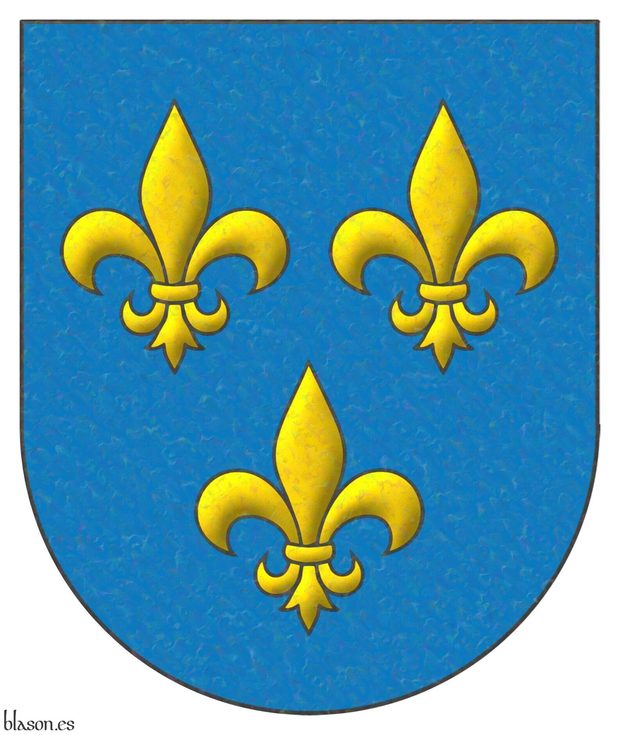
King of France from 1429 to 1461.
Azure, three fleurs de lis Or.
Escudo de azur, tres flores de lis de oro.
Coat of arms interpreted with: a semicircular (round) base; the field enamelled in flat Azure; the fleurs-de-lis illuminated in Or and outlined in Sable; and finished with a mother-of-pearl effect.
This coat of arms is based on the one appearing in the armorial [Ingeram, H.; 1459; page 34, 1st shield], under the inscription «küng von franckrich» (franckrich ~ Frankreich ~ France).
Blazon keywords: Without divisions, Azure, Or, Three, Fleur de lis and Ordered.
Style keywords: Semi-circular, Illuminated, Outlined in sable and Iridescent.
Classification: Interpreted, Personal, Coat of arms, Kingdom of France and House of Valois.
Bearer: Charles VII of France.


Ciudad de Ceuta

City of Ceuta, Spain, Africa, with a crown of Marquis
Argent, five escutcheons in cross Azure, each charged with five plates in saltire; a bordure Gules, charged with seven castles triple-towered Or, 2, 2, 2, and 1. Crest: A crown of Marquis.
Escudo de plata, cinco escudetes en cruz de azur, cada uno cargado de cinco bezantes en sotuer de plata; una bordura de gules, cargada de siete castillos de oro, dos en jefe, una en cada flanco y tres en punta. Timbrado de una corona de marqués
Illuminated and a leather finishing.
Coat of arms of Ceuta from the coat of arms of Portugal
The Portuguese conquered Ceuta in the year 1415. This event represents an important step in the development of the Portuguese Empire in Africa. Then Ceuta received its arms from those of Portugal but with the castles in another order. In the image, the 1st coat of arms of Portugal, and the 2nd coat of arms of Ceuta.
Blazon keywords: Without divisions, Argent, Five, Escutcheon, In cross, Azure, Charged, Bezant and plate, Plate, In saltire, Bordure, Gules, Seven, Castle, Or, Two, In chief, One, In each flank, Three, In base, Crown of Marquis and Crown.
Style keywords: Leather, Outlined in sable, Illuminated and Semi-circular.
Classification: Civic, Interpreted and Kingdom of Spain.
Bearer: Ceuta.


Classic chevron
Delineation, ratios and angles of a classic chevron.
Blazon keywords: Without divisions and Chevron.
Style keywords: Semi-circular.
Classification: Schema.
Bearer: Adan de Creeting.


Clement V
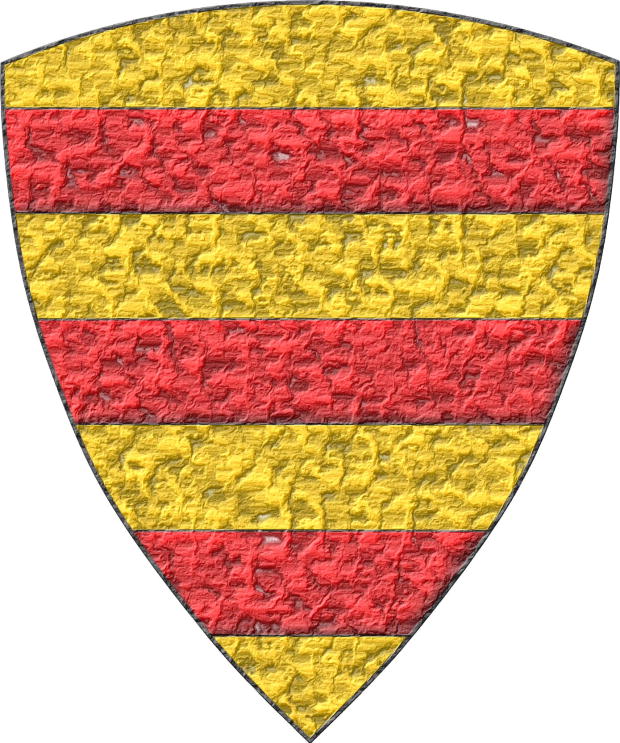
195th Pope of the Church, from 1305 to 1314. «Clemens V», born Bertrand de Got, born in Villandraut, in the southwest of France, was the first pope to reside in Avignon in a stable manner.
Or, three fesses Gules.
Escudo de oro, tres fajas de gules.
Papal coat of arms interpreted with: a rounded triangular top; the field in plain Or enamel; the bars illuminated in Gules and outlined in Sable; and with a heavily hammered metal finish.
Blazon keywords: Without divisions, Or, Three, Fess and Gules.
Style keywords: Triangular curved, Illuminated, Outlined in sable and Hard metal.
Classification: Interpreted, Religious and Papal States.
Bearer: Clement V.
Blazon equivalent to: Fernández de Córdoba y Carrillo, Diego.


Clement XII
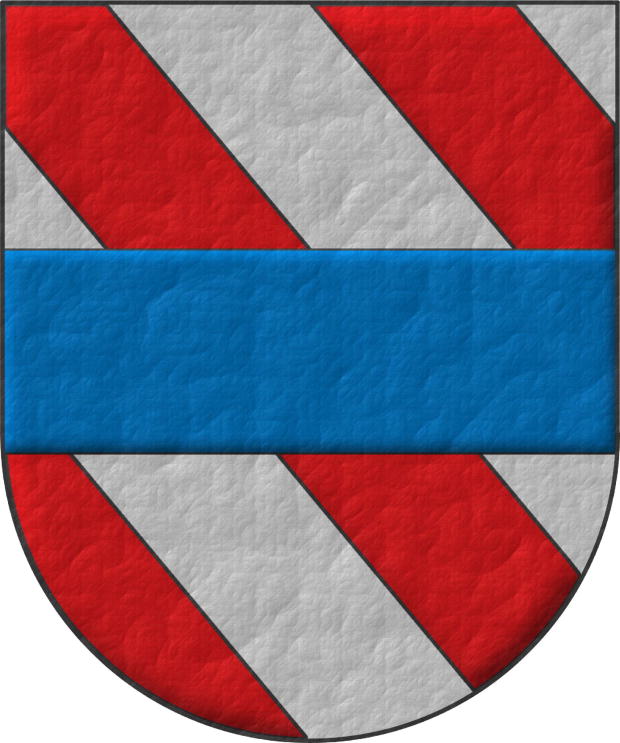
246th Pope of the Church, from 1730 to 1740. «Clemens XII», named Lorenzo Corsini, born in Florence and rests in St. John Lateran.
Bendy of six Gules and Argent; over all a fess Azure.
Escudo bandado de seis piezas de gules y plata; brochante sobre el todo una faja de azur.
Papal coat of arms interpreted with: a rounded mouth; the field in flat tincture of Argent; the fess and the bands outlined in Sable and illuminated in Gules and Azure; and the whole with a textured finish.
All are ordinaries, including the three bands and the fess, and since the blazon specifies that the fess is overall on the bands, therefore, it is not the Gules bands that are overall on the Azure fess, and they should be painted underneath.
Blazon keywords: Without divisions, Bendy, Six, Gules, Argent, Surmounted, Overall (deprecated), One, Fess and Azure.
Style keywords: Semi-circular, Illuminated, Outlined in sable and Freehand.
Classification: Interpreted, Religious and Papal States.
Bearer: Clement XII.


Clermont, Robert of
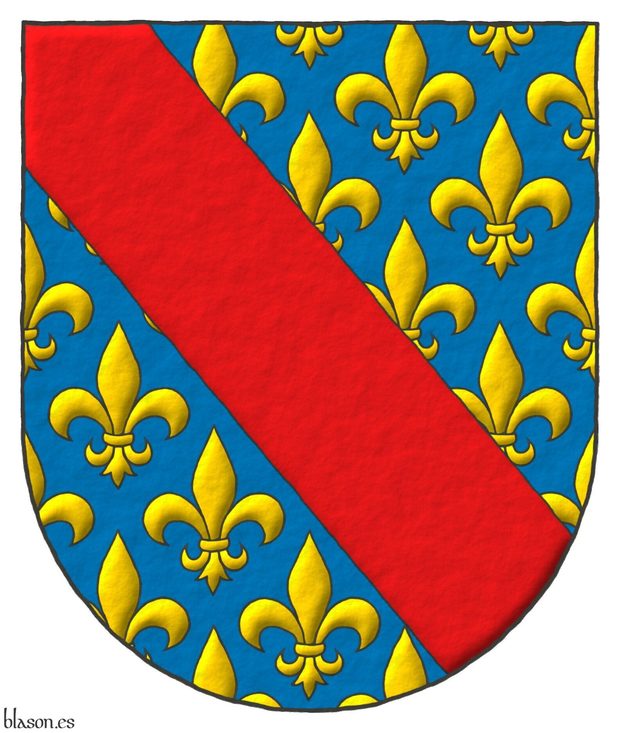
Grandson of Blanche of Castile, 6th son of Saint Louis IX, founder of the House of Bourbon, husband of Beatrice of Burgundy, Lady of Bourbon.
Azure semé of fleurs de lis Or, a bend Gules.
Escudo de Azur sembrado de flores de lis de oro, banda gules.
Coat of arms that I have interpreted with:: a semicircular (round) base; the field enamelled in flat Azure; the fleurs-de-lys illuminated in Or; the bend illuminated in Gules; the whole is outlined in Sable; and the freehand drawing.
Blazon keywords: Without divisions, Azure, Or, Semé, Fleur de lis, Bend and Gules.
Style keywords: Semi-circular, Illuminated, Outlined in sable and Freehand.
Classification: Interpreted, Personal, Coat of arms, Kingdom of France and House of Bourbon.
Bearer: Clermont, Robert of.

Colebrand, William de

Willame de Colebraund ~ William de Colebrand.
Gules, three Swords Argent, erect, in fess.
Escudo de gules, tres espadas de plata, alzadas, en faja.
Interpreted coat of arms with a free hand finish.
Coat of arms included in [Marshal, L.; 1295; coat of arms number 461], also in [Brault, G. J.; 1997], and time ago in Brian Timms, but not now.
Blazon keywords: Without divisions, Gules, Three, Sword, Argent, Point upwards and In fess.
Style keywords: Pointed, Illuminated, Outlined in sable and Freehand.
Classification: Interpreted and Personal.
Bearer: Colebrand, William de.


Edmund Plantagenet
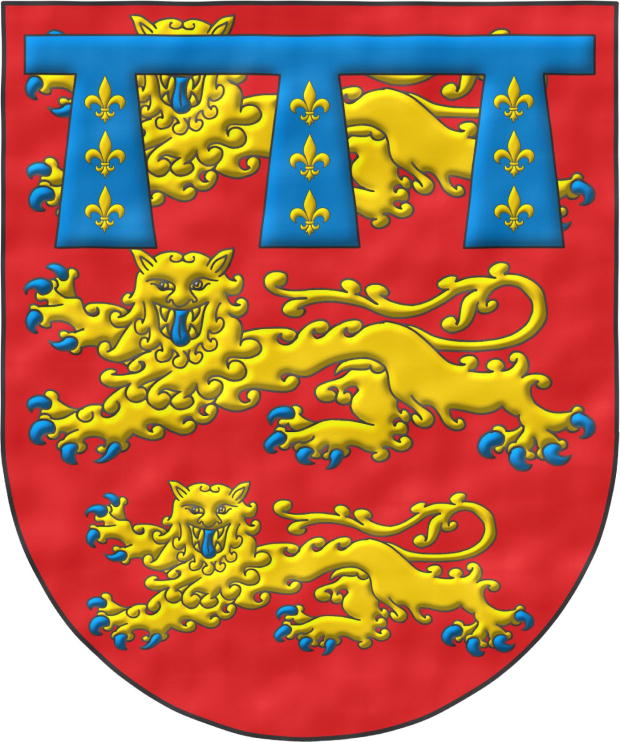
The one with the Cross on his back ~ Crouchback (1245–1296)
Arms of England; overall, a label Azure of three points, each charged with three fleurs-de-lis Or in pale.
Arms interpreted as follows: the mouth of the shield is semicircular (round); the field enamelled in a flat tint of Gules; the label and figures illuminated in Or and Azure and outlined in Sable; and the whole finished with a watercolour effect.
He was the second son of King Henry III of England, and took part in the Ninth Crusade, hence the epithet «Cross on the back».
In 1253 he was appointed Earl of Chester, holding dominion, among others, over the county of Cheshire, but the following year Pope Innocent IV granted him the crown of Sicily, so he ceded his earldom to his elder brother Edward I of England, however, he never came to occupy the throne of Sicily.
The label is an honourable ordinary and also «a kind of mark of cadency, and the most noble of all those used to differentiate the Arms of the younger sons of a House» [Avilés, J.; 1725a; page 248] and it can likewise be used by the eldest son while his father's arms are still in use, ceasing to bear the label when he inherits his father’s coat. When both the eldest and the second son bear a label, the latter’s label then has more points or is charged with figures to distinguish it.
The label is constructed with «a fillet, which is one-ninth of the width of the chief, with three pendants in the form of carpentry wedges or ill-shaped triangles, joined to it without any line of separation, falling twice as far as the fillet is wide, two placed at the ends and one in the middle, its usual position being in the centre of the chief’s length, without reaching the edges of the shield» [Avilés, J.; 1725a; page 248].
Blazon keywords: Without divisions, Gules, Or, Azure, Three, Leopard, Armed, Langued, In pale, Surmounted, Overall (deprecated), Label, Suspended, Charged and Fleur de lis.
Style keywords: Semi-circular, Illuminated, Outlined in sable and Watercolor.
Classification: Interpreted, Personal, Coat of arms, House of Plantagenet and Kingdom of England.
Bearer: Edmund Plantagenet.


Edward II of England
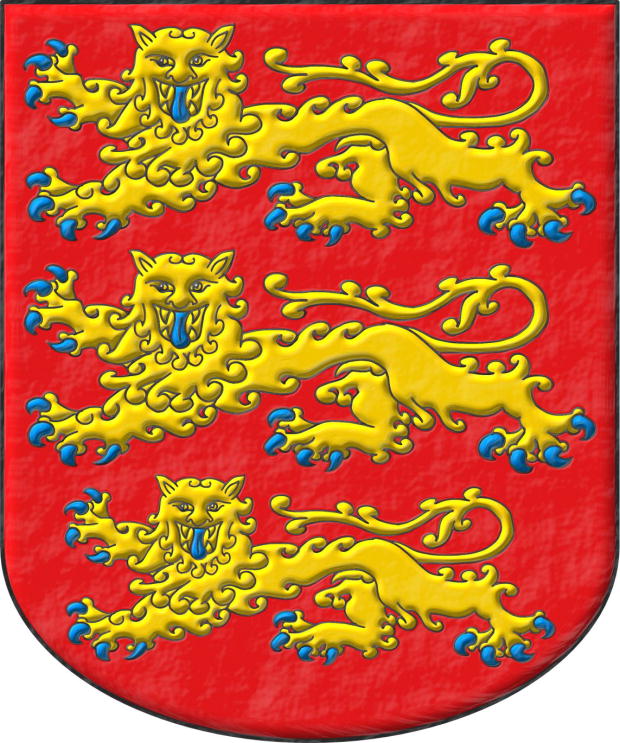
First Prince of Wales from 1301 to 1307, King of England and Lord of Ireland from 1307 to 1327.
Gules, three lions, passant, guardant, in pale Or, armed and langued Azure.
Escudo de gules, tres leopardos en palo de oro, armados y lampasados de azur.
Coat of arms interpreted as follows: the mouth rounded; the field illuminated Gules; the figures illuminated in Or and Azure, outlined in Sable, and the third leopard slightly smaller; and the whole finished with a plastered effect.
Blazon keywords: Without divisions, Gules, Or, Azure, Three, Leopard, Armed, Langued and In pale.
Style keywords: Rounded, Illuminated, Outlined in sable and Gesso.
Classification: Interpreted, Personal, Coat of arms, House of Plantagenet and Kingdom of England.
Bearer: Edward II of England.


Edward Longshanks
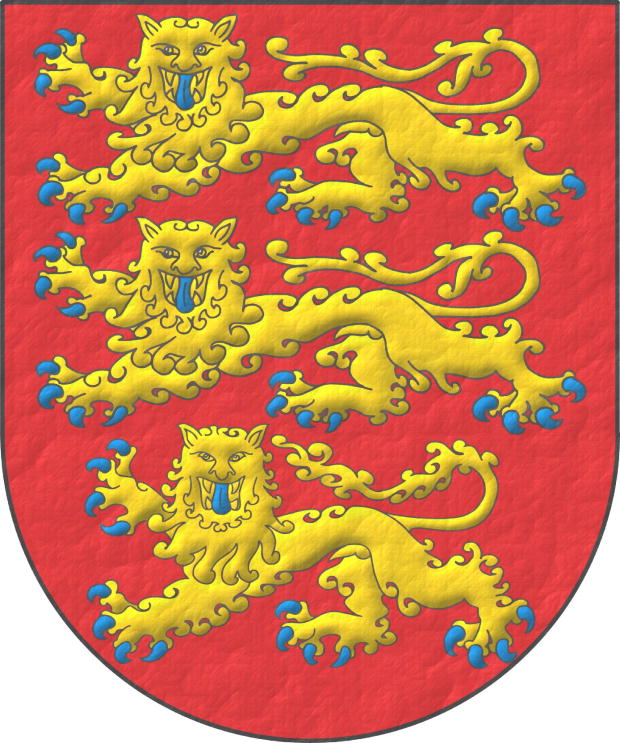
King of England and Lord of Ireland from 1272 to 1307.
Gules, three lions, passant, guardant, in pale Or, armed and langued Azure.
Escudo de gules, tres leopardos en palo de oro, armados y lampasados de azur.
Coat of arms interpreted with the following features: the mouth is semicircular (round); the field enamelled in a flat tint of Gules; the three leopards illuminated in the metal Or and the colour Azure, outlined in Sable, and the leopard closest to the base has a different shape and size; and the whole finished with a fabric-like texture.
Blazon keywords: Without divisions, Gules, Or, Azure, Three, Leopard, Armed, Langued and In pale.
Style keywords: Semi-circular, Illuminated, Outlined in sable and Fabric.
Classification: Interpreted, Personal, Coat of arms, House of Plantagenet and Kingdom of England.
Bearer: Edward I of England.


![Ver [Eight-ball, another version with a terrace in base] en criterios utilizados. Unicornio saltante sobre la divisa, criterio.](../css/Unicornio.Criterio.png)
Eight-ball, another version with a terrace in base
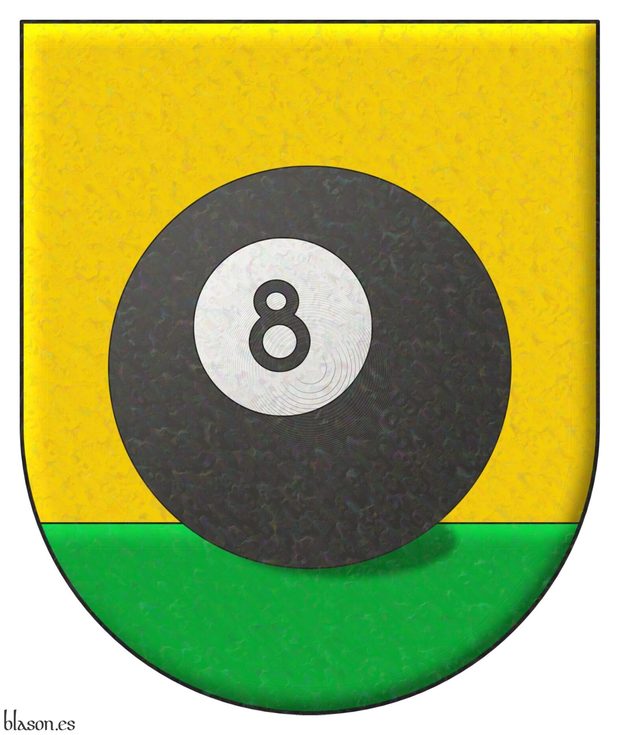
Or, an eight-ball proper on a terrace in base Vert.
Escudo de oro, una bola ocho al natural terrazada de sinople.
Can modern objects appear in a coat of arms?
My rule is: a coat of arms is forever, so any symbol included must be recognizable by future generations. Can you place an iPhone in a coat of arms? No—but not because it’s modern, rather because your grandchildren likely won’t recognize the form of an iPhone; in fact, today’s mobile phones already look quite different from those of a decade ago. Can you include a steam locomotive? Yes, because its form has become anchored in time and in the collective imagination. What about an hourglass, an analog clock, or a black 8-ball from pool? Also yes—their forms are now classics. That is, I believe we can use those symbols that most people already carry in their minds and that are very likely to remain present in the minds of our children and grandchildren. But this is just my humble criterion.
Categories: Criterion, Art, Created, Imaginary, Coat of arms, Semi-circular, Crystalline, Soft metal, Outlined in sable, Illuminated, Without divisions, Or, One, Non-classic artifact, Proper and Terrace in base.
Root: Bola 8.


Espinosa, Diego
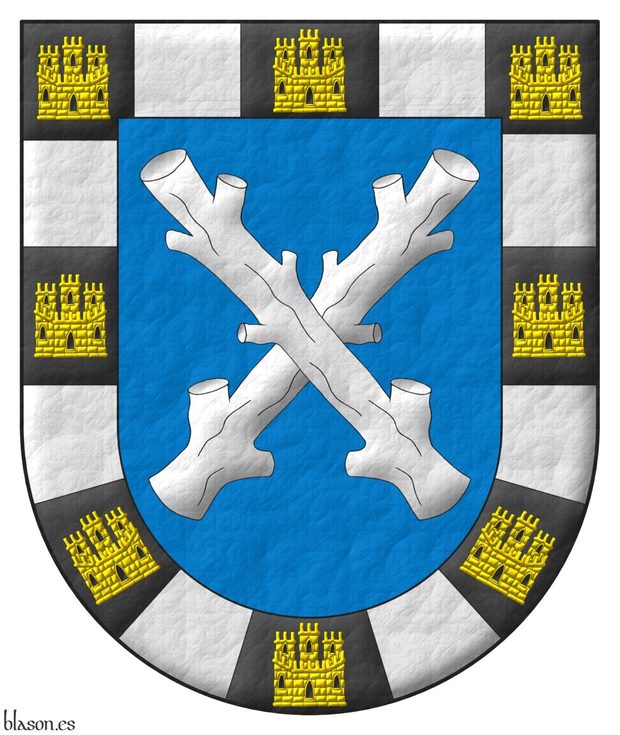
Azure, two trunks of a tree raguly, couped at random, in saltire Argent; a bordure compony of sixteen sections, eight sable charged with a castle triple-towered Or, port, windows, and masoned Sable, and eight Argent
Escudo de azur, dos troncos ecotados, nudosos, en sotuer de plata; una bordura componada de dieciseis compones: ocho de sable cargados de un castillo de oro, aclarado y mazonado de sable, y ocho de plata
Illuminated and a leather finishing.
Blazon keywords: Without divisions, Azure, Two, Trunk, Raguly, In saltire, Argent, One, Bordure, Compony, Sixteen, Section, Eight, Sable, Charged, Castle, Or, Port and windows and Masoned.
Style keywords: Leather, Outlined in sable, Illuminated and Semi-circular.
Classification: Personal and Interpreted.
Bearer: Espinosa, Diego.


Eugene IV
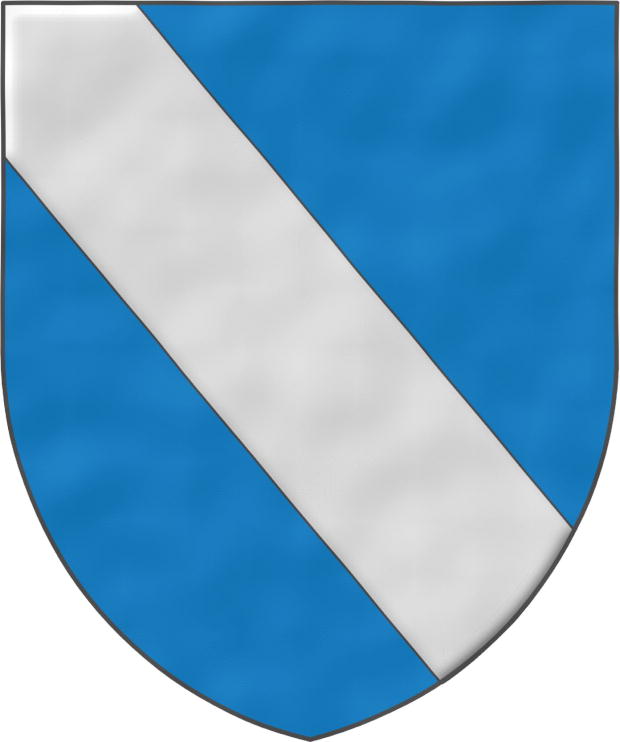
Papa número 207 de la Iglesia, de 1431 a 1447. «Eugenius IV», de nombre Gabriele Condulmer, nació en Venecia.
Azure, a bend Argent.
Escudo de azur, una banda de plata.
Escudo papal que he interpretado con: la boca apuntada; el campo de tinta plana de azur; la banda iluminada de azur y delineada de sable; y el conjunto acuarelado.
Blazon keywords: Without divisions, Azure, One, Bend and Argent.
Style keywords: Pointed, Illuminated, Outlined in sable and Watercolor.
Classification: Interpreted, Religious and Papal States.
Bearer: Eugene IV.


Ferdinand II, imaginary coat of arms

Argent, a lion sejant erect Purpure.
Escudo de plata, un león sentado de púrpura.
Imaginary coat of arms of King Fernando II of León, which I have developed based on his seal and the arms of his successor, with: the shape of the coat of arms is semi-circular; the field enameled in flat argent; the lion enameled in purpure and illuminated; and the whole rendered with a watercolor finish.
For this imaginary coat of arms I have chosen a representation of the lion in a posture similar to that of the great seal appearing in [Fernando II de León; 1167], which is sejant ~ «sentado» in Castilian, although beginning to rise «sejant erect».
It should be noted that we are in a pre-heraldic period where the possible attitudes of the lion were not yet clearly defined, although several of them are already anticipated in the great seals of Fernando II, as can be seen, for example, passant in [Fernando II de León; 1181] and in other attitudes in the photographs of [Martín Fuertes, J. A.; 2002].
Blazon keywords: Without divisions, Argent, Lion, Purpure and Sejant.
Style keywords: Semi-circular, Illuminated, Outlined in the field tincture and Watercolor.
Classification: Interpreted, Imaginary, Coat of arms and Kingdom of León.
Imaginary bearer: Ferdinand II of Leon.


Fernández de Córdoba y Carrillo, Diego
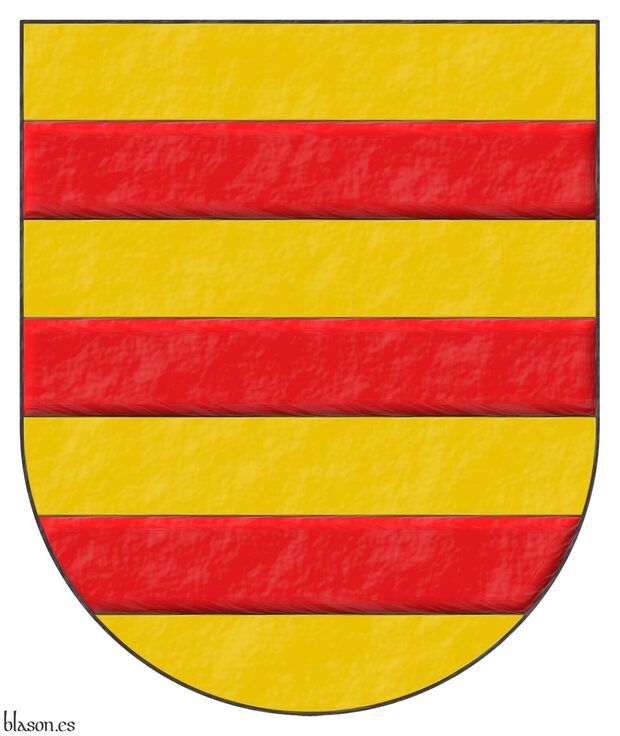
Marshal of Castile, first Lord of Baena and plenipotentiary ambassador to the court of Portugal (1355–1435).
Or, three fesses Gules.
Escudo de oro, tres fajas de gules.
Coat of arms del que fue mariscal de Castilla interpreted as follows: the shield has a semicircular (round) base; the field is illuminated in flat metal Or; its three fesses illuminated in Gules y outlined in Sable; y el conjunto con un plastered finish.
He served under the kings John I of Castile, Henry III of Castile, and John II of Castile.
These three bars of the Fernández de Córdoba lineage are found, for example, in the first quarter of the coat of arms of Gonzalo Fernández de Córdoba y Enríquez de Aguilar, known as *El Gran Capitán*.
Blazon keywords: Without divisions, Or, Fess and Gules.
Style keywords: Illuminated, Outlined in sable, Semi-circular and Gesso.
Classification: Interpreted, Personal, Coat of arms and Kingdom of Castile and Leon.
Bearer: Fernández de Córdoba y Carrillo, Diego.
Blazon equivalent to: Berry of Molland.


![Ver [Ferrer i Vives, F.; 1995] en referencias bibliográficas. Libro abierto, hojas de plata, filo de oro, guardas de gules, tapas de sable.](../css/Libro.Bibliografia.png)
Ferrer i Vives, F.; 1995
Francesc d'A Ferrer i Vives, «Heraldica Catalana», 3 volumes, Volume I A-F, Volume II G-P, Volume III Q-Z, ISBN of the complete work 84-7304-204-2, Legal Deposit B.20.464 - april 1995, Editorial Milla, Carrer de Sant Pau 21, Barcelona, 1995.
Bibliographical reference of century XX.
Classification: Catalan language and In black and white.
The author is Ferrer i Vives, Francesc d'A.
The following article cites this bibliographic reference:
Internal resources: Paper book.


Francis I of France
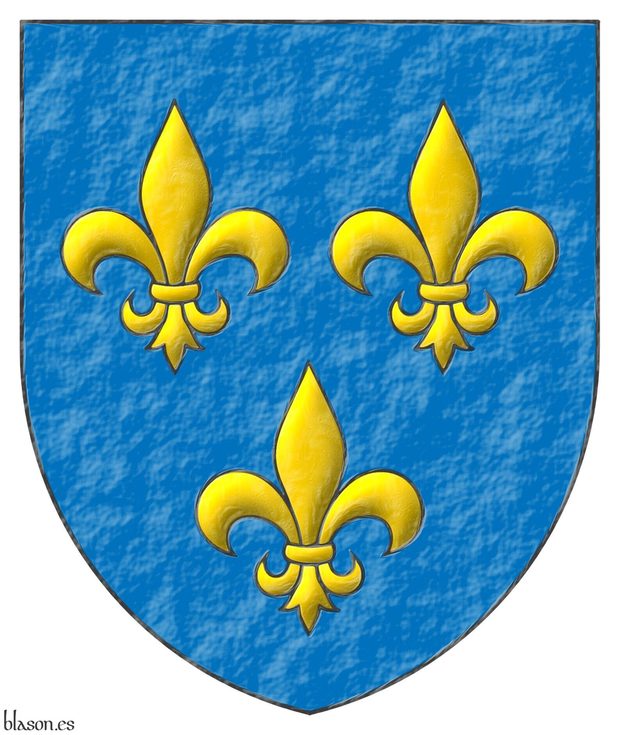
From the House of Valois-Angoulême and with the motto: Nutrisco et extinguo.
Azure, three fleurs de lis Or.
Escudo de azur, tres flores de lis de oro.
Coat of arms interpreted with: a pointed base; the field enamelled in flat Azure; the three fleurs-de-lis outlined in Sable and illuminated in Or; and finished with a plaster texture.
Blazon keywords: Without divisions, Azure, Or, Three, Fleur de lis and Ordered.
Style keywords: Pointed, Illuminated, Outlined in sable and Gesso.
Classification: Interpreted, Personal, Coat of arms, Kingdom of France and House of Valois.
Bearer: Francis I of France.


Freitas, lineage of Portugal
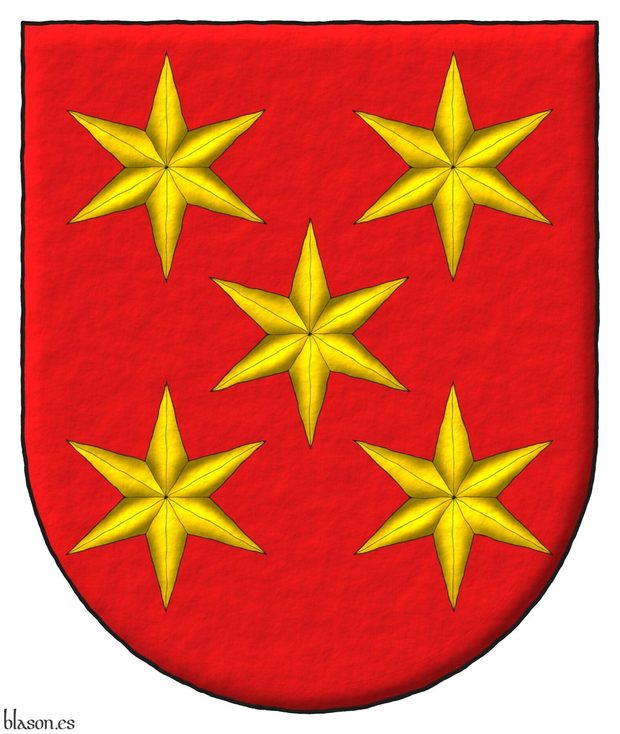
Blazon of the Freitas lineage of Portugal.
Gules, five mullets of six points Or.
Illuminated and a freehand finishing.
It can be found at [Cró, J. do; 1509; page 123].
Blazon keywords: Without divisions, Gules, Five, Mullet and Or.
Style keywords: Freehand, Outlined in sable, Illuminated and Semi-circular.
Classification: Interpreted, Lineage and Kingdom of Portugal.


![Ver [García Carraffa, A.; García Carraffa, A.; 1968] en referencias bibliográficas. Libro abierto, hojas de plata, filo de oro, guardas de gules, tapas de sable.](../css/Libro.Bibliografia.png)
García Carraffa, A.; García Carraffa, A.; 1968
Alberto García Carraffa y Arturo García Carraffa, with the colaboration of Armando de Fluviá y Escorsa, «El Solar Catalán, Valenciano y Balear», 4 volumes, Volume I Abad-Cebrián, 443 pages, Volume II Celma-Malda, 449 pages, Volume III Malendric-Quirant, 425 pages, Volume IV Rabasa-Zenarbe y apéndice, 516 pages, 1st edition, Heraldic Collection, edited by Librería Internacional, San Sebastián, 1968.
Bibliographical reference of century XX.
Classification: Castilian language and Black and white with color plates.
The 2 authors are García Carraffa, Alberto and García Carraffa, Arturo.
The following articles cite this bibliographic reference:
Internal resources: Paper book.


Georgia
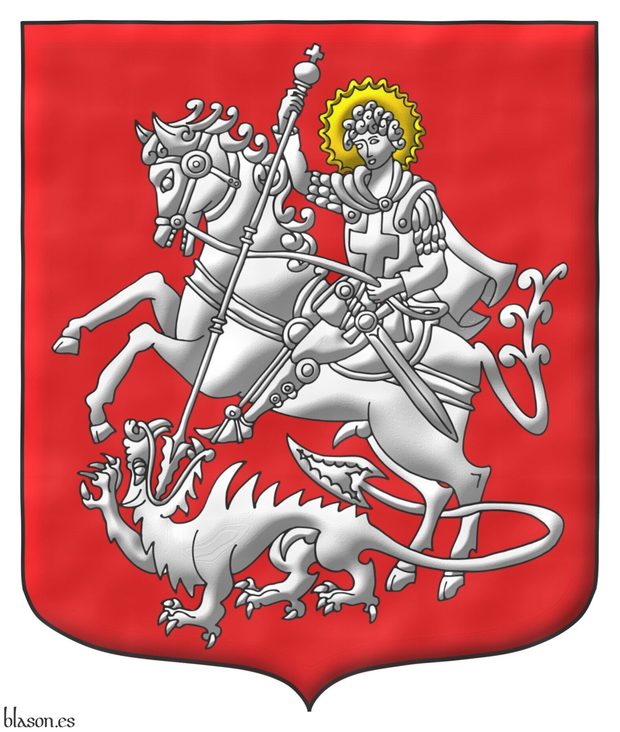
Gules, a Saint George nimbed Or, riding a Horse trampling upon a crawling Dragon, Argent.
Interpreted coat of arms: with a rounded and pointed shape; illuminated with metals or and argent and color gules; outlined with sable; and a Watercolor finish.
Blazon keywords: Without divisions, Gules, Saint George, Nimbed, Or, Horse, Dragon and Argent.
Style keywords: Ogee, Illuminated, Outlined in sable and Watercolor.
Classification: Coat of arms, Interpreted, Civic and State of Georgia.
Bearer: Georgia.


Globe, Richard

Sanguine semy of nails Or.
Escudo de sanguíneo sembrado de clavos de oro.
Coat of arms interpreted and emblazoned by me with a pointed shape, illuminated, and with a freehand finishing.
Blazon keywords: Without divisions, Sanguine, Semé, Nail and Or.
Style keywords: Freehand, Outlined in sable, Illuminated and Pointed.
Classification: Interpreted and Kingdom of Denmark.
Bearer: Globe, Richard.


Godfrey V, Count of Anjou
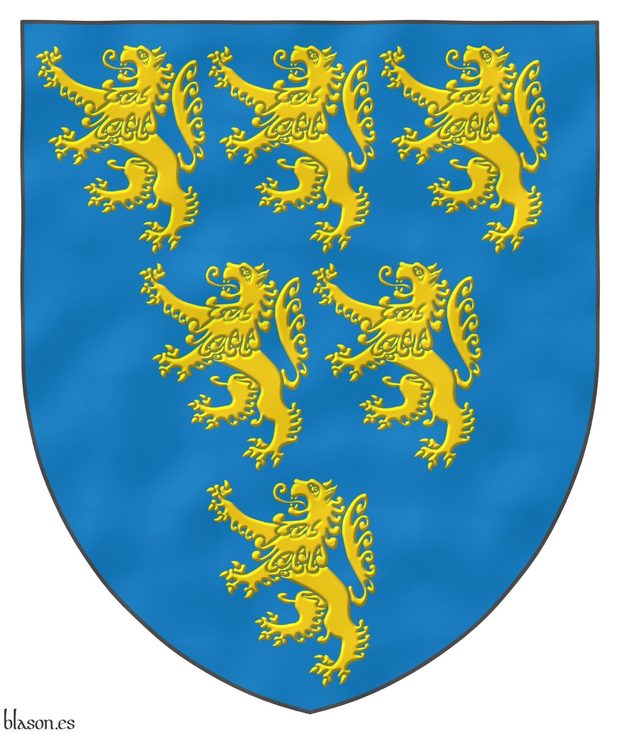
And Count of Touraine and Maine, Duke of Normandy, and founder of the Plantagenet dynasty.
Azure, six lions rampant Or, 3, 2 and 1.
Escudo de azur, seis leones rampantes de oro, 3, 2 y 1.
Existing armories interpreted by me as follows: the shield's shape is pointed; the field has been enameled in flat azure; the 6 lions are illuminated; and the entire composition has a watercolor finish.
When blazoning these 6 lions, considering that in heraldry the natural arrangement of elements is from more in chief to fewer in base, it would suffice to specify nothing more than «or and rampant». However, adding their arrangement «3, 2, and 1» can aid the reader, as done by [Avilés, J.; 1725b; page 124] and [Avilés, J.; 1780b; page 142] when blazoning the arms of Alfonso Enrique de Vick, writing «sable, and six bezants or, three, two, and one», meaning 6 ordered elements. In these sequences of number arrangements, I prefer to write Arabic numerals rather than words because, at times, the sequences can be long.
Blazon keywords: Without divisions, Azure, Six, Lion, Or, Rampant and Three, two and one.
Style keywords: Pointed, Illuminated, Outlined in the field tincture and Watercolor.
Classification: Interpreted, Personal, Coat of arms and House of Plantagenet.
Bearer: Godfrey V, Count of Anjou.


![Ver [Goldstraw, M. S. J.; 2013a] en referencias bibliográficas. Libro abierto, hojas de plata, filo de oro, guardas de gules, tapas de sable.](../css/Libro.Bibliografia.png)
Goldstraw, M. S. J.; 2013a
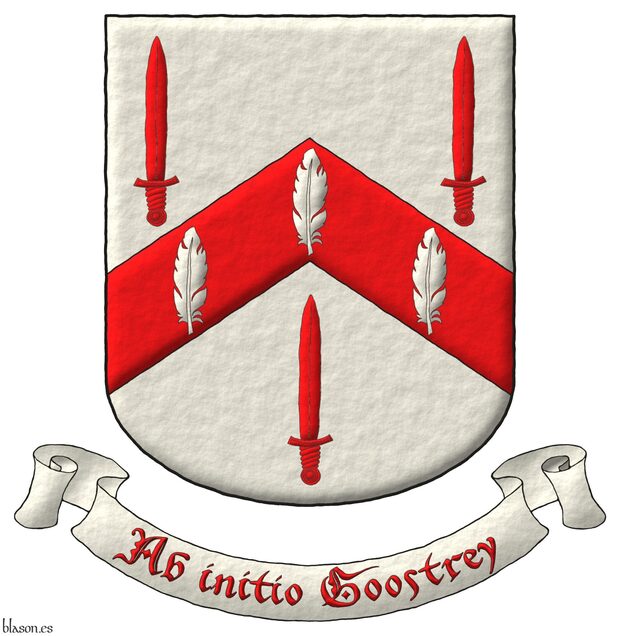
Martin S. J. Goldstraw, «The Heraldic Visitations of Cheshire 1533 to 1580», published by Martin S. J. Goldstraw, 338 pages, Cheshire, 22 August 2013.
Recreation by Martin S. J. Goldstraw of the book [Rylands, J. P.; 1882].
The coat of arms that illustrates this bibliographic reference is that of the book's author.
Bibliographical reference of century XXI.
Author: Goldstraw, Martin S. J..
The following article cites this bibliographic reference:


![Ver [Goldstraw, M. S. J.; 2013b] en referencias bibliográficas. Libro abierto, hojas de plata, filo de oro, guardas de gules, tapas de sable.](../css/Libro.Bibliografia.png)
Goldstraw, M. S. J.; 2013b
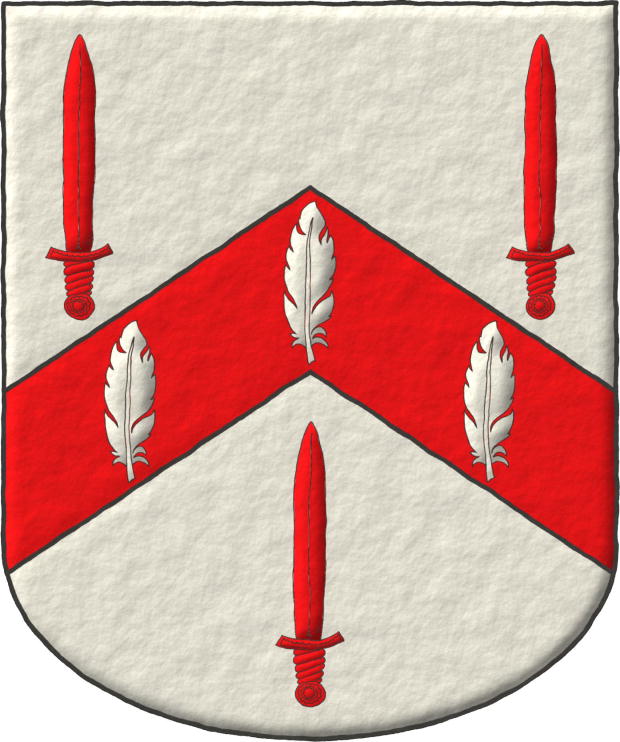
Martin S. J. Goldstraw, «The Heraldic Visitations of Cheshire 1613», published by Martin S. J. Goldstraw, 335 pages, Cheshire, 24 August 2013.
Recreation by Martin S. J. Goldstraw of the book [Armytage, G. J.; Rylands, J. P.; 1909].
This bibliographic reference is illustrated with the coat of arms of the book's author.
Bibliographical reference of century XXI.
The author is Goldstraw, Martin S. J..
Bibliographical reference mentioned in the following article:


Gonzalo Argote de Molina
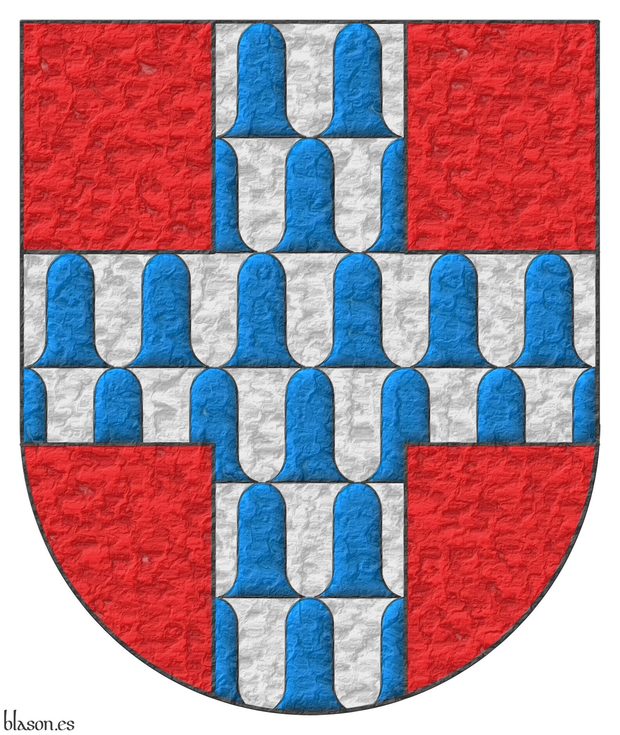
Gules, a cross vair ancient.
Escudo de gules, una cruz de veros antiguos.
Coat of arms that I have interpreted as follows: the shield has a semicircular (round) base; the field is in flat tincture of Gules; the vair ancient, rounded in the old style, are outlined in Sable and illuminated; and the whole has a raised-stroke drawing.
The coat of arms of the commune of Bailleul is very similar to this coat of arms, with the difference that it is of regular vair instead of ancient, rounded vair, like that borne by Gonzalo Argote de Molina.
Blazon keywords: Without divisions, Gules, Argent, Azure, Cross and Vair ancient.
Style keywords: Semi-circular, Illuminated, Outlined in sable and Metal beaten.
Classification: Interpreted, Personal, Coat of arms and Heraldry and heralds.
Bearer: Argote de Molina, Gonzalo.


Gregory X

184th Pope of the Church, from 1271 to 1276. «Gregorius X», born Teobaldo Visconti, was born in Piacenza and convened the 14th Ecumenical Council, known as the Second Council of Lyon.
Azure, a chief embattled Or.
Escudo de azur, el jefe almenado de oro.
Papal coat of arms interpreted by me with: a pointed and rounded shield shape; the field in plain Azure; the chief embattled, illuminated in metal Or and outlined in Sable; and the whole with a marbled finish.
My first version of the blazon in English was «Azure, a chief Or, embattled», but Michael McCartney suggested that it was more correct as «Azure, a chief embattled Or».
Blazon keywords: Without divisions, Azure, Chief, Or and Embattled.
Style keywords: Ogee, Illuminated, Outlined in sable and Marmoreal.
Classification: Interpreted, Religious and Papal States.
Bearer: Gregory X.


Guebara of Navarre

Of the twelve lineages of Noblemen, it is the second, descendant of Álava, the very ancient and powerful one, in which some served under Navarre, and others under the kings of Castile; they bear for arms and insignia, on a field Gules, which is red, five poplar-leaves (panelas) Argent, in the form and design in which this shield is painted.
Gules, five Poplar-leaves Argent, inverted.
Escudo de gules, cinco panelas de plata.
Coat of arms interpreted with: a semicircular (round) base; the field in flat Or; the pales outlined in Sable and illuminated in Azure enamel; and finished in highly-hammered metal.
Interpretation based on the second coat of arms of the «ricoshombres» of Navarre from [Bosque, J. del; 1540; folio 1 of the numbering of 1613] and the accompanying text is from the transcription made in [Martinena Ruiz, J. J.; 1982; pages 122 and 123].
The «panela» is a figure typical of Spanish heraldry [Valero de Bernabé, L.; 2007; page 11]. It is a leaf shaped like a heart with its stalk pointing upward. It could be a leaf of a tree such as, for example, the poplar, although there is no certainty that it is specifically that tree.
With first appearances prior to heraldry on Hispano-Roman tombstones, the «panela» is of Alavese origin, [Menéndez Pidal de Navascués, F.; 1985; page 474], spreading through the Basque-Navarrese region and from there throughout Spain, with the peculiar name «panela», which was initially called «pannella», [Valverde Ogallar, P. B.; 2001; page 532] derived from «pan», [Real Academia Española; 2001].
In the heraldry of other countries, leaves from different trees are used as heraldic symbols, but usually with the stalk pointing downward; therefore I transcribe in this blazon «panelas» ~ «Poplar-leaves, inverted».
[Menéndez Pidal de Navascués, F.; 1985; page 474] states that the «panela» is a natural figure equivalent to the linden leaf in German heraldry, with the stalk downward, and to the water-lily leaf in French heraldry, with the stalk upward; but since these are such different plants, I do not find it suitable to use linden, and even less water-lily, in the English transcription of this Navarrese blazon.
Under the title «Surname of Guebara» it can be consulted in [Vega, P. J. de; 1702; folio 2 of the manuscript].
Blazon keywords: Without divisions, Gules, Poplar leaf and Argent.
Style keywords: Semi-circular, Illuminated, Outlined in sable and Hard metal.
Classification: Interpreted, Personal and Kingdom of Navarre.
Bearer: Guebara of Navarre.


Haguenau
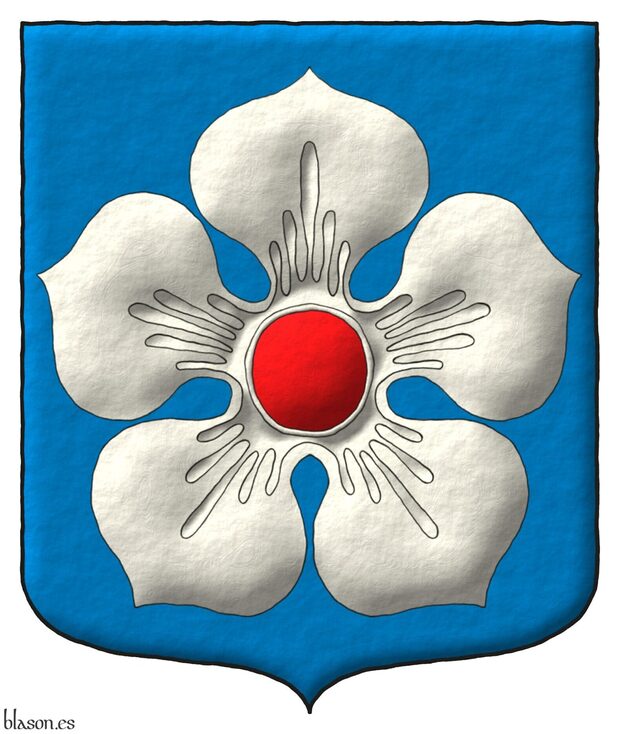
Azure, a cinquefoil Argent, seeded Gules.
Illuminated, with a watercolor finishing and with a pointed shape.
Blazon keywords: Without divisions, Azure, One, Cinquefoil, Argent, Seeded and Gules.
Style keywords: Watercolor, Outlined in sable, Illuminated and Pointed.
Classification: Interpreted, Civic, Kingdom of France and Coat of arms.
Bearer: Haguenau.


Hector of Troy
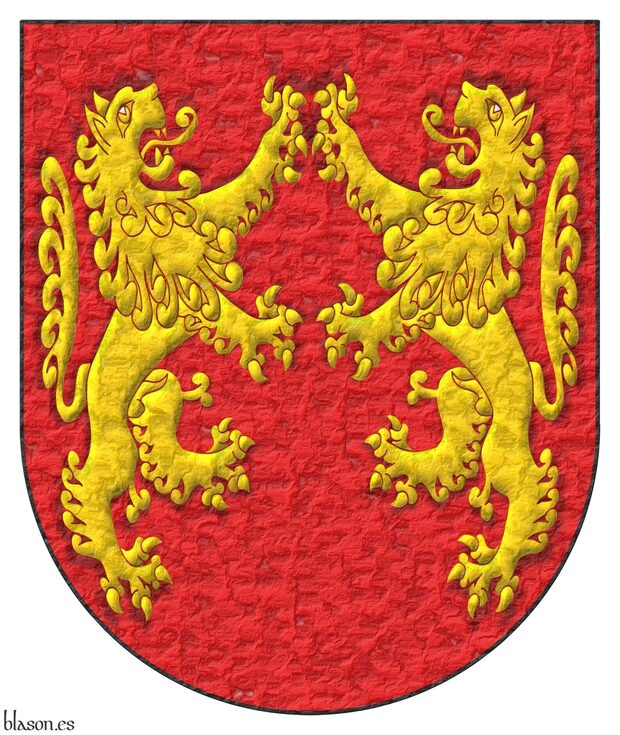
Gules, two lions combatant Or.
Escudo de gules, dos leones rampantes, afrontados de oro.
Imaginary arms of the Trojan hero that I have interpreted with: the mouth in the form of a semicircular (round) base; the field enameled in flat Gules tincture; the 2 combatant lions illuminated in Or, outlined with the field tincture and shaded; and all with a beaten metal finish.
Coat of arms interpreted from the imaginary blazon described by [Avilés, J.; 1725a; page 7], which is as follows: «of red with two lions combatant Or».
Blazon keywords: Without divisions, Gules, Lion, Or and Combatant.
Style keywords: Semi-circular, Illuminated, Outlined in the field tincture, Shaded and Metal beaten.
Classification: Interpreted, Imaginary, Coat of arms and Greco-Roman antiquity.
Imaginary bearer: Hector of Troy.


Henry II of England
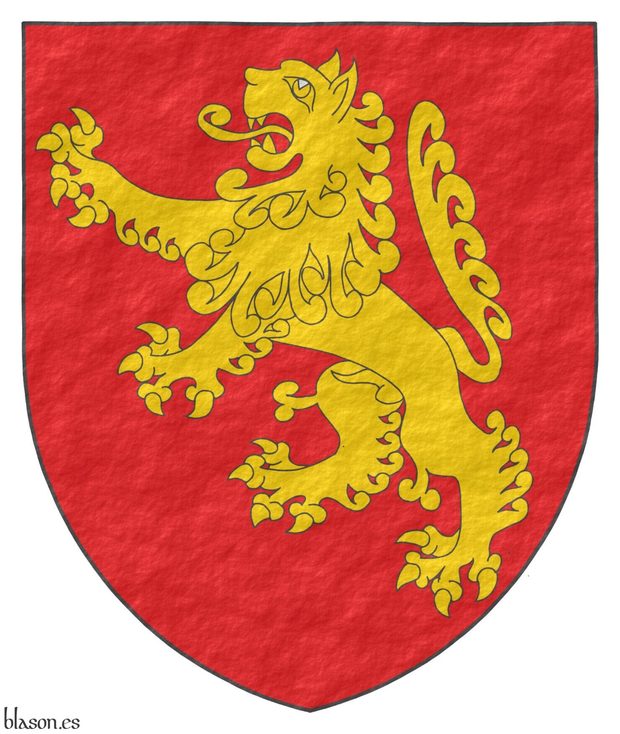
Henry II Plantagenet, King of England, Duke of Normandy, Duke of Aquitaine, Count of Anjou, Count of Maine, and Count of Nantes.
Gules, a lion rampant Or.
Escudo de gules, un león rampante de oro.
Existing arms interpreted by me as follows: the shield's shape is pointed; the field has been enamelled in flat Gules; the lion in Or has been outlined in Sable; and the whole composition has a rough texture finish.
It is believed that Henry I was the first King of England to have a coat of arms, featuring a single lion rampant, but no documentary evidence has yet been found [Rabbow, A.; 1999; paragraph 8].
[Ailes, A.; 1982; page 62] argues that Henry II may have used three different versions of his arms featuring a) a single lion rampant, b) two leopards, and c) three leopards. However, it remains unclear whether these versions were used sequentially over time or concurrently. For this interpretation, I have chosen the version with the lion rampant.
Blazon keywords: Without divisions, Gules, One, Lion, Or and Rampant.
Style keywords: Pointed, Plain tincture, Outlined in sable and Rough.
Classification: Interpreted, Coat of arms, Personal, House of Plantagenet and Kingdom of England.
Bearer: Henry II of England.


Henry III of England
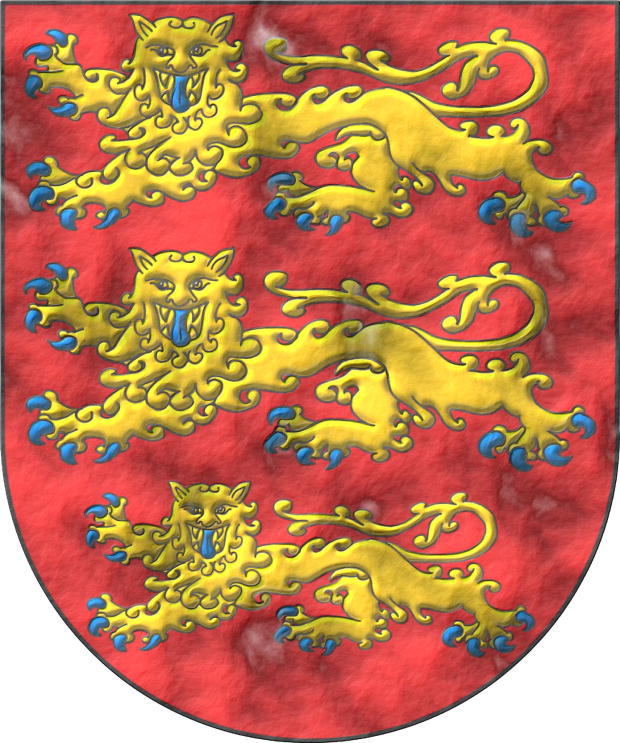
King of England, Lord of Ireland and Duke of Aquitaine from the year 1216 to the year 1272
Gules, three lions, passant, guardant, in pale Or, armed and langued Azure.
Escudo de gules, tres leopardos en palo de oro, armados y lampasados de azur.
Coat of arms interpreted as follows: the mouth of the shield is semicircular (round); its field has been enamelled in a flat tint of Gules; its leopards are illuminated in Or and Azure and outlined in Sable; and the whole has a finish of aged parchment.
Blazon keywords: Without divisions, Gules, Or, Azure, Three, Leopard, Armed, Langued and In pale.
Style keywords: Semi-circular, Illuminated, Outlined in sable and Old parchment.
Classification: Interpreted, Personal, Coat of arms, House of Plantagenet and Kingdom of England.
Bearer: Henry III of England.


![Ver [Heraldic blog of David B. Appleton] en enlaces recomendados. Áncora de oro y la divisa enlace.](../css/Ancora.Enlace.png)
Heraldic blog of David B. Appleton
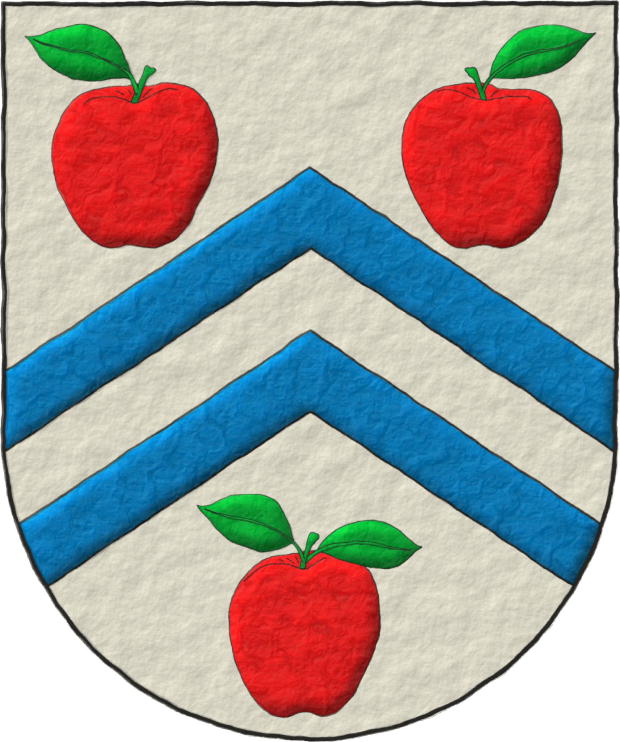
Appleton Studios
David B. Appleton studies, researches, teaches, and writes about heraldry, and through his blog, he shares his heraldic knowledge with us, as well as through publications and presentations.
David B. Appleton is open to questions from his readers and provides advice on heraldic topics in which he specializes.
His blog is Blog.AppletonStudios.com and his website is AppletonStudios.com, from which he offers his services related to the world of heraldry, its dissemination, and knowledge.
Since 2009, David B. Appleton's heraldic blog has been an endless source of knowledge, images, ideas, curiosities, original reflections, and links to heraldic sites selected by him.
Heraldry: Musing on an esoteric topic
David B. Appleton stands out for his continuous analysis of all types of heraldic manifestations, which he finds everywhere, in the world we live in: from those we have inherited from ancient times to the fiercely current, from books to cinema, from fashionable clothing to urban furniture, from east to west and north to south, including those that appear in logos and emblems, those using traditional techniques and those created or disseminated through new technologies, on ships, sports cars, and airplanes, on porcelain, facades, and stained glass, on television, on t-shirts and coins, in auctions and universities, in comics and sports, etc. with a systematic publication rhythm, more than 2 posts per week, nothing heraldic escapes the record and genuine analysis of David B. Appleton on Blog.AppletonStudios.com, which I highly recommend.
Categories: Link, Interpreted, Personal, Coat of arms, Without divisions, Freehand, Soft metal, Illuminated, Outlined in sable, Canting, Heraldry and heralds, Argent, Azure, Gules, Vert, Chevronel, Between, Apple, Slipped and Leaved.
External links:
- Interpretation of his coat of arms.
- Interpretation by Xavier García at Appleton Studios.
- Interpretation by Xavier García at Dibujo Heráldico with his blazon in English and Spanish.
Root: Appleton, David B..


Hermanos Trujillo Jiménez, structured and parallel blazons
Blazon keywords: Without divisions, Purpure, Three, Dragon, Passant, In pale, Argent, One, Bordure, Gules, Eight, Saltire and Or.
Style keywords: Ogee, Outlined in sable, Illuminated and Watercolor.
Classification: Personal, Interpreted, Coat of arms and Structured and parallel blazons.
Bearer: Trujillo Jiménez, Hermanos.


Holy Trinity
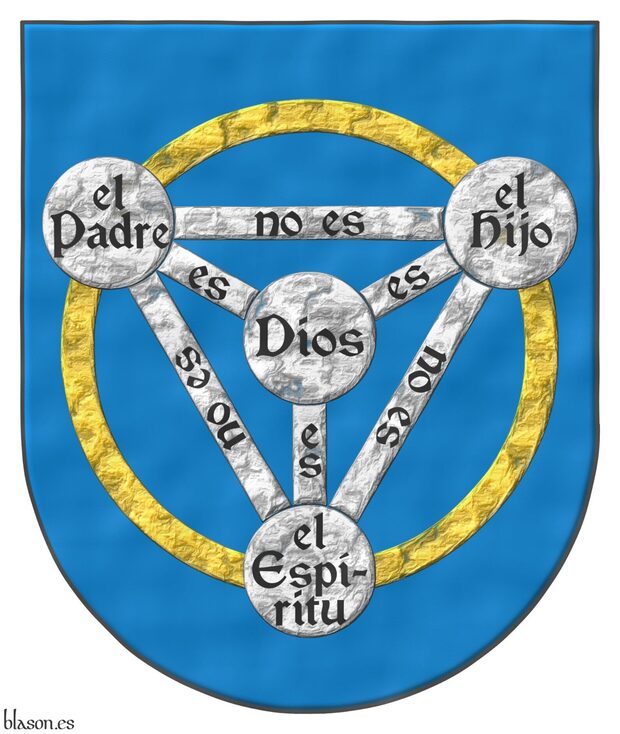
Azure, a pall couped Argent, its three arms charged with «es» Sable, within a triangle reversed Argent, its three arms charged with «no es» Sable, within an annulet Or, all debruised by four plates, three on the vertex of the triangle, in dexter chief, charged with «el Padre» Sable, in sinister chief, charged with «el Hijo» Sable, in base, charged with «el Espítiru» Sable, and one on the fess point, charged with «Dios» Sable.
Escudo de azur, una perla recortada de plata, sus tres brazos cargados con «es» de sable, dentro de un triángulo ranversado de plata, sus tres brazos cargados con «no es» de sable, dentro de un anillo de oro, todo resaltado de cuatro bezantes de plata, tres sobre los vértices del triángulo, en la diestra del jefe, cargado de «el Padre» de sable, en la siniestra del jefe, cargado con «el Hijo» de sable, en la punta, cargado con «el Espítiru» de sable y uno sobre el corazón, cargado con «Dios» de sable.
Imaginary coat of arms that I have interpreted as follows: its base is semicircular (round); its field is illuminated in watercolor Azure; the rest in heavily beaten metal, outlined of the field and illuminated in Argent, except for the annulet which is illuminated in Or; and its letters all in plain Gules ink.
Annulet
The circular crown when it is large and in the middle of the shield [Cadenas y Vicent, V. de; 1975] is called an annulet. [Avilés, J.; 1780a; pages 296 and 297] calls it annulet or small annulet depending on its size, if it is large an annulet and if it is small a small annulet. In English and French heraldry it is called «cyclamor» and hence the expression «cyclamor annulet» can also be found.
This annulet is my aesthetic contribution to this imaginary coat of arms as it is normally not represented with this annulet.
Bordure and Orle
In other interpretations the words «non est» go on a bordure or on an orle, the latter being the case blazoned, for example, [Husenbeth, F. C.; 1882; 2nd appendix] in the following way: «Gules, an orle and pall Argent, conjoined and surmounted of four plates, occupying the dexter and sinister chief and the base and fess points respectively; the first inscribed Pater, the second Filius, and the third Spiritus Sanctus, the centre Deus; the connecting portions of the orle between them having the words non est, and those of the pall est».
Blazon keywords: Without divisions, Azure, Cyclamor, Pall, Closed, Argent, Charged, Bezant and plate, Or, Dexter, Sinister, Chief, Base (lower 1/3) and Heart.
Style keywords: Semi-circular, Illuminated, Outlined in the field tincture, Watercolor and Hard metal.
Classification: Religious, Interpreted, Imaginary and Coat of arms.
Imaginary bearer: Holy Trinity.


![Ver [Humphery-Smith, C.; 1983] en referencias bibliográficas. Libro abierto, hojas de plata, filo de oro, guardas de gules, tapas de sable.](../css/Libro.Bibliografia.png)
Humphery-Smith, C.; 1983
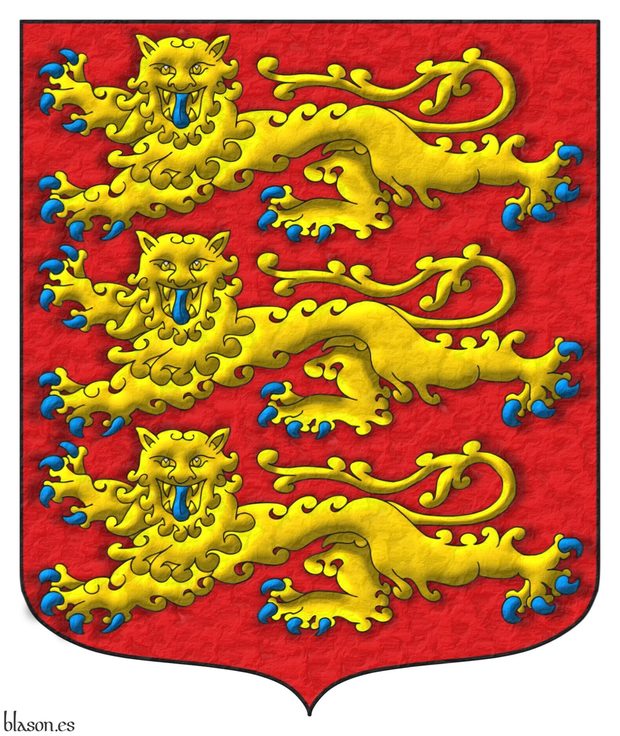
Cecil Humphery-Smith, FHS - Fellow of The Heraldry Society, «Why three Leopards?», Coat of Arms, COA, An Heraldic Quarterly Magazine, issue 126, The Heraldry Society, Baldock, Hertfordshire, summer of 1983.
The coat of arms illustrating this bibliographic reference is that of the Kingdom of England, which was also that of the queen of Castile Leonor Plantagenet.
Bibliographical reference of century XX.
The author is Humphery-Smith, Cecil.
Here are the articles quoting this reference:
External link:
Internal resources: HumpherySmithC1983.3Leopards.docx.


![Ver [In fess and bend sinisterwise] en criterios utilizados. Unicornio saltante sobre la divisa, criterio.](../css/Unicornio.Criterio.png)
In fess and bend sinisterwise
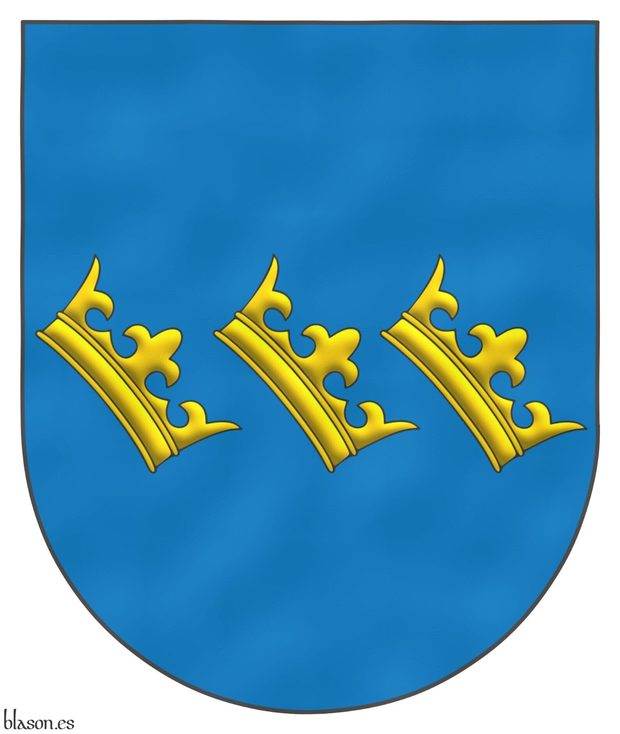
Azure, three crowns in fess, bend sinisterwise Or.
Escudo de azur, tres coronas en faja, puestas en barra de oro.
Crown with the main axis being the vertical and central axis of symmetry and which is usually placed palewise and which here appear bend sinisterwise.
- In fess ~ en faja.
- bend sinisterwise ~ puesto en barra.
Blazon keywords: Without divisions, Azure, Or, Crown, In fess and Bend sinisterwise.
Style keywords: Semi-circular, Outlined in sable and Watercolor.
Classification: Criterion.
Bearer: In and wise.


Innocent IV

180th Pope of the Church, from 1243 to 1254. «Innocentius IV», born Sinibaldo dei Fieschi, was born in Manarola in northwest Italy.
Bendy of six Azure and Argent.
Escudo bandado de seis piezas de azur y plata.
Papal coat of arms interpreted by me with: a semicircular shield shape; a plain Argent field; bands illuminated in Azure and outlined in Sable; and the whole design with a watercolor finish.
Order of tinctures
In the bendy pattern, the tinctures are named starting from the one located at the dexter base of the shield and following an ascending sequence towards the sinister chief, although the most orthodox approach is to have only 2 tinctures, being one color and one metal.
Number of bands
It is said that it is not necessary to specify the number of bands when there are precisely 6, as in this case, and that it should be specified when there are, for example, 4 or 8. I have chosen to specify it for greater clarity of the blazon.
About the bendy pattern and the need to specify or not specify the number of its pieces, [Avilés, J.; 1725a; pages 40 and 41] and [Avilés, J.; 1780a; pages 45 and 46] say that it is «composed of four, six, or eight bends; in such a way that there are as many colors as metals, always specifying the number four and eight bands when blazoning, and not the one composed of six, as it is understood thus, without declaring the number of pieces» and without agreeing with it, and by its wording I believe that he is not entirely in agreement either, he adds «the reason that may exist for not specifying the number of six bends (although the authors do not express it) is that as the bend is one-third of the shield; and having six pieces, or six bends, the resulting number is doubled, as if the three parts were divided, which implies that the shield is filled with three bends; and taking the denomination of the figure infers, that the bendy is of six pieces: which does not happen with this equality in those of four and eight, requiring other proportions and consequently it becomes necessary to specify their number», therefore, note that the bendy of 6 does not follow the proportions of the bend, nor do those of 4 or 8, the only differential property of the one of 6 is being a multiple of 3, being 1/3 the width of the bend.
Blazon keywords: Without divisions, Bendy, Six, Azure and Argent.
Style keywords: Semi-circular, Illuminated, Outlined in sable and Watercolor.
Classification: Interpreted, Religious and Papal States.
Bearer: Innocent IV.


Ireland
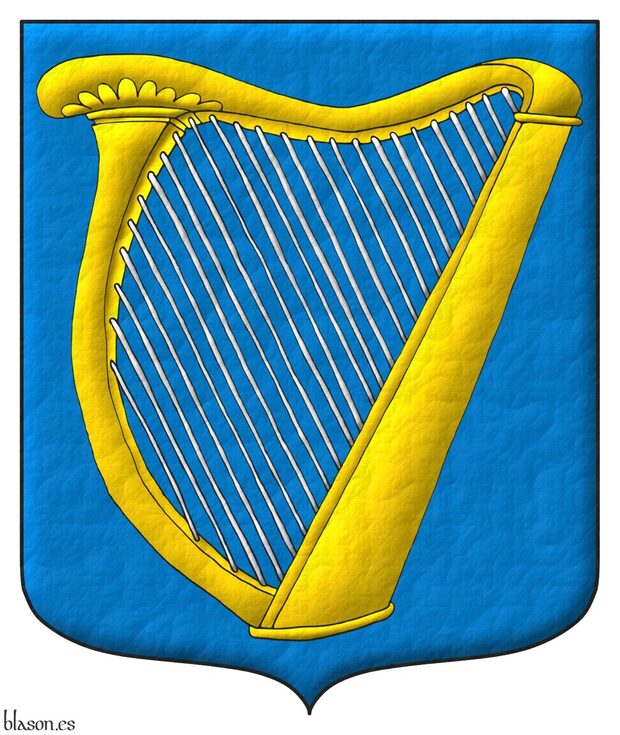
Azure, a harp Or, stringed Argent
Escudo de azur, un arpa de oro, cordada de plata
Illuminated and a leather finishing.
Blazon keywords: Without divisions, Azure, One, Harp, Or, Stringed and Argent.
Style keywords: Leather, Outlined in sable, Illuminated and Ogee.
Classification: Civic, Republic of Ireland, Interpreted and Coat of arms.
Bearer: Ireland.


![Ver [ISCH Armorial, February 2018 Edition] en enlaces recomendados. Áncora de oro y la divisa enlace.](../css/Ancora.Enlace.png)
ISCH Armorial, February 2018 Edition
Publication on the blog Twelve Lineages of Soria about the armorial I produced for the ISCH under the title: The eminent heraldist Mr. Antonio Salmerón Cabañas brings us his latest edition of February 25, 2018 of the Roll of Arms of the International Society of Commoners Heraldry ISCH.
This armorial contains coats of arms painted by different heraldic artists, although all those shown in the illustration heading this article were painted by my own hand.
Categories: Link, Gules, Azure, Vert, Sable, Purpure, Or, Argent, Without divisions, Gyronny, Party per pale, Quarterly, Bend, Saltire, Bordure, Chevron, Cross, Pile, Bendlet, Inescutcheon, Chequey, Hurt, torteau, pellet, pomme and golpe, Cadency, Thistle, Fleur de lis, Horse, Crown, Sun in splendour, Martlet, Wolf, Letter, Unicorn, Griffin, Dragon's head and Engouled.
Root: Twelve Lineages of Soria.


Israel
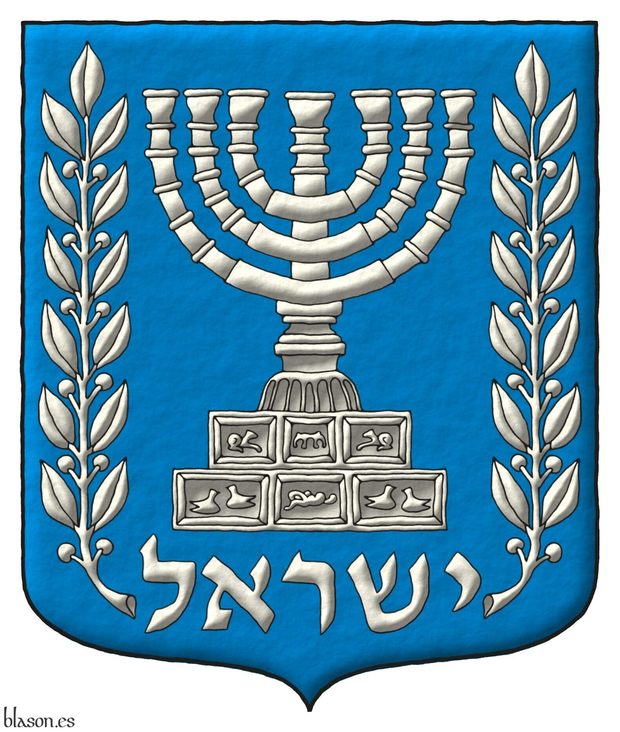
Israel~ישראל.
Azure, a Menorah between two olive branches Argent; in base the legend
«ישראל» Argent.
Interpreted coat of arms: with a rounded and pointed shape; illuminated with metal argent and color azur; outlined with sable; and a Watercolor finish.
Blazon keywords: Without divisions, Azure, One, Menorah, Argent, Accosted, Two, Branch, Olive tree, Tree and Motto (identification).
Style keywords: Ogee, Illuminated, Outlined in sable and Freehand.
Classification: Coat of arms, Interpreted, Civic and State of Israel.
Bearer: Israel.


James de Sottone, le Fitz

James de Sutton ~ James de Sottone, le Fitz.
Ermine, a canton Sable.
Escudo de armiños, un cantón de sable.
Included in [Vincent, MS; 1285; number 599] also known as [St. George's Roll; 1285; number 599].
Blazon keywords: Without divisions, Ermine, One, Canton and Sable.
Style keywords: Semi-circular and Illuminated.
Classification: Interpreted and Personal.
Bearer: Jaime de Sutton.


James I of Aragon
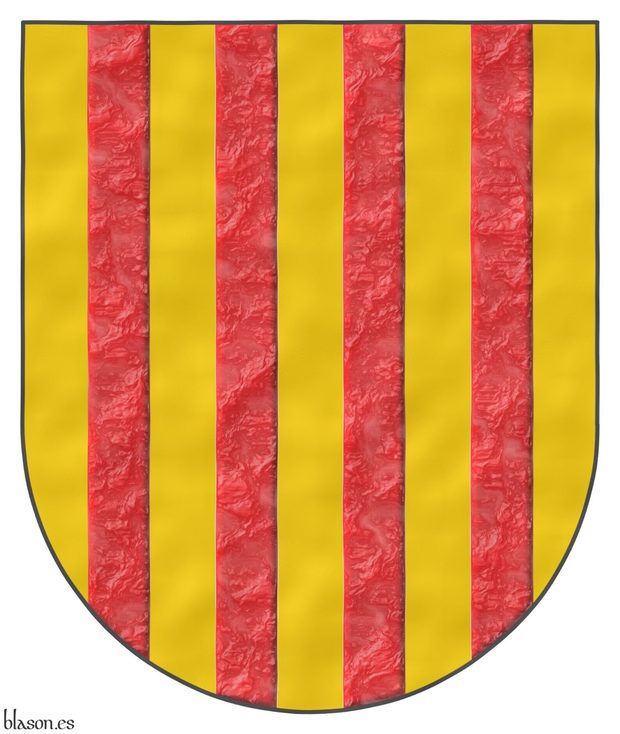
King of Aragon, Valencia and Majorca, Count of Barcelona, Count of Urgell, Lord of Montpellier and known as the Conqueror
Or, four pallets Gules.
Escudo de oro, cuatro palos de gules.
Coat of arms interpreted by me as follows: the escutcheon shape is semicircular; the field is rendered in flat Or with a watercolored effect; and the pallets are illuminated and finished with a crystalline texture.
A semicircular-shaped shield of Aragon can be seen, for instance, in [Argote de Molina, G.; 1588; chapter XLII].
This shield, but with a pointed base, appears in the second part of the armorial [Wijnbergen; 1265; shield no. 1,293], under the title «Le roy Darragon». This second part was compiled between 1270 and 1285 and, since James I was king of Aragon from 1213 to 1276, it could refer to him; although it might also refer to his son Peter III, the Great, who succeeded James I in 1276.
This coat of arms is also the arms of Aix-en-Provence, granted to that French city, according to tradition, by Alfonso II of Aragon [Aix-en-Provence; 1351], grandfather of James I, the Conqueror.
Blazon keywords: Without divisions, Or, Four, Pale and Gules.
Style keywords: Semi-circular, Illuminated, Watercolor and Crystalline.
Classification: Interpreted, Personal, Coat of arms and Kingdom of Aragon.
Bearer: James I of Aragon.


Jamilena, province of Jaen
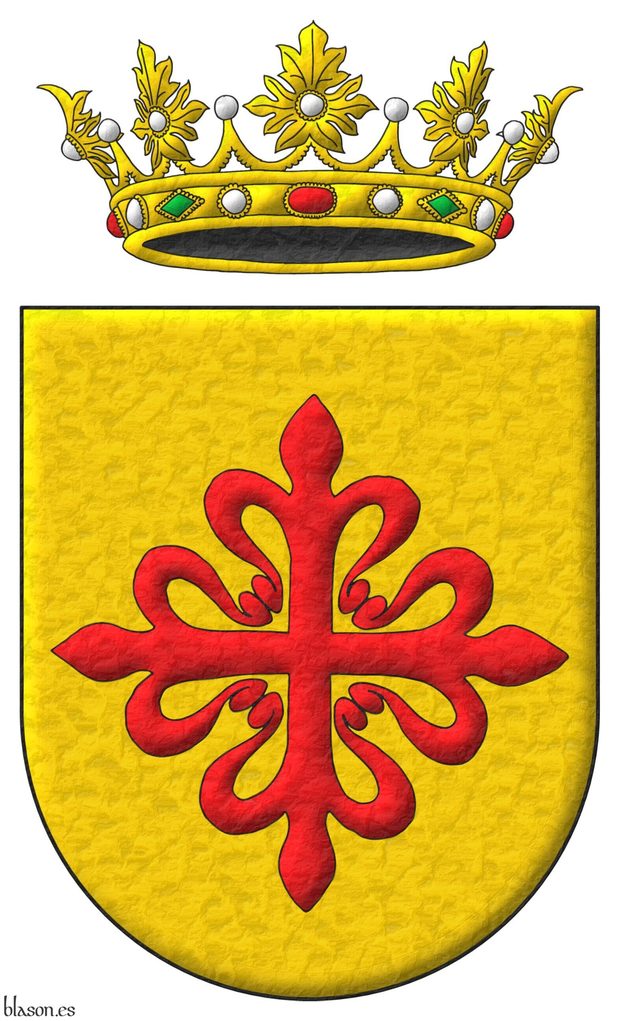
Or, a cross of Calatrava. Crest: An open royal crown Or.
Escudo de oro, una cruz de Calatrava. Timbrado de una corona real abierta.
Coat of arms interpreted as follows: the shield's shape is a semicircular arch; the field is illuminated in metal Or; the cross of Calatrava is outlined in Sable and illuminated in Gules; the royal crown is open, outlined in Sable and illuminated in metal Or, pearls in Argent, gemstones in Gules and Vert, and the visible base hollow in Sable; and the entire piece has a slightly hammered metal finish.
The municipality of Jamilena belongs to the La Campiña region and is the smallest in the province of Jaén. I have depicted its coat of arms with an open royal crown, but representations with a closed royal crown can also be found.
The origin of the cross of Calatrava in its heraldic coat of arms dates back to the year 1525 when Emperor Charles V issued several decrees from Toledo to build a convent for nuns in Jamilena. For the construction of this convent, stones from the Muslim castle, which was reformed and occupied by the Order of Calatrava, were used.
Blazon keywords: Without divisions, Or, Cross of Calatrava, Cross couped, Cross, Crest, Open royal crown and Crown.
Style keywords: Semi-circular, Illuminated, Outlined in sable and Soft metal.
Classification: Interpreted, Civic and Coat of arms.
Bearer: Jamilena.


Jesus Christ, preparation schema
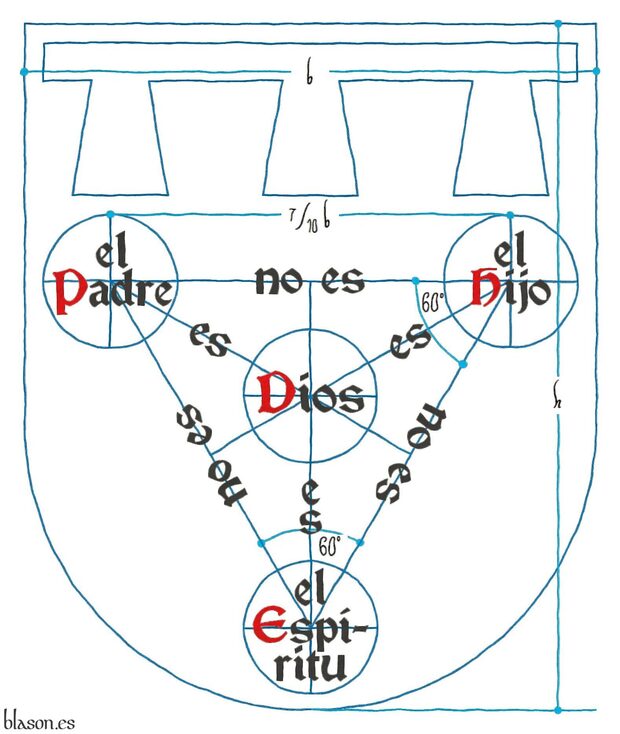
Schema for an imaginary coat of arms that will have the following characteristics: its base will be semicircular (round); it will contain a closed pearl charged with four bezants; and it will be differenced by a label of three points, which being three is normal, its number will not be specified in the blazon.
Label
The way to elaborate a label can be found in [Avilés, J.; 1780a; page 248] who writes that «it is made of a fillet, which is the ninth part of the latitude of the Chief with three points in the form of a Carpenter's wedge, or of badly formed triangles, which united to it without separation of lines, fall twice as much, as the fillet is wide, the two being placed at its ends, and one in its middle, its ordinary situation being in the middle of the length of the Chief itself, without reaching the edges of the Shield».
Label points
In [Avilés, J.; 1780a; pages 248 and 249] it is said that «the simple Label is always of three points», as is the case at hand, «but having 4, 5, or 6, which is the greatest number found, it is necessary to specify it», although in [Avilés, J.; 1780a; page 114] he seems to consider that the maximum is five as he writes «Points, it is said of three, four and up to five points of the Labels».
Blazon keywords: Without divisions, Pall, Closed, Charged, Bezant and plate, Dexter, Sinister, Chief, Base (lower 1/3), Heart and Label.
Style keywords: Semi-circular.
Classification: Religious, Schema, Interpreted and Imaginary.
Imaginary bearer: Jesus Christ.


Joan de Okinton
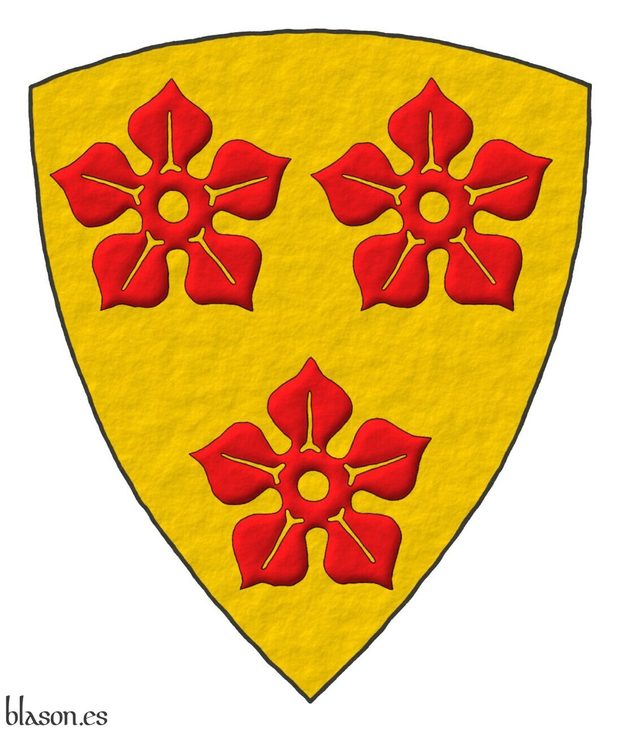
John de Octon ~ Joan de Okinton.
Or, three cinquefoils Gules.
Escudo de oro, tres quinquefolios de gules.
Included in [Vincent, MS; 1285; number 620] also known as [St. George's Roll; 1285; number 620].
Blazon keywords: Without divisions, Or, Three, Cinquefoil, Gules and Ordered.
Style keywords: Triangular curved, Illuminated, Outlined in sable and Freehand.
Classification: Interpreted and Personal.
Bearer: Juan de Octon.


John Berry
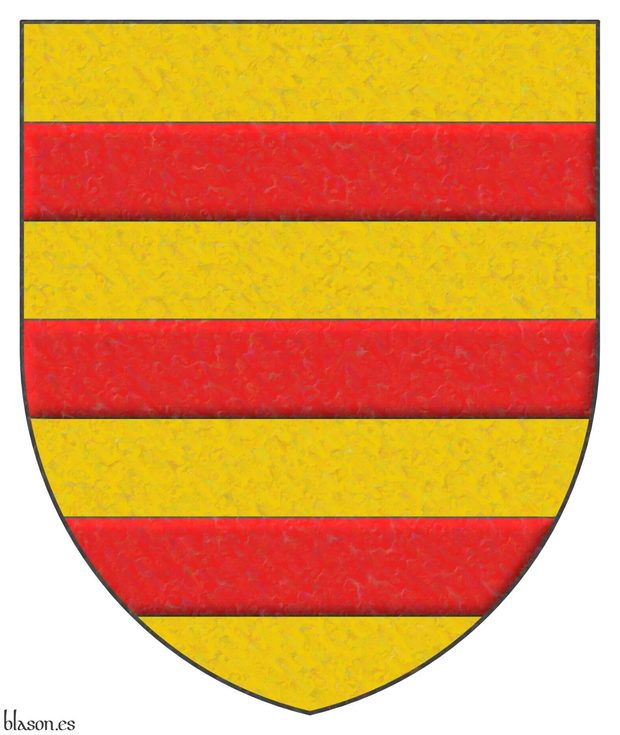
Sir John Berry, Admiral of the Royal Navy
Or, three fesses Gules.
Escudo de oro, tres fajas de gules.
Coat of arms interpreted as follows: the top of the shield is pointed; its field has been painted in flat Or; its fesses have been outlined in Sable and illuminated in Gules; and the whole set has a pearly finish.
The arms of John Berry, and therefore those of Berry of Molland, are equivalent to those of Pope Clement V and to the Castilian arms of Diego Fernández de Córdoba y Carrillo.
Blazon keywords: Without divisions, Or, Fess and Gules.
Style keywords: Pointed, Illuminated, Outlined in sable and Iridescent (nacar).
Classification: Interpreted, Personal and Army and Navy.
Bearer: Berry, John.


John de Beauchamp
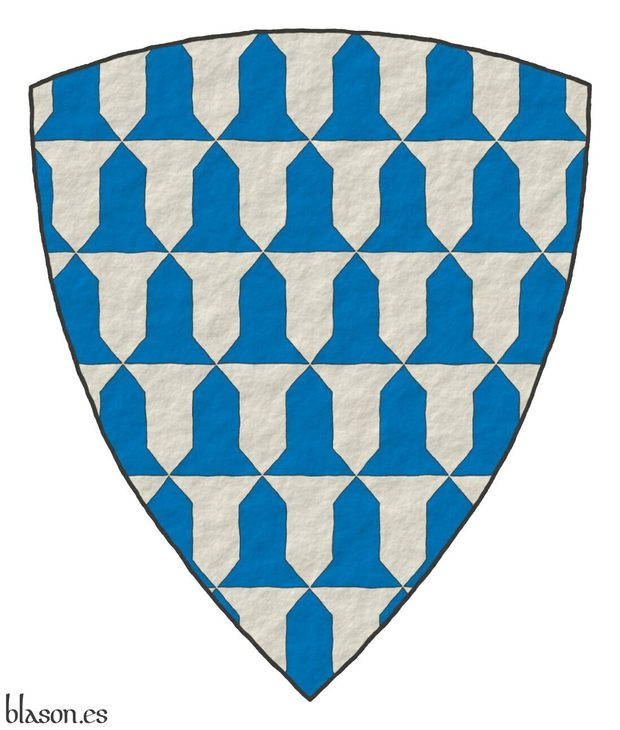
Joan de Beauchamp ~ John de Beauchamp.
Vair.
Escudo de veros.
Interpreted coat of arms, the shape of the shield is triangular and curved plain tinctures metal Argent and color Azure, outlined in sable; and a free hand finishing.
Included in [Vincent, MS; 1285; number 64] also known as [St. George's Roll; 1285; number 64].
Blazon keywords: Without divisions, Vair, Argent and Azure.
Style keywords: Triangular curved, Plain tincture and Outlined in sable.
Classification: Interpreted and Personal.
Bearer: Juan de Beauchamp.


John Lackland
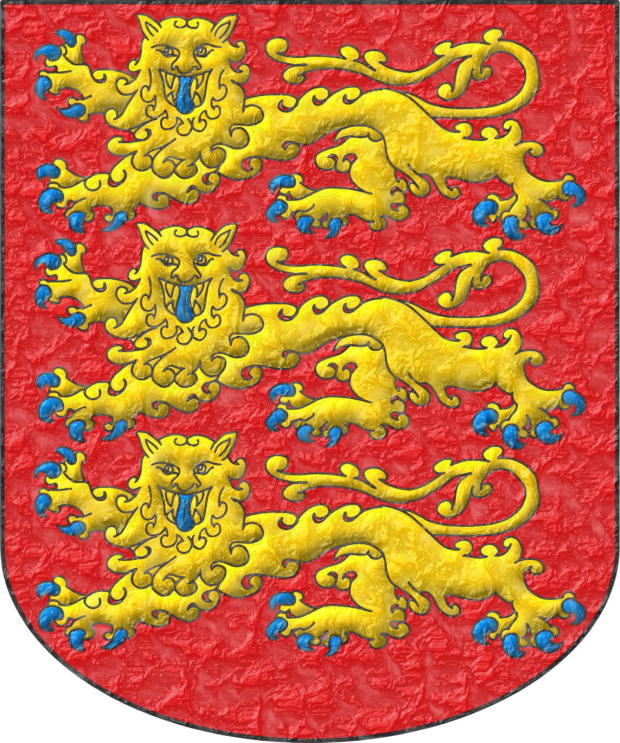
King of England and Lord of Ireland from 1199 to 1216.
Gules, three lions, passant, guardant, in pale Or, armed and langued Azure.
Escudo de gules, tres leopardos en palo de oro, armados y lampasados de azur.
Arms of King John interpreted with: a rounded (semicircular) base; the field enamelled with a flat tint of Gules; the leopards illuminated in Or and Azure, outlined in Sable, all three of the same size; and the whole finished with a crystalline effect.
Blazon keywords: Without divisions, Gules, Or, Azure, Three, Leopard, Armed, Langued and In pale.
Style keywords: Rounded, Illuminated, Outlined in sable and Crystalline.
Classification: Interpreted, Personal, Coat of arms, House of Plantagenet and Kingdom of England.
Bearer: John I of England.


John le Sturmy
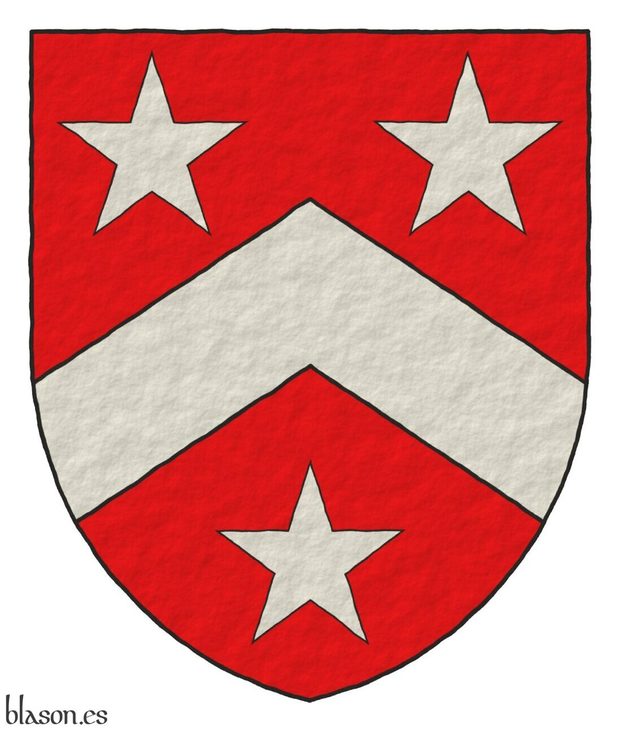
Juan le Sturmy ~ Joan le Strumi ~ John le Sturmy.
Gules, a chevron Argent, between three Mullets Argent.
Escudo de gules, un cabrio de plata, acompañado de tres estrellas de cinco puntas de plata.
Included in [Vincent, MS; 1285; number 664] also known as [St. George's Roll; 1285; number 664].
Blazon keywords: Without divisions, Gules, One, Chevron, Argent, Between, Three and Mullet.
Style keywords: Pointed, Plain tincture and Outlined in sable.
Classification: Interpreted and Personal.
Bearer: Juan le Sturmy.
Blazon equivalent to: Howel Ap Rhys.


King Arthur, 3 crowns in pale
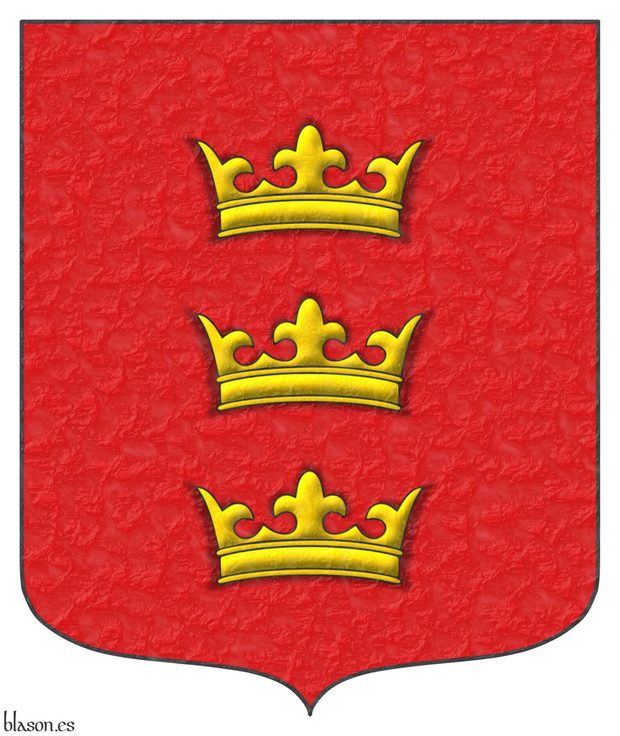
King Arthur
Gules, three crowns in pale Or.
Escudo de gules, tres coronas en palo de oro.
Imaginary coat of arms interpreted as follows: the mouth of the shield is pointed and rounded; the field has been enameled with flat color Gules; the crowns are illuminated Or and shaded; and the finish is crystalline.
The interpretation of this coat of arms has been carried out following as a model the arms that represent him in the armorial of [Edward IV of England; 1461; row 15, 2nd column], taking into account that this armorial presents 2 different arms for King Arthur.
Blazon keywords: Without divisions, Gules, Or and Crown.
Style keywords: Illuminated, Shaded, Outlined in sable, Crystalline and Ogee.
Classification: Interpreted, Imaginary, Coat of arms and Kingdom of England.
Imaginary bearer: Arthur of Britain.


![Ver [King, D.; 1656] en referencias bibliográficas. Libro abierto, hojas de plata, filo de oro, guardas de gules, tapas de sable.](../css/Libro.Bibliografia.png)
King, D.; 1656
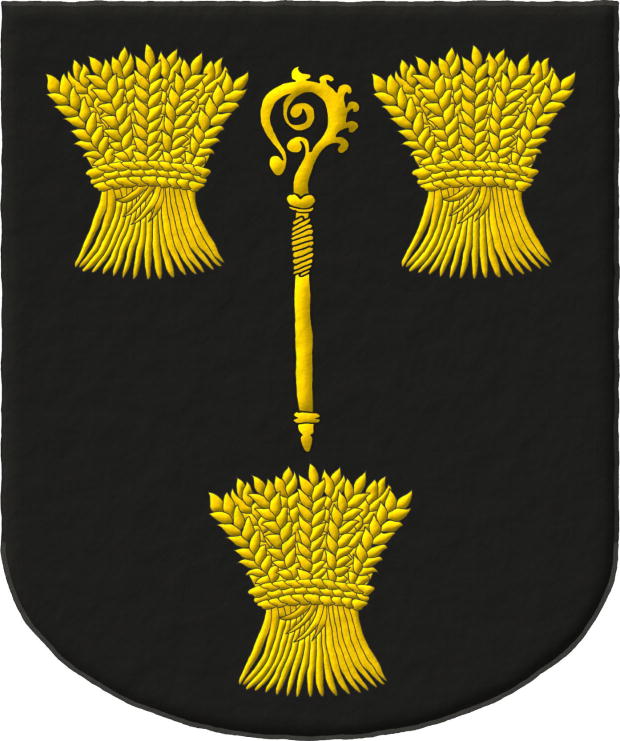
Daniel King, «The Vale-Royal of England or, The County Palatine of Chester Illustrated, wherein is Contained a Geographical and Historical Description of that Famous County, with all its Hundreds and Seats of the Nobility, Gentry and Freeholders», edited and published by Daniel King, engraver, book sponsored by Peter Venables, Baron of Kinderton, Chester, Cheshire County, 1656.
The book includes around 520 coats of arms of Cheshire, with black and white illustrations, where the metals and colors are indicated by a letter code.
The coat of arms that illustrates this bibliographic reference is one of those recorded in this book and corresponds to the coat of arms of Abadía de Delacres, with the difference that here the crozier faces the right side of the shield, unlike the one represented in this book, which, like other croziers in this book, faces the left side of the shield.
Bibliographical reference of century XVII.
Author: King, Daniel.
External links:


Kingdom of Jerusalem
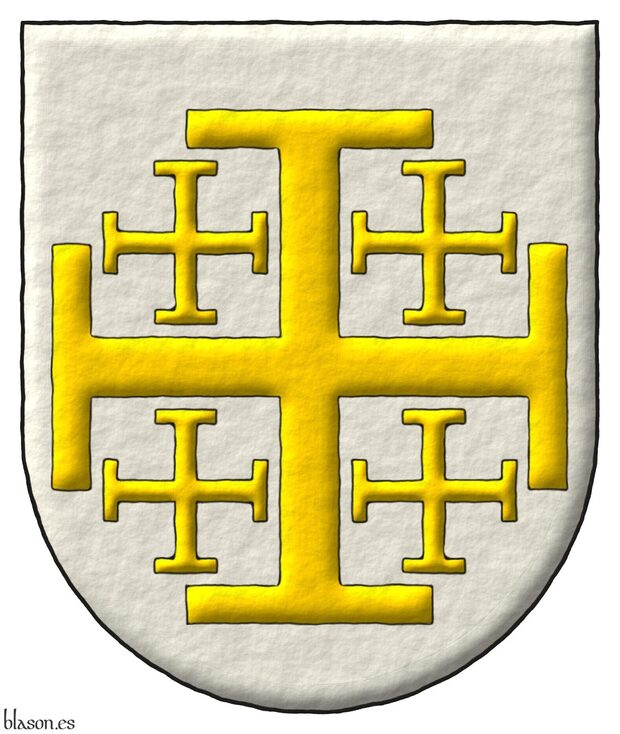
Metal Or over metal Argent.
Argent, a cross potent cantoned of four crosslets potent Or.
Escudo de plata, una cruz potenzada cantonada de cuatro cruces potenzadas todas de oro.
Illuminated with lights and shadows and with a freehand finish.
Perhaps the most classic example of non-compliance with the heraldic rule of tinctures having metal Or over metal Argent. In [Galdiano L.; Century XVII; folio 6], you can see a version of the arms of Jerusalem with the field in Gules, which would indeed follow the rule of tinctures as it is metal on color.
Blazon keywords: Without divisions, Argent, One, Cross potent, Cross couped, Cantoned, Four and Or.
Style keywords: Freehand, Outlined in sable, Illuminated, Semi-circular and Metal on metal.
Classification: Interpreted and Civic.
Bearer: Kingdom of Jerusalem.


Kupang, Royal House of
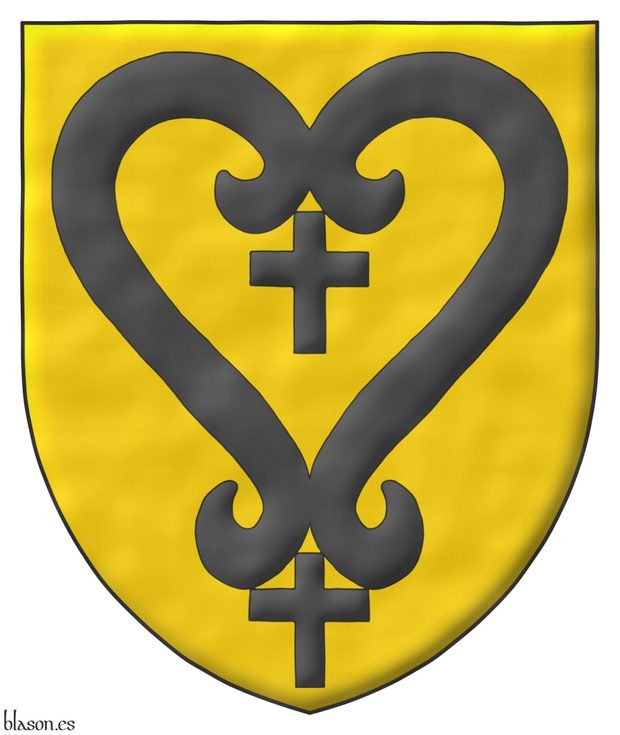
Or, the symbol of the Royal House of Kupang Sable.
Escudo de oro, el símbolo de la Casa Real de Kupang de sable.
Coat of arms emblazoned by me with a pointed shape, also called heater, illuminated, and its finishing is that seems watercolor.
Blazon keywords: Without divisions, Or, One, Symbol and Sable.
Style keywords: Pointed, Outlined in sable, Illuminated and Watercolor.
Classification: Civic, Interpreted and Coat of arms.
Bearer: Kupang, Royal House of.


Larre, lineage of Bayonne, French Basque Country
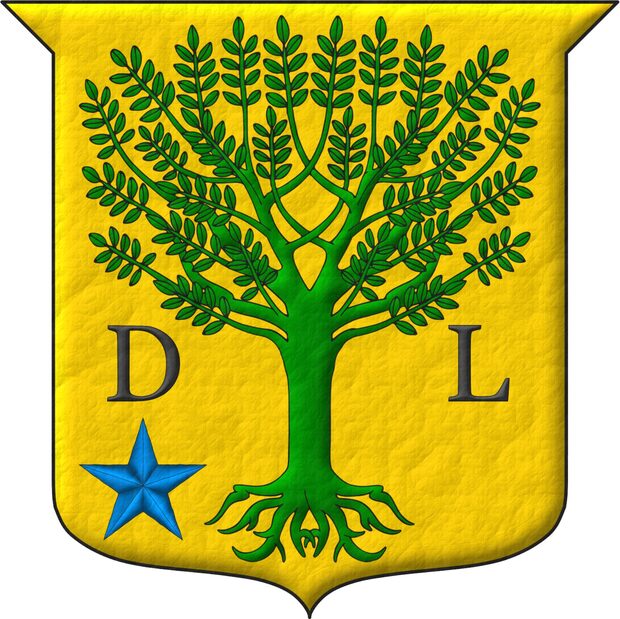
D'or à un arbre arraché de sinople, accosté à dextre de la lettre capitale «D» et à senestre de la lettre capitale «L» du même, et une étoile d'azur posée au canton dextre de la pointe.
Or, a tree eradicated Vert between a capital letter «D» and a capital letter «L» Sable, in the dexter of the base a mullet Azure.
Illuminated with lights and shadows and with a leather finish.
Blazon keywords: Without divisions, Or, One, Tree, Erased, Vert, Between, Letter, Sable, Canton, Dexter, Base (lower 1/3), Mullet, Five and Azure.
Style keywords: Leather, Outlined in sable, Illuminated and Semi-circular.
Classification: Interpreted, Lineage and Kingdom of France.


Latidos Podencos, video of the heraldic catalog
Blazon keywords: Without divisions, Gules, Or, Warren hound, Dog, Base, Base (lower 1/3), Dancetty, Heart and Motto (identification).
Style keywords: Illuminated and Outlined in sable.
Classification: Created, Socioeconomic, Catalogue, Heraldic document, Frame and Coat of arms.
Bearer: Latidos Podencos.


Lazcano, lineage of the Canary Islands
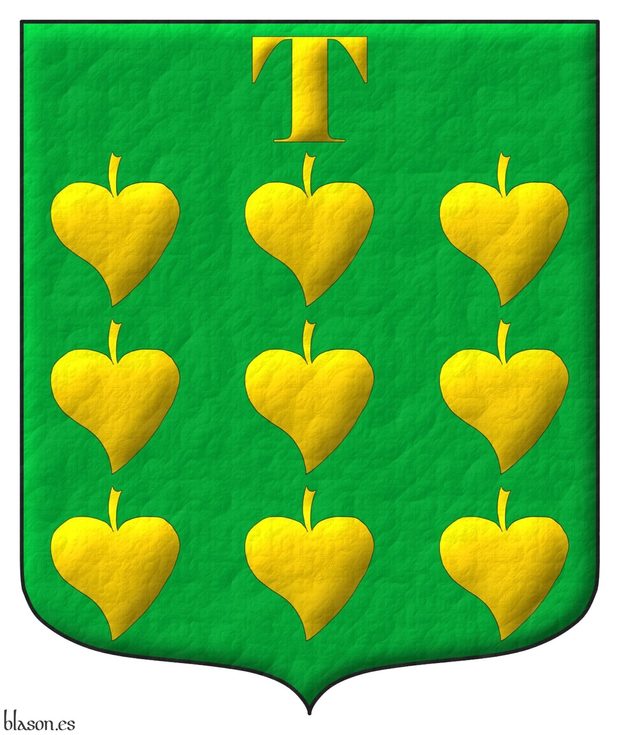
Blazon of the lineage Lazcano in the Canary Islands.
Vert, nine Poplar leaves ordered, in chief a «T» letter Or.
Illuminated and leather finishing.
It can be consulted at [Chaparro D'Acosta L.; 1979; página 251].
Blazon keywords: Without divisions, Vert, Letter, Poplar leaf, Or and Nine.
Style keywords: Leather, Outlined in sable and Illuminated.
Classification: Interpreted.


Leonor de Aquitania, escudo redondeado
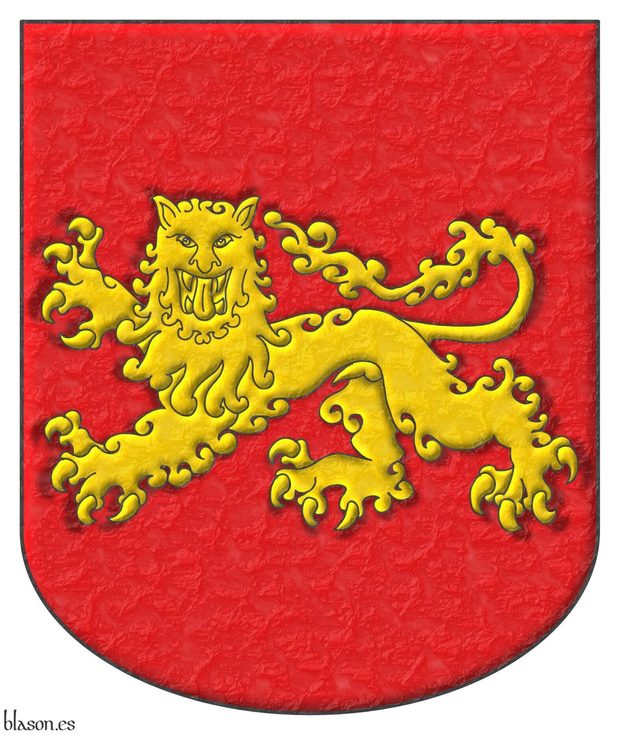
Gules, a lion passant, guardant Or.
Escudo de gules, un leopardo de oro.
Arms interpreted by me with: the shape of the coat of arms rounded; the field illuminated in Gules; the leopard illuminated in Or, outlined in Sable, and shaded; and the whole composition finished with a marble texture.
A description of the leopard in heraldry can be found in [Medél, R.; 1846; page 38].
Blazon keywords: Without divisions, Gules, One, Leopard and Or.
Style keywords: Rounded, Illuminated, Outlined in sable and Marmoreal.
Classification: Interpreted, Personal, Coat of arms, Duchy of Aquitaine, Kingdom of France and Kingdom of England.
Bearer: Leonor de Aquitania.


Leonor Plantagenet
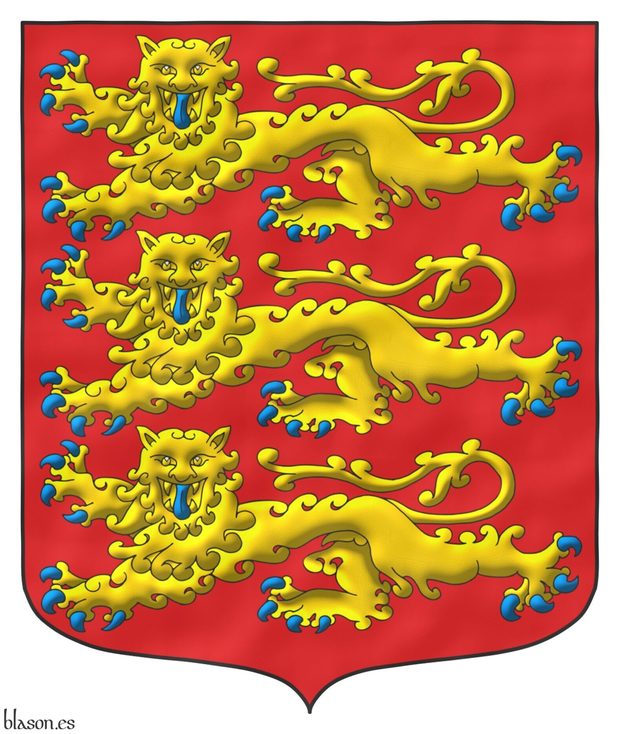
Gules, three lions, passant, guardant, in pale Or, armed and langued Azure.
Escudo de gules, tres leopardos en palo de oro, armados y lampasados de azur.
Existing armorial bearings interpreted as follows: the shape of the shield is pointed and rounded; the field has been enamelled in flat Gules; the three leopards are outlined in Sable and illuminated in metal Or with details in Azure; and the whole composition has a watercolor finish..
In [Humphery-Smith, C.; 1983; paragraph 2] the coat of arms of Eleanor Plantagenet, Queen Consort of Castile, is described, as part of an analysis on the origin of the three leopards in the coat of arms of England. However, in this description, an error is made by replacing the V with an X in the numeral of her husband and king, thus naming Alfonso VIII of Castile as if he were King Alfonso XIII: «Eleanor who married Alfonso XIII, King of Castile and Leon, has depicted on her tomb in the Huelgas monastery of the Cistercian nuns at Burgos, a thirteenth-century shield depicting three crowned leopards (lions passant guardant) gold on red».
Blazon keywords: Without divisions, Gules, Or, Azure, Three, Leopard, Armed, Langued and In pale.
Style keywords: Ogee, Illuminated, Outlined in sable and Watercolor.
Classification: Interpreted, Personal, Coat of arms, House of Plantagenet, Kingdom of England and Kingdom of Castile.
Bearer: Leonor Plantagenet.


Lete of Navarre
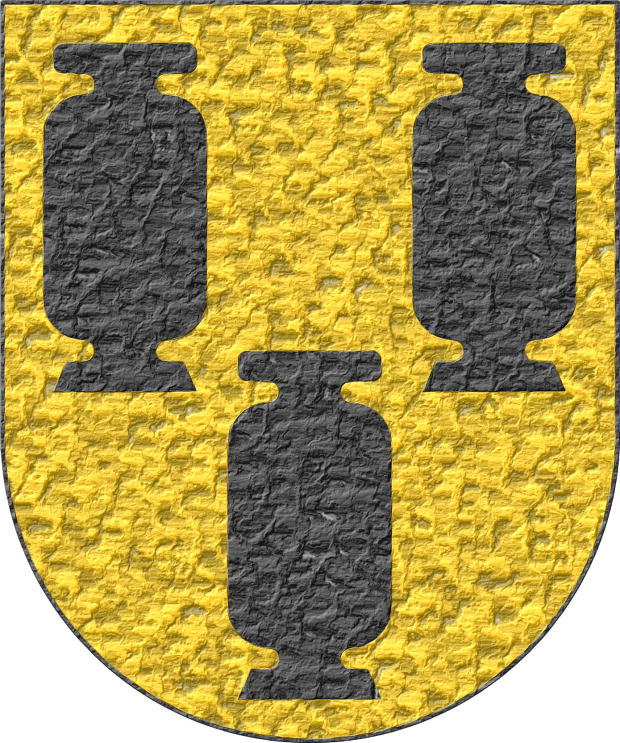
Of the twelve lineages of Noblemen, the sixth is that of Lete, from which descended Don Juan Corbarán de Let: they bear as arms, on a field Or, three pots shaped like cauldrons, slightly elongated, as painted in this shield.
Or, three Fleshpot Sable.
Escudo de oro, tres potes de sable.
Coat of arms interpreted with: a semicircular (round) base; the field in flat Or metal; the three pots illuminated in Sable with vertical, but not horizontal symmetry; and finished in highly-hammered metal.
It is not easy to find in English a similar figure:
- it could be considered «pote» ~ «pot», although perhaps «pot» is too generic,
- another possibility is «pote» ~ «fleshpot», which, although usually represented with three legs instead of a base and with two handles, is the one I tend to prefer,
- the English term «cauldron», but this corresponds to our «caldero» ~ «cauldron».
Coat of arms based on the sixth of the Navarrese «ricoshombres» from [Bosque, J. del; 1540; folio 1 of the numbering of 1613]. The text heading this article is taken from the transcription made by [Martinena Ruiz, J. J.; 1982; pages 122 and 123].
Although I have not found any reference about it, it could be considered that originally they might have been canting arms and that these three «potes» could have been milk pots, in reference to their bearers «Lete».
Under the title «Surname of Let» it can also be consulted in [Vega, P. J. de; 1702; folio 6 of the manuscript], although the number has been altered, possibly having been a 5 and perhaps interpreted as an 8, it is deduced by being placed after folio 7.
Blazon keywords: Without divisions, Or, Clay pot and Sable.
Style keywords: Semi-circular, Illuminated and Hard metal.
Classification: Interpreted, Personal, Kingdom of Navarre and Canting.
Bearer: Lete of Navarre.


Logic, modus ponendo ponens and fess
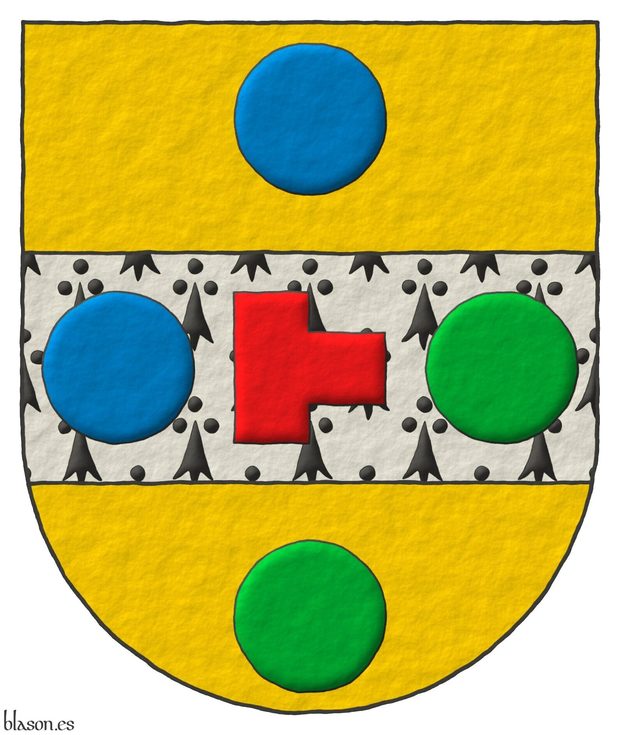
Azure, Azure implies Vert, therefore Vert.
Or, on a fess ermine, a potent fesswise Gules, between in dexter a hurt, in sinister a pomme; in chief a hurt, in base a pomme.
Escudo oro, una faja de armiños, cargada de una potenza puesta en faja de gules, acompañada a la diestra de un roel de azur, a la siniestra de un roel de sinople; en jefe un roel de azur, en punta un roel de sinople.
Variant of the imaginary coat of arms of Logic with: a semicircular (round) base; its field and fess enameled with plain Or and Argent; the 4 pieces and the figure illuminated in Azure, Gules, and Vert and outlined in Sable; and the whole with a raised-stroke effect.
Blazon keywords: Without divisions, Fess, Or, Ermine, Azure, Vert, Gules, Hurt, torteau, pellet, pomme and golpe, Potent, Fesswise, In chief, In base and Between.
Style keywords: Illuminated, Outlined in sable and Freehand.
Classification: Created, Imaginary and Coat of arms.
Imaginary bearer: Logic.


Louis IX of France
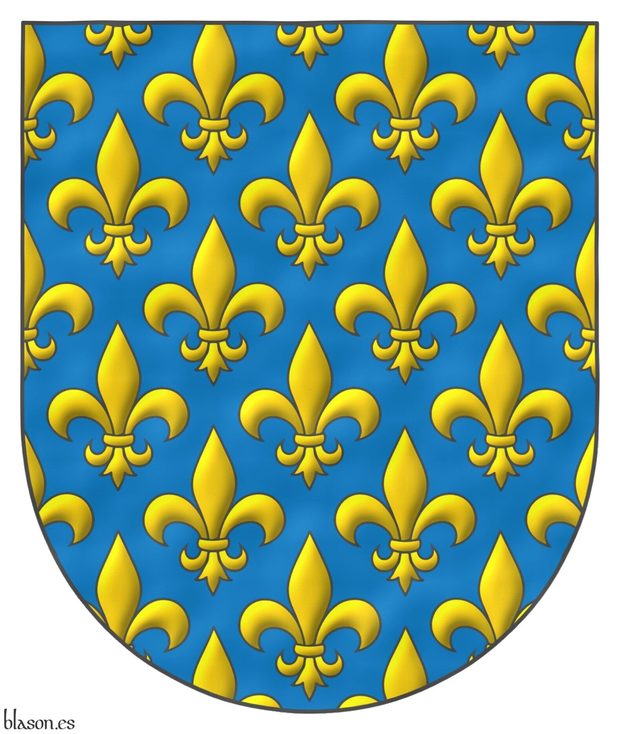
Saint Louis, King of France (1214-1270), son of Blanche of Castile.
Azure semé of fleurs de lis Or.
Escudo de Azur sembrado de flores de lis de oro.
Coat of arms interpreted by me as follows: the shield has a semicircular (round) base; the field is enamelled in flat Azure; the fleurs-de-lis are outlined in Sable and illuminated in Or; and finished with a watercolor effect.
Toward the end of his reign, the armorial called [Wijnbergen; 1265] was created, whose first part is devoted to recording his coat of arms [Wijnbergen; 1265; shield no. 1], which was also that of his father Louis VIII, husband of Blanche of Castile, and the coats of arms of those who were his vassals.
Blazon keywords: Without divisions, Azure, Or, Semé and Fleur de lis.
Style keywords: Semi-circular, Illuminated, Outlined in sable and Watercolor.
Classification: Interpreted, Personal, Coat of arms, Kingdom of France and House of the Capetians.
Bearer: Louis IX of France.


Lucius III
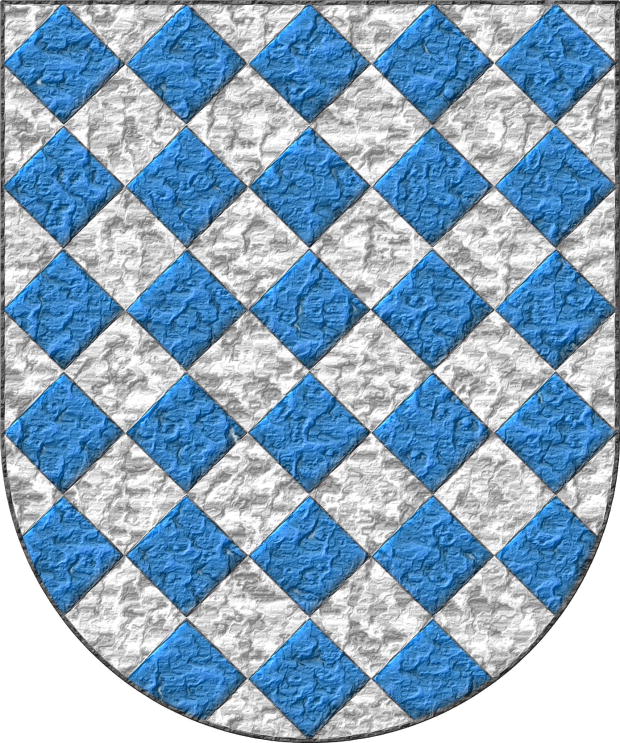
171st Pope of the Church, from the year 1181 to the year 1185. «Lucius III», born Ubaldo Allucinoli, was born in Lucca in northwest Italy.
Lozengy Argent and Azure.
Escudo losanjado de plata y azur.
Papal coat of arms interpreted by me with: a semicircular shield shape; a plain Argent field; checky or squares illuminated in Azure and outlined in Sable; and the whole design with a watercolor finish.
Blazon keywords: Without divisions, Lozengy, Argent and Azure.
Style keywords: Semi-circular, Illuminated, Outlined in sable and Hard metal.
Classification: Interpreted, Religious and Papal States.
Bearer: Lucius III.


Malvin de Montazet, lineage of Languedoc
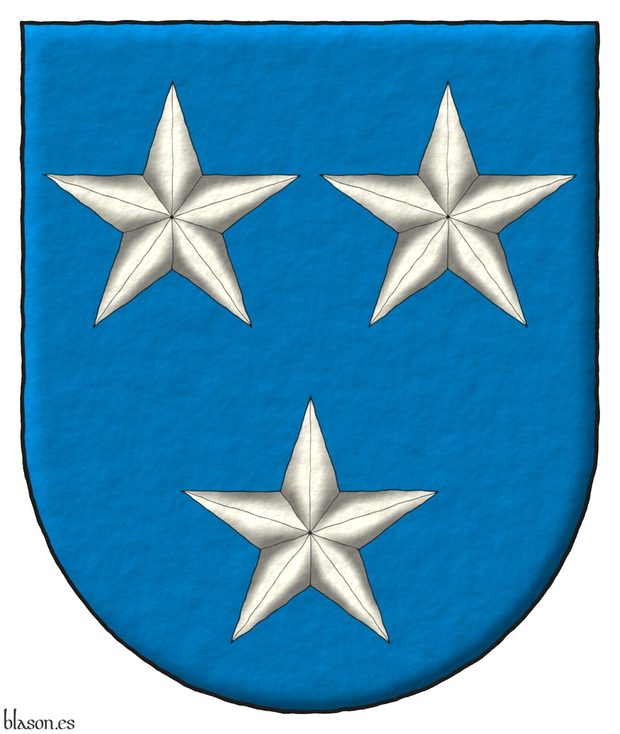
Blazon of the Malvin de Montazet lineage of Languedoc, France.
Azure, three mullets Argent, 2 and 1.
Illuminated and a freehand finishing.
Its French blazon «d'azur, à trois étoiles d'argent, 2 et 1» can be found at [Rietstap, J. B.; 1861; page 140].
Blazon keywords: Without divisions, Azure, Three, Mullet, Argent and Ordered.
Style keywords: Freehand, Outlined in sable, Illuminated and Semi-circular.
Classification: Interpreted, Lineage and Kingdom of France.


![Ver [Marshal, L.; 1295] en referencias bibliográficas. Libro abierto, hojas de plata, filo de oro, guardas de gules, tapas de sable.](../css/Libro.Bibliografia.png)
Marshal, L.; 1295
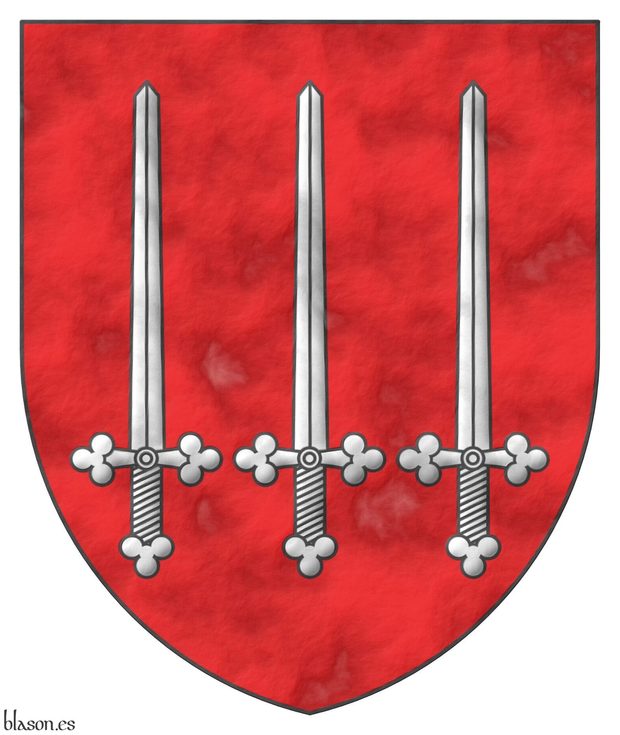
Lord Marshal, «The Lord Marshal's Roll», deposited in the Society of Antiquaries of London, code ms664, volume 1, ff 19-25, contains 565 painted shields, of which 42 are blank and 48 do not have the name of their associated holder, dated 1295.
This armorial contains the systematic error of representing, in many of its registered shields, the metal gold as metal silver, and some of its shields are not easy to decipher. Therefore, this armorial cannot be considered a completely reliable and definitive source of certain coats of arms.
[Brault, G. J.; 1997] is a good reference for the analysis of this armorial and in Brian Timms you can see a current interpretation of the coats of arms recorded in it, among them the shield of William de Colebrand that illustrates this bibliographic reference.
At the beginning of the second half of the 13th century, the use of coats of arms increased, this increase led to the appearance of the first armorials in which the name of their holders was recorded along with the blazon describing their coats of arms, possibly including the painted shields.
Bibliographical reference of century XIII.
The author is Marshal, Lord.
Bibliographic reference mentioned in the following articles:
External link:


Martin S. J. Goldstraw, tartan 3x3
Argent, on a chevron Gules three feathers Argent, between three swords erect Gules. Motto: «Ab Initio Goostrey».
This is the coat of arms of Martin Goldstraw emblazoned by me over his family tartan. This tartan was designed by Don Smith and is registered in the Scottish Register of Tartans, 2002.
Blazon keywords: Without divisions, Argent, Gules, Chevron, Charged, Sword, Point upwards, Ordered, Between, Quill and Motto.
Style keywords: Rounded, Illuminated, Outlined in sable and Freehand.
Classification: Interpreted, Personal, Cheshire County and Tartan.
Bearer: Goldstraw, Martin S. J..


![Ver [Martinena Ruiz, J. J.; 1982] en referencias bibliográficas. Libro abierto, hojas de plata, filo de oro, guardas de gules, tapas de sable.](../css/Libro.Bibliografia.png)
Martinena Ruiz, J. J.; 1982
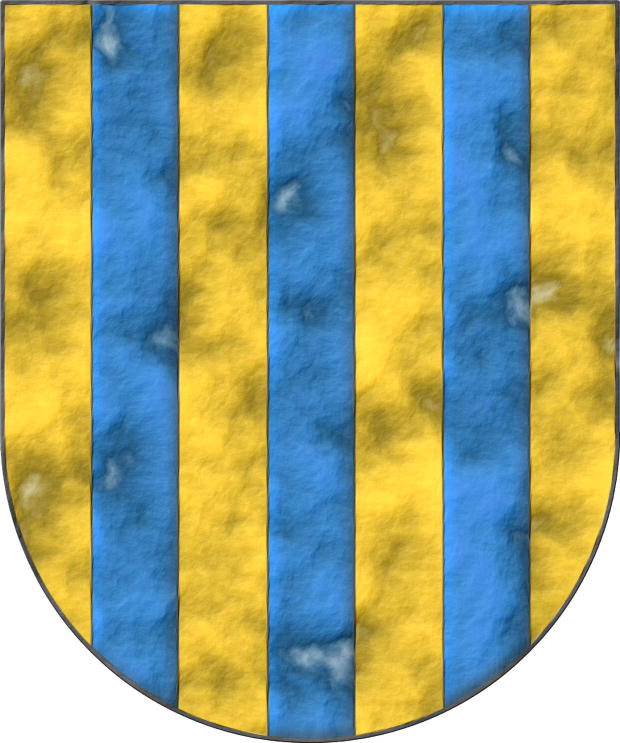
Juan José Martinena Ruiz, «Book of Armory of the Kingdom of Navarra: Introduction, Study, and Notes», published by the Institución Príncipe de Viana, 350 pages, ISBN 84-235-0557-X, Pamplona, 1982.
Introduction, study, and notes on the armorial [Bosque, J. del; 1540]. On pages 122 and 123, the coats of arms of the «ricoshombres» of Navarra, or «twelve barons of the major houses» as they are also called, surrounding the king's coat of arms in this armorial are compiled and transcribed.
The coat of arms accompanying this bibliographic reference is that of Almorrabides de Navarra following Juan del Bosque.
Bibliographical reference of century XX.
The author is Martinena Ruiz, Juan José.
The following articles cite this bibliographic reference:
- Almorrabides of Navarre
- Aybar of Navarre
- Baztanes of Navarre
- Bosque, J. del; 1540
- Guebara of Navarre
- Lete of Navarre
- Martinena Ruiz, J. J.; Menéndez Pidal de Navascués, F.; 2001
- Mauleón of Navarre
- Monteagudo of Navarra
- Navarra, closed carbuncle
- Noblemen of Navarre
- Qasqante of Navarre
- Rada of Navarre
- Subiça of Navarre
- Urroz of Navarre
- Vidaurre of Navarre
External resources:


![Ver [Martinena Ruiz, J. J.; Menéndez Pidal de Navascués, F.; 2001] en referencias bibliográficas. Libro abierto, hojas de plata, filo de oro, guardas de gules, tapas de sable.](../css/Libro.Bibliografia.png)
Martinena Ruiz, J. J.; Menéndez Pidal de Navascués, F.; 2001
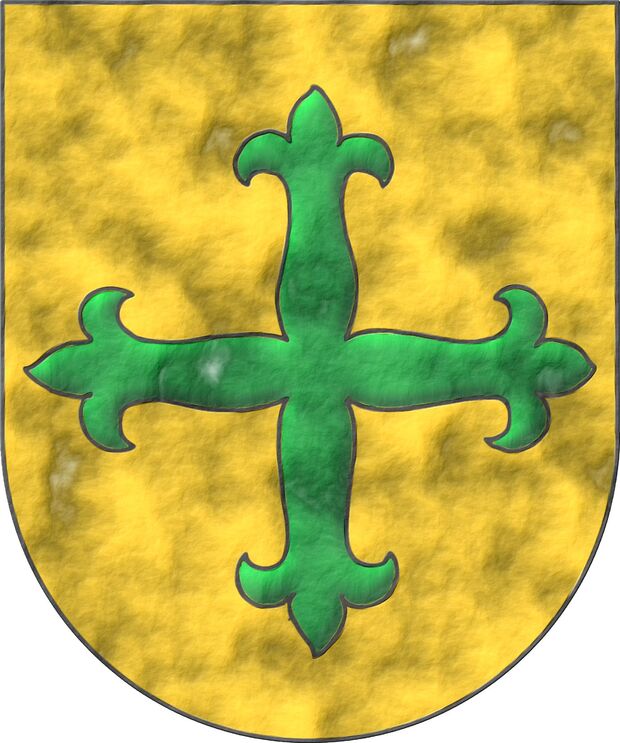
Juan José Martinena Ruiz and Faustino Menéndez Pidal de Navascués, «Book of Armory of the Kingdom of Navarra», Published by the Institución Príncipe de Viana, Directorate-General for Culture, Government of Navarra, 484 pages, ISBN-13 978-84-235-2166-1, ISBN-10 84-235-2166-4, Pamplona, 2001.
Reproduction and transcription of the manuscript armorial [Bosque, J. del; 1540], that is, the copy of the «Book of Armory of the Kingdom of Navarra», preserved in the General Archive of Navarra.
The coat of arms accompanying this bibliographic reference is that of Rada de Navarra following Juan del Bosque.
Both authors had already written and published, separately, about the armorial [Bosque, J. del; 1540], an example of the first is [Martinena Ruiz, J. J.; 1982] and an example of the second is [Menéndez Pidal de Navascués, F.; 1974].
Bibliographical reference of century XXI.
Classification: De bibliotheca.
Authors: Martinena Ruiz, Juan José and Menéndez Pidal de Navascués, Faustino.
Bibliographic reference mentioned in the following articles:
External resources:


Mascarenhas, lineage of Portugal
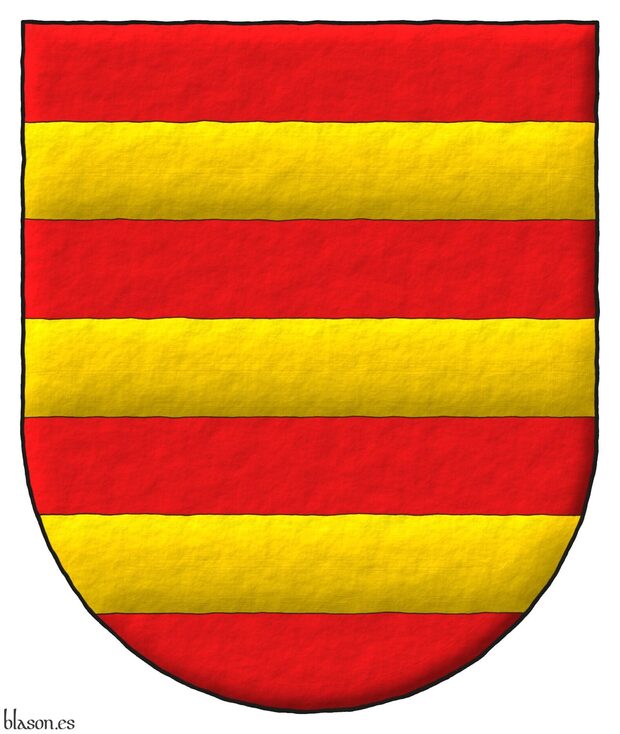
Blazon of the Mascarenhas lineage of Portugal.
Gules, three bars Or.
Illuminated and a freehand finishing.
It can be found at [Cró, J. do; 1509; page 77].
Blazon keywords: Without divisions, Gules, Three, Fess and Or.
Style keywords: Freehand, Outlined in sable, Illuminated and Semi-circular.
Classification: Interpreted, Lineage and Kingdom of Portugal.


Mauleón of Navarre
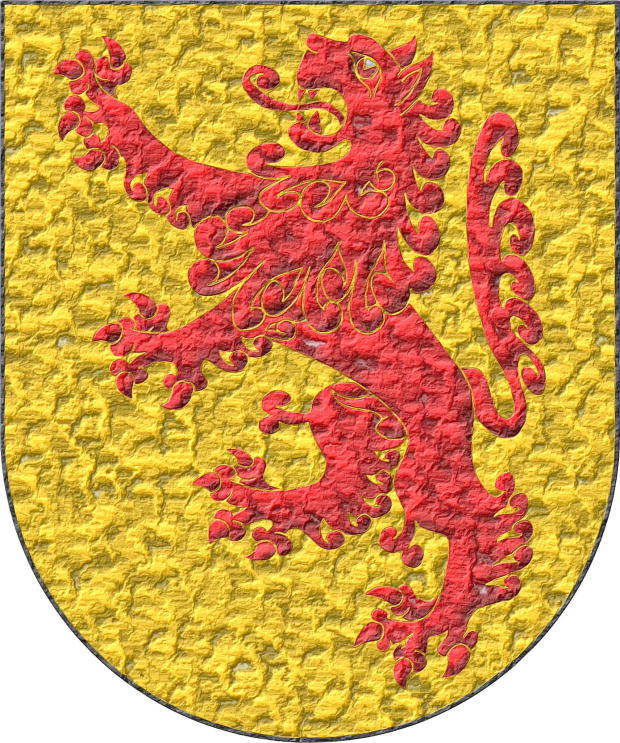
Of the twelve lineages of Noblemen, the twelfth bears as insignia and arms, on a shield Or, a rampant lion Gules, as painted in this shield.
Or, a Lion Gules, rampant.
Escudo de oro, un león de gules, rampante.
Coat of arms interpreted with: a semicircular (round) base; the field in flat Or; the lion illuminated in Gules and outlined in the colour of the field, that is, in Or metal; and the whole finished in highly-hammered metal.
Coat of arms interpreted from the last of the shields of the Navarrese «ricoshombres» illustrated in [Bosque, J. del; 1540; folio 1 of the numbering of 1613] and with the text preceding the blazon taken from the transcription by [Martinena Ruiz, J. J.; 1982; pages 122 and 123].
I consider these to be canting arms, and that this «lion» Gules refers to its bearers «Mauleón».
Under the title «Surname of Mauleon», without an accent on the letter «o», it can be consulted in [Vega, P. J. de; 1702; folio 12 of the manuscript].
Blazon keywords: Without divisions, Or, Lion, Gules and Rampant.
Style keywords: Semi-circular, Illuminated, Outlined in sable and Hard metal.
Classification: Interpreted, Personal, Kingdom of Navarre and Canting.
Bearer: Mauleón of Navarre.


McCartney, Michael
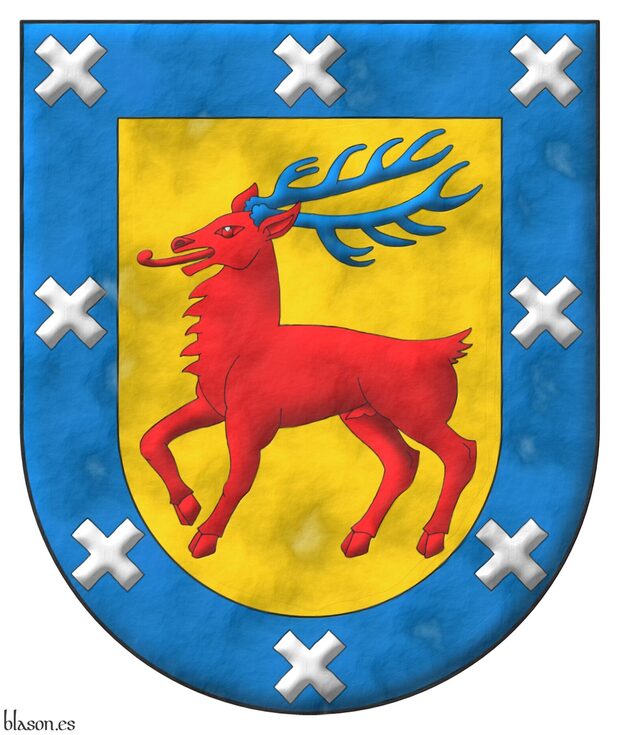
Or, a stag trippant Gules, attired Azure; a bordure Azure charged with eight saltires couped Argent.
Escudo de oro, un ciervo pasante de gules, acornado de azur; una bordura de azur cargada con ocho sotueres de plata.
Coat of arms interpreted and emblazoned by me with with a semi-circular ended shape, illuminated, and with a parchment finishing.
Blazon keywords: Without divisions, Or, One, Stag, Tripant, Gules, Attired, Azure, Bordure, Charged, Eight, Saltire and Argent.
Style keywords: Parchment, Outlined in sable, Illuminated and Semi-circular.
Classification: Interpreted and Coat of arms.
Bearer: McCartney, Michael.


![Ver [Menéndez Pidal de Navascués, F.; 1974] en referencias bibliográficas. Libro abierto, hojas de plata, filo de oro, guardas de gules, tapas de sable.](../css/Libro.Bibliografia.png)
Menéndez Pidal de Navascués, F.; 1974
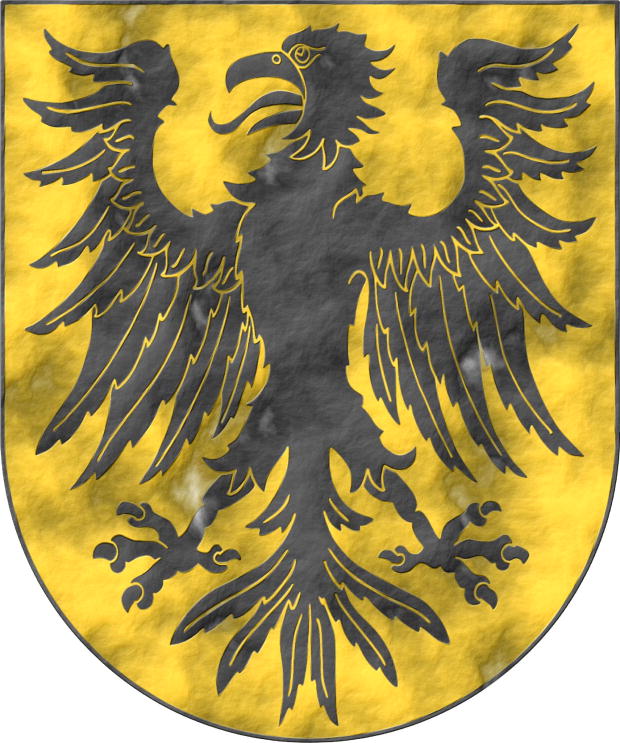
Faustino Menéndez Pidal de Navascués, «Book of Armory of the Kingdom of Navarra: Transcription and Study», published by La Gran Enciclopedia Vasca, 160 pages, ISBN 84-248-0119-9, Bilbao, 1974.
Transcription and study of the Navarrese manuscript armorial [Bosque, J. del; 1540], preserved in the General Archive of Navarra.
This book contains an introduction, the transcription of the armorial texts, its photographic reproduction, which also includes the Navarrese coats of arms of the Reyneck armorial and the coat of arms of the refectory of the Cathedral of Santa María la Real de Pamplona, an index of names, a heraldic table, and a set of appendices [Martínez de Aguirre, J.; 2007; page 351].
The coat of arms accompanying this bibliographic reference is that of Qasqante de Navarra following, precisely, the armorial of Juan del Bosque.
Bibliographical reference of century XX.
The author is Menéndez Pidal de Navascués, Faustino.
Here are the articles quoting this reference:
- Bosque, J. del; 1540
- Martinena Ruiz, J. J.; Menéndez Pidal de Navascués, F.; 2001
- Navarra, closed carbuncle
External links:


![Ver [Menéndez Pidal de Navascués, F.; 1985] en referencias bibliográficas. Libro abierto, hojas de plata, filo de oro, guardas de gules, tapas de sable.](../css/Libro.Bibliografia.png)
Menéndez Pidal de Navascués, F.; 1985

Faustino Menéndez Pidal de Navascués, «Rare and Ambiguous Charges of Spanish Heraldry», Revista Hidalguía, issue 190 and 191, Ediciones Hidalguía, Madrid, 1985.
The coat of arms with squares accompanying this bibliographic reference is that of Guebara de Navarra, an interpretation based on that by [Bosque, J. del; 1540]. I chose this coat of arms because Faustino Menéndez Pidal writes precisely about it and about the squares as a figure typical of Spanish heraldry, for example, he does so on pages 474 and 475 of this article.
Bibliographical reference of century XX.
The author is Menéndez Pidal de Navascués, Faustino.
Bibliographical reference mentioned in the following article:
External resource:
Internal resources: MenendezPidalDeNavascuesF1985.MueblesRarosHeraldicaEspañola.pdf.


![Ver [Mogrobejo Zabala, E. de; 1991] en referencias bibliográficas. Libro abierto, hojas de plata, filo de oro, guardas de gules, tapas de sable.](../css/Libro.Bibliografia.png)
Mogrobejo Zabala, E. de; 1991
Endika de Mogrobejo Zabala, «Blasones y Linajes de Euskalerria», 10 volumes, Volume I A-Alcerreca, Volume II Alciba-Angui, Volume III Angulo-Astu, Volume IV Astun-Bun, Volume V Busta-Elua, Volume VI Elus-Gorniz, Volume VII Gordu-Laca, Volume VIII Lacar-Merca, Volume IX Mere-Salez, Volume X Salinas-Z, edited by Editorial Amigos del Libro Vasco, printed by Grafo SA, ISBN of the complete work 84-7886-026-6, legal Deposit BI-469-1991, Bilbao, 1991.
Bibliographical reference of century XX.
Classification: De bibliotheca, Black and white with color plates and Castilian language.
Author: Mogrobejo Zabala, Endika de.


Monteagudo of Navarra
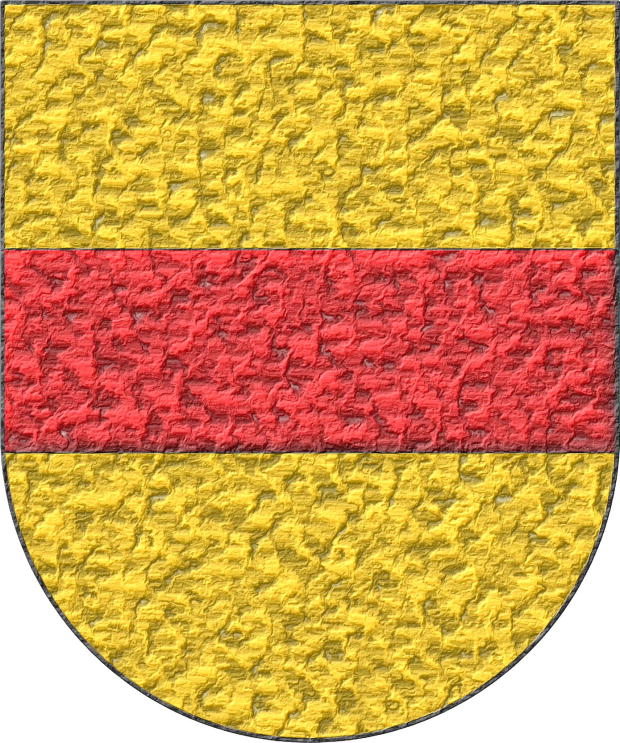
Of the twelve lineages of Noblemen, the eleventh is the house of Monteagudo; they bear as arms a shield Or, and in the middle a fess Gules, in the manner in which this shield is painted.
Or, a fess Gules.
Escudo de oro, una faja de gules.
Coat of arms interpreted as follows: a semicircular (round) base; the field enamelled in flat Or; the fess outlined in Sable and illuminated in Gules; and the whole finished in highly-hammered metal.
Interpreted from the eleventh coat of arms of the Navarrese «ricoshombres» from [Bosque, J. del; 1540; folio 1 of the numbering of 1613] and with the preceding text taken from the transcription appearing in [Martinena Ruiz, J. J.; 1982; pages 122 and 123].
Under the title «Surname of Monteagudo» this blazon can be consulted in [Vega, P. J. de; 1702; folio 11 of the manuscript].
Blazon keywords: Without divisions, Or, Fess and Azure.
Style keywords: Semi-circular, Illuminated, Outlined in sable and Hard metal.
Classification: Interpreted, Personal and Kingdom of Navarre.
Bearer: Monteagudo of Navarra.


Motto of Tomasz Arkadiusz Grzeszkowiak

Gules, a base enarched Vert, overall a cross patty fitchy Or, piercing in base the head of a serpent nowed and facing sinister Sable, langued Gules. Motto: «Amor vincit omnia»
Blazon keywords: Without divisions, Gules, One, Mount, Vert, Issuant from base, Overall, Cross patty fitchy, Cross couped, Piercing, Head, Serpent, Nowed, Facing sinister, Sable, Langued and Motto.
Style keywords: Semi-circular, Leather and Outlined in sable.
Classification: Interpreted, Personal and Coat of arms.
Bearer: Grzeszkowiak, Tomasz Arkadiusz.


Navarra, closed carbuncle
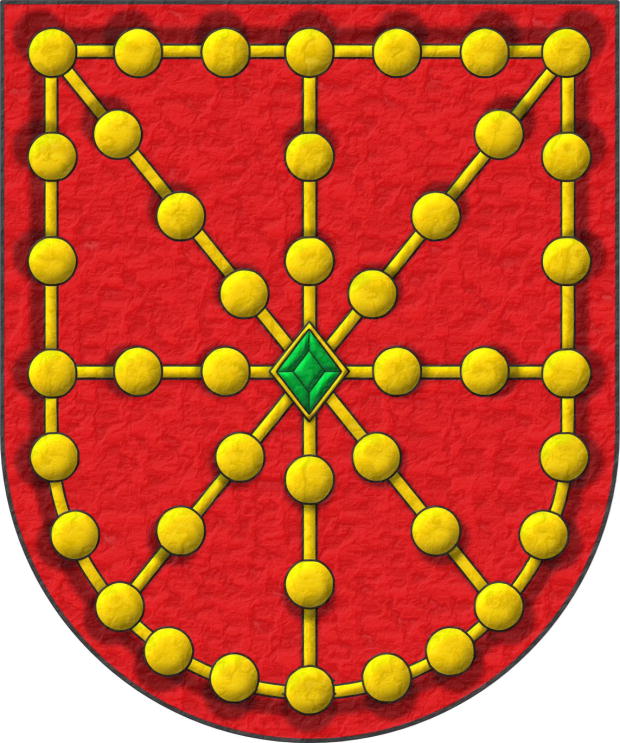
Escudo de gules, un carbunclo cerrado, pomelado de oro; cargado en el centro de una esmeralda en forma de losange de sinople.
Coat of arms interpreted with: a semicircular (round) base; the field in flat Gules; the pommetty carbuncle and the emerald illuminated in Or and Vert, shaded and outlined in Sable; and the whole finished in lightly-hammered metal.
In addition to historical documents such as the armorials [Urfé; 15th century] which blazons it and [Bosque, J. del; 1540] which illustrates it, there is, in the last half century, an abundant bibliography on the arms of Navarre, for example: [Menéndez Pidal de Navascués, F.; 1963], [Menéndez Pidal de Navascués, F.; 1974], [Martinena Ruiz, J. J.; 1982], [Menéndez Pidal de Navascués, F.; 1999], [Menéndez Pidal de Navascués, F.; Martínez de Aguirre, J.; 2000], [Martinena Ruiz, J. J.; Menéndez Pidal de Navascués, F.; 2001] and [Martínez de Aguirre, J.; 2007].
This pommetty shield can also be seen, for example, on the outer façade of the convent of Santo Domingo in Estella, on capitals preserved in the Cathedral of Tudela and on capitals of the church of Santa María la Real of Laguardia, the latter dating from the 14th century.
Blazon keywords: Without divisions, Gules, One, Carbuncle, Pommelled, Or, Charged, In the fess point, Emerald, Vert and Lozenge.
Style keywords: Soft metal, Illuminated, Outlined in sable and Shaded.
Classification: Interpreted, Civic and Coat of arms.
Bearer: Navarre.

Nhf, Norsk Heraldisk Forening
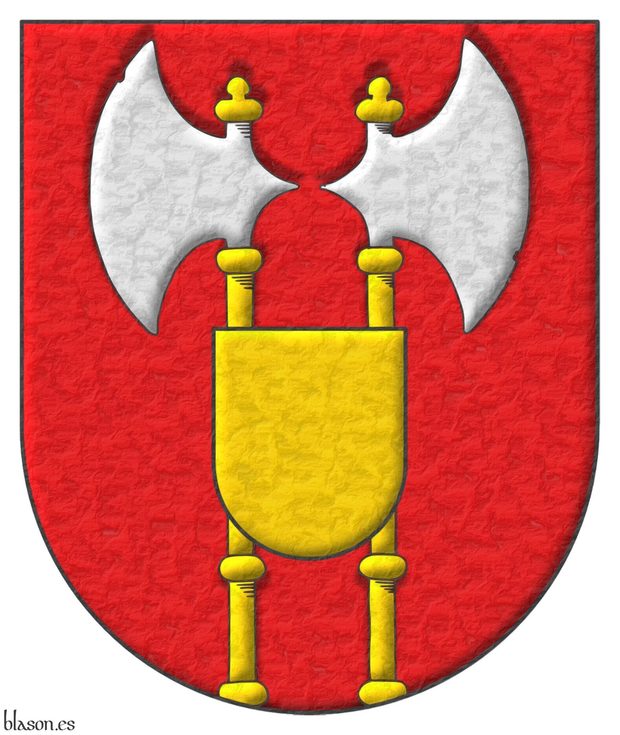
Gules, two Axes Argent, hafted Or, addorsed, issuant from the base; overall, at the nombril, an Escutcheon Or.
Escudo de gules, dos hachas adosadas de plata, fustadas de oro, movientes de la punta; brochante sobre el todo, en el ombligo, un escudete de oro.
Coat of arms interpreted with: the semicircular shape; its field illuminated with Gules; its figures and escutcheon illuminated with Or and Argent and outlined in Sable; and with a free hand texture.
At the nombril
A distinctive feature of this coat of arms is that its escutcheon, instead of being overall in the center, is positioned on a point of the coat of arms called the nombril, which, as we learn from [Avilés, J.; 1725a; page 159 and illustration 19] and also [Avilés, J.; 1780a; pages 147 and 148], in «Heraldry, the nombril of the coat of arms, is the place through which the human body receives nourishment in the mother's womb, and in the shield, it corresponds to the point where the fess ends and the base begins.».
If this escutcheon, «escudete» in Castilian, had been positioned in the center of the coat of arms, then it would have to be blazoned as the piece called an inescutcheon, «escusón» in Castilian. In fact, the Norsk Heraldisk Forening uses the English term «escutcheon» to describe the blazon of its arms.
Blazon keywords: Without divisions, Gules, Axe, Argent, Hafted, Or, Addorsed, Issuant from base, Overall, At the nombril and Escutcheon.
Style keywords: Semi-circular, Illuminated, Outlined in sable, Shaded and Soft metal.
Classification: Interpreted, Socioeconomic and Coat of arms.
Bearer: Norsk Heraldisk Forening.


Nicholas Malmains
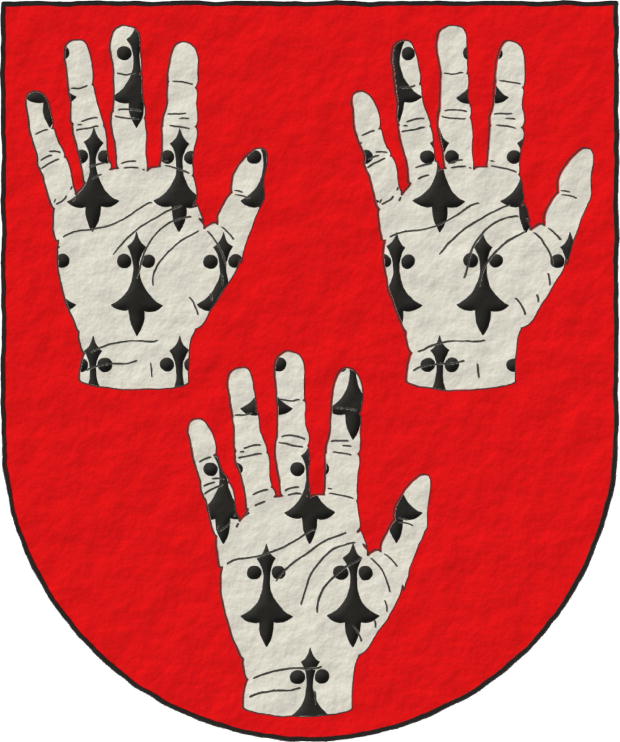
Nicolás Malmains ~ Nicholas Malmains ~ Nicol Malemeins.
Gules, three dexter hands turned up, and appaumée Ermine.
Escudo de gules, tres manos diestras levantadas y apalpadas de armiños.
Included in [Vincent, MS; 1285; number 622] also known as [St. George's Roll; 1285; number 622].
Blazon keywords: Without divisions, Gules, Three, Hand, Dexter, Ermine, Turned up, Appaumée and Ordered.
Style keywords: Semi-circular, Illuminated, Outlined in sable and Freehand.
Classification: Interpreted and Personal.
Bearer: Nicolás Malmains.


![Ver [Nisbet, A.; 1722] en referencias bibliográficas. Libro abierto, hojas de plata, filo de oro, guardas de gules, tapas de sable.](../css/Libro.Bibliografia.png)
Nisbet, A.; 1722
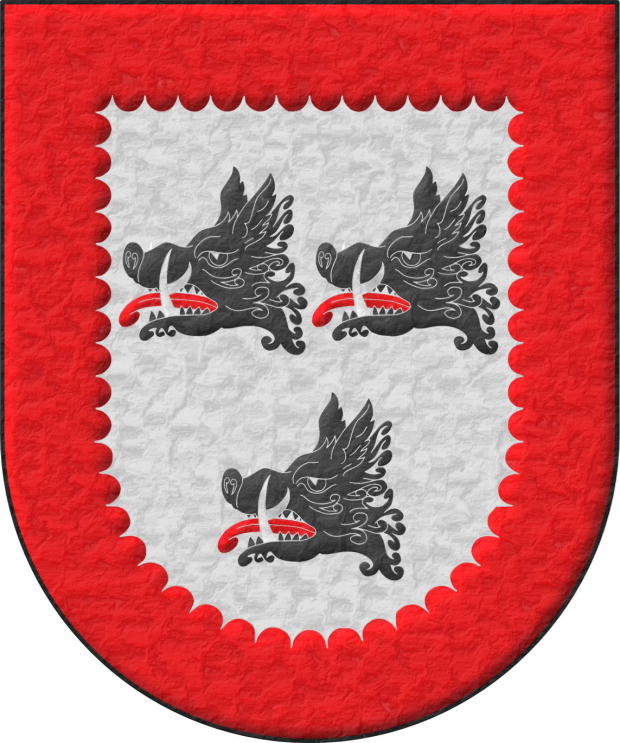
Alexander Nisbet, «System of Heraldry Speculative and Practical: With the True Art of Blazon», subtitle «according to the most approved heralds in Europe: illustrated with suitable examples of armoria figures, and achievements of the most considerable surnames and families in Scotland, together with historical and genealogical memorials relative thereto», printed by J. MackEuen, Edinburgh, 1722.
This is the very 1st edition of this book and I consult the edition [Nisbet, A.; 1816].
Bibliographical reference of century XVIII.
The author is Nisbet, Alexander.
The following articles cite this bibliographic reference:
External resource:


Noblemen of Navarre
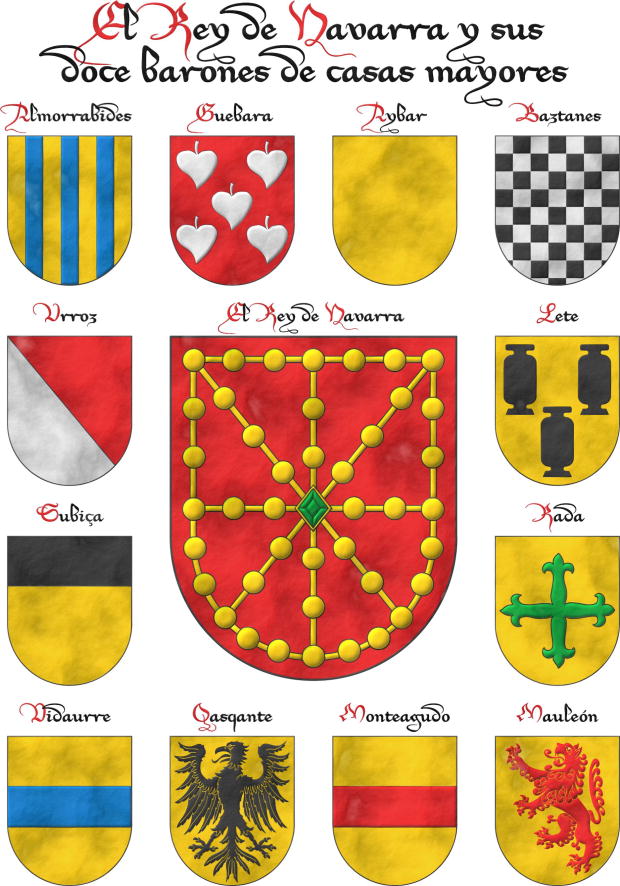
The King of Navarre, at the time of his new and solemn coronation, is raised and lifted up as King by the hands of twelve barons of the greatest and oldest houses of the said Kingdom, and these are the twelve Noblemen who are named on the other side, with their blazons and coats of arms.
Interpretation and composition of 13 coats of arms that I have created with a parchment-like finish.
A free interpretation, for example, without the central crown over the arms of Navarre, with a different title, written «Navarra» and not «Nabarra», etc., based on the principal plate of [Bosque, J. del; 1540; folio 1 of the numbering of 1613] and with texts taken from the transcription by [Martinena Ruiz, J. J.; 1982; pages 122 and 123].
«Ricohombre», written together, currently means «title that formerly belonged to the highest nobility of Spain», [Real Academia Española; 2001].
Its plural «ricoshombres» is the most commonly used form, but «ricohombres» is also correct and used; and in [Bosque, J. del; 1540] it is written separately, and «honbre» with an «n» before the «b», that is, «ricos honbres».
Blazon keywords: Without divisions, Party per bend, Azure, Gules, Or, Argent, Sable, Vert, Eagle, Chequey, Cross flory, Cross couped, Fess, Chief, Lion, Pale, Poplar leaf, Clay pot and Rampant.
Style keywords: Semi-circular and Old parchment.
Classification: Interpreted and Kingdom of Navarre.
Bearer: Noblemen of Navarre.


Norman Darcy
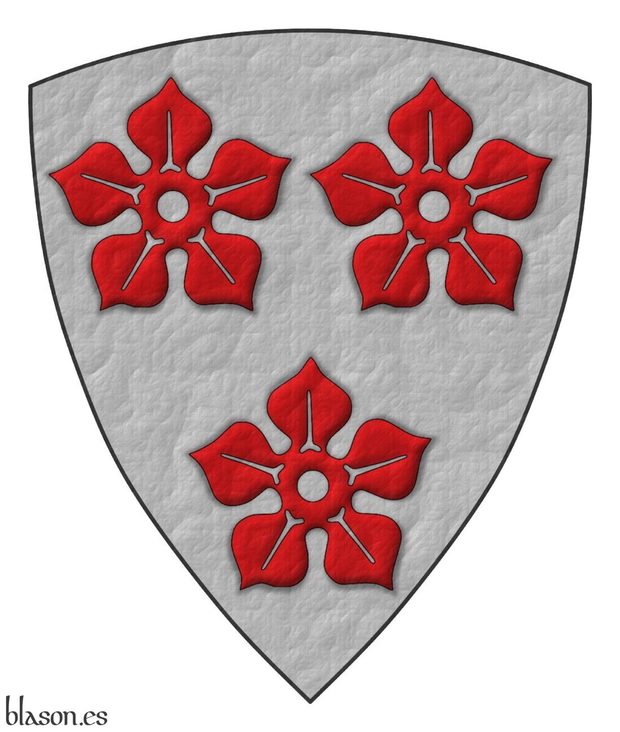
Norman de Darcy ~ Norman Darcy ~ Norman de Arci.
Argent, three cinquefoils Gules.
Escudo de plata, tres quinquefolios de gules.
Included in [Vincent, MS; 1285; number 230] also known as [St. George's Roll; 1285; number 230].
Blazon keywords: Without divisions, Argent, Three, Cinquefoil, Gules and Ordered.
Style keywords: Triangular curved, Illuminated, Shaded, Outlined in sable and Fabric.
Classification: Interpreted and Personal.
Bearer: Norman de Darcy.


Open chevron
Delineation, ratios and angles of an open chevron.
Blazon keywords: Without divisions and Chevron.
Style keywords: Semi-circular.
Classification: Schema.
Bearer: Howel Ap Rhys.


![Ver [Pedro IV de Aragón; 1353] en referencias bibliográficas. Libro abierto, hojas de plata, filo de oro, guardas de gules, tapas de sable.](../css/Libro.Bibliografia.png)
Pedro IV de Aragón; 1353
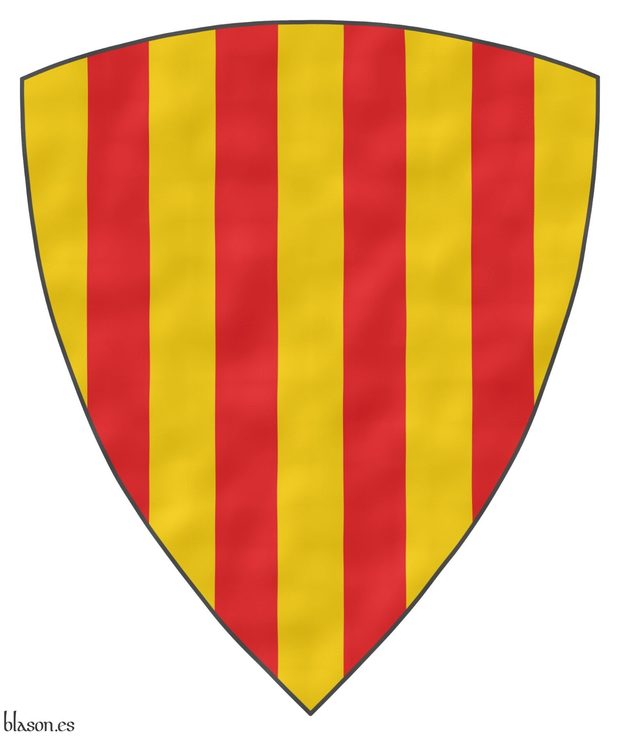
Pedro IV of Aragon, also known as Pedro III of Aragon as he himself called, «Ordinance made by the very high and excellent Prince and Lord Lord Don Pedro the third King of Aragon, on the manner in which the Kings of Aragon will be consecrated and they themselves will be crowned», in the Royal Aragonese Chancery, 1353.
Bibliographical reference of century XIV.
Author: Pedro IV de Aragón.
Bibliographical reference mentioned in the following article:
External link:


Peter IV of Aragon

And II of Valencia and of Ampurias, I of Mallorca and Sardinia, and III of Barcelona.
Or, four pallets Gules.
Escudo de oro, cuatro palos de gules.
Coat of arms of this king of Aragon interpreted by me as follows: the escutcheon shape is curved triangular; the field and the 4 pallets are rendered in flat tinctures Or and Gules; and the whole shield has a watercolored finish.
This curved triangular shape of the escutcheon is inspired by the shield shown in the lower central part of a document issued by the king himself [Pedro IV de Aragón; 1353].
Blazon keywords: Without divisions, Or, Four, Pale and Gules.
Style keywords: Triangular curved, Illuminated and Watercolor.
Classification: Interpreted, Personal, Coat of arms and Kingdom of Aragon.
Bearer: Peter IV of Aragon.


Philip III of France
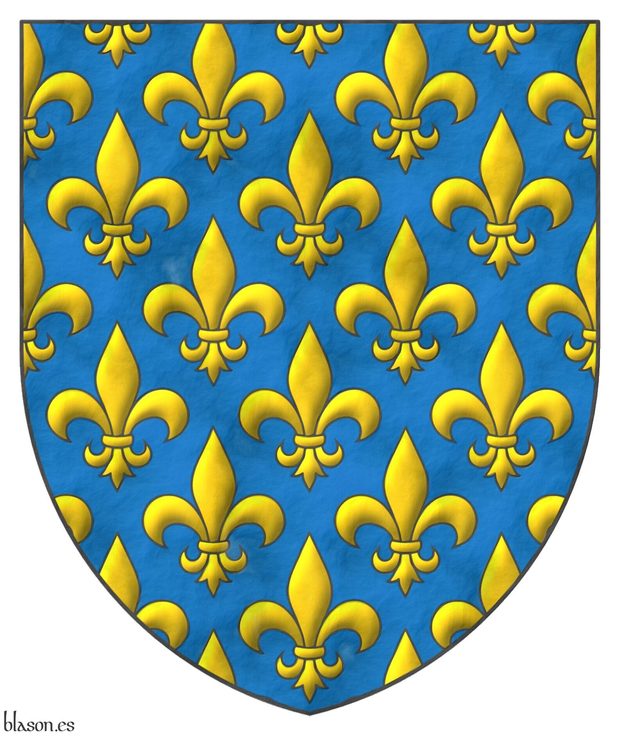
King of France from 1270 to 1285, grandson of Blanche of Castile.
Azure semé of fleurs de lis Or.
Escudo de Azur sembrado de flores de lis de oro.
Coat of arms interpreted with: a pointed base; the field enamelled in flat Azure; the fleurs-de-lis illuminated in Or and outlined in Sable; and finished with a parchment effect.
During his reign, it is believed that the second part of the armorial [Wijnbergen; 1265] was completed, which ends with the coats of arms of several kings, many of them European, beginning this series with the coat of arms of the King of France himself, [Wijnbergen; 1265; shield no. 1,288], which has served as the inspiration for the one recreated here.
Blazon keywords: Without divisions, Azure, Or, Semé and Fleur de lis.
Style keywords: Pointed, Illuminated, Outlined in sable and Parchment.
Classification: Interpreted, Personal, Coat of arms, Kingdom of France and House of the Capetians.
Bearer: Philip III of France.


Pius V
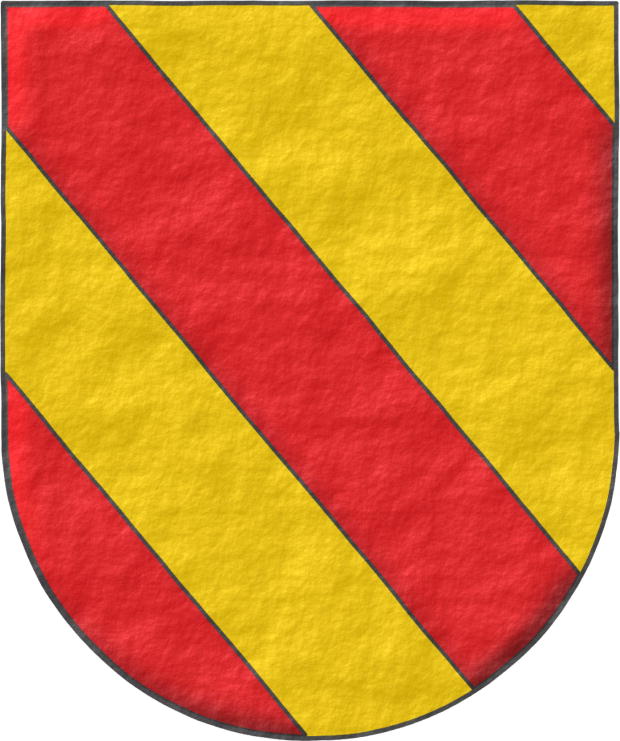
225th Pope of the Church, from 1566 to 1572. «Pius V», named Antonio Michele Ghislieri, was canonized in 1712.
Bendy of six Gules and Or.
Escudo bandado de seis piezas de gules y oro.
Papal coat of arms interpreted with: a rounded mouth; the field in flat tincture of Or; the bands outlined in Sable and illuminated in Gules; and the whole with a rough finish.
I have also seen this coat of arms described as «a shield banded of six pieces of Or and Gules».
Blazon keywords: Without divisions, Bendy, Six, Gules and Or.
Style keywords: Semi-circular, Illuminated, Outlined in sable and Rough.
Classification: Interpreted, Religious and Papal States.
Bearer: Pius V.


Portugal
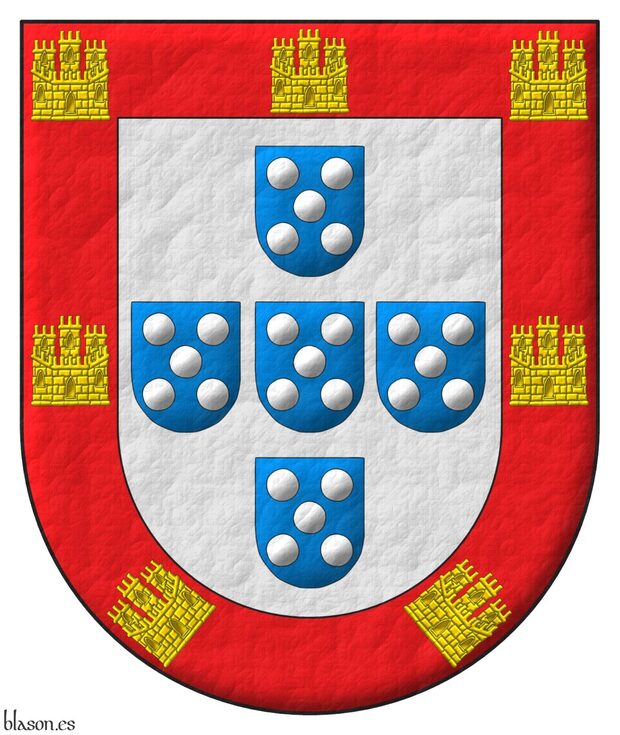
Argent, five escutcheons in cross Azure, each charged with five plates in saltire; a bordure Gules, charged with seven castles triple-towered Or, 3, 2, and 2
Escudo de plata, cinco escudetes en cruz de azur, cada uno cargado de cinco bezantes en sotuer de plata; una bordura de gules, cargada de siete castillos de oro, tres en jefe, uno en cada flanco y dos en punta
Illuminated and a leather finishing.
This coat of arms can be seen in [Avilés, T. de; XVI; página 16], [Bergshammars; 1440; page 4], [Lutzelbourg, N. de; 1530; page 37], and in [Gourdon de Genouillac, H.; 1889; page 247].
Blazon keywords: Without divisions, Argent, Five, Escutcheon, In cross, Azure, Charged, Bezant and plate, Plate, In saltire, Bordure, Gules, Seven, Castle, Or, Three, In chief, One, In each flank and In base.
Style keywords: Leather, Outlined in sable, Illuminated and Semi-circular.
Classification: Civic, Interpreted and Kingdom of Portugal.
Bearer: Portugal.


Poumola, lineage of Catalonia
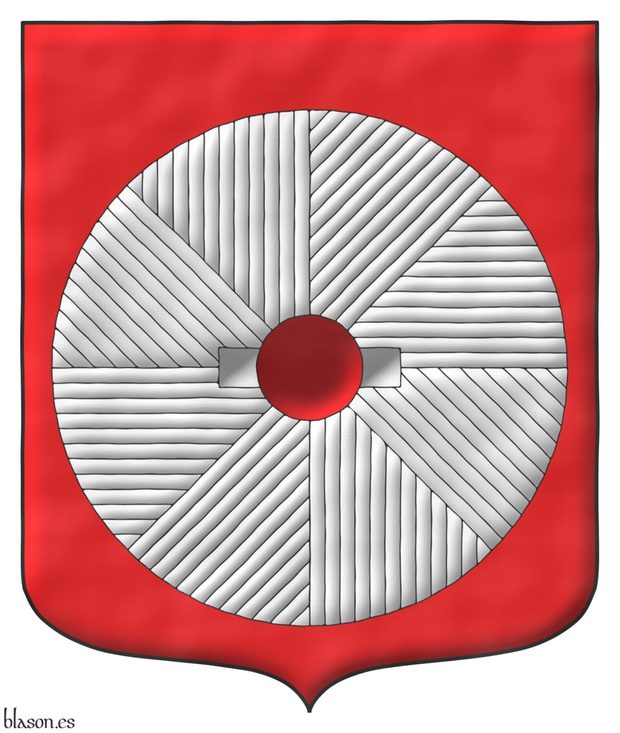
Blazon of the Poumola lineage of Catalonia.
Gules, a millstone Argent.
Escudo de gules, una piedra de molino de plata.
Illuminated and a watercolor finishing with shadow in the hole.
It blazon is describe in [Cadenas y Vicent, V. de; 1987; page 1429], [García Carraffa, A.; García Carraffa, A.; 1968; volume 3, page 358], and [Ferrer i Vives, F.; 1995; volume 2, page 362].
In this case, my theory is that this coat of arms is an example of «canting arms». «Canting arms» use a word or words of the surname or inside the surname to make the coat of arms. The surname Poumola is from Catalonia, we can split the surname into 2 parts «pou-mola», in Catalonian language a) «pou» means «well» and b) «mola» means «millstone» ~ «cadascuna de les dues pedres de forma circular que componen el molí», [GDLC; 1998], and this could be the reason of the symbolism of this coat of arms. «Canting» in heraldry means «talking» or «chatting», in Spanish «canting arms» is translated as «armas parlantes». Some heralds call «canting» to this creative technic.
Blazon keywords: Without divisions, Gules, One, Millstone and Argent.
Style keywords: Watercolor, Outlined in sable, Illuminated and Ogee.
Classification: Interpreted, Lineage and Canting.


Qasqante of Navarre
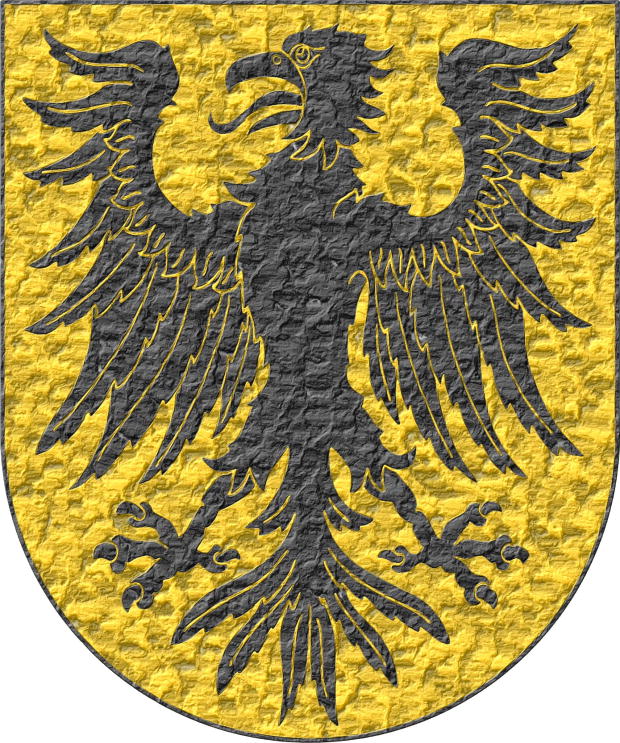
Of the twelve lineages of Noblemen, the tenth is that of Qasqante; they bear as arms a shield Or and, on the shield, an eagle Sable, which is black, as it is now painted.
Or, an Eagle displayed Sable.
Escudo de oro, un águila de sable.
Coat of arms interpreted with: a semicircular (round) base; the field in flat Or; the eagle outlined in the colour of the field and illuminated in Sable; and finished in highly-hammered metal.
Based on the tenth coat of arms of the Navarrese «ricoshombres» from [Bosque, J. del; 1540; folio 1 of the numbering of 1613] and the text is from the transcription made by [Martinena Ruiz, J. J.; 1982; pages 122 and 123].
Under the title «Surname of Cascante» it can also be consulted in [Vega, P. J. de; 1702; folio 10 of the manuscript].
Blazon keywords: Without divisions, Or, Eagle and Sable.
Style keywords: Semi-circular, Illuminated, Outlined in the field tincture and Hard metal.
Classification: Interpreted, Personal and Kingdom of Navarre.
Bearer: Qasqante of Navarre.


![Ver [Rabbow, A.; 1999] en referencias bibliográficas. Libro abierto, hojas de plata, filo de oro, guardas de gules, tapas de sable.](../css/Libro.Bibliografia.png)
Rabbow, A.; 1999
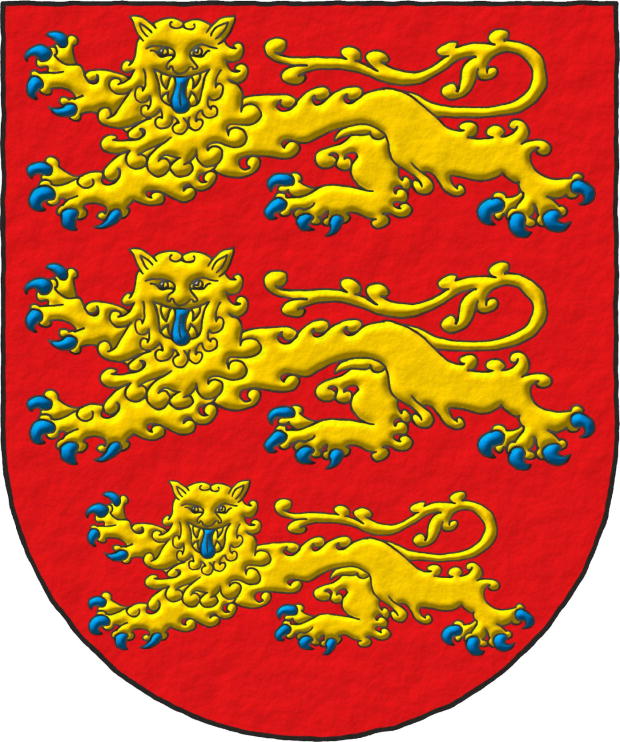
Arnold Rabbow, «The Origin of the Royal Arms of England - a European Connection», Coat of Arms, COA, An Heraldic Quarterly Magazine, número 186, The Heraldry Society, Baldock, Hertfordshire, verano de 1999.
This bibliographical reference is illustrated wit the coat of arms of the Kingdom of England interpreted by me with the with a semi-circle shape.
Bibliographical reference of century XX.
The author is Rabbow, Arnold.
The following article cites this bibliographic reference:
External link:
Internal resources: RabbowA1999.OriginRoyalArmsEnglandEuropeanConnection.docx.


Rada of Navarre
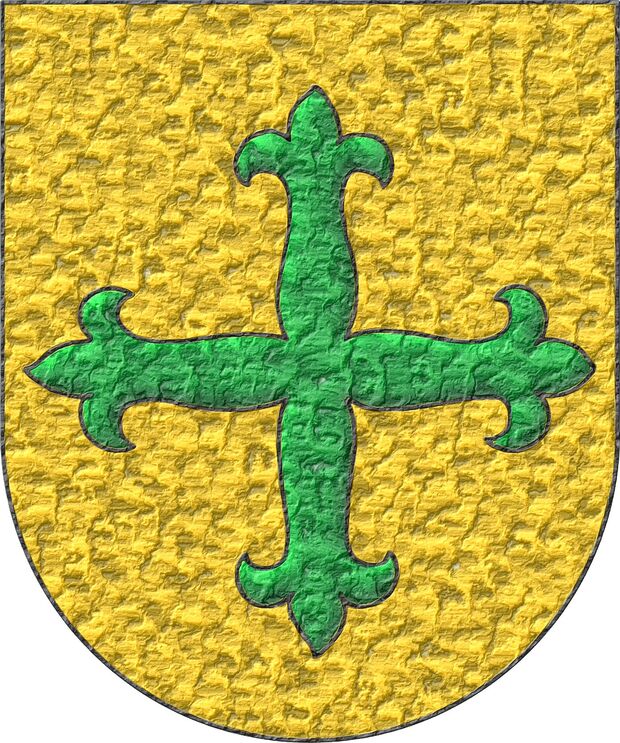
Of the twelve lineages of Noblemen, the eighth is that of Rada; they bear as arms a shield Or with a flory cross Vert, in the same manner as painted in this shield.
Or, a Cross flory Sinople.
Escudo de oro, una cruz flordelisada de sinople.
Coat of arms interpreted with: a semicircular (round) base; the field in flat Or; the flory cross outlined in Sable and illuminated in Vert enamel; and finished in highly-hammered metal.
Based on the eighth coat of arms of the Navarrese «ricoshombres» from [Bosque, J. del; 1540; folio 1 of the numbering of 1613] and the text is from the transcription made by [Martinena Ruiz, J. J.; 1982; pages 122 and 123].
Under the title «Surname of Rada» it can also be consulted in [Vega, P. J. de; 1702; folio 8 of the manuscript].
Blazon keywords: Without divisions, Or, Cross flory, Cross couped and Vert.
Style keywords: Semi-circular, Illuminated, Outlined in sable and Hard metal.
Classification: Interpreted, Personal and Kingdom of Navarre.
Bearer: Rada of Navarre.


Rage from Discord, first version
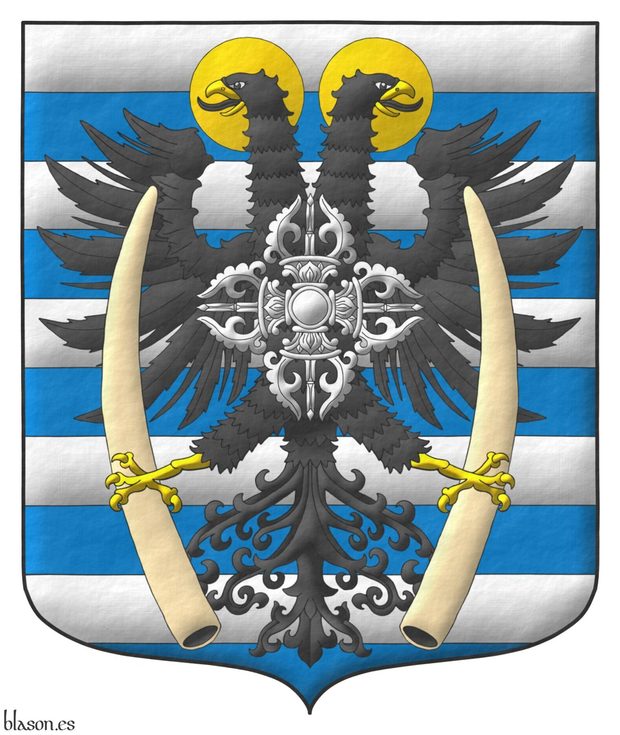
Barry of ten Argent and Azure, overall a double-headed eagle displayed Sable, nimbed, beaked, and membered Or, grasping in each claw an elephant's tusk proper, and charged on its breast with a double vajra Argent.
Escudo fajado de diez piezas de plata y azur, brochante sobre el todo un águila bicéfala de Sable, nimbada, picada y membrada de oro, teniendo en cada garra un colmillo de elefante al natural y su pecho cargado de una vajra doble.
Coat of arms interpreted and emblazoned by me with different shapes and finishings.
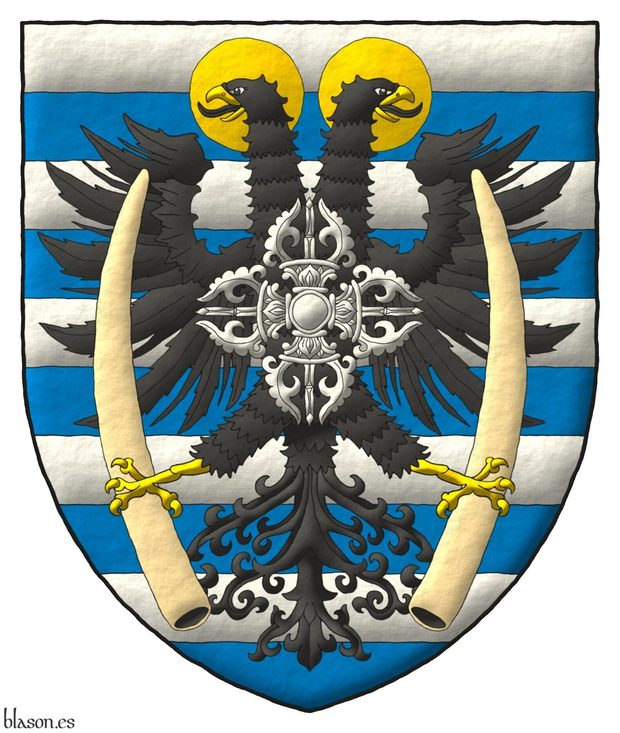
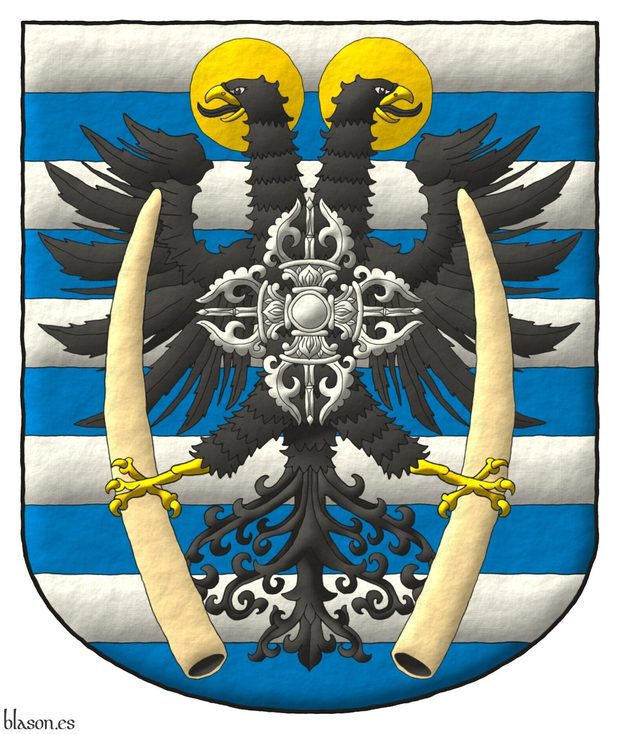
Blazon keywords: Without divisions, Barry, Ten, Argent, Azure, Overall, One, Eagle, Double-headed, Sable, Nimbed, Beaked, Membered, Or, Grasping, Claw, Tusk, Elephant, Proper, Chest, Charged and Double vajra.
Style keywords: Outlined in sable, Illuminated, Freehand, Rough, Rounded, Ogee and Pointed.
Classification: Interpreted and Coat of arms.
Bearer: Rage from Discord.


Ramon Berenguer IV, Count of Barcelona
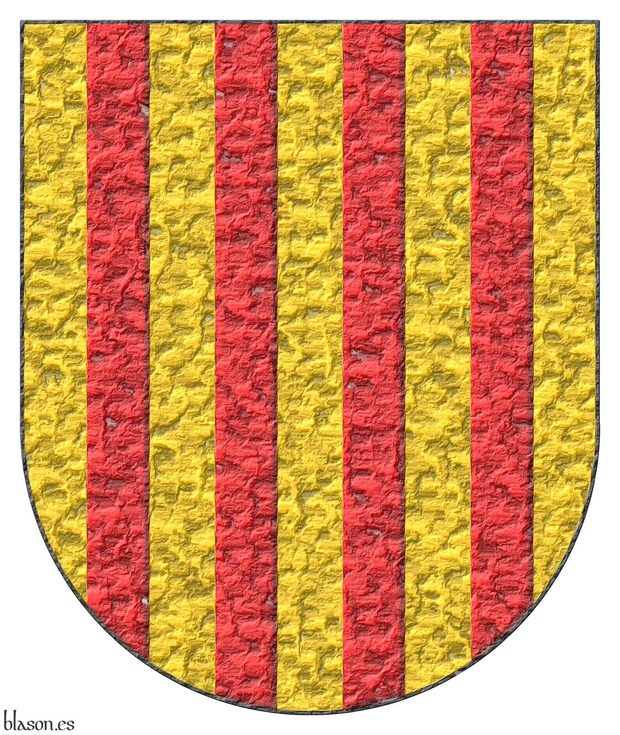
Or, four pallets Gules.
Escudo de oro, cuatro palos de gules.
Coat of arms of the Count of Barcelona interpreted by me with the following features: the escutcheon shape is semicircular; the field is rendered in flat Or; the pallets are illuminated; and the whole has been given a heavily beaten metal finish.
[Menéndez Pidal de Navascués, F.; 1988; page 537] tells us that, unlike other more territorial emblems, «from his earliest seal the pallets appear on the shield of the equestrian figures on both sides, and in line with this configuration the emblem is inherited, without distinction, by his three sons and all his grandsons... it seems one must conclude that the emblem had a familial, not territorial, character from the very beginning».
Blazon keywords: Without divisions, Or, Four, Pale and Gules.
Style keywords: Semi-circular, Illuminated and Hard metal.
Classification: Interpreted, Personal, Coat of arms and County of Barcelona.
Bearer: Ramon Berenguer IV, Count of Barcelona.


Ricardo de Mandeville, fretty illuminated
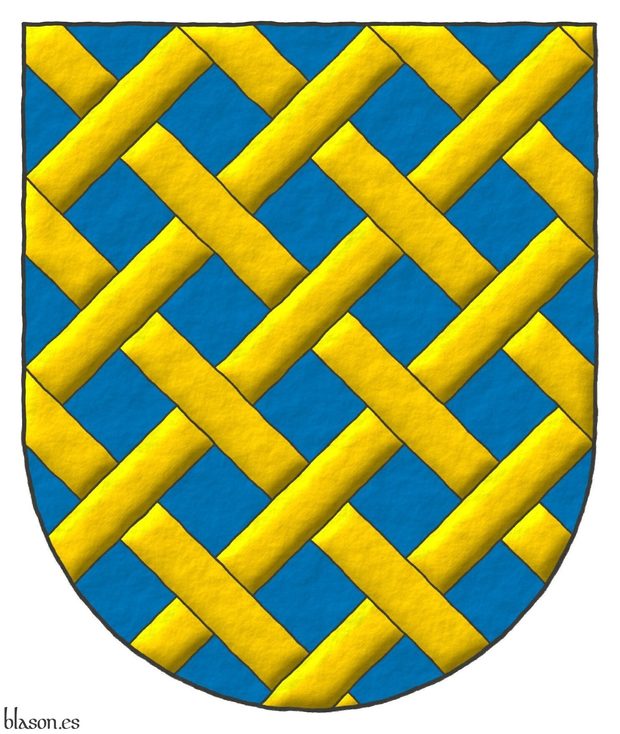
fretty ~ fretté.
Azure fretty Or.
Escudo de azur fretado de oro.
Blazon keywords: Without divisions, Azure, Fretty and Or.
Style keywords: Semi-circular, Illuminated, Outlined in sable and Freehand.
Classification: Interpreted and Personal.
Bearer: Ricardo de Mandeville.


Richard I of England
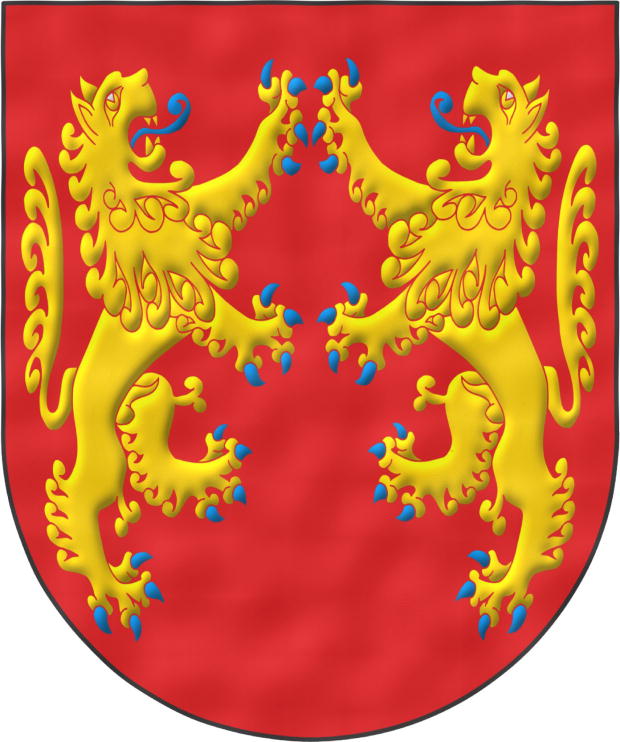
Lionheart ~ Corazón de León ~ Cœur de Lion.
Escudo de gules, dos leones de oro, afrontados, armados y lampasados de azur.
Coat of arms interpreted as follows: the mouth drawn as a semicircular (round) base; the field enamelled in a flat tint of Gules; the two lions outlined in the colour of the field and illuminated in Or and Azure; and the whole finished with a watercolour effect.
He was born in 1157, being the third of eight children of Henry II of England and Eleanor of Aquitaine, elder brother of Eleanor Plantagenet. He was king of England between 1189 and 1199, although he spent much of his life far from it; in fact, during his ten-year reign, he was on English soil only twice, which together did not amount even to six months. He died in 1199 in Normandy.
In 1198, during the Battle of Gisors, he supposedly used, as watchword or as motto, the expression «Dieu et mon Droit ~ God and my right». This phrase refers to his refusal to bow before Emperor Henry VI, since by his rank Richard acknowledged only God as superior. Later, Henry V of England adopted it as his motto, and since then it has been used by the British monarchy.
According to [Humphery-Smith, C.; 1983], Richard the Lionheart was the first English king who can be proved to have borne arms, although some of his predecessors may also have had them. He bases his statement on the existence of two seals of Richard I: on one, Richard bears a shield with a rampant lion, and on the other there already appear the three lions that are the forerunners of the arms of England. The use of this second seal does not imply that he stopped using the first.
In contrast, there are also British authors who maintain that his shield actually bore two affronted lions; this hypothesis is based on the lion on his first seal facing to sinister. That latter hypothesis is the one interpreted in this shield, remaining a purely artistic interpretation and without my entering into a complex and open discussion about how, when, and why the three leopards, «leones pasantes ~ lions passant» for the English, appeared —a discussion in which there are various alternatives— ranging from the combination of his hereditary arms to the wish to have more lions than his younger brother, who would later be King John I of England, to possible influences from other European realms.
This version of Richard I’s shield is similar to the imaginary shield of Hector of Troy, Gules with two lions Or affronté, which is a term used when «two things are placed facing each other, like two Lions, two Dogs, or other animals that look at one another» [Avilés, J.; 1725a; page 32].
Blazon keywords: Without divisions, Gules, Lion, Or, Combatant, Armed, Langued and Azure.
Style keywords: Semi-circular, Illuminated, Outlined in sable and Freehand.
Classification: Interpreted, Personal, Coat of arms, House of Plantagenet and Kingdom of England.
Bearer: Richard I of England.


Robert de Malet
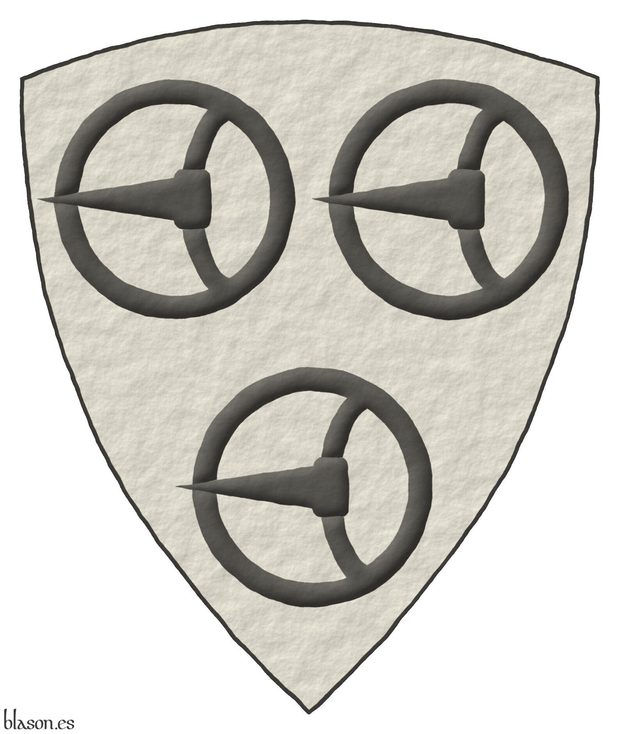
Roberto de Malet ~ Robert de Malet
Argent, three buckles Sable.
Escudo de plata, tres hebillas de sable.
Included in [Vincent, MS; 1285; number 595] also known as [St. George's Roll; 1285; number 595].
Blazon keywords: Without divisions, Argent, Three, Buckle, Sable and Ordered.
Style keywords: Triangular curved, Illuminated and Freehand.
Classification: Interpreted and Personal.
Bearer: Roberto de Malet.


Roger de Flor
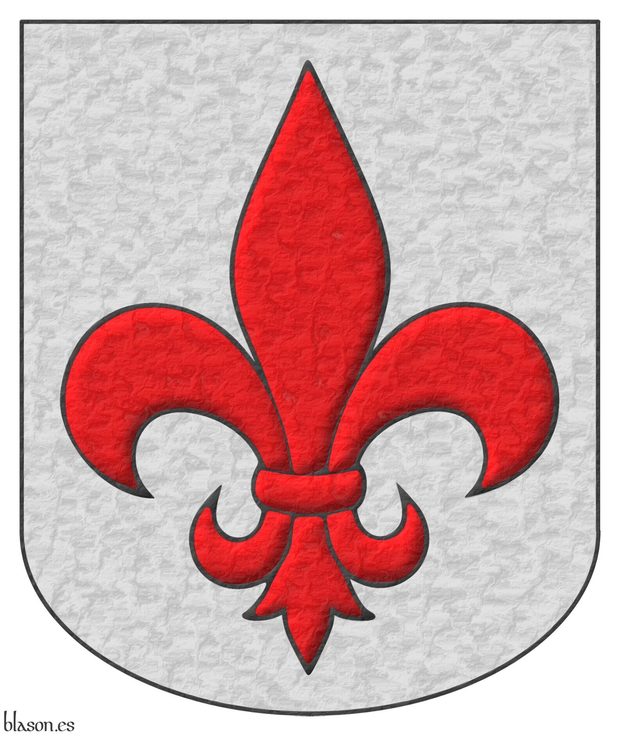
The 1st Flag of the Spanish Army Paratrooper Brigade bears his name and his coat of arms.
Argent, a fleur de lis Gules.
Escudo de plata, una flor de lis de gules.
Coat of arms interpreted with: a rounded base; a fleur de lis illuminated in Gules and outlined in Sable; and an overall lightly-hammered metal finish.
Blazon keywords: Without divisions, Argent, Gules and Fleur de lis.
Style keywords: Rounded, Illuminated, Outlined in sable and Soft metal.
Classification: Interpreted, Personal, Army and Navy and Coat of arms.
Bearer: Flor, Roger de.


Roger de Lauria
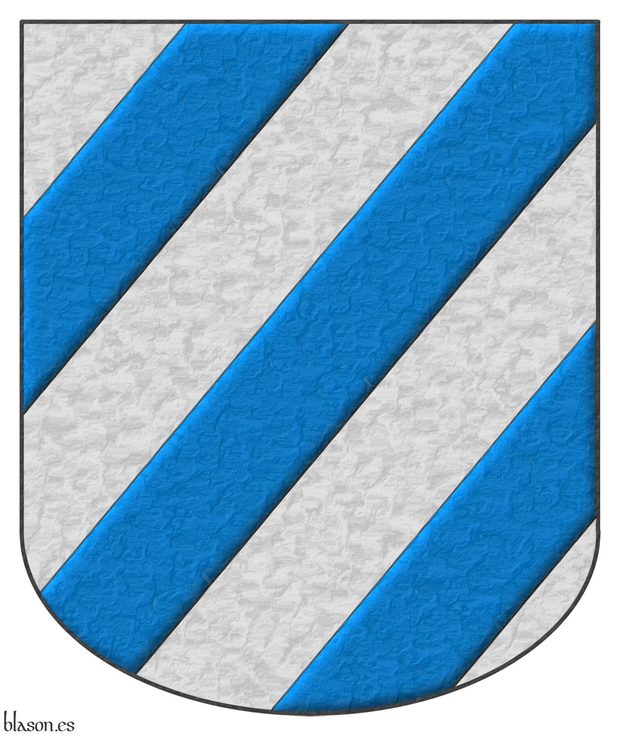
The 2nd Battalion of the Parachute Brigade of the Spanish Army bears its name and its coat of arms.
Argent, three bendlets sinister Azure.
Escudo de plata, tres barras de azur.
For the interpretation of this coat of arms, I have used: a rounded mouth; the angle I use most often, for example in bends, bendlets, bends sinister, or bendlets sinister, which is 50.2o, resulting from calculating the arctangent of 6/5, that is, the opposite side 6 divided by the adjacent side 5; with a division of the main diagonal into 7 equal parts, resulting from crossing this diagonal with the 6 lines that will form the edges of the 3 bend sinisters; and for the whole, a finish of lightly hammered metal.
Blazon keywords: Without divisions, Argent, Azure and Bend sinister.
Style keywords: Rounded, Illuminated, Outlined in sable and Soft metal.
Classification: Interpreted, Personal and Army and Navy.
Bearer: Lauria, Roger de.


Royal Spanish Academy, coat of arms
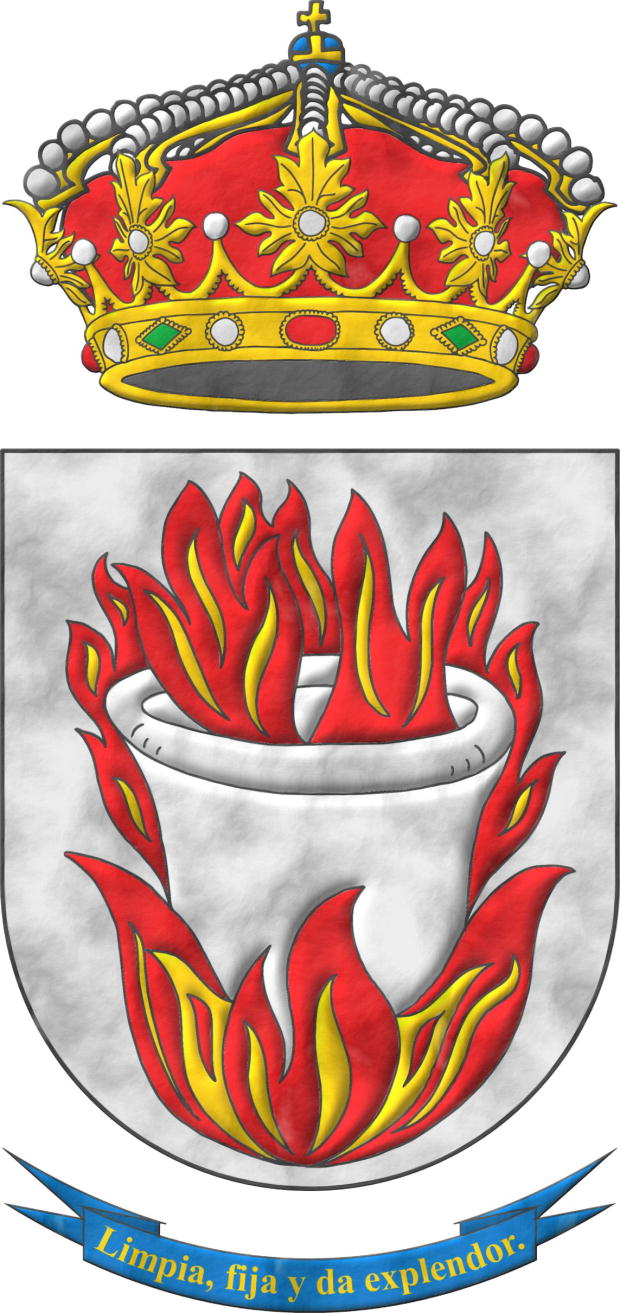
Argent, a crucible Argent, enflamed and on a bonfire hoguera Gules and Or. Crest: A closed royal crown Or, with eight arches, visible five. Motto: «Limpia, fixa, y da esplendor» Or over a scroll Azure.
Escudo de plata, un crisol de plata, llameante y sumado a una hoguera de gules y oro. Timbrado de una corona real cerrada. Lema: «Limpia, fixa, y da esplendor» de oro sobre una filacteria de azur.
Interpretation made from the Royal Academy emblem: transforming it into a semicircular-based shield, instead of its oval shape; with its motto on a scroll beneath the base, instead of surrounding it; keeping the closed royal crown in its place; with everything illuminated except the field which is in plain color; and the whole outlined in sable and with a parchment-like finish.
In this interpretation, on the Argent field, the Gules fire of the bonfire completely surrounds the Argent crucible, to avoid the metal Argent on the same.
To write the blazon for this coat of arms I use the heraldic term «llameante». Therefore, I do not follow [Avilés, J.; 1780a; page 82 and figure 163] when he writes «...y un Fénix de gules sobre una hoguera encendida de lo mismo.». He uses this example to illustrate the 2 fundamental uses of the term «encendido» which is said when «the Eyes of animals... are of a different color» and «also of a burning Bush and the same for a Torch, when the flame is of a different tincture».
Blazon keywords: Without divisions, Argent, One, Crucible, Enflamed, Bonfire, Gules, Or, Closed royal crown, Crown, Motto, Scroll and Azure.
Style keywords: Semi-circular, Illuminated, Outlined in sable and Parchment.
Classification: Interpreted, Socioeconomic and Coat of arms.
Bearer: Royal Spanish Academy.


![Ver [Royal Spanish Academy; 2001] en referencias bibliográficas. Libro abierto, hojas de plata, filo de oro, guardas de gules, tapas de sable.](../css/Libro.Bibliografia.png)
Royal Spanish Academy; 2001

Real Academia Española, «Diccionario de la lengua española», known as DRAE, acronym for Diccionario de la Real Academia Española, 22nd edition, Espasa Calpe, Madrid, 2001.
The DRAE's latest edition, the 23rd, is from October 2014, but the current online version corresponds to the 22nd edition with amendments incorporated until 2012.
This bibliographic reference is illustrated with one of my interpretations of the emblem of the Real Academia Española, with its crucible over a bonfire and its motto around it.
Bibliographical reference of century XXI.
Classification: Dictionary and Castilian language.
The author is Royal Spanish Academy.
Bibliographical reference mentioned in the following article:
External resource:


![Ver [Royal Spanish Academy; 2014] en referencias bibliográficas. Libro abierto, hojas de plata, filo de oro, guardas de gules, tapas de sable.](../css/Libro.Bibliografia.png)
Royal Spanish Academy; 2014
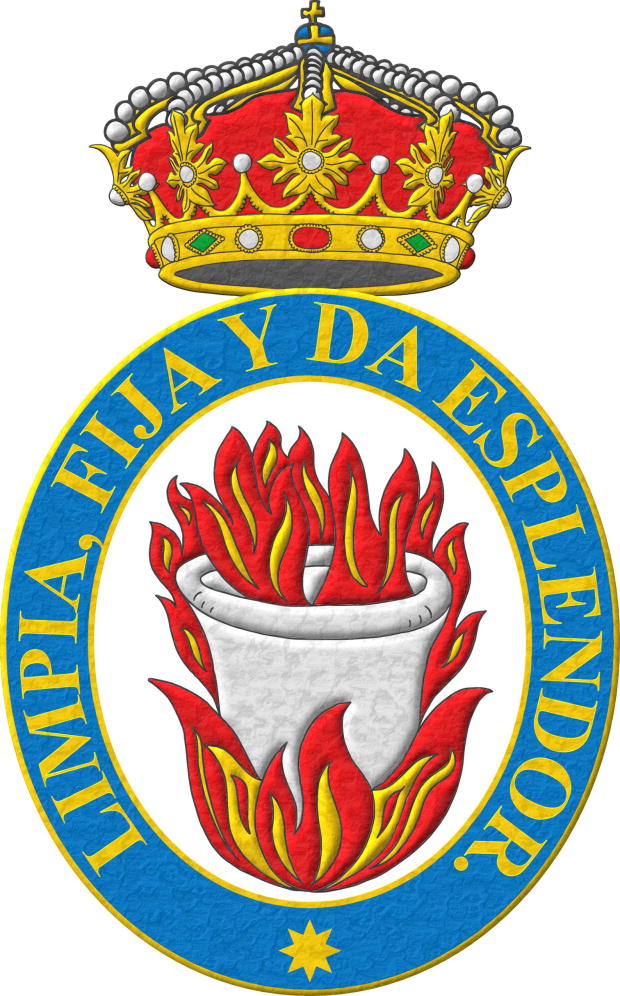
Real Academia Española, «Diccionario de la lengua española», known as DRAE, acronym for Diccionario de la Real Academia Española, 23rd edition, Espasa Calpe, Madrid, 2014.
This bibliographic reference of the DRAE is illustrated with one of my interpretations of the emblem of the Real Academia Española. Oval emblem with its crucible over a bonfire, surmounted by a closed Royal crown and its motto «Limpia, fija y da esplendor», around the emblem in letters of Or on Azure.
Bibliographical reference of century XXI.
Classification: Dictionary and Castilian language.
The author is Royal Spanish Academy.
Bibliographical reference mentioned in the following article:
External resource:


Rubén González Lara
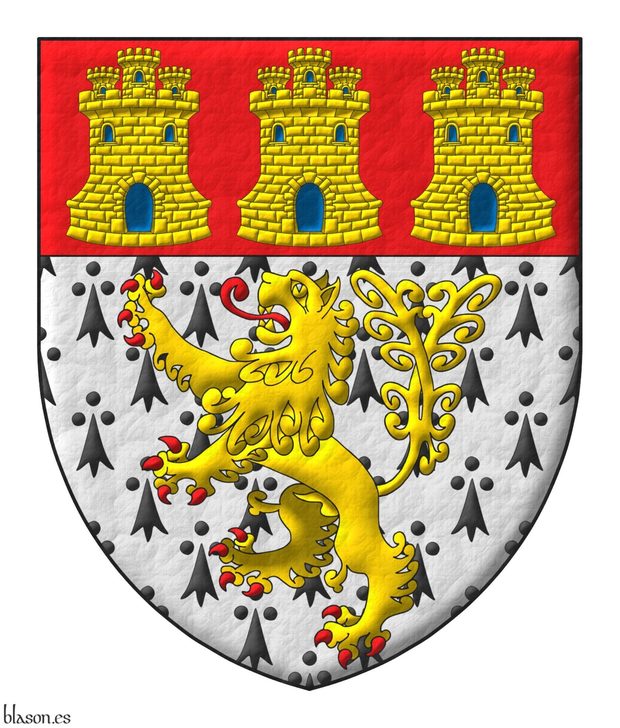
Ermine, a lion rampant double queued Or, armed and langued Gules; a chief Gules, three castles triple-towered Or, port and windows Azure, masoned Sable.
Coat of arms emblazoned by me with a heater shape that I call pointed, illuminated, and its finishing is that seems leather.
Blazon keywords: Without divisions, Ermine, One, Lion, Rampant, Tail, Double queued, Or, Armed, Langued, Gules, Chief, Three, Castle, Port and windows, Azure, Masoned and Sable.
Style keywords: Pointed, Outlined in sable, Illuminated and Leather.
Classification: Personal, Interpreted and Coat of arms.
Bearer: González Lara, Rubén.


![Ver [Rylands, J. P.; 1882] en referencias bibliográficas. Libro abierto, hojas de plata, filo de oro, guardas de gules, tapas de sable.](../css/Libro.Bibliografia.png)
Rylands, J. P.; 1882
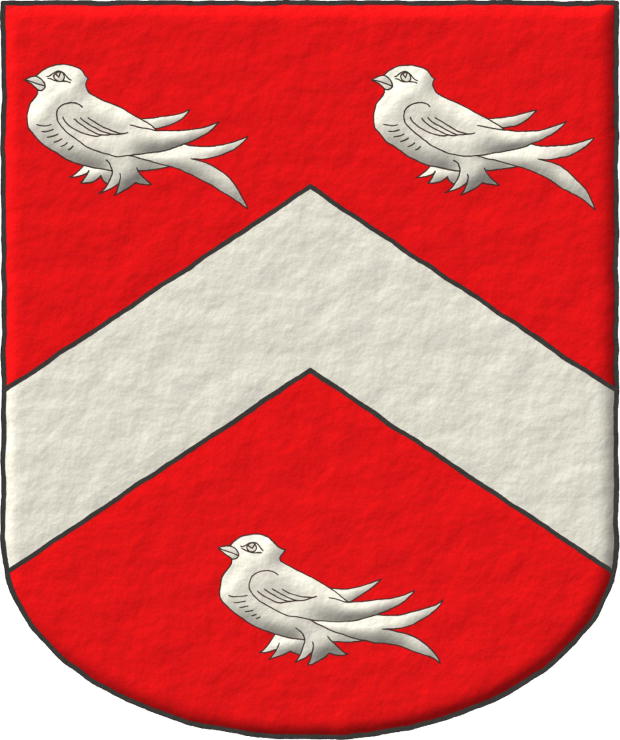
John Paul Rylands, «The Visitation of Cheshire in the Year 1580, Made by Robert Glover, Somerset Herald, for William Flower, Norroy King of Arms, with Numerous Additions and Continuations, Including those from The Visitation of Cheshire in the Year 1566, by the same Herald, with an Appendix Containing The Visitation of a Part of Cheshire in the Year 1533, William Fellows, Lancaster Herald, for Thomas Benolte, Clarenceux King Of Arms, And a Fragment of The Visitation of the City of Chester in the Year 1591, Made by Thomas Chaloner, Deputy to the Office Of Arms», edited by John Paul Rylands, F. S. A., published by The Harleian Society, London, 1882.
[Goldstraw, M. S. J.; 2013a] es una recreación a color de los escudos registrados en este libro.
El escudo que ilustra esta referencia bibliográfica es uno de los que se registran en este libro y corresponde al escudo de Tatton de Wythenshawe, con la diferencia que aquí no se ha incluido su timbre.
Bibliographical reference of century XIX.
Author: Rylands, John Paul.
The following article cites this bibliographic reference:


Satellite
My heraldic channel on Satellite was https://satellite.earth/@as, but sadly, this social network didn't evolve properly.
Categories: Technology, Social networks, Without divisions, Argent, Five, Escutcheon, In cross, Azure, Charged, Bezant and plate, Plate, In saltire, Bordure, Gules, Seven, Castle, Or, Two, In chief, One, In each flank, Three, In base, Crown of Marquis and Crown.


Savoy, Duchy of
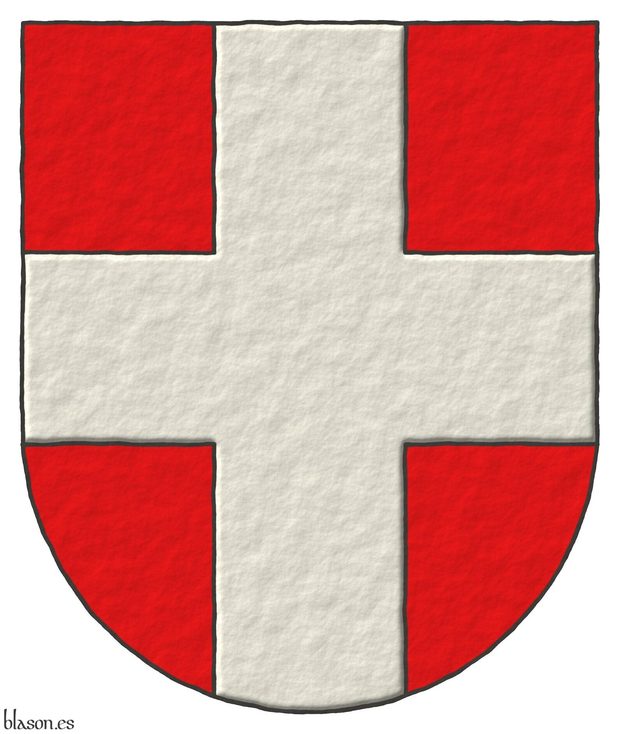
Gules, a cross Argent.
Escudo de gules, una cruz de plata.
Coat of arms of the House of Savoy and the Duchy of Savoy, which I have interpreted as follows: the shield has a semicircular (round) base; the field is illuminated in flat tincture Gules; the cross is illuminated in Argent; and the whole coat of arms is rendered with a raised-stroke effect.
This coat of arms is both familial and political, for it is also the coat of arms of the French departments of Savoy and Haute-Savoie, both belonging to the Rhône-Alpes region.
The cross in this shield is an honourable ordinary, for it is a full cross, the result of combining a fess and a pale. This full cross is wide and reaches the edges of the shield and is therefore large enough to bear charges. For this reason these ordinaries are called “honourable,” because they may be honoured with additional charges. In English heraldry they are known as «ordinaries», [The Heraldry Society; 2013; page 11].
This coat of arms is recorded in the armorial [Marshal, L.; 1295; shield number 32] together with the text «Le Counte de Sauveys, Gules a cross argent, Amadeus V, Comte de Savoie».
Blazon keywords: Without divisions, Gules, Argent and Cross.
Style keywords: Semi-circular, Illuminated and Freehand.
Classification: Interpreted, Personal, Coat of arms and House of Savoy.
Bearer: Savoy, Duchy of.


Schema of a bordure and a diminished bordure
Proporciones de una bordura y una filiera, una filiera es una bordura con su ancho disminuido en 2/3.
In heraldry, a diminished bordure is a diminished bordure. In the design, it is typically drawn at 2/3 the width of a standard bordure. Since the width of a standard bordure is usually 1/6 of the coat of arms' width, a diminished bordure calculated this way would be 1/9 of the coat of arms' width.
However, diminished bordures can also be found with a width of 1/2 that of a standard bordure, in other words, 1/12 of the coat of arms' width, or 1/3 that of a standard bordure, that is to say, 1/18 of the coat of arms's width.
The so-called bordure of pieces usually has a width of 1/2 that of a standard bordure, which is 1/12 of the coat of arms's width.
Blazon keywords: Without divisions, Bordure and Diminished bordure.
Style keywords: Semi-circular.
Classification: Schema and Coat of arms.
Bearer: Categories of heraldry.


Scheme of a bend and a bend sinister
Proportions and angle of a bend and a bend sinister.
The proportion of a coat of arms is 5/6,
- with 5 being the base, the so-called adjacent side, b in the diagram, and
- with 6 being the height, the so-called opposite side, h in the diagram.
The tangent of the angle between the base of the shield and the diagonal of the bend is calculated as the opposite side divided by the adjacent side, that is, 6 divided by 5 which is 1.2 = 6/5.
If I wish to know the angle, I must apply the inverse function of the tangent, which is the arctangent. Therefore, the angle is arctangent(6/5) = arctangent(1.2) = 50.194o, which in radians is 0.876, and I usually round it to 50.2o.
The complementary angle to 50.2o is 39.8o (90o - 50.2o = 39.8o), which is the angle formed between the diagonal of the bend sinister and the dexter side of the shield.
Depending on the artist, on his style or, in other cases, on the need to organize the space within the shield, angles of 45o can also be used, corresponding to the diagonal angle of a square.
Blazon keywords: Without divisions, Bend and Bend sinister.
Style keywords: Semi-circular.
Classification: Schema and Coat of arms.
Bearer: Zúñiga y Guzmán, Álvaro de.


Scheme with a pale and a cross
Proportions of the cross and its similarity with the pale.
This schema shows two coats of arms, the first with the proportion scheme of a pale, the second with the proportion scheme of a cross, and allows us to observe the common proportions between a pale and a cross.
Blazon keywords: Without divisions, Pale and Cross.
Style keywords: Semi-circular.
Classification: Schema and Coat of arms.
Bearer: Saboya, Ducado de.


![Ver [Scott-Giles, C. W.; 1965] en referencias bibliográficas. Libro abierto, hojas de plata, filo de oro, guardas de gules, tapas de sable.](../css/Libro.Bibliografia.png)
Scott-Giles, C. W.; 1965
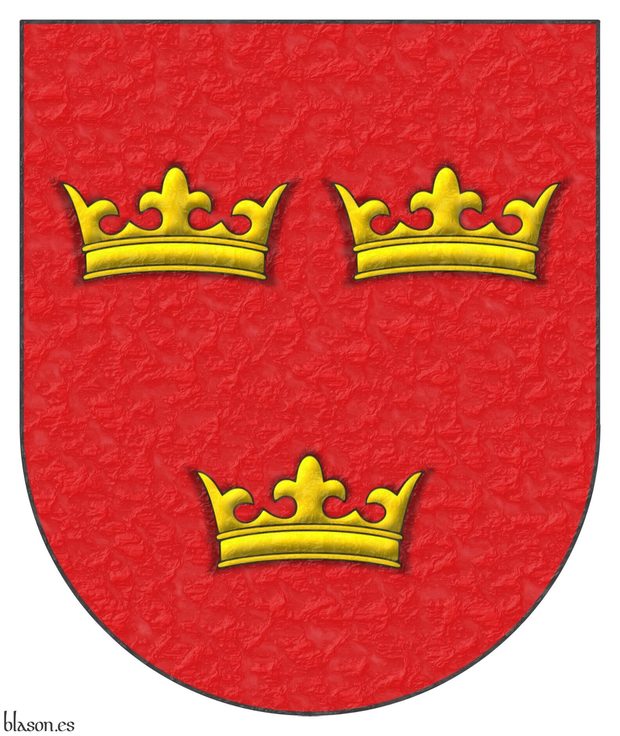
Charles Wilfred Scott-Giles, OBE (Officer of the Most Excellent Order of the British Empire), Fitzalan Pursuivant Extraordinary, «Some Arthurian Coats of Arms», Coat of Arms, COA, An Heraldic Quarterly Magazine, issue 64 of October 1965 (which is the date I use as reference) and issue 65 of January 1966, The Heraldry Society, Baldock, Hertfordshire, October 1965.
The coat of arms illustrating this bibliographic reference is one of the variants described in this article attributed to King Arthur, which in Blason.es is cataloged as Arthur of Britain.
Bibliographical reference of century XX.
The author is Scott-Giles, C. W..
The following articles cite this bibliographic reference:
External link:
Internal resources: ScottGilesCW1965.SomeArthurianCoA.docx.


![Ver [Shakespeare, W.; 1608] en referencias bibliográficas. Libro abierto, hojas de plata, filo de oro, guardas de gules, tapas de sable.](../css/Libro.Bibliografia.png)
Shakespeare, W.; 1608
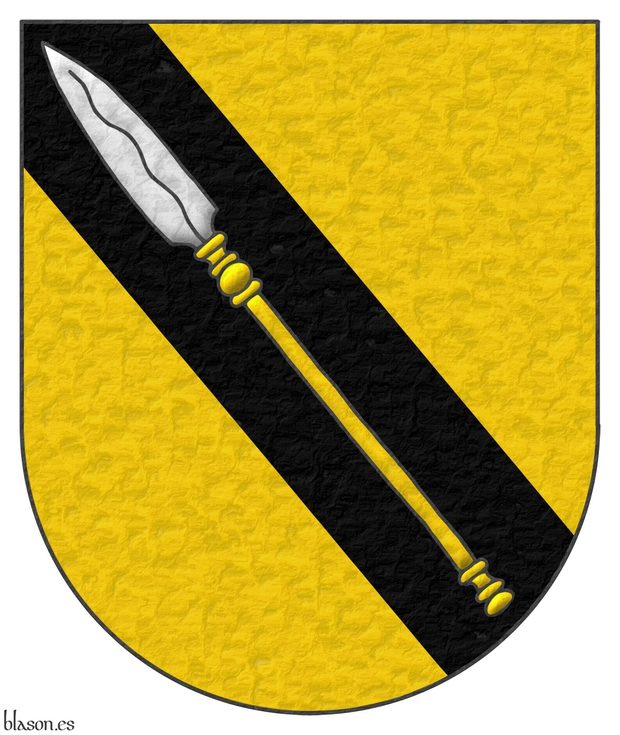
William Shakespeare, «Coriolanus», Tragedy in 5 acts and 29 scenes, written in verse, dated to either 1608 or 1609, depending on the sources.
It is one of the last works written by William Shakespeare, a tragedy based on the life of Caius Marcius Coriolanus, a legendary Roman general from the 5th century B.C. Some authors consider General Coriolanus to be a historical figure, while others do not.
Initially known only as Caius Marcius, during the war against the Volsci he becomes a hero by entering the city of Corioli with a few soldiers, and from then on, he is called Caius Marcius Coriolanus.
Act 3, Scene 2, Volumnia, mother of Coriolanus
I prithee now, my son,
Go to them, with this bonnet in thy hand;
And thus far having stretch'd it (here be with them)
Thy knee bussing the stones (for in such business
Action is eloquence, and the eyes of the ignorant
More learned than the ears) waving thy head,
Which often, thus, correcting thy stout heart,
Now humble as the ripest mulberry
That will not hold the handling: or say to them,
Thou art their soldier, and being bred in broils
Hast not the soft way which, thou dost confess,
Were fit for thee to use as they to claim,
In asking their good loves, but thou wilt frame
Thyself, forsooth, hereafter theirs, so far
As thou hast power and person.
Bibliographical reference of century XVII.
Author: Shakespeare, William.
External resource:


Simon de Crombe
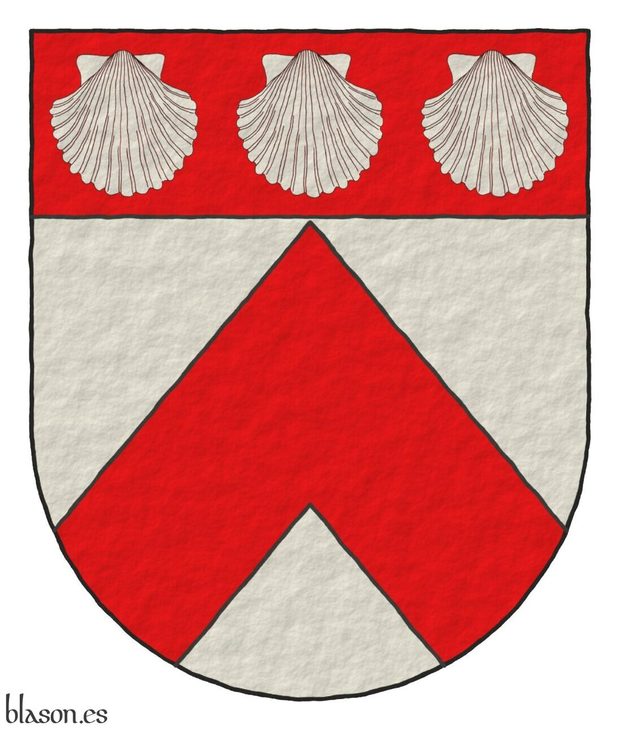
Simon de Croome ~ Simon de Crombe.
Argent, a Chevron Gules, on a Chief Gules, three escallops Argent, in fess.
Escudo de plata: un cabrio de gules; el jefe de azur, tres veneras de plata, en faja.
Included in [Vincent, MS; 1285; number 623] also known as [St. George's Roll; 1285; number 623].
The 3 escallops are in the chief then the description «in fess» are not really needed.
Blazon keywords: Without divisions, Argent, One, Chevron, Gules, Chief, Three, Escallop and In fess.
Style keywords: Semi-circular, Plain tincture, Outlined in sable and Freehand.
Classification: Interpreted and Personal.
Bearer: Simón de Croome.


Simon de Ver
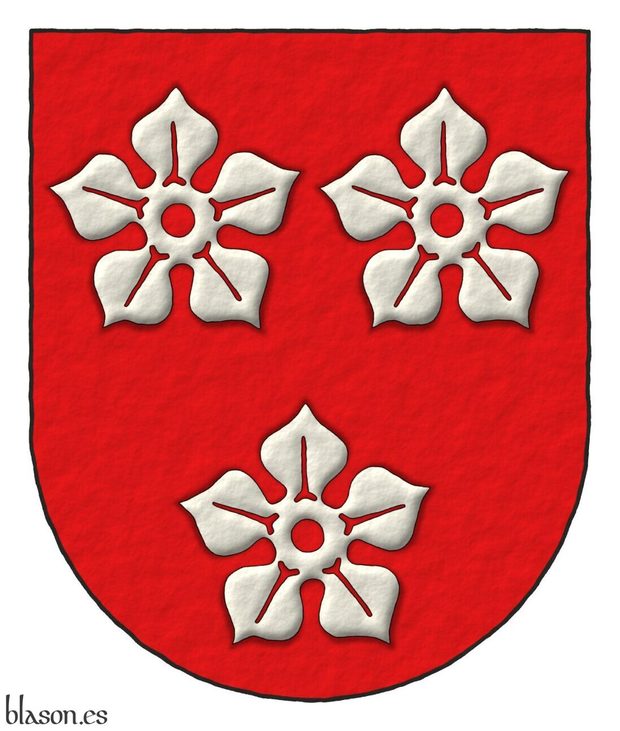
Simon de Vere ~ Simon de Ver.
Gules, three cinquefoils Argent.
Escudo de gules, tres quinquefolios de plata.
Included in [Vincent, MS; 1285; number 85] also known as [St. George's Roll; 1285; number 85].
Blazon keywords: Without divisions, Gules, Three, Cinquefoil, Argent and Ordered.
Style keywords: Semi-circular, Illuminated, Shaded, Outlined in sable and Freehand.
Classification: Interpreted and Personal.
Bearer: Simón de Vere.


Simon le FizSimon
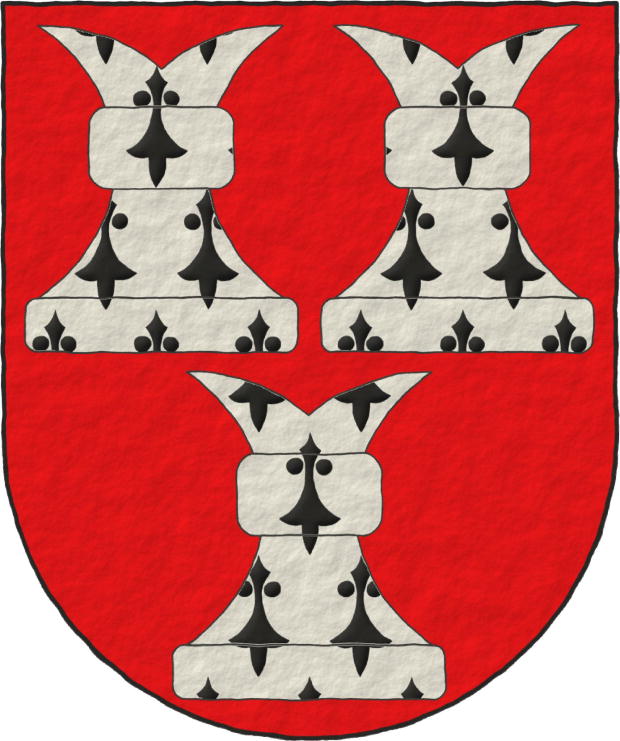
Simon FitzSimon ~ Simon le FizSimon.
Gules, three chess rooks Ermine.
Escudo de gules, tres roques de armiños.
Included in [Vincent, MS; 1285; number 224] also known as [St. George's Roll; 1285; number 224].
Blazon keywords: Without divisions, Gules, Three, Chess rooks, Ermine and Ordered.
Style keywords: Semi-circular, Illuminated and Outlined in sable.
Classification: Interpreted and Personal.
Bearer: Simón FitzSimon.


Sir Robert Knollys (1325-1407), second post
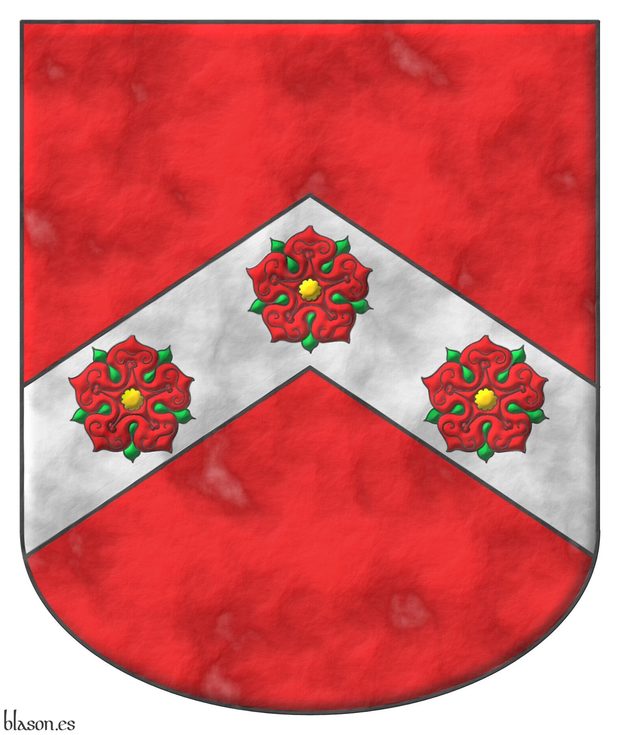
Sir Robert Knollys ~ Sir Robert Knolles (1325-1407).
Gules, on a chevron Argent three roses Gules, barbed Vert and seeded Or.
Escudo de gules, un cabrio de plata cargado de tres rosas de gules, barbadas de sinople y botonadas de oro.
Coat of arms interpreted as follows: the mouth is rounded; the field is illuminated in Gules; the chevron is outlined in Sable and illuminated in Argent metal; the roses outlined in Sable are illuminated the petals in Gules, the leaves in Vert and the central button in Or; and the whole has a parchment finish.
Robert Knolles participated in the Hundred Years' War, on the side of England, and in 1367, he was with Edward of Woodstock, the Black Prince, at the Battle of Nájera.
In the Battle of Nájera, on the way to Navarrete, Pedro I of Castile, with direct English support, and his half-brother Don Enrique de Trastámara, with indirect French support, faced each other. English and French hoped that supporting their side's victory would allow them to have the Castilian fleet on their side, which was more powerful than theirs, in their Hundred Years' War.
Blazon keywords: Without divisions and Gules.
Style keywords: Rounded, Illuminated, Outlined in sable and Parchment.
Classification: Interpreted, Personal, Kingdom of England and Army and Navy.
Bearer: Knollys, Robert.


Sosa-Garcia, Rodolfo
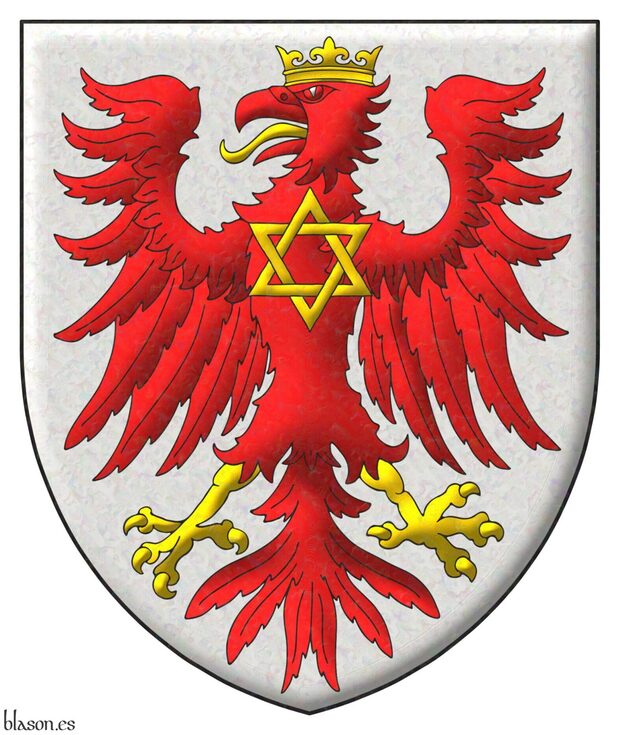
Zurich, Switzerland.
Argent, an eagle displayed Gules, crowned, langued, membered and armed, charged on its chest with a mullet of six points voided, and interlaced Or.
Escudo de plata, un águila de gules, coronada, lampasada, membrada y armada, cargada en su pecho de una estrella de seis puntas, hueca y entrelazada todo de oro.
Illuminated with lights and shadows and with a iridescent finish.
Another version of this blazon «Argent, a eagle displayed Gules, crowned, langued, membered and armed, charged on its chest with a star of David Or».
Blazon keywords: Without divisions, Argent, One, Eagle, Gules, Crowned, Langued, Membered, Armed, Charged, Mullet, Six, Base (lower 1/3), Voided, Interlaced and Or.
Style keywords: Iridescent (nacar), Outlined in sable, Illuminated and Pointed.
Classification: Personal and Created.
Bearer: Sosa-Garcia, Rodolfo.


Sovereign and Most Noble Order of the Pomegranate, page of armorial
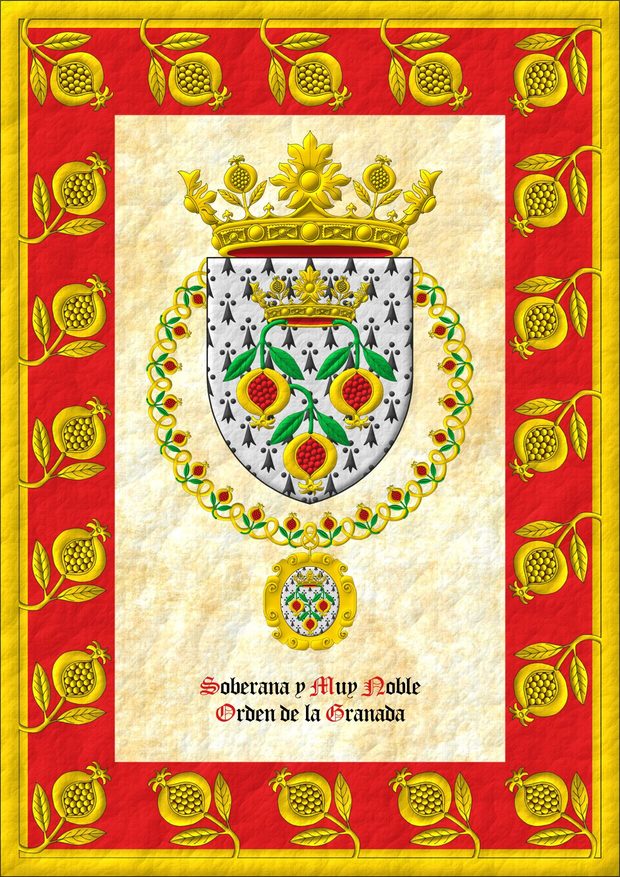
Ermine, three pomegranates inverted Or, seeded Gules, slipped and leaved Vert, ensigned with an open crown, alternating four rosettes of acanthus leaves, visible three, and four pomegranates Or, visible two, lined Gules. Crest: A crown of the Sovereign and Most Noble Order of the Pomegranate. The shield is surrounded by the Grand Collar of the Sovereign and Most Noble Order of the Pomegranate.
Blazon keywords: Without divisions, Ermine, Three, Pomegranate, Reversed, Or, Seeded (pomegranate), Gules, Slipped, Leaved, Vert, On, One, Crown, Alternately, Four, Rosette of acanthus leaves, Visible, Two, Lined, Crest and mantling, Surrounded and Grand collar.
Style keywords: Outlined in sable, Leather and Pointed.
Classification: Socioeconomic, Interpreted, Coat of arms, Armorial roll and Castilian language.
Bearer: Granada, Soberana y Muy Noble Orden de la.


Subiça of Navarre
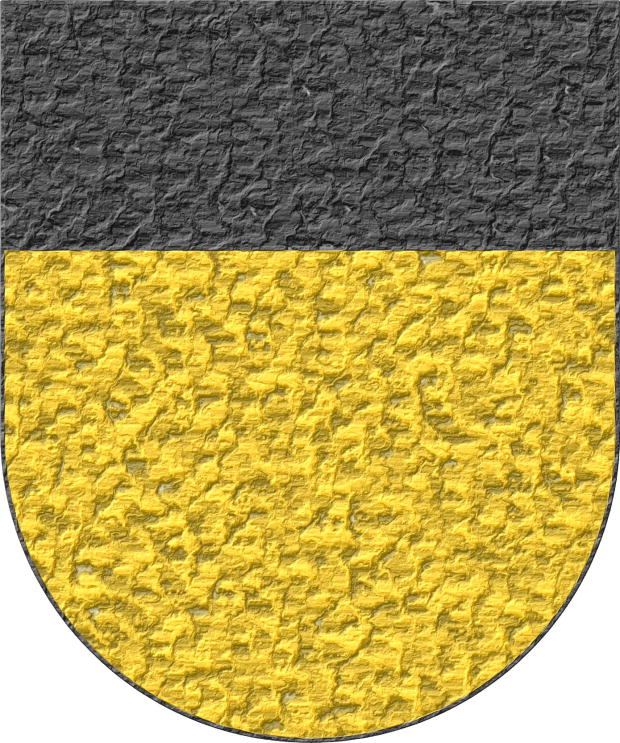
Of the twelve lineages of Noblemen, the seventh is Subiça, and bears as arms a shield Or, with a chief Sable at the upper part of the shield, in the same manner as painted in this one.
Or; a chief Sable.
Escudo de oro; el jefe de sable.
Coat of arms interpreted with: a semicircular (round) base; the field in flat Or metal; the chief in flat Sable; and the whole finished in highly-hammered metal.
Coat of arms based on the seventh of the Navarrese «ricoshombres» from [Bosque, J. del; 1540; folio 1 of the numbering of 1613]. The text heading it is taken from the transcription made by [Martinena Ruiz, J. J.; 1982; pages 122 and 123].
Under the title «Surname of Cubiza» these armorial bearings can be consulted in [Vega, P. J. de; 1702; folio 7 of the manuscript].
Blazon keywords: Without divisions, Or, Chief and Sable.
Style keywords: Semi-circular, Plain tincture and Hard metal.
Classification: Interpreted, Personal and Kingdom of Navarre.
Bearer: Subiça of Navarre.


Talbot, lineage of England
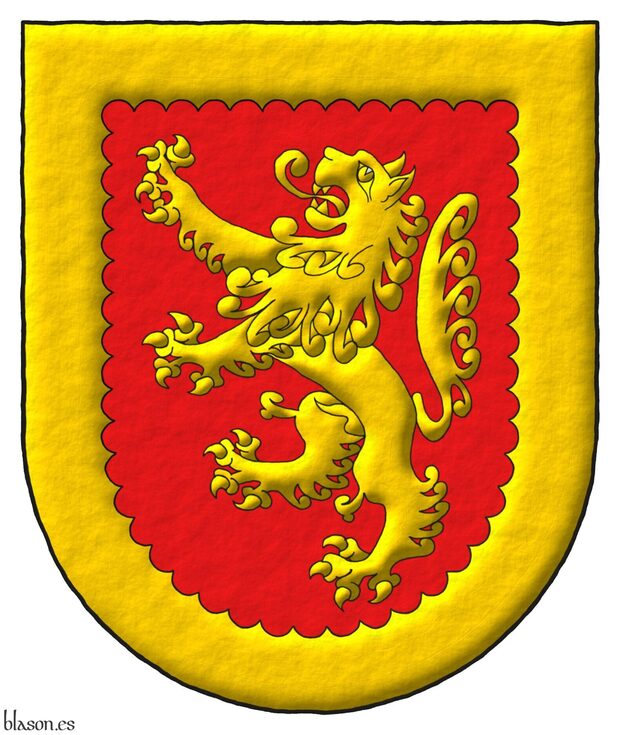
Blazon of the Talbot lineage of England.
Escudo de gules, un león rampante dentro de una bordura angrelada todo oro.
Gules, a lion rampant within a bordure engrailed Or.
Illuminated with lights and shadows and with a freehand finish.
[Rietstap, J. B.; 1861] writes it in French as «de gueules, au lion d'or, à la bordure engrelée du même». y [Burke, J.; 1836; volume 3, pages 359-360] writes it in English as «Gu. a lion rampant, within a bordure engr. or».
Blazon keywords: Without divisions, Gules, One, Lion, Rampant, Within, Bordure, Engrailed and Or.
Style keywords: Freehand, Outlined in sable, Illuminated and Semi-circular.
Classification: Interpreted, Lineage and Kingdom of England.


Technica impendi nationi
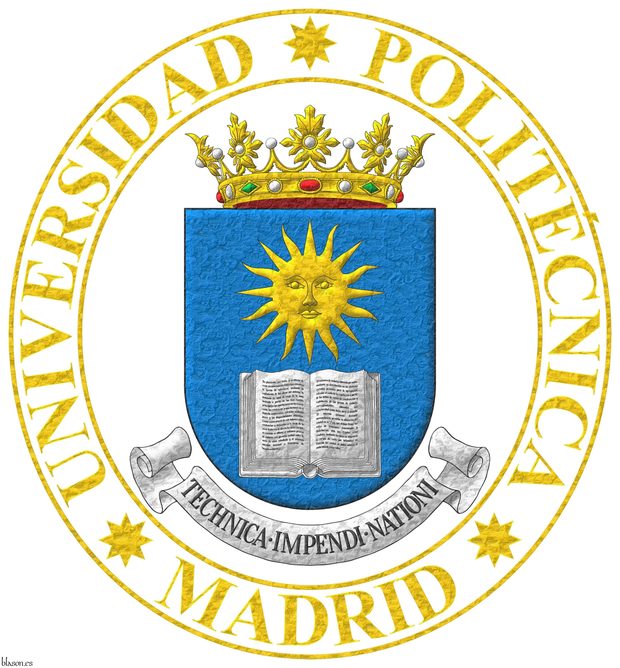
Azure, in base an open book Argent, in chief a sun in splendour Or. Crest: An open royal crown. Motto: «Technica impendi nationi». Motto around the shield: «Universidad de Politécnica de Madrid» fimbriated and depinted Or.
Escudo de azur, un libro abierto de plata surmontado de un sol de oro. Timbrado de una corona real abierta. Lema: «Technica impendi nationi». Divisa alrededor del escudo: «Universidad de Politécnica de Madrid» perfilada y en letras de oro.
Coat of arms interpreted as follows: a semicircular (round) base; the field in flat Azure; the field and charges are illuminated in the tinctures Azure and the metals Argent and Or, all outlined in Sable; my rendition of this coat of arms differs from others in that the sun’s rays, although outlined in Sable, are Or; in the legibility of the text written on the book; and in separating with a dot the words that form the motto; and the whole finished with a beaten-metal effect.
Metal batido y anacarado
Blazon keywords: Without divisions, Azure, Argent, Or, Book, Sun in splendour, Crest and mantling, Crown, Open royal crown, Motto and Motto (identification).
Style keywords: Semi-circular, Oval, Illuminated, Outlined in sable and Metal beaten.
Classification: Interpreted, Socioeconomic and Education.
Bearer: Technical University of Madrid.


The coat of arms of Ralf Hartemink carved in wood
Or, three puffins proper.
Escudo de oro, tres frailecillos (Fratercula arctica) al natural.
Coat of arms of Ralf Hartemink, founder and owner of Heraldry of the World heraldry-wiki.com, crafted in wood with a height of 60 cm by woodflag.eu, based on my painting of his coat of arms. Since 1995, Heraldry of the World is the most important resource for civic heraldry. The collage contains to the dexter his coat of arms painted by me and to the sinister his coat carved in wood hanging on the wall of the factory where it was made.
Blazon keywords: Without divisions, Or, Three, Puffin and Proper.
Style keywords: Pointed, Outlined in sable, Illuminated and Leather.
Classification: Personal, Interpreted, Coat of arms, Collage and Photographic.
Bearer: Hartemink, Ralf.


![Ver [The Heraldry Society of Scotland] en instituciones citadas. Fortaleza de oro y mazonada de sable.](../css/Fortaleza.Institucion.png)
The Heraldry Society of Scotland
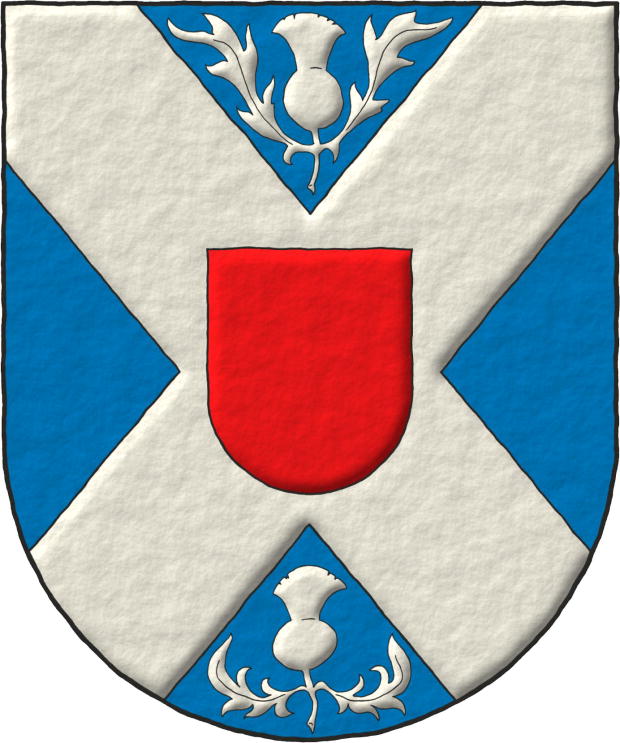
Objectives and activities
The Heraldry Society of Scotland ~ «The Heraldry Society of Scotland», was founded in 1977. Its objectives are to promote the study of heraldry and to encourage its correct use both in Scotland and abroad.
The HSS (acronym for The Heraldry Society of Scotland) encourages those who have a coat of arms and those who intend to adopt their own arms to become members of the society and also encourages to join all those interested in Scottish heraldry, therefore the HSS admits and has members from all over the world.
The HSS holds active and regular meetings throughout the year and organizes conferences and visits to places of historical and heraldic interest, both within Scotland and in other countries.
Online content
They also maintain and update a website, whose domain is Heraldry-Scotland.co.uk, with interesting and abundant reading material, among which their list of online armorials with blazons in English stands out, among which the following armorials can be highlighted:
- Sir David Lindsay's Armorial from 1542, with 504 coats of arms and identification letters «DL», from «DL001» to «DL504». Includes imaginary coats of arms, for example, that of «DL011» of Hector of Troy which it imagines as «Sable, two lions combatant Or», which [Avilés, J.; 1725a; page 7] blazons with a Gules field, this difference would allow tracing the sources of each author, which would be interesting as it is, moreover, imaginary.
- Hamilton Armorial, from 1560, with 82 coats of arms they say, although only 79 appear, and identification letters «HM», from «HM001» to «HM079», where for example, «HM001» is the arms of Scotland «Or, a lion rampant Gules armed and langued Azure within a double tressure flory counter-flory Gules» and «HM026» is the insignia of Scotland «Or, a lion rampant within a double tressure flory counter-flory Gules».
- Queen Mary's Roll from 1562, with 204 coats of arms and identification letters «QM». from «QM001» to «QM204».
- Forman's Armorial from 1563, with 258 coats of arms they say, although only 247 appear, and identification letters «FAL», that is, from «FAL001», the arms of Scotland, to «FAL247».
- Slains Armorial from 1565, with 712 coats of arms they say, although only 638 appear, and identification letters «SL», that is, from «SL001» to «SL638».
- Armorial of Sir David Lindsay of the Mount, Secundus from 1599, with 285 coats of arms and identification letters «DLS».
- Seton Armorial from 1599, with 422 coats of arms and identification letters «SN», from «SN001» to «SN422».
- Dunvegan Armorial estimated to be around 1600, with 282 coats of arms they say, although only 52 appear, and identification letters «DV», only 2 digits and without leading zeros, from «DV1» to «DV52».
- Kings and Nobilities Arms, 2nd volume from 1638, with 111 coats of arms and identification letters «KNB», from «KNB001», the arms of the King of Scotland, to «KNB111».
- Nisbet's A System of Heraldry published in 1722, with 2,608 coats of arms, according to my count, and which I reference as [Nisbet, A.; 1722], 1st edition and [Nisbet, A.; 1816], for a later one that I have available. On the same page appears the blazon of Alexander Nisbet himself, in entry 1,926 according to my calculations, as «Argent, three boars' heads erased Sable within a bordure invected Gules», that is, «Argent: three boars' heads erased Sable; a bordure invected Gules» where «invected» ~ «acanalado» as opposed to «engrailed» ~ «angrelado».
I also find very interesting, for example, their pages on the basic principles of heraldic design, written by Doctor Patrick Barden.
Categories: Institution, Interpreted, Socioeconomic, Illuminated, Outlined in sable, Iridescent (nacar), Freehand, Semi-circular, Coat of arms, Without divisions, Azure, Saltire, Argent, Thistle, Couped (tree), In chief, In base, Inescutcheon and Gules.


![Ver [The International Heraldry Society] en instituciones citadas. Fortaleza de oro y mazonada de sable.](../css/Fortaleza.Institucion.png)
The International Heraldry Society

Vert, an inescutcheon Argent; overall a compass rose Sable and Or.
Escudo de sinople, un escusón de plata; brochante sobre el todo, una rosa de los vientos de sable y oro.
The International Heraldry Society has its Facebook group in the following address facebook.com/groups/int.herald.
Categories: Institution, Without divisions, Vert, Inescutcheon, Argent, Surmounted, Overall (deprecated), Compass rose, Sable and Or.


Thomas de Werblintone
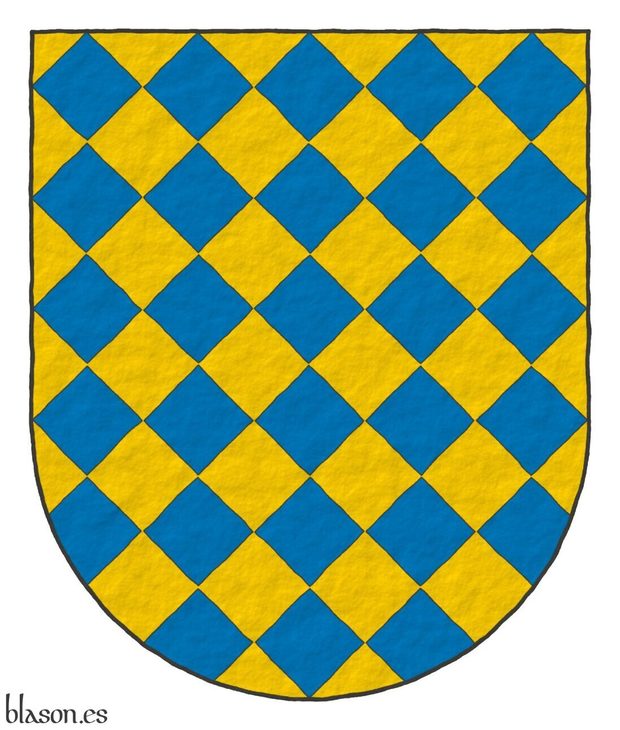
Thomas de Warbleton ~ Thomas de Werblintone.
Lozengy Or and Azure.
Escudo losanjado de oro y azur.
Included in [Vincent, MS; 1285; number 245] also known as [St. George's Roll; 1285; number 245].
Blazon keywords: Without divisions, Lozengy, Or and Azure.
Style keywords: Semi-circular, Plain tincture and Outlined in sable.
Classification: Interpreted and Personal.
Bearer: Tomás de Warbleton.


Thomas Grenville, stone coat of arms
Coat of arms of Thomas Grenville sculpted in St Mary's Church, Bideford, Devon, United Kingdom.
Gules, three Clarions Or.
On a field of gules, three clarions of gold can be seen in the dexter canton of the base of the main shield of [Tewkesbury; Century XVII; folio 24r] and on 8 other coats of arms in this armorial.
Blazon keywords: Without divisions, Gules, Three, Clarion and Or.
Style keywords: Freehand, Plain tincture and Illuminated.
Classification: Interpreted, Kingdom of England and Photographic.
Bearer: Grenville, Thomas.


Thomas le FizThomas
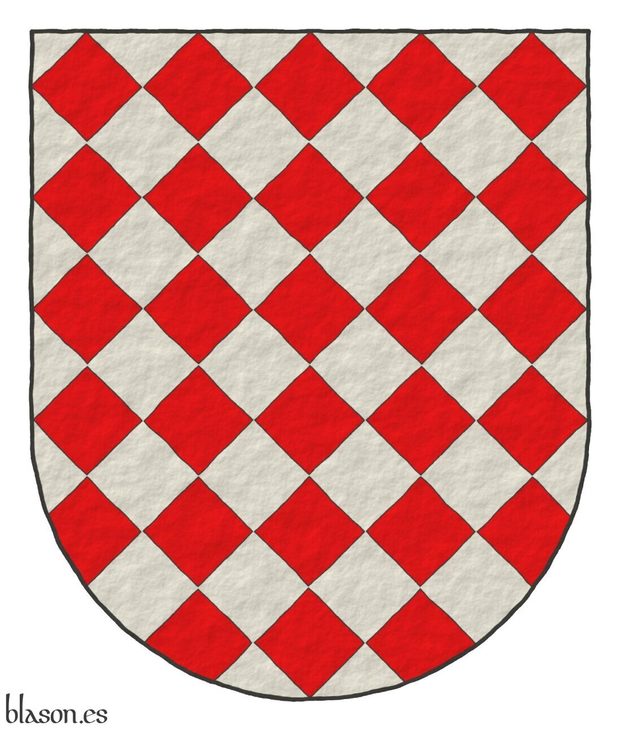
Thomas FitzThomas ~ Thomas le FizThomas.
Lozengy Argent and Gules.
Escudo losanjado de plata y gules.
Included in [Vincent, MS; 1285; number 245] also known as [St. George's Roll; 1285; number 245].
Blazon keywords: Without divisions, Lozengy, Argent and Gules.
Style keywords: Semi-circular, Plain tincture and Outlined in sable.
Classification: Interpreted and Personal.
Bearer: Tomás FitzThomas.


Thomas Roscelyn
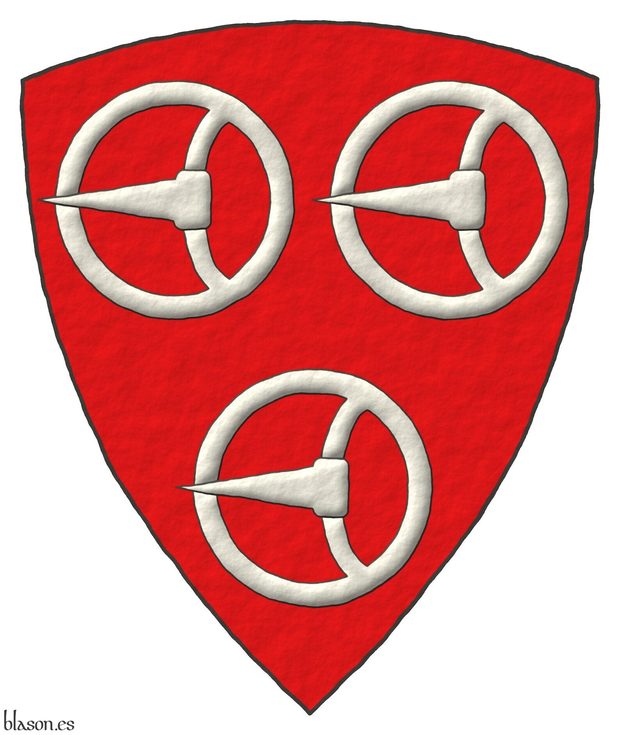
Tomás Roscelyn Thomas ~ Roscelyn ~ Thomas Rocelin.
Gules, three buckles Argent.
Escudo de gules, tres hebillas de plata.
Included in [Vincent, MS; 1285; number 595] also known as [St. George's Roll; 1285; number 595].
Blazon keywords: Without divisions, Argent, Three, Buckle, Sable and Ordered.
Style keywords: Triangular curved, Illuminated, Outlined in sable and Freehand.
Classification: Interpreted and Personal.
Bearer: Tomás Roscelyn.


TikTok
Heraldry videos
- Heraldic panther on the arms of the residential neighborhood of Centro, Val'Quirico, Tlaxcala, Mexico.
- Giclee for the arms of Carmela Mazzacuva, Marquise of Montebello, emblazoned by me.
- The coat of arms of Jean-Christophe Loubet del Bayle designed by him emblazoned by me.
- The legal wafer of KZA Music Services of Laird Sky emblazoned by me in the certificate of his music academy.
- Heraldic document for the coat of arms of Lucas Cruz's family.
- The pennon of the residential village of Centro, Val’Quirico, Tlaxcala, Mexico, designed and emblazoned by me.
- ANPC - Egmont Overture This video shows how I emblazon the coat of arms of the ANPC of Spain.
- This video shows the coat of arms of Juan Lanzagorta Vallín designed by him and emblazoned by me.
- The coat of arms of Jean-Christophe Loubet del Bayle emblazoned by me step by step.
- This video shows how I emblazon the coat of arms of Richard Arthur Brinnhard.
- Heraldic standard of Rudolf Juchter van Bergen Quast emblazoned by me.
Heraldic channel
My heraldic channel @antoniosheraldry at TikTok is tiktok.com/@antoniosheraldry.
Categories: Technology, Social networks, Without divisions, Argent, Five, Escutcheon, In cross, Azure, Charged, Bezant and plate, Plate, In saltire, Bordure, Gules, Seven, Castle, Or, Two, In chief, One, In each flank, Three, In base, Crown of Marquis and Crown.


Ukraine
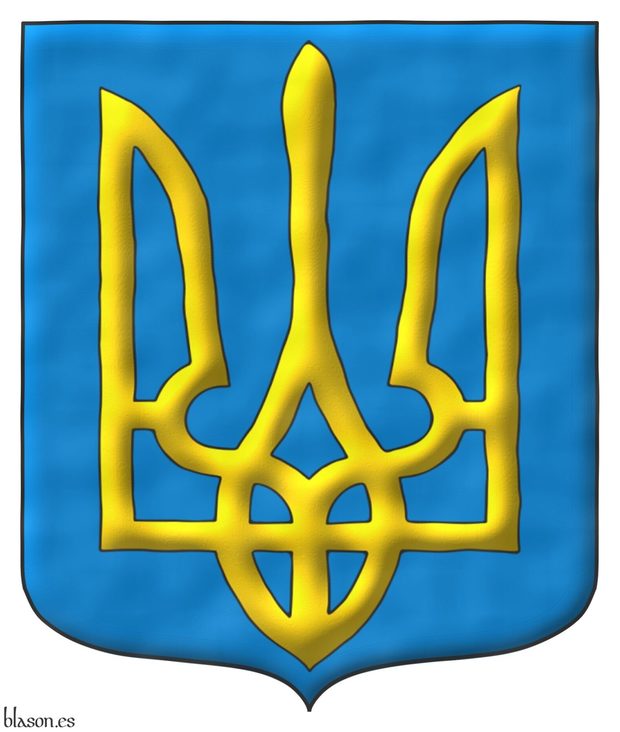
Trident~Tryzub.
Azure, a Tryzub Or.
Interpreted coat of arms: with a rounded and pointed shape; illuminated with metals or and color azure; outlined with sable; and a Watercolor finish.
Blazon keywords: Without divisions, Azure, Trident and Or.
Style keywords: Ogee, Illuminated, Outlined in sable and Freehand.
Classification: Coat of arms, Interpreted, Civic and State of Ukraine.
Bearer: Ukraine.


Universitas Studiorum Navarrensis
![Universitas Studiorum Navarrensis Emblem Azure, Saint Michael Argent, vested and nimbed Or, grasping in his dexter hand a spear Or, point downward, and in his sinister hand bearing [ Gules, a chain orlewise, crosswise, and saltirewise Or, charged in the fess point with an emerald Vert, of Navarre ], upon a dragon Vert, armed, langued, fanged, and the eyes Gules. Motto: «Universitas Studiorum Navarrensis».](../escudo_armas/UnavN.22.SanMiguel.Oro.Vestido.Plata.jpg)
Emblem Azure, Saint Michael Argent, vested and nimbed Or, grasping in his dexter hand a spear Or, point downward, and in his sinister hand bearing [ Gules, a chain orlewise, crosswise, and saltirewise Or, charged in the fess point with an emerald Vert, of Navarre ], upon a dragon Vert, armed, langued, fanged, and the eyes Gules. Motto: «Universitas Studiorum Navarrensis».
Emblema de azur, un San Miguel de plata, vestido y nimbado de oro, teniendo en su diestra una lanza de oro, con la punta hacia abajo y en su siniestra trae [ escudo gules, una cadena puesta en orla, en cruz y en sotuer de oro, cargada en el centro de una esmeralda de sinople, de Navarra ], sostenido por un dragón de sinople, armado, lampasado, fierezado y encendido de gules. Divisa: «Universitas Studiorum Navarrensis».
Emblem interpreted as follows: oval in shape and more rounded than the original; the field illuminated in Azure; its charges illuminated in Gules, Vert, Argent, and Or, and outlined in Sable; the emerald represented by an enameled area Vert; and the whole emblem has a parchment-like finish.
The archangels Michael, Gabriel, and Raphael are angels; therefore, I classify this emblem both under the category archangel and under angel, while Saint Michael himself is represented in it as a male figure.
Saint Michael the Archangel, in this representation, bears a shield which, at first, I blazon as the current coat of arms of Navarre, chains of gold, the original arms of Navarre being as blazoned in the armorial [Urfé; 15th century; folio 142]: «Gules, a carbuncle Or pommelly, illuminated Vert in the centre in the manner of an emerald». This description does not suggest the presence of chains, but rather the rays of a carbuncle, nor an actual emerald, since what corresponds to the central umbo from which the rays of the carbuncle emerge is enameled Vert.
Due to my way of painting the arms of Navarre in profile, it stands halfway between a carbuncle and chains, with the outer links round like those of a chain, the central ones long like the rays of a carbuncle, and in the centre I have not drawn an emerald, but an enameled area Vert «in the manner of an emerald».
Blazon keywords: Without divisions, Azure, Male figure, Angel, Archangel, Argent, Vested, Nimbed, Or, Grasping, Dexter, Spear, Point downwards, Sinister, Upon, Dragon, Vert, Armed, Langued, The fangs, The eyes, Gules and Motto (identification).
Style keywords: Oval, Illuminated, Outlined in sable and Parchment.
Classification: Interpreted, Socioeconomic, Education, Emblem and Kingdom of Navarre.
Bearer: University of Navarra.


Urban VI
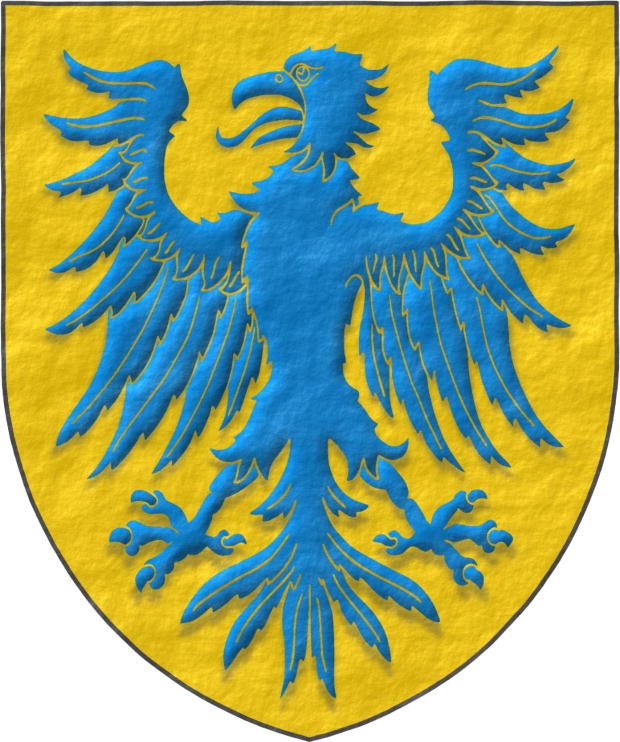
202nd Pope of the Church, from 1378 to 1389. «Urbanus VI», named Bartolomeo Prignano, born in Itri, near Naples, in the Lazio region.
Or, an eagle displayed Azure.
Escudo de oro, un águila de azur.
Papal coat of arms interpreted with: a pointed mouth; the field in flat tincture of metal Or; the eagle illuminated in Azure, shaded and outlined in the color of the field; and the whole with a rough finish.
Blazon keywords: Without divisions, Or, One, Eagle and Azure.
Style keywords: Pointed, Illuminated, Outlined in the field tincture, Shaded and Rough.
Classification: Interpreted, Religious and Papal States.
Bearer: Urban VI.


![Ver [Valero de Bernabé, L.; 2009a] en referencias bibliográficas. Libro abierto, hojas de plata, filo de oro, guardas de gules, tapas de sable.](../css/Libro.Bibliografia.png)
Valero de Bernabé, L.; 2009a
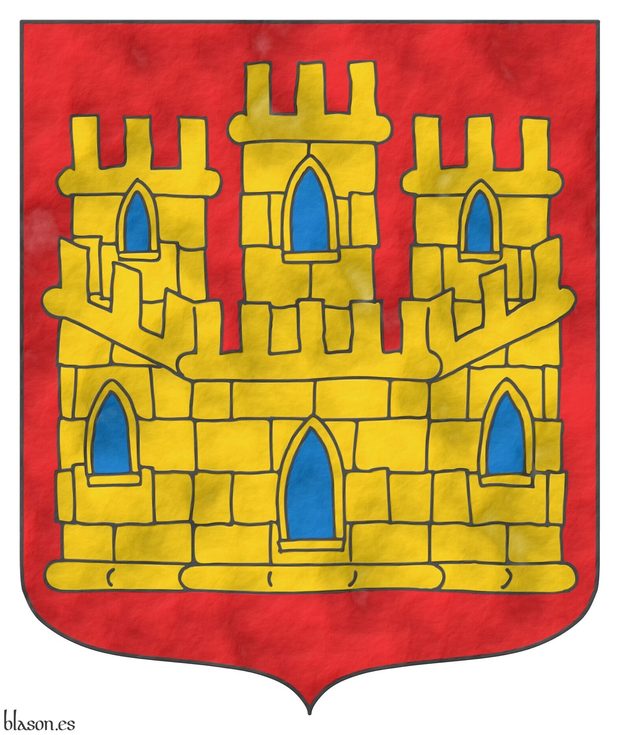
Luis Valero de Bernabé y Martín de Eugenio, «Los Castillos en la Heráldica Española», 2009.
I received this article directly from the author, to whom I am grateful for his kind submission. I consider it a preliminary and preparatory work for the article [Valero de Bernabé, L.; 2009b; pages 32-34] published later.
Bibliographical reference of century XXI.
The author is Valero de Bernabé y Martín de Eugenio, Luis.
The following articles cite this bibliographic reference:
Internal resources: ValeroBernabeL2009.ElCastilloEnLaHeraldicaEspañola.pdf.


![Ver [Vega, P. J. de; 1702] en referencias bibliográficas. Libro abierto, hojas de plata, filo de oro, guardas de gules, tapas de sable.](../css/Libro.Bibliografia.png)
Vega, P. J. de; 1702
Pedro José de Vega, «Compendio de la Maior Parte Ð los Blassones, Armas, e Ynsignias Ð las Ylustres Casas, Familias, y Apellidos del Reyno Ð Navarra i Parte Ð la Provincia de Gvipvzcoa, Segvn las Vsan y Traen los Svccesores Ðellas» ~ «Compendium of the Greater Part of the Blazons, Arms, and Insignias of the Illustrious Houses, Families, and Surnames of the Kingdom of Navarre and Part of the Province of Guipuzcoa, As Used and Carried by Their Successors», manuscript in 2 volumes, Volume I, catalog number MSS/7835 V.1, and Volume II, catalog number MSS/7836 V.2, in the National Library of Spain, 1702.
As stated on the title page, the Field Master «Pedro Ioseph Ð Vega» was a native of the Kingdom of Navarre, deputy of the Kingdom of Navarre from 1688 to 1691, governor of the provinces of Cotabamba and Parinacochas in Peru, written as «governador», and gentleman of the «Voca de su Majestad» (His Majesty's Voice).
Bibliographical reference of century XVIII.
The author is Vega, Pedro José de.
Here are the articles quoting this reference:
- Almorrabides of Navarre
- Aybar of Navarre
- Baztanes of Navarre
- Guebara of Navarre
- Lete of Navarre
- Mauleón of Navarre
- Monteagudo of Navarra
- Navarra, emerald overall
- Qasqante of Navarre
- Rada of Navarre
- Subiça of Navarre
- Urroz of Navarre
- Vidaurre of Navarre
External resource:


Vidaurre of Navarre
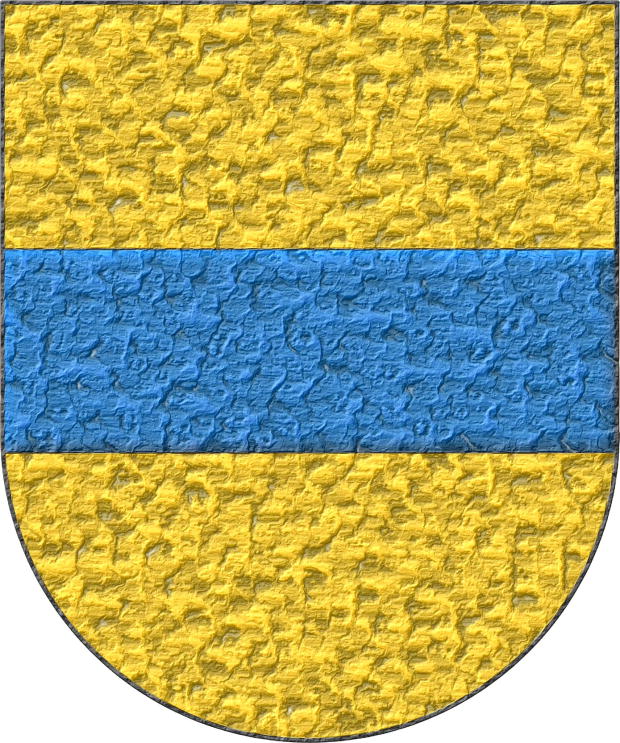
Of the twelve lineages of Noblemen, the ninth is Vidaurre, who bears as arms a shield Or and, in the middle, a fess Azure, in the same manner as this shield is now painted.
Or, a fess Azure.
Escudo de oro, una faja de azur.
Coat of arms interpreted with: a semicircular (round) base; the field in flat Or; the fess illuminated in Azure and outlined in Sable; and the whole finished in highly-hammered metal.
Interpreted from the ninth coat of arms of the Navarrese «ricoshombres» from [Bosque, J. del; 1540; folio 1 of the numbering of 1613] and with the preceding text taken from the transcription appearing in [Martinena Ruiz, J. J.; 1982; pages 122 and 123].
Under the title «Surname of Vidaurre» this coat of arms can be consulted in [Vega, P. J. de; 1702; folio 9 of the manuscript].
Blazon keywords: Without divisions, Or, Fess and Azure.
Style keywords: Semi-circular, Illuminated, Outlined in sable and Hard metal.
Classification: Interpreted, Personal and Kingdom of Navarre.
Bearer: Vidaurre of Navarre.
Blazon equivalent to: Vernon, barón de Shubbroc.


Vilardi, lineage of Italy
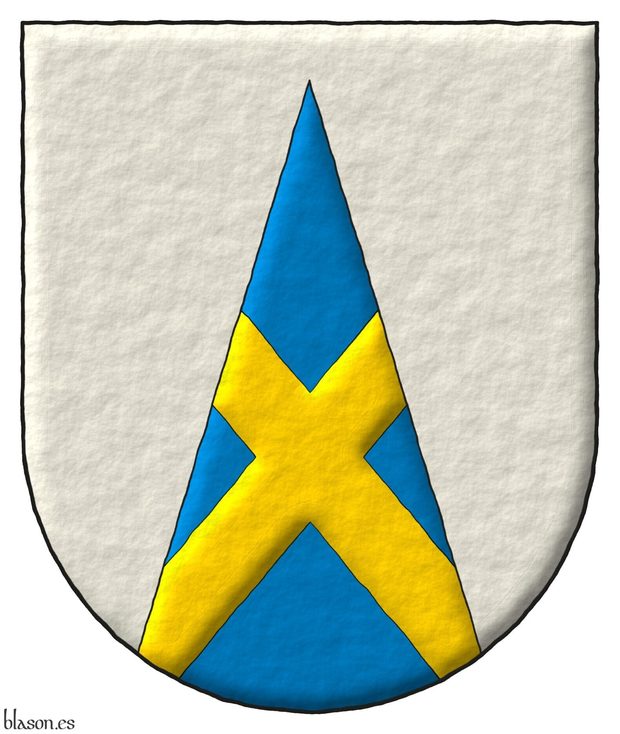
Blazon of the Vilardi lineage of Italy.
Argent, on a pile issuant from the base Azure a saltire Or.
Escudo de plata, una pira de azur cargada de un sotuer de oro.
Illuminated and a free hand finishing.
[Cadenas y Vicent, V. de; 2002; page 138] says that the a pile issuant from the base is «a triangle whose base issues from the base of the shield, being a third of its width», but when it is painted in [Cadenas y Vicent, V. de; 2002; page 268, figure 279] along with the pile the width of the base of both isosceles triangles is 2/3 of the width of the shield. I think the width of 2/3 is, in these 2 cases, better than 1/3 width, because with 1/3 there is not enough room for charges, as shown in the figure below.
There are scholars who say that the pile issuant from the base must not touch the upper edge of the shield and others that its tip should be in the center of the chief. In the previous image, the pile issuant from the base of the 1st shield fulfills the first affirmation, and in the 2nd shield, its tip is in the center of the chief.
I have the doubt if it should not be a saltire raguly.
Blazon keywords: Without divisions, Argent, One, Pile issuant from base, Azure, Charged, Saltire and Or.
Style keywords: Freehand, Outlined in sable, Illuminated and Semi-circular.
Classification: Interpreted, Lineage and Italian Republic.


Vittorio Gifra compared to con Almorrabides of Navarre
Almorrabides of Navarre Or, three Pallets Azure.
Paly of six Azure and Or; over all a bend Azure.
For this comparison I make the optical illusion as if the coat of arms of Almorrabides de Navarra was Azure, instead of being Or, and the Pallets Or, instead of being Azure. Para esta comparación hago el juego visual como si el escudo de Almorrabides de Navarra fuera de Azur, en vez de ser de Oro, y que los palos que sobresalen iluminados son los de Oro, en vez de ser los de Azur.
Blazon keywords: Paly, Six, Azure, Or, Surmounted, Overall (deprecated), Bend, Without divisions, Three and Pale.
Style keywords: Semi-circular, Freehand, Illuminated and Outlined in sable.
Classification: Coat of arms, Interpreted, Personal and Kingdom of Navarre.
Bearer: Gifra, Vittorio.


![Ver [Wijnbergen; 1265] en referencias bibliográficas. Libro abierto, hojas de plata, filo de oro, guardas de gules, tapas de sable.](../css/Libro.Bibliografia.png)
Wijnbergen; 1265

Wijnbergen, unknown authors, «Wijnbergen Armorial», currently located in The Hague and owned by the Royal Dutch Society of Genealogy and Heraldry, Île-de-France, 1265.
This armorial is called «Wijnbergen» because it was named after one of its early owners, and the names of its authors are unknown. I have retained this name in the key to this bibliographic reference for easier identification.
Among known manuscripts, it is the oldest armorial of French heraldry.
It is composed of 15 parts, although some authors divide it into 23, belonging to 2 different temporal stages of creation: a 1st stage from 1265 to 1270 and a 2nd stage, more difficult to date, from 1270 to 1285.
The armorial is written in French and contains a total of 1,312 coats of arms, of which 256 belong to the 1st stage and 1,056 to the 2nd stage.
Those of the 1st stage belong to the vassals of the Île-de-France under the reign of Luis IX de Francia, Saint Louis King of France.
Those of the 2nd stage, probably already under the reign of Felipe III de Francia, contain coats of arms from Normandy, Anjou and Poitou, Lorraine, Germany, Artois, Champagne, Vermandois, Brittany, Beauvais, Burgundy, Brabant, Hainaut (Belgium), Flanders, and finally, the coats of arms of 25 kings, mainly European.
Bibliographical reference of century XIII.
Author: Wijnbergen, Anonymous.
Here are the articles quoting this reference:
External links:

William Bardolf
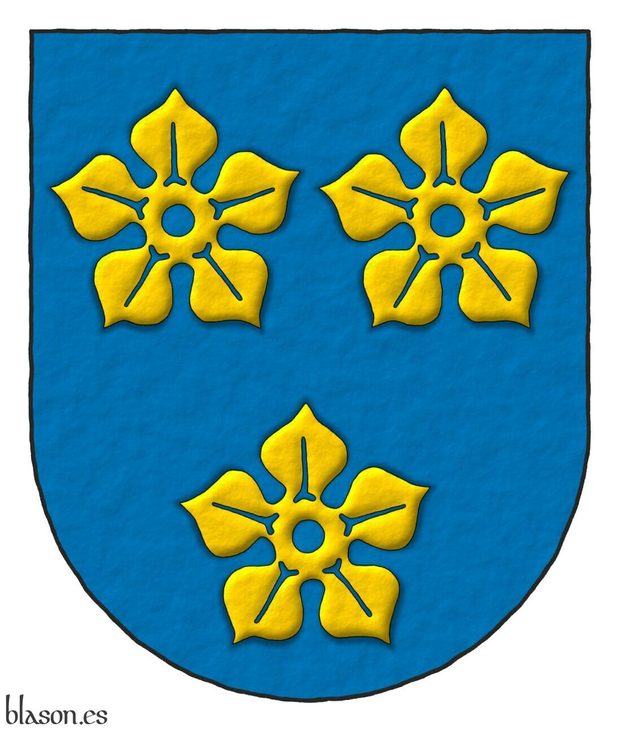
Guillermo Bardolf ~ William Bardolf ~ Willem Bardulf.
Azure, three cinquefoils Or.
Escudo de azur, tres quinquefolios de or.
Included in [Vincent, MS; 1285; number 223] also known as [St. George's Roll; 1285; number 223].
Blazon keywords: Without divisions, Azure, Three, Cinquefoil, Or and Ordered.
Style keywords: Semi-circular, Illuminated, Shaded, Outlined in sable and Freehand.
Classification: Interpreted and Personal.
Bearer: Guillermo Bardolf.


William de Ferrers, Earl of Derby
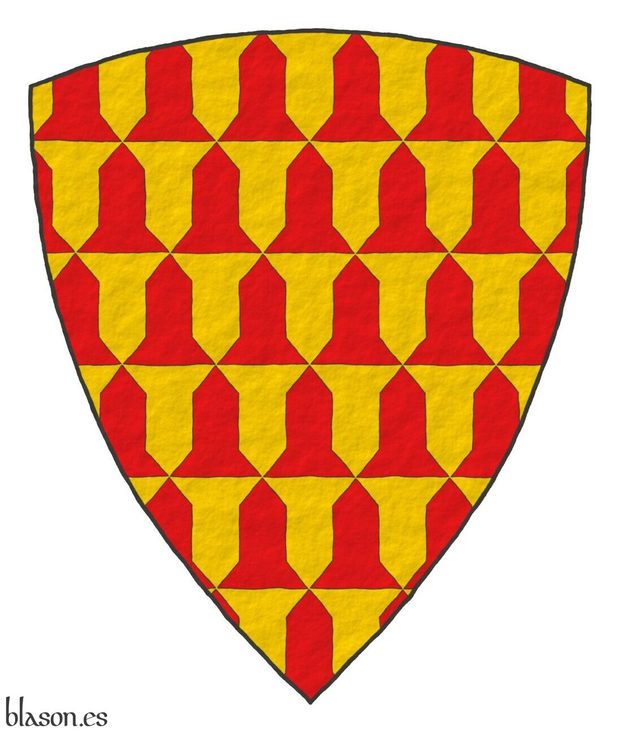
William de Ferrers, Earl of Derby ~ Cunte de Ferrers.
Vairy Or and Gules.
Escudo verado de oro y gules.
Interpreted coat of arms, the shape of the shield is triangular and curved plain tinctures metal Or and color Gules, outlined in sable; and a free hand finishing.
Included in [Vincent, MS; 1285; number 17] also known as [St. George's Roll; 1285; number 17].
Blazon keywords: Without divisions, Vairy, Or and Gules.
Style keywords: Triangular curved, Plain tincture and Outlined in sable.
Classification: Interpreted and Personal.
Bearer: Guillermo de Ferrers.


William de Hondeshacre
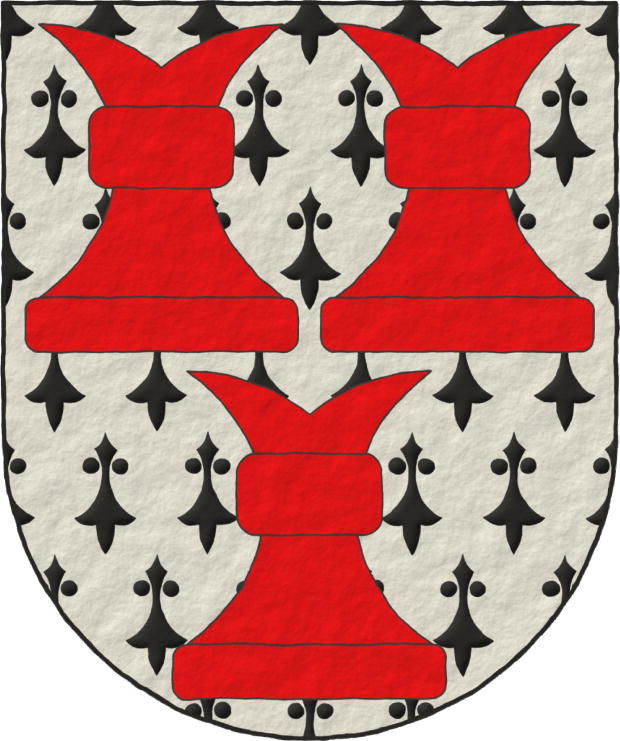
William de Handsacre ~ William de Hondeshacre.
Ermine, three chess rooks Gules.
Escudo de armiños, tres roques de gules.
Included in [Vincent, MS; 1285; number 469] also known as [St. George's Roll; 1285; number 469].
Blazon keywords: Without divisions, Ermine, Three, Chess rooks, Gules and Ordered.
Style keywords: Semi-circular, Illuminated, Outlined in sable and Freehand.
Classification: Interpreted and Personal.
Bearer: Guillermo de Handsacre.

William Shakespeare, lanza de torneo
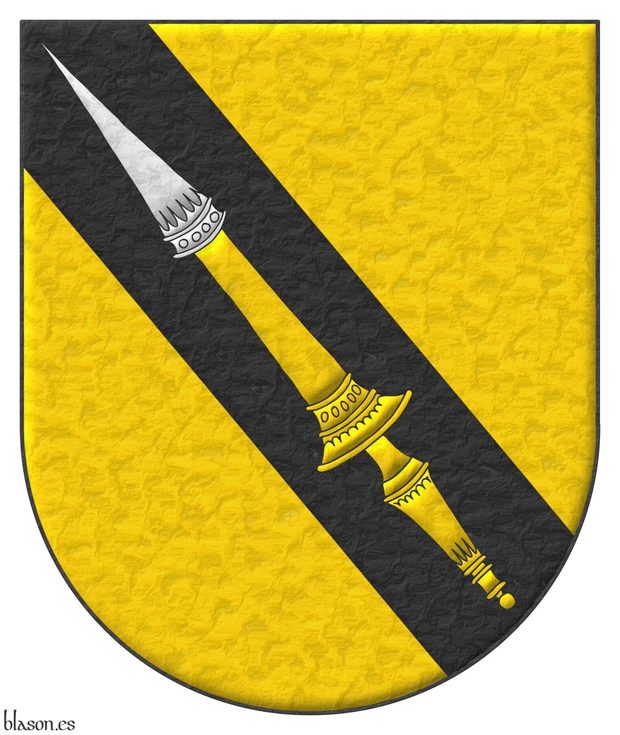
Or, on a bend Sable, a spear of the first, steeled Argent.
Escudo de oro, una banda de sable, cargada de una lanza de plata, fustada oro.
Coat of arms interpreted by me with: a semicircular (round) base; the field and bend illuminated in Or and Sable; the lance is a tournament one, similar to other Shakespeare coats of arms, which I have illuminated in Argent and Or and outlined from the field; and finished with a lightly hammered metal effect.
In this version of his blazon in English I have written «steeled Argent», which is how some authors write it, while in another article I have specified it as «headed Argent».
In the figure that is charged upon the bend of this interpretation of the shield, I recreate a tournament lance, which is the type usually used to represent the arms of William Shakespeare. Note that the blazon of his shield only indicates «a Spear» ~ «una lanza», so it could equally be the type of lance used by infantry or light cavalry. However, English tradition usually employs, for William Shakespeare, a tournament lance, both for the one charged on the bend and for the one held by the falcon on his crest.
Blazon keywords: Without divisions, Or, Sable, Argent, Bend, Bendwise, Spear and Charged.
Style keywords: Soft metal, Outlined in the field tincture and Illuminated.
Classification: Interpreted, Personal, Coat of arms, Canting and Literature.
Bearer: Shakespeare, William.


![Ver [Zamora Vicente, A.; 1999] en referencias bibliográficas. Libro abierto, hojas de plata, filo de oro, guardas de gules, tapas de sable.](../css/Libro.Bibliografia.png)
Zamora Vicente, A.; 1999
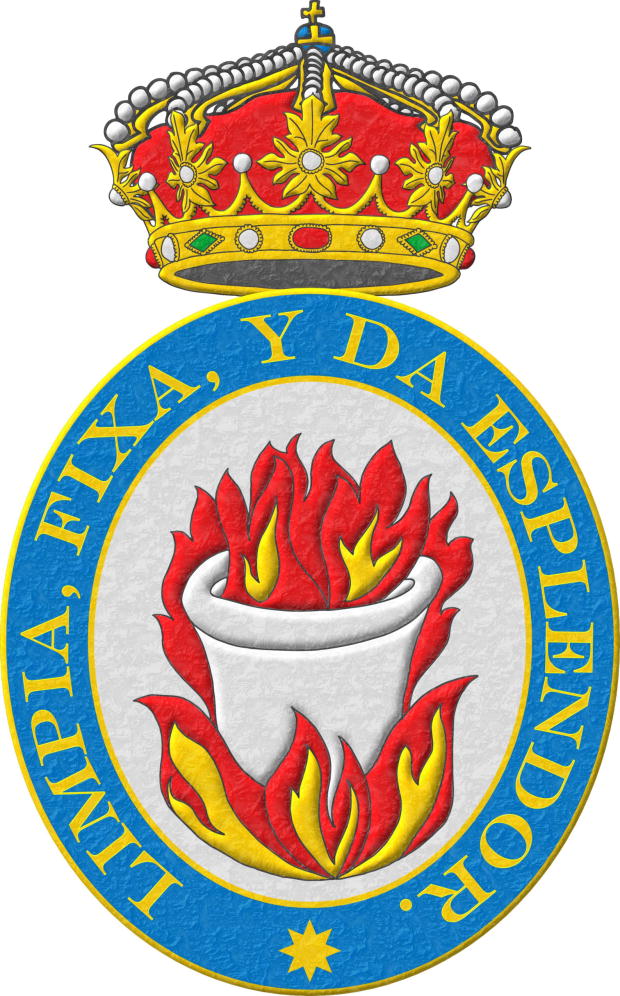
Alonso Zamora Vicente, «Historia de la Real Academia Española», Real Academia Española, Espasa Calpe, Madrid, 1999.
This bibliographic reference is illustrated with one of my interpretations of the emblem of the Real Academia Española. It is an oval emblem in Argent, with its crucible, also in Argent, over a bonfire of Gules and Or and surrounded by its flames, surmounted by a closed Royal crown with 8 arches, 5 of which are visible, and its motto, as originally written «Limpia, fixa, y da esplendor», around it.
Bibliographical reference of century XX.
Classification: Castilian language.
The author is Zamora Vicente, Alonso.
Bibliographical reference mentioned in the following article:
External link:
-
Language
-
Categories of heraldry
-
Divisions of the field
- Without divisions
- Party per pale
- Party per fess
- Party per bend
- Party per bend sinister
- Tierce
- Tierce sinister
- Tierced per pale
- Tierced per fess
- Tierced per bend
- Tierced pallwise inverted
- Quarterly
- Quarterly per saltire
- Gyronny
- Party per fess, the chief per pale
- Party per pale, the sinister per fess
- Party per fess, the base per pale
- Party per pale, the dexter per fess
- Chapé
- Chaussé
- Embrassé
- Contre-embrassé
- Party per chevron
- Enté
- Enté en point
- Flanched
-
Metals
-
Colours
-
Furs
-
Other tinctures
-
Ordinaries and sub-ordinaries
-
Diminutives of the ordinaries
-
Geometric charges
-
Composite ordinaries
-
Inanimate charges from Nature
Atom, Crescent, Diamond, Emerald, Estoile, Increscent, Lightning flash, Moon, Mount, Mullet, Mullet of four points, Orbital, Plough of Ursa Major, Rainbow, Ray of the sun, River, Sea, Snowflake, Sun, Sun in splendour, Sun of May, Trimount, Water and Wave.
-
Vegetal charges from Nature
Acorn, Apple, Apple tree, Ash, Bluebonnet, Camellia, Chrysanthemum, Cinquefoil, Cornflower, Dogwood flower, Double rose, Elm, Fleur de lis, Flower, Gourd, Holm oak, Hop cone, Kapok tree, Laurel, Lily, Linden, Lotus flower, Madonna lily, Mexican cedar tree, Oak, Olive tree, Palm tree, Plantain plant, Pomegranate, Poplar leaf, Rose, Shamrock, Sunflower, Thistle, Tree, Tulip, Vine and Wheat.
-
Animal charges from Nature
Badger, Bald eagle, Barbel, Barn owl, Bear, Beaver, Beetle, Bighorn sheep, Blackbird, Boar, Brach hound, Bull, Doe, Dog, Dolphin, Dove, Eagle, Elephant, Falcon, Female figure, Fish, Flame, Fly, Fox, Frog, Goat, Goldfinch, Goose, Heron, Horse, Hummingbird, Jaguar, Lark, Leopard, Lion, Lion passant, Lion rampant guardant, Lioness, Lynx, Male figure, Martlet, Merino ram, Owl, Panther, Parrot, Peacock, Pelican, Pelican in her piety, Puffin, Quetzal, Raven, Roe deer, Rooster, Savage, Seagull, Serpent, She-wolf, Stag, Starling, Talbot, Tyger, Vulture, Warren hound and Wolf.
-
Parts of natural charges
Arm, Beak, Branch, Caboshed, Chest, Claw, Covert, Dorsal fin, Eagle claw, Ermine spot, Escallop, Feather, Foot (palmiped), Foreleg, Forepaw, Hand, Head, Heart, Hoof, Leaf, Neck, Ostrich feather, Palm frond, Paw, Roe deers' attires, Shoulder, Sprig, Stags' attires, Stem, Swallow-tail, Tail, Tail addorsed, Tail fin, Talon, Tooth, Trunk, Trunk (elephant), Two hands clasped, Two wings in vol, Udder, Wheat spike, Wing and Wrist.
-
Artificial charges
Ace of spades, Anchor, Anvil, Arch, Arm vambraced, Armillary sphere, Arrow, Axe, Bell, Bell tower, Beret, Bonfire, Book, Bookmark, Bow, Branding iron, Bridge, Broken, Buckle, Cannon, Cannon dismounted, Cannon port, Canopy roof, Carbuncle, Castle, Celtic Trinity knot, Chain, Chess rooks, Church, Clarion, Clay pot, Closed book, Club, Column, Comb, Compass rose, Conductor's baton, Cord, Covered cup, Crozier, Crucible, Cuffed, Cup, Cyclamor, Dagger, Double vajra, Drum, Ecclesiastical cap, Fanon, Federschwert, Fleam, Four crescents joined millsailwise, Galician granary, Garb, Gauntlet, Geometric solid, Grenade, Halberd, Hammer, Harp, Host, Hourglass, Key, Key ward, Knight, Knot, Lantern, Letter, Line, Loincloth, Menorah, Millrind, Millstone, Millwheel, Monstrance, Mortar, Mullet of six points pierced, Nail, Non-classic artifact, Norman ship, Number, Oar, Oil lamp, Open book, Page, Pair of scales, Parchment, Pestle, Piano, Pilgrim's staff, Plough share, Polish winged hussar, Port, Portcullis, Potent, Quill, Ribbon, Rosette of acanthus leaves, Sabre, Sackbut, Sail, Scroll, Scythe, Sheaf of tobacco, Ship, Skirt, Spear, Spear's head, Stairway, Star of David, Step, Sword, Symbol, Tetrahedron, Torch, Tower, Trident, Trumpet, Turret, Two-handed sword, Wagon-wheel, Water-bouget, Wheel, Winnowing fan and With a turret.
-
Immaterial charges
Angel, Archangel, Basilisk, Dragon, Dragon's head, Garuda, Golden fleece, Griffin, Heart enflamed, Justice, Mermaid, Our Lady of Mercy, Ouroboros, Paschal lamb, Pegasus, Phoenix, Sacred Heart of Jesus, Saint George, Sea-griffin, Trinity, Triton, Unicorn, Winged hand and Wyvern.
-
External elements
-
Heraldic creations
-
References
-
Formats
-
Keywords on this page
Watercolor, Pointed, Armed, Azure, Bibliography, Bordure, Chevron, Charged, Ogee, Crown, Outlined in sable, Outlined in the field tincture, In pale, Coat of arms, Schema, Papal States, Fess, Fleur de lis, Personal, Gules, Illuminated, Interpreted, Chief, Langued, Castilian language, Leopard, Lion, Lineage, Semi-circular, Hard metal, Soft metal, Ordered, Or, Pale, Leather, Argent, Without divisions, Civic, Kingdom of France, Kingdom of England, Kingdom of Navarre, Religious, Sable, Century XX, Vert, Plain tincture, Freehand, Three and One.

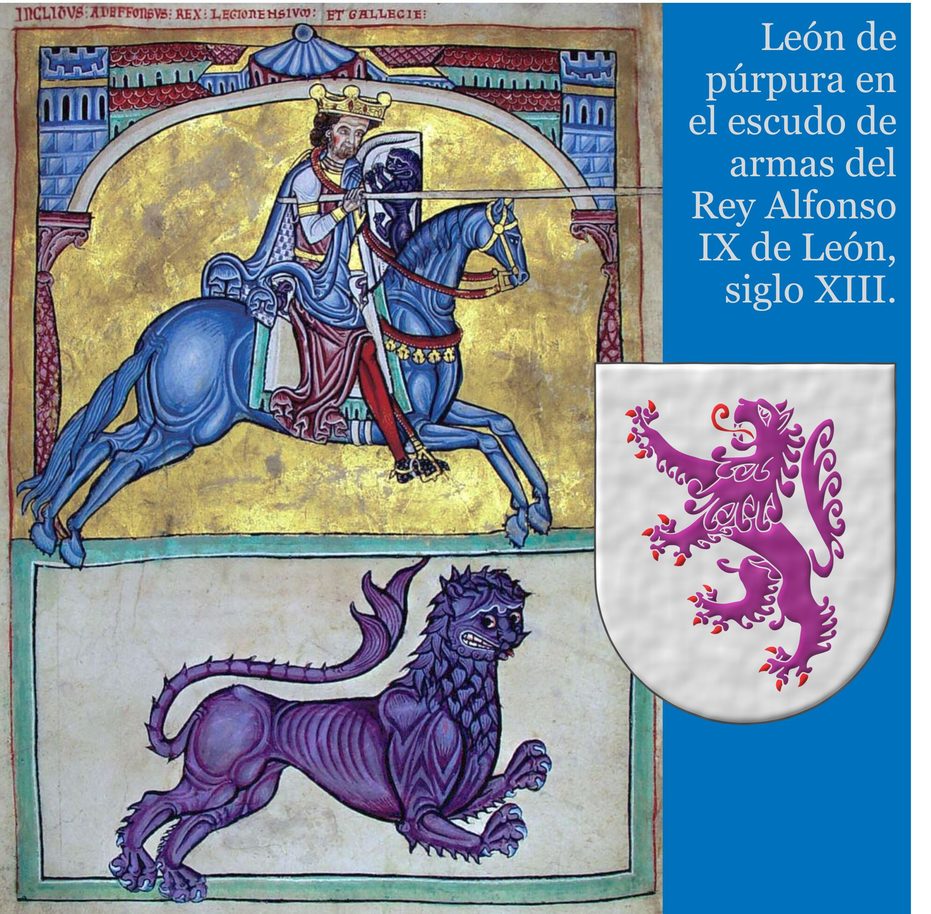
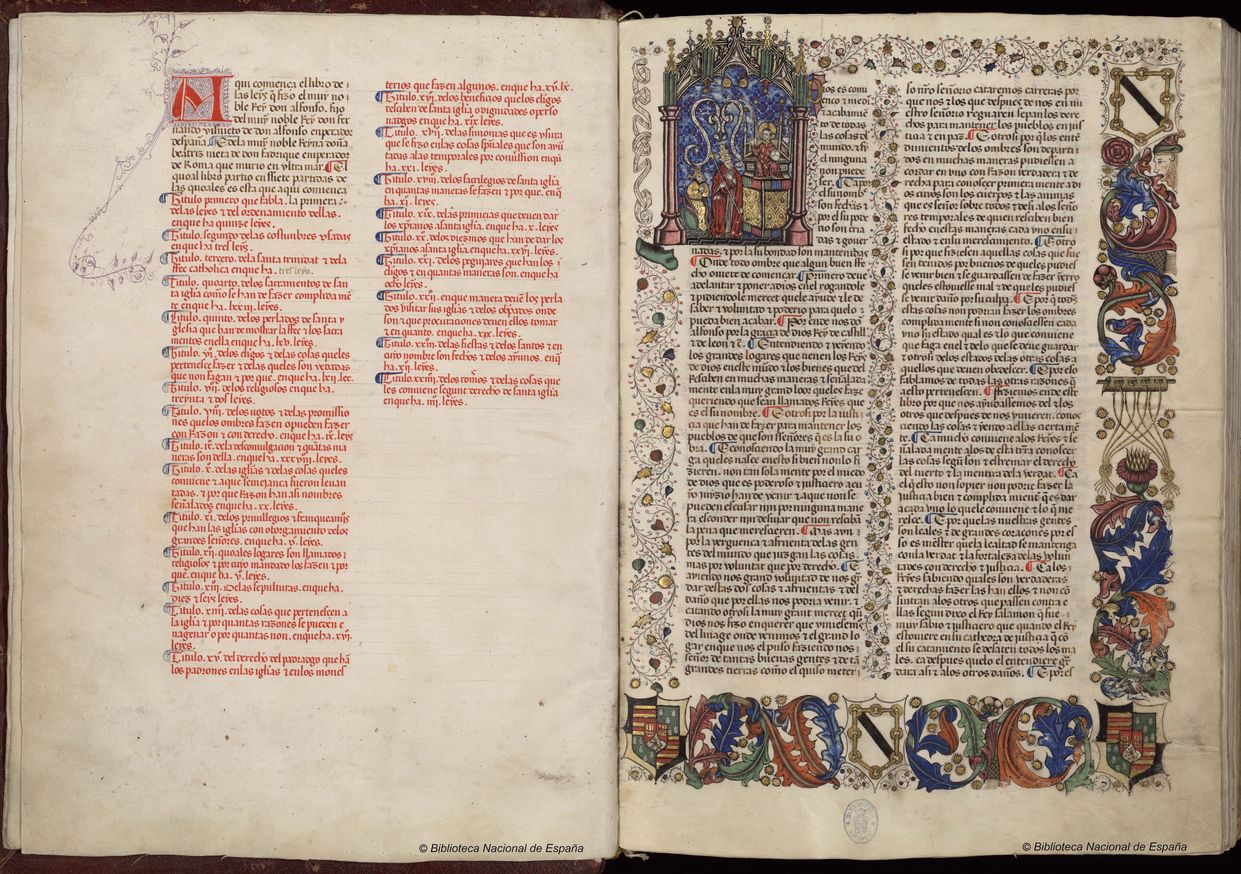
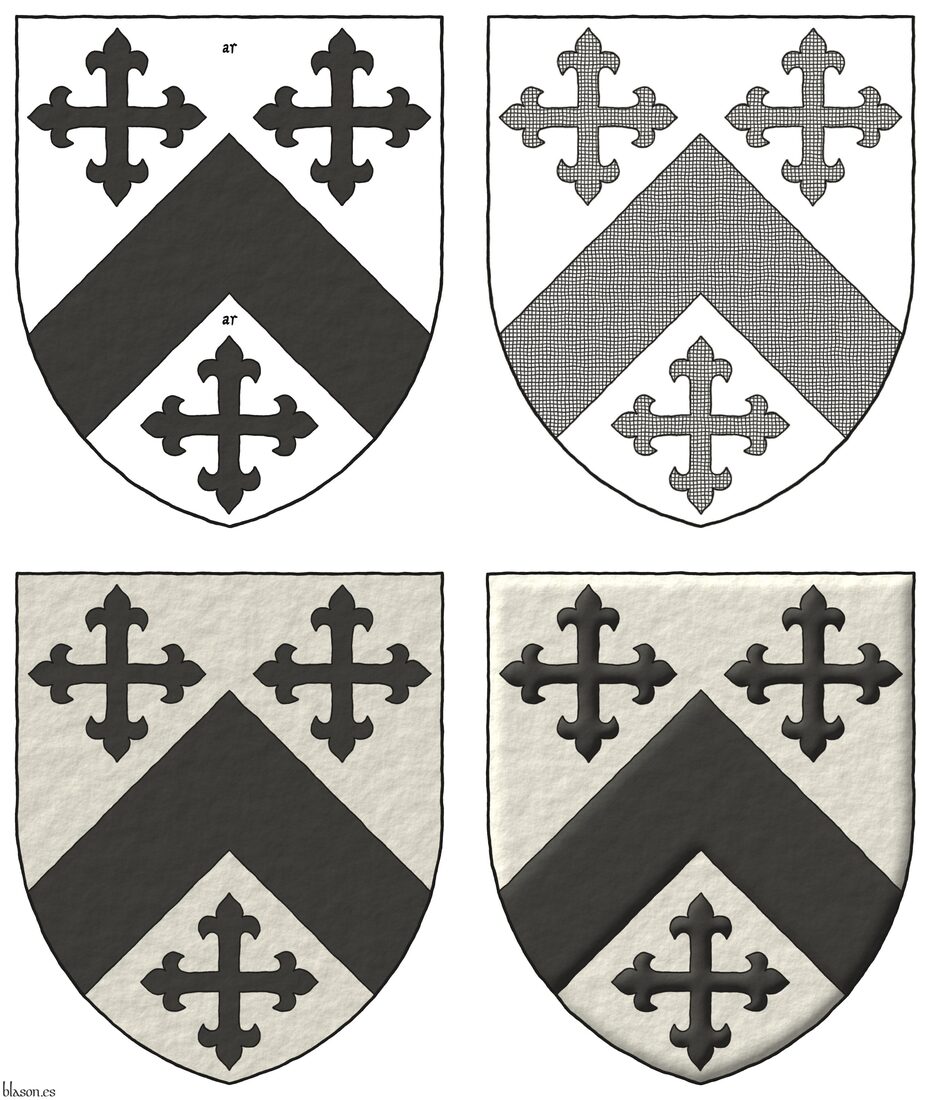

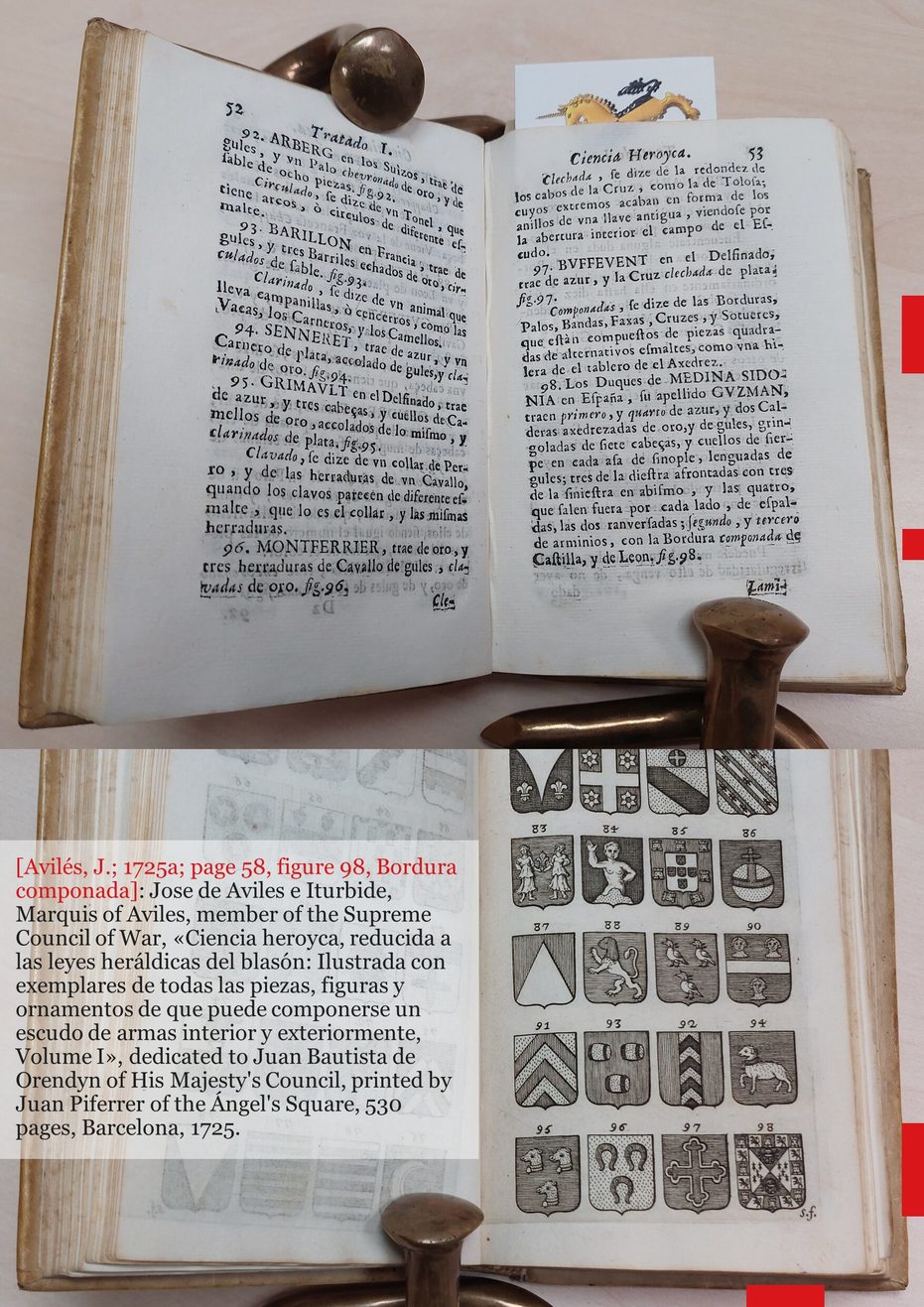
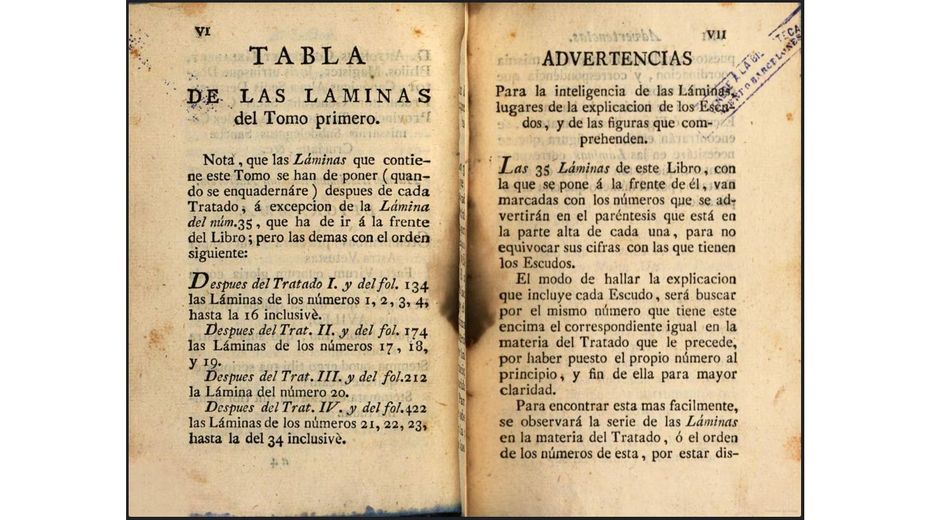
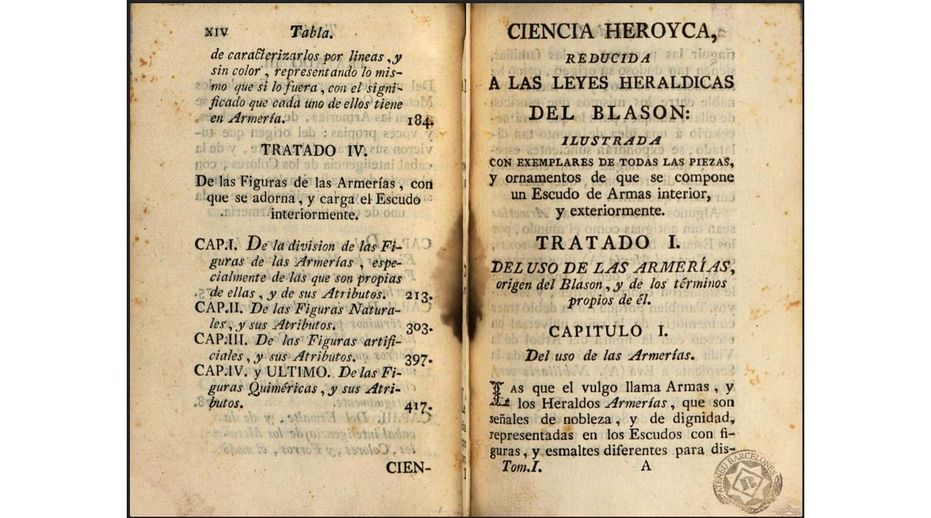
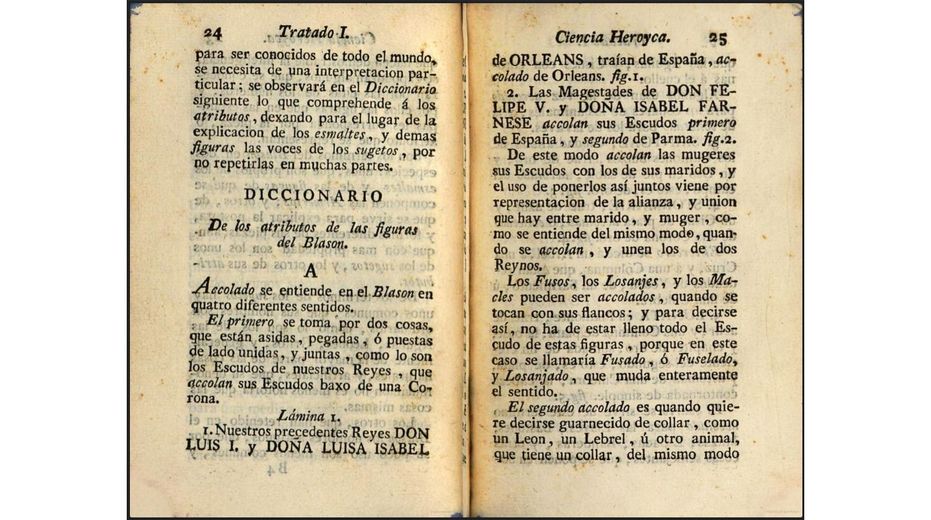
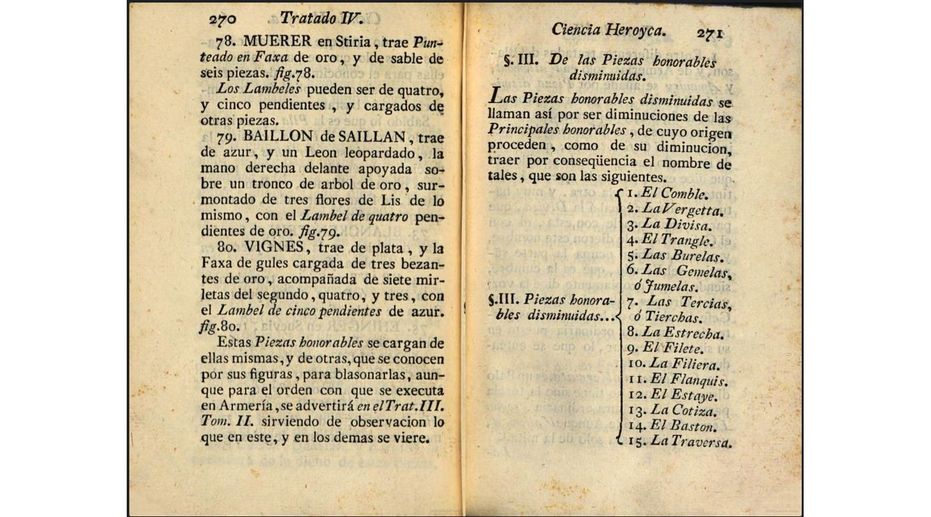
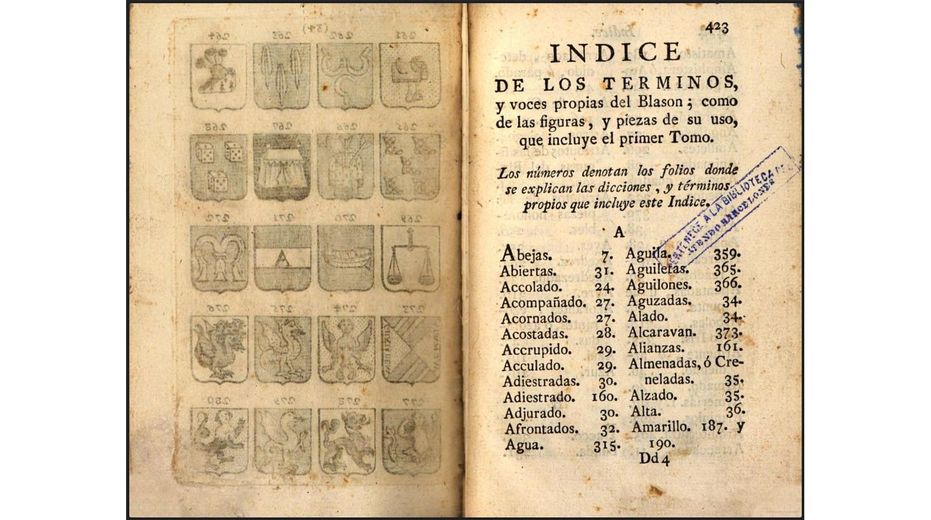
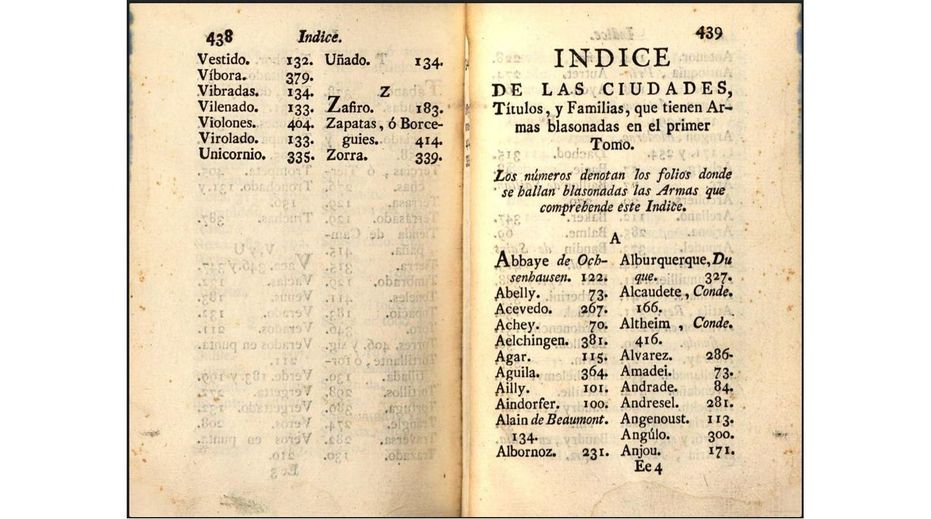

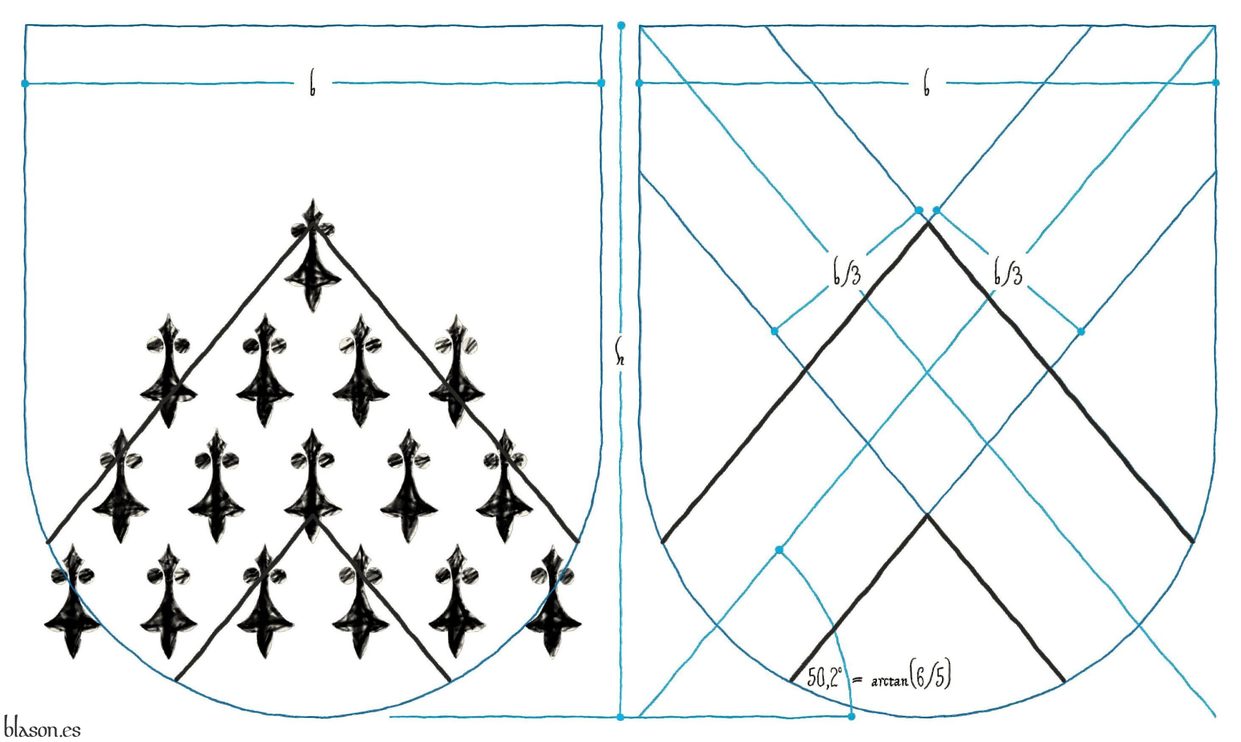
![Berenguela of Castile and Alfonso IX [ Argent, a lion rampant Purpure, armed and langued Gules ] accolé with [ Gules, a castle triple towered Or, port and windows Azure, masoned Sable ].](../escudo_armas/BerenguelaC.23.Matrimonio.jpg)
